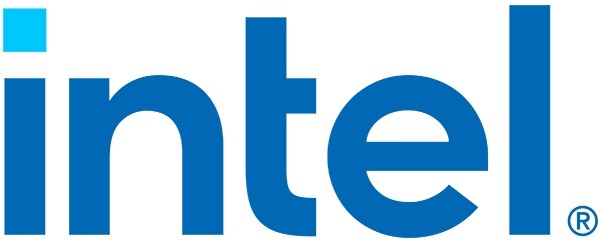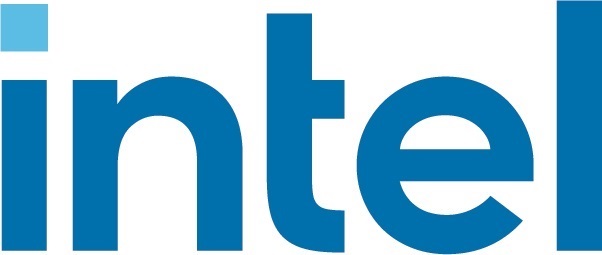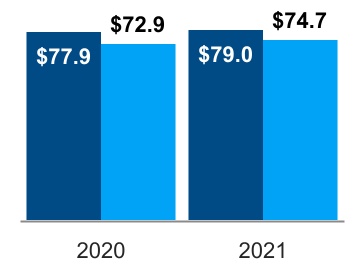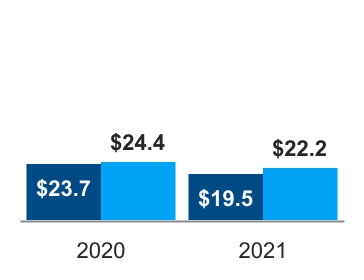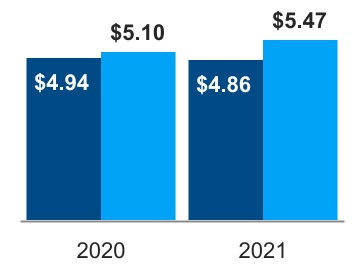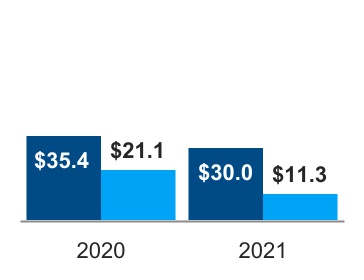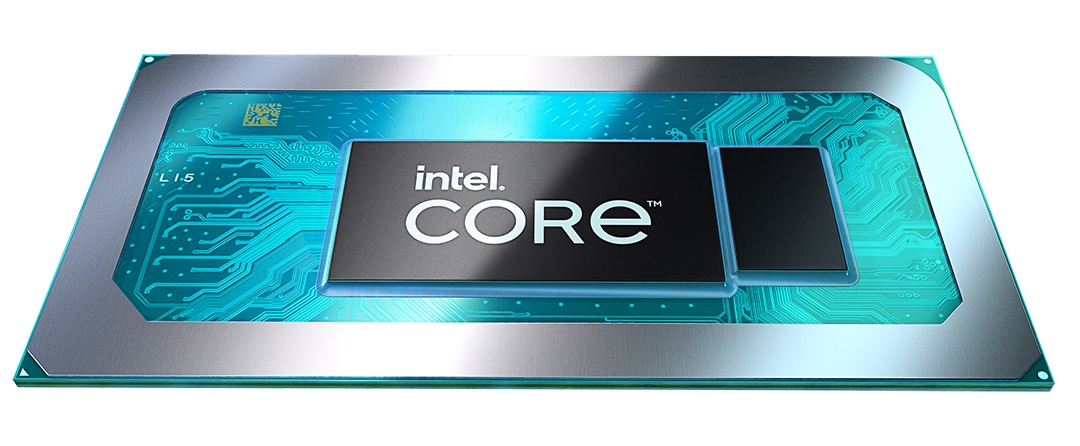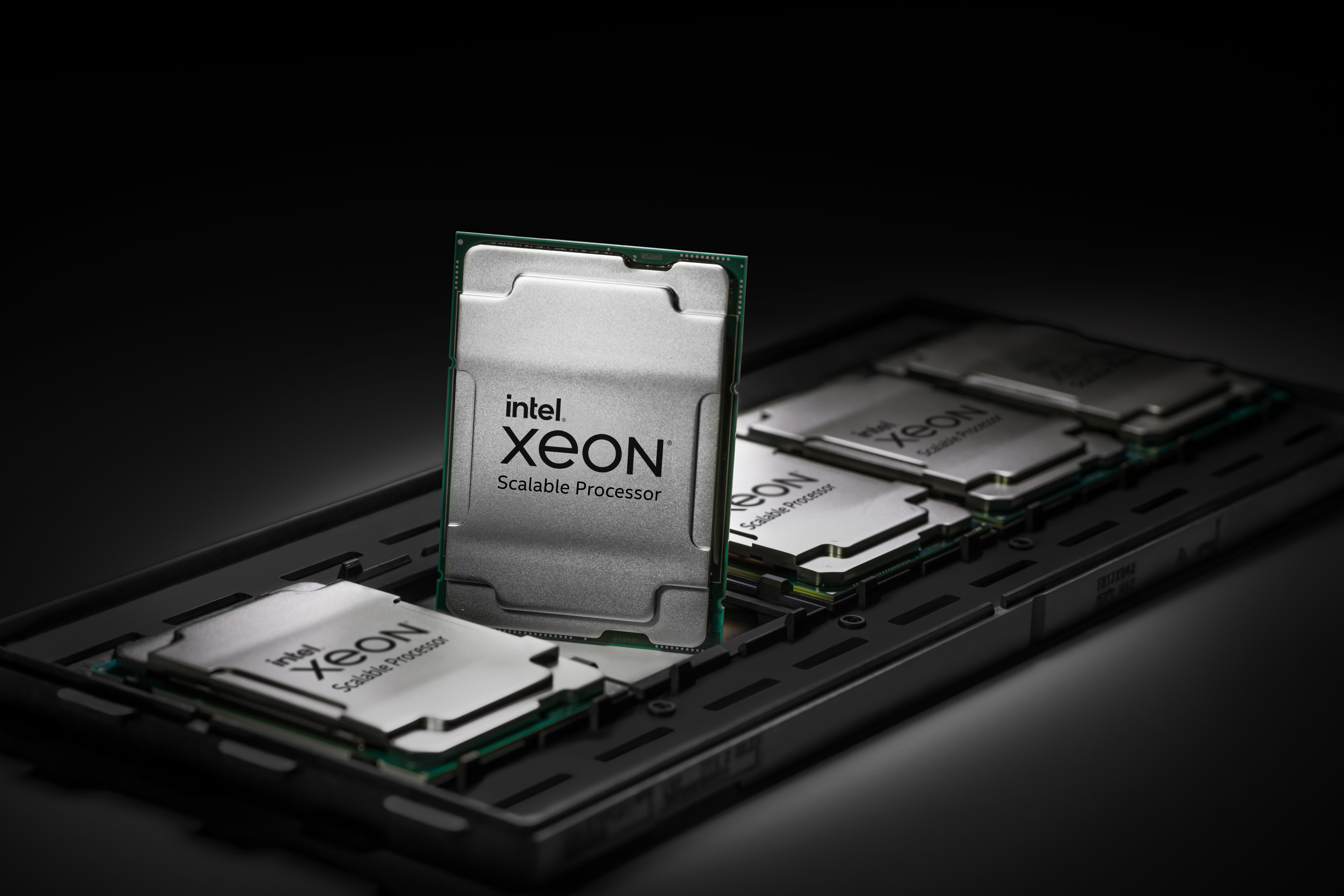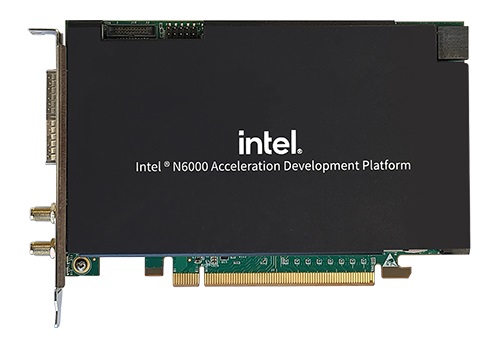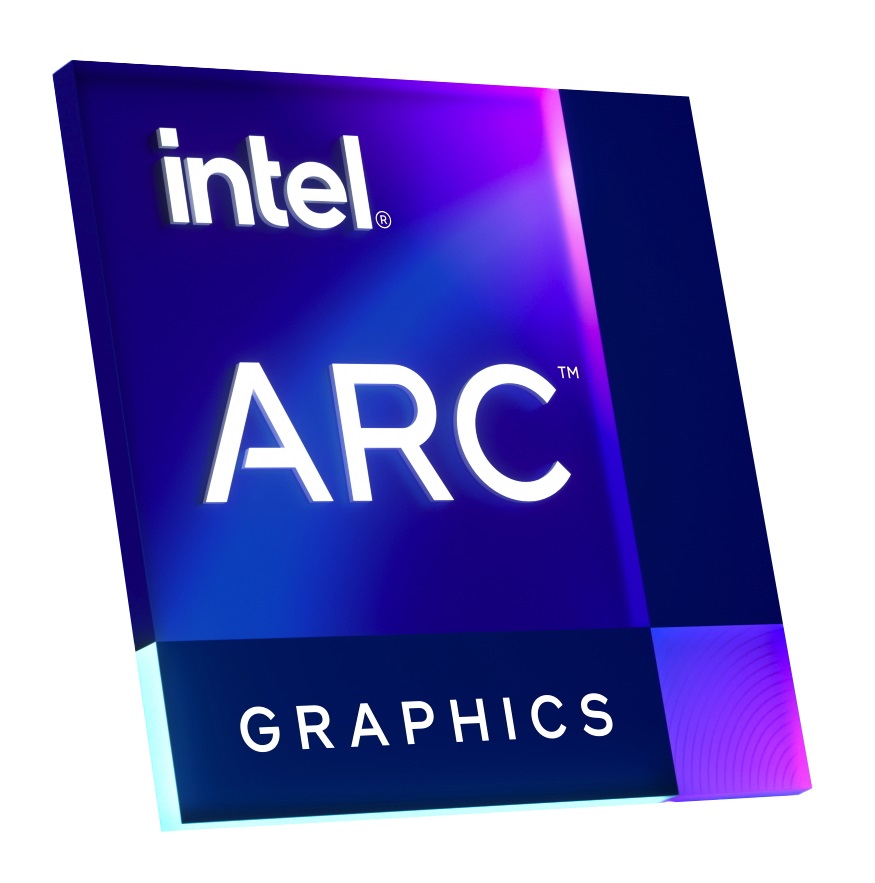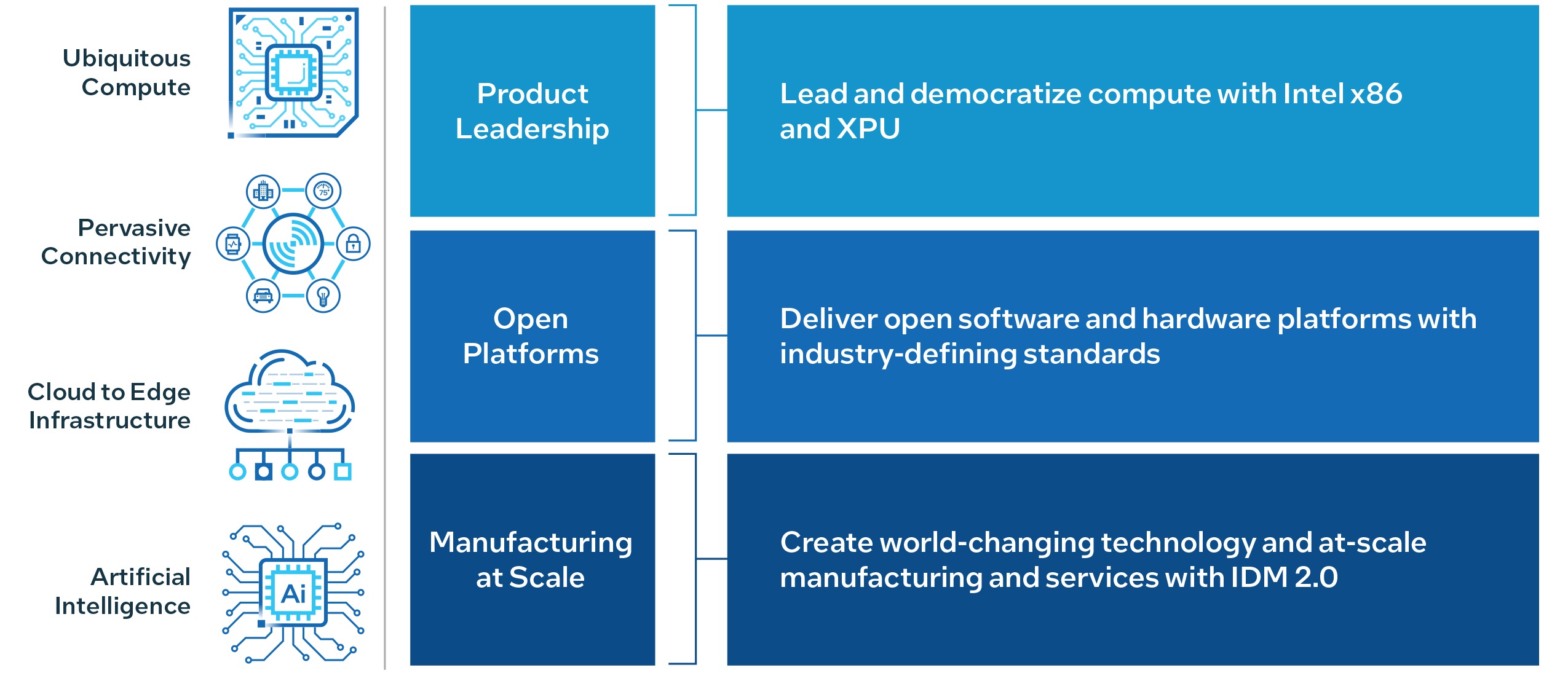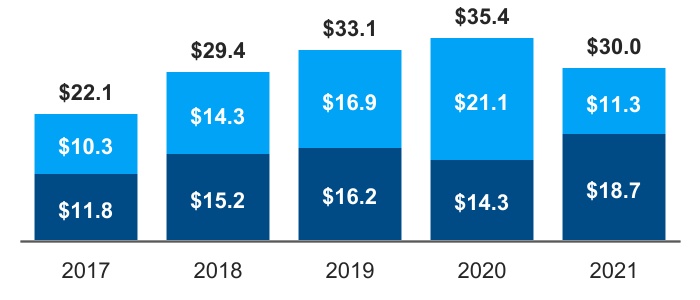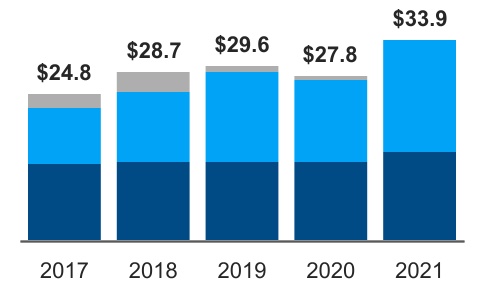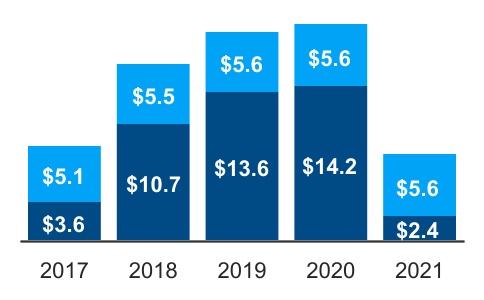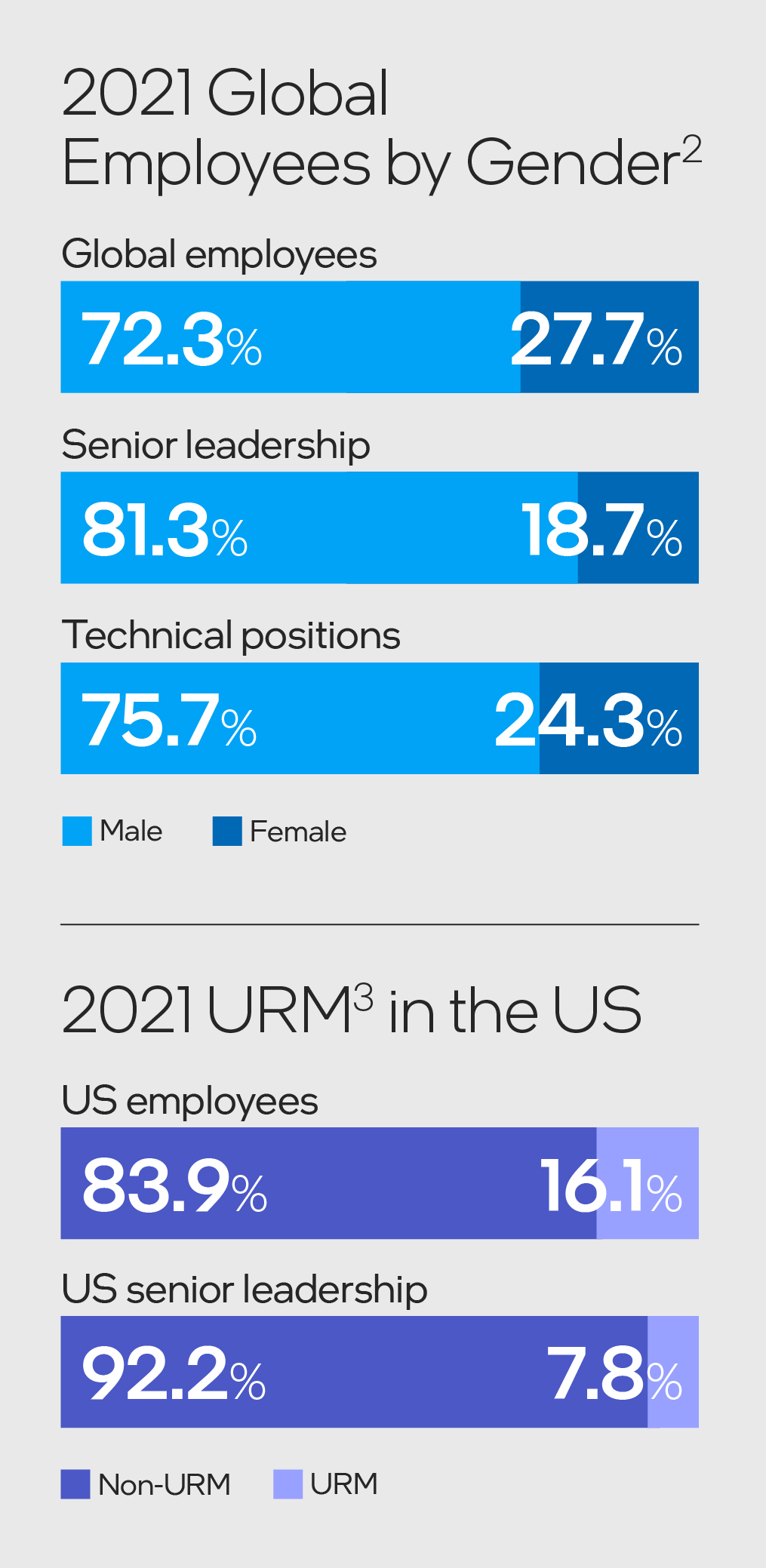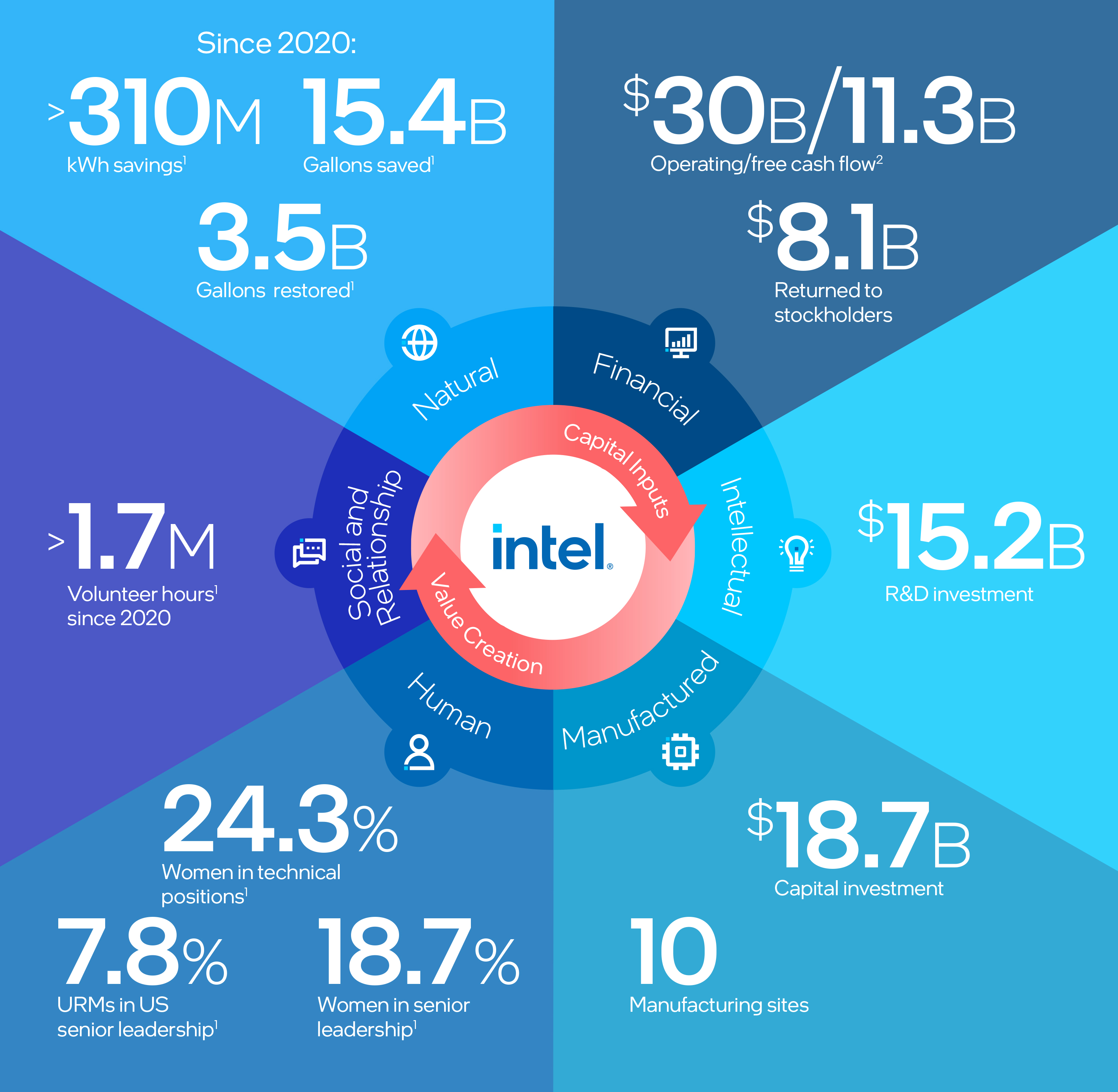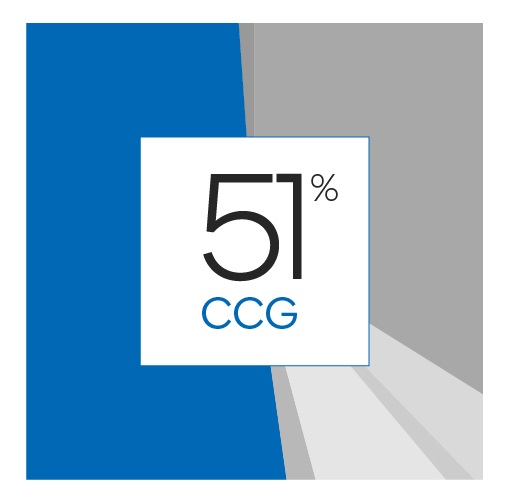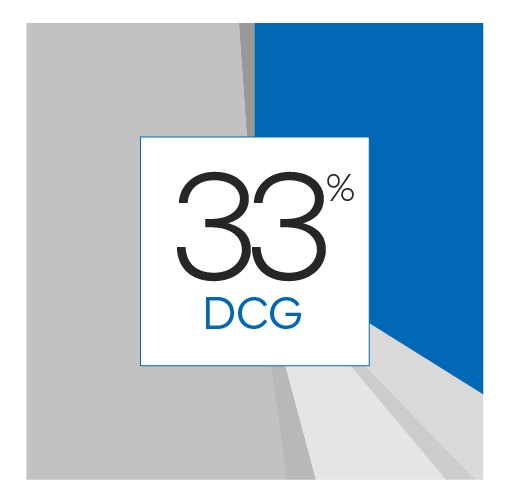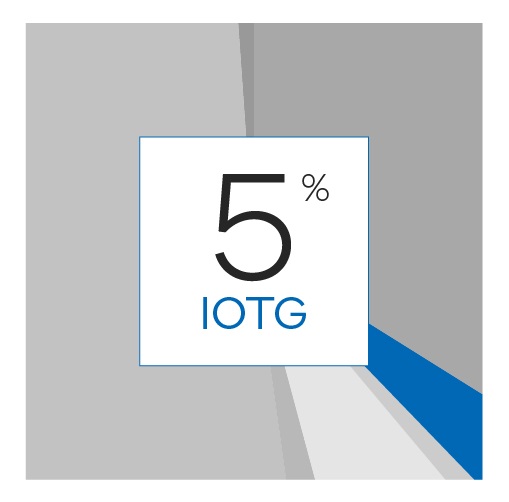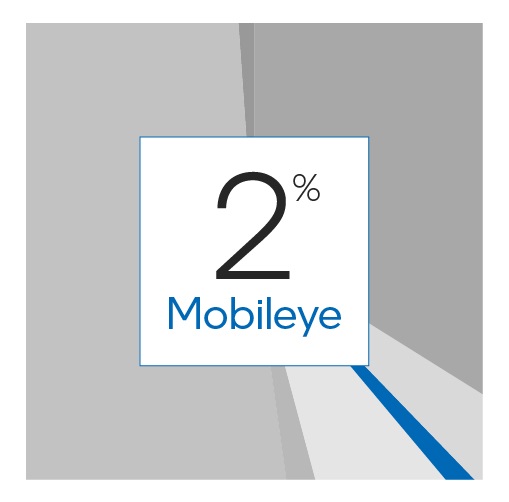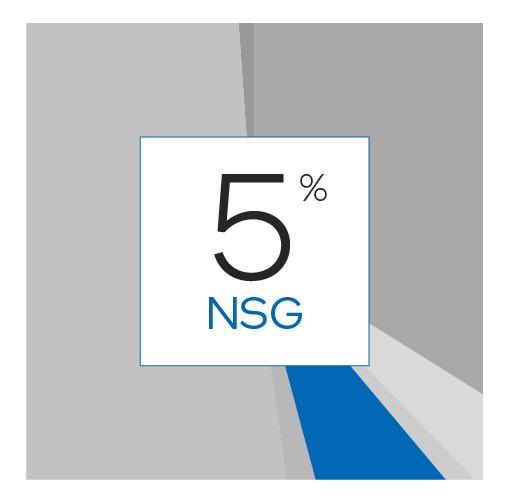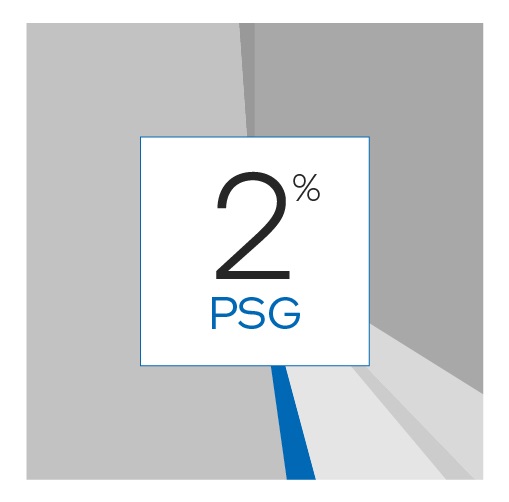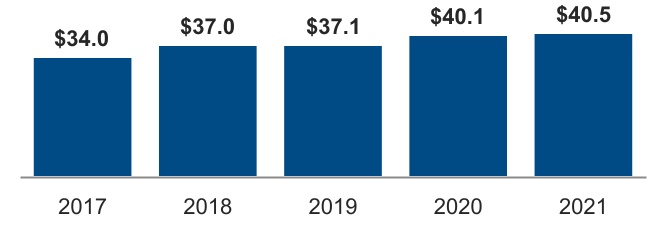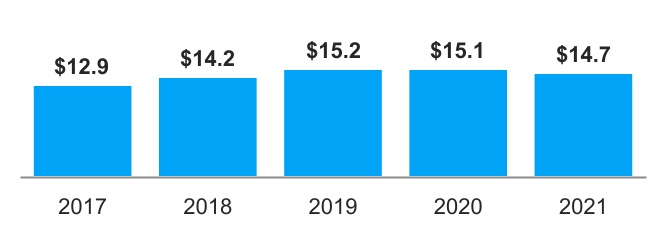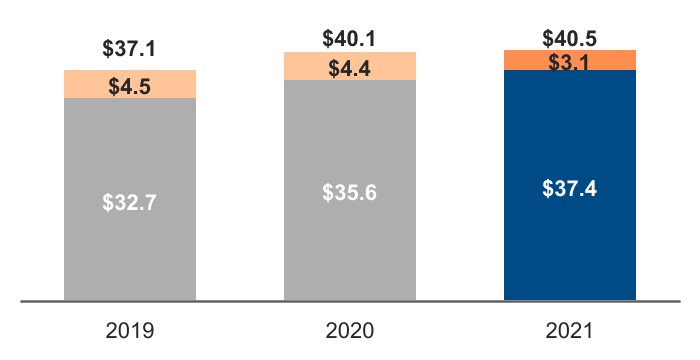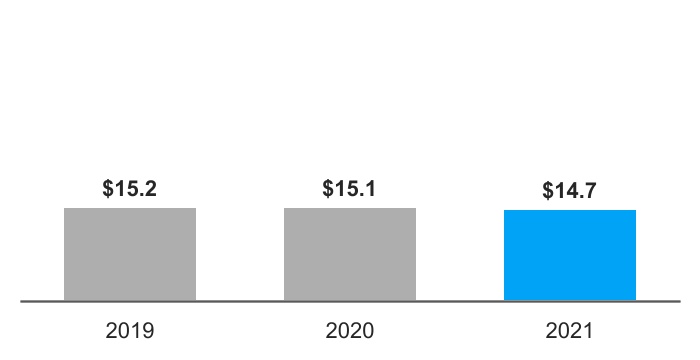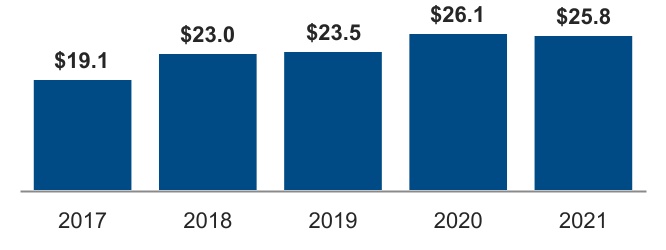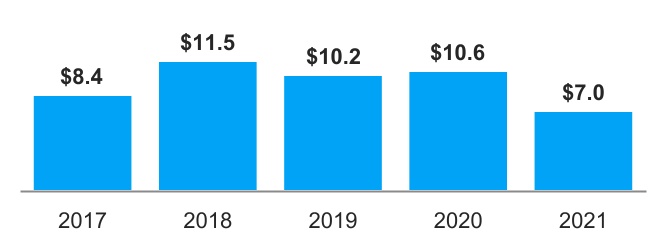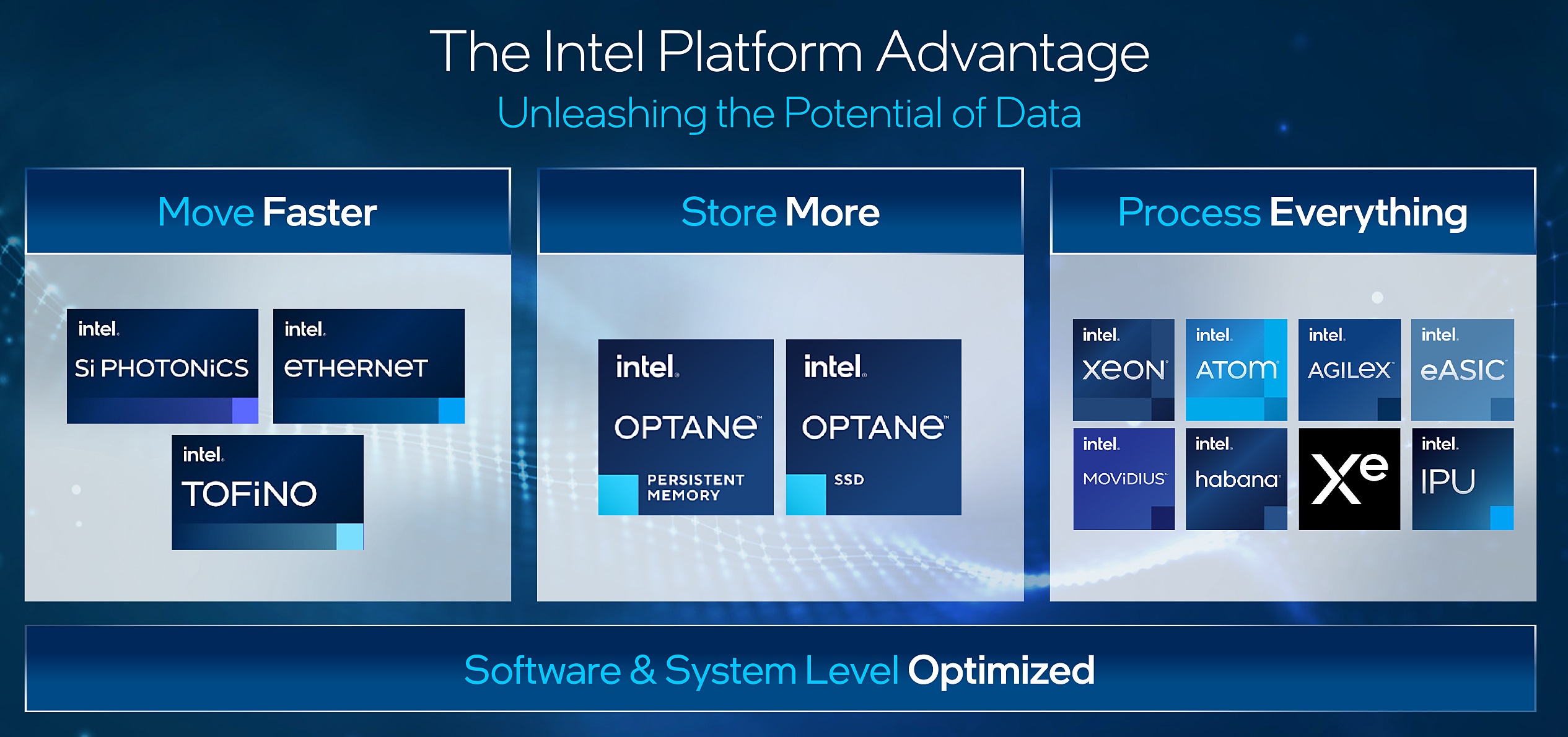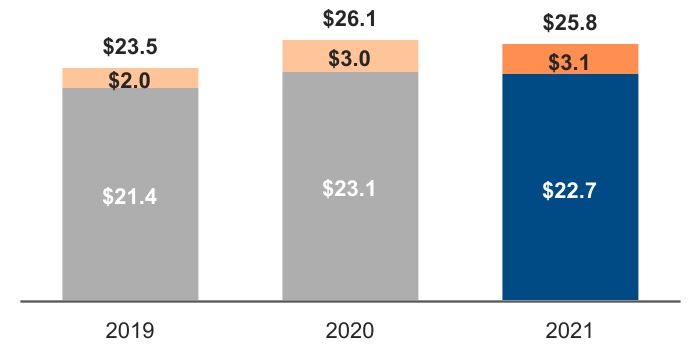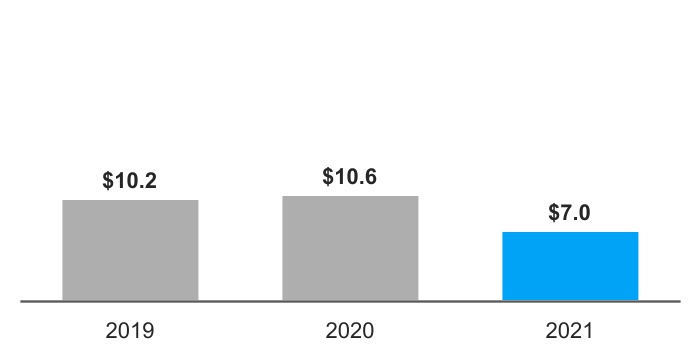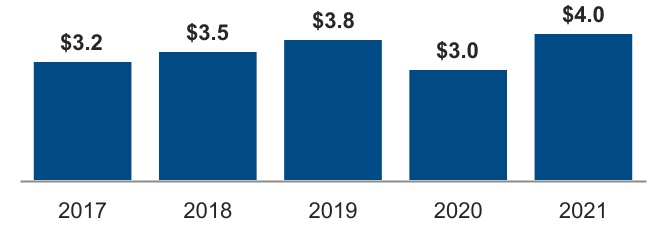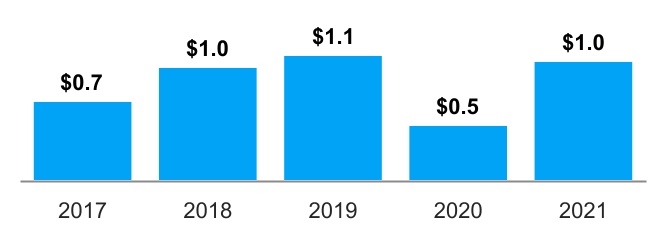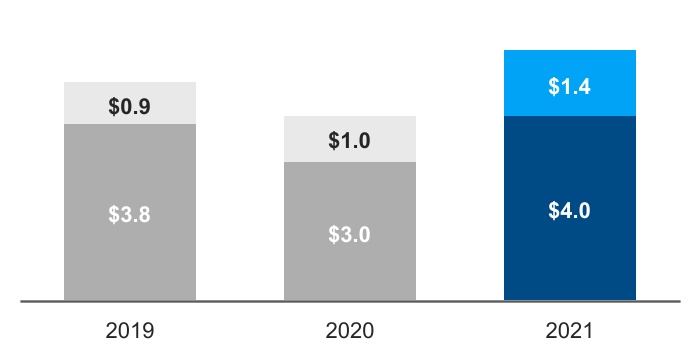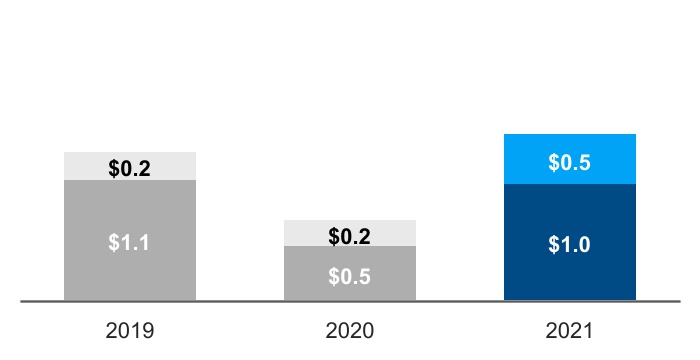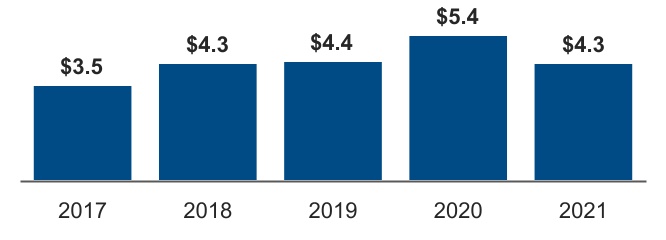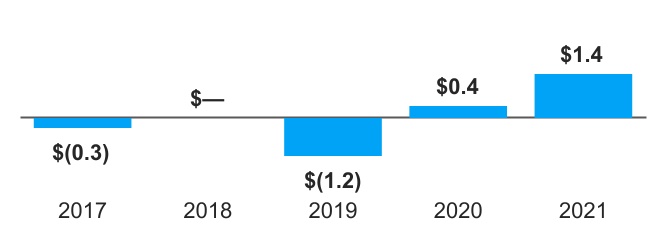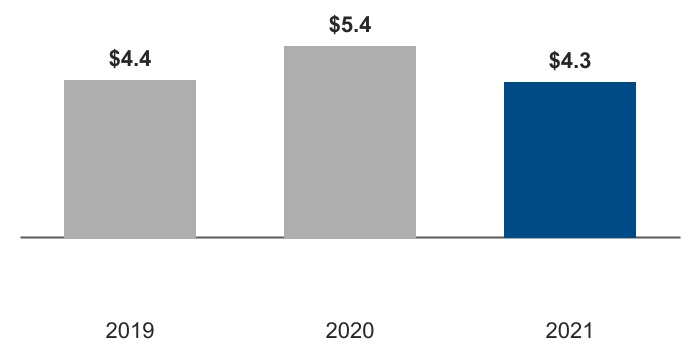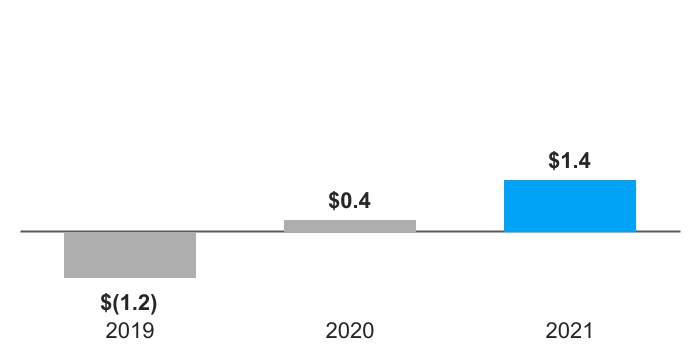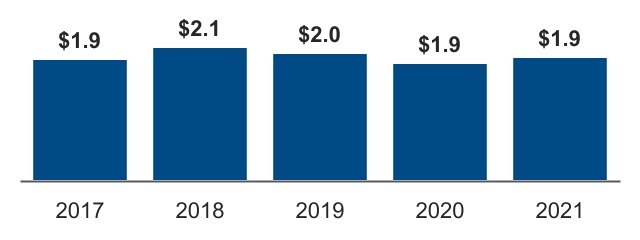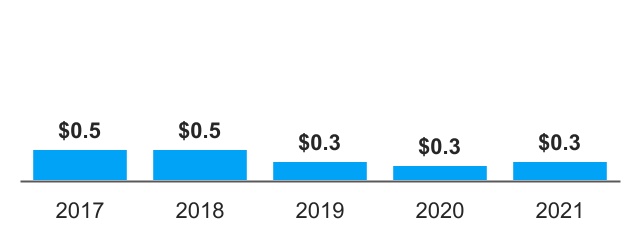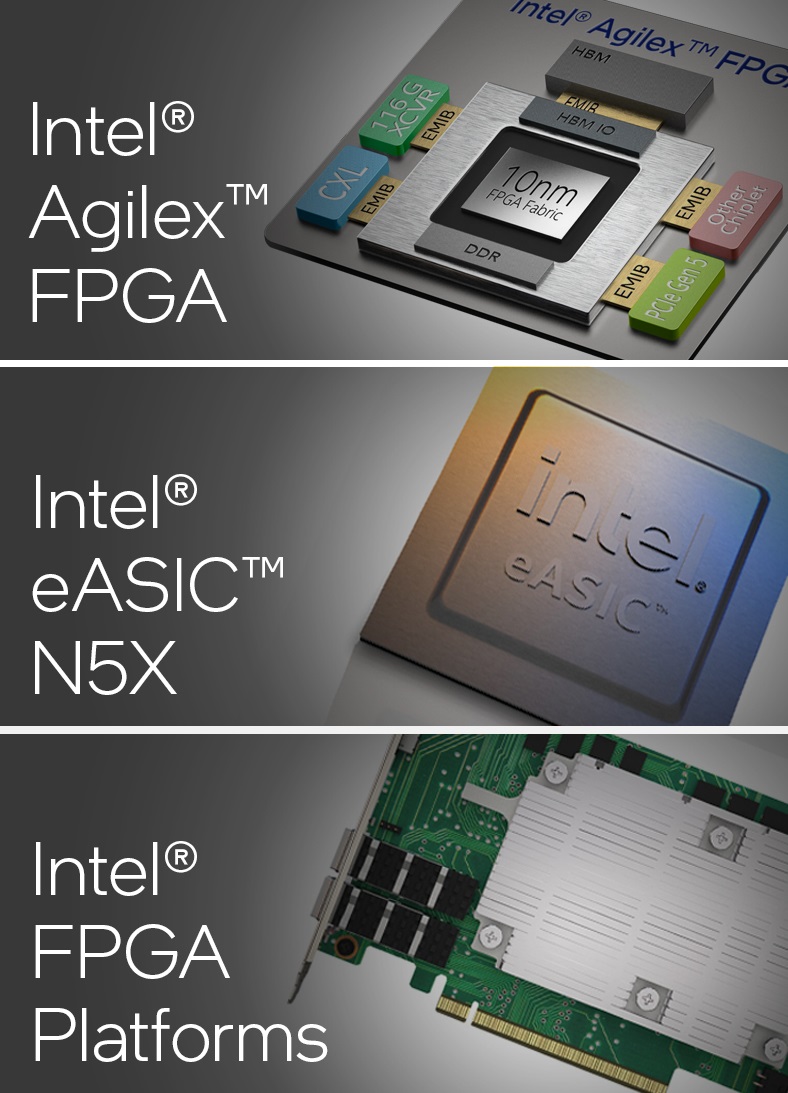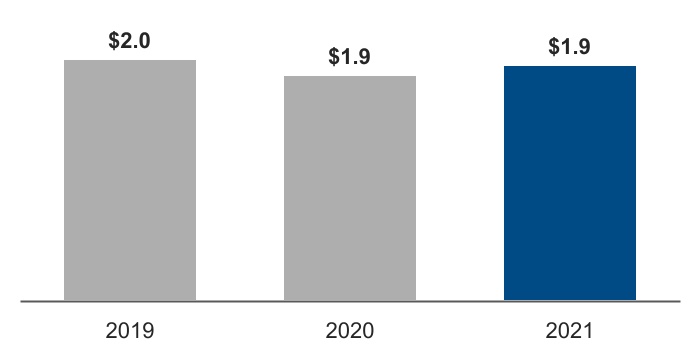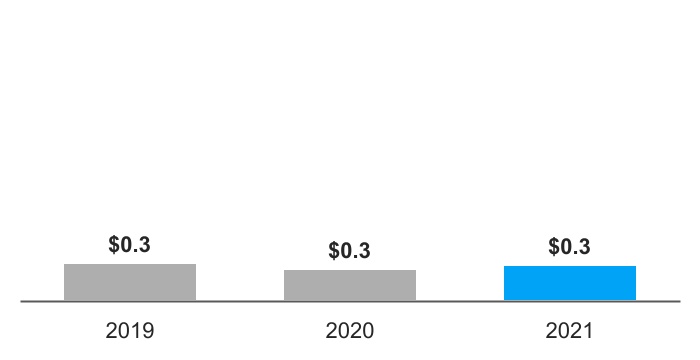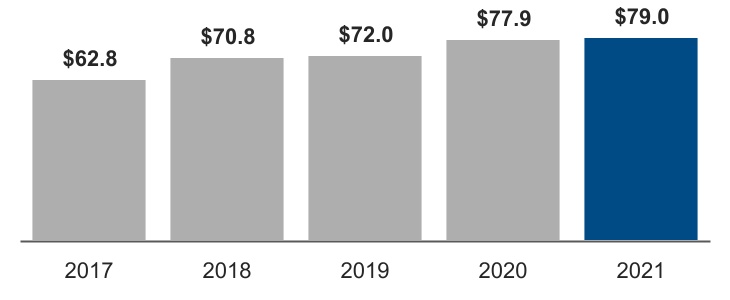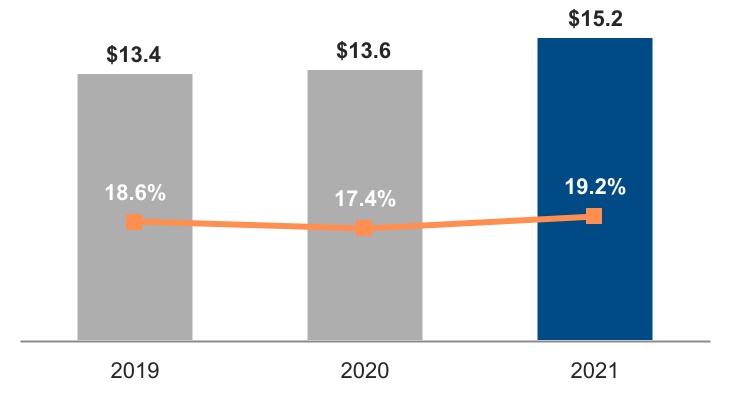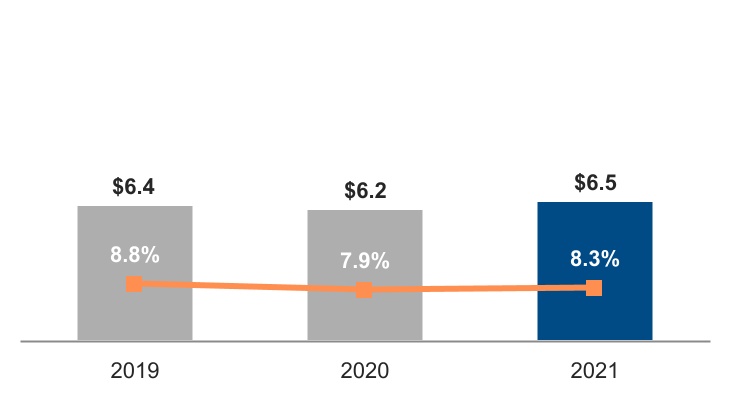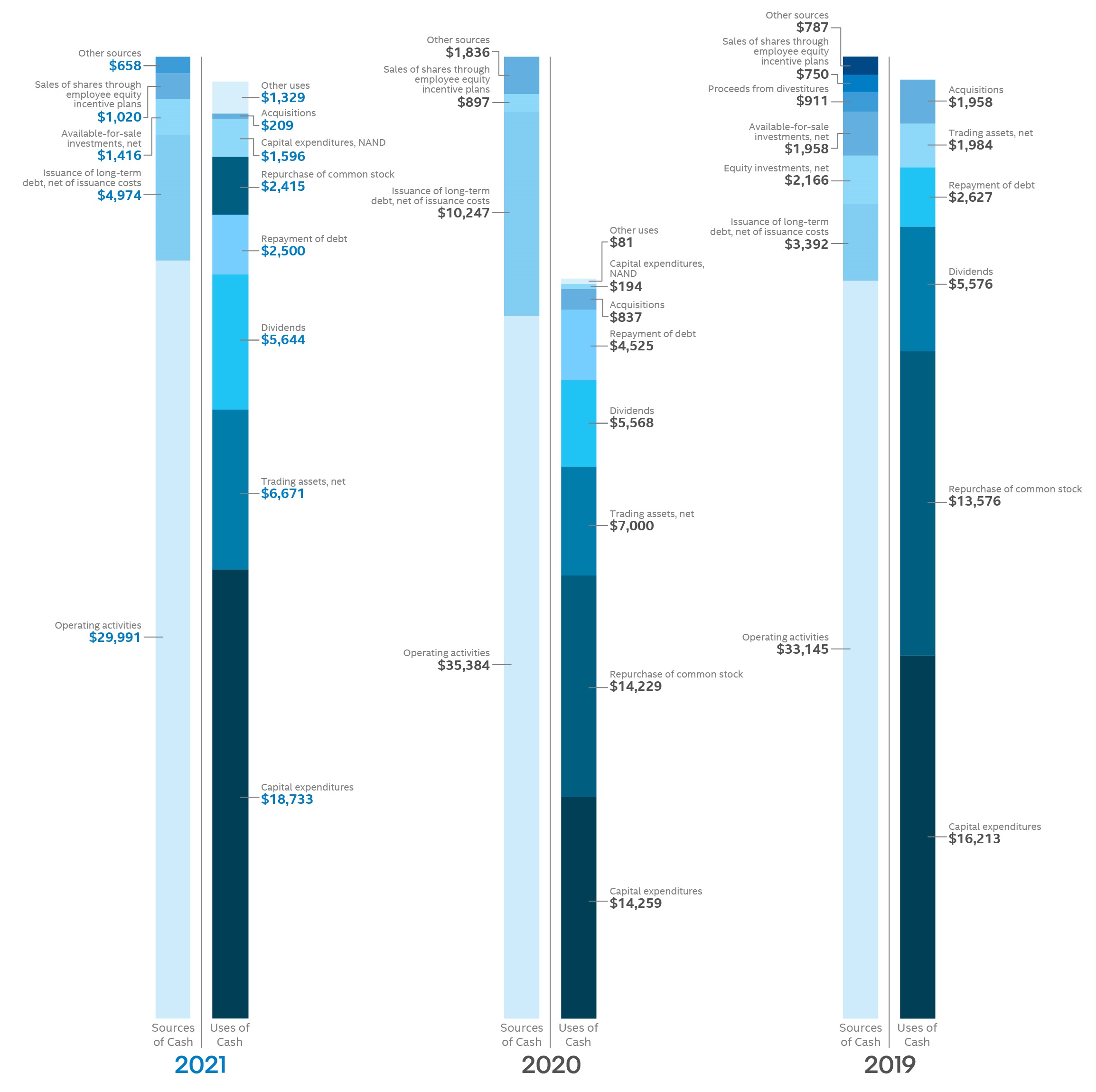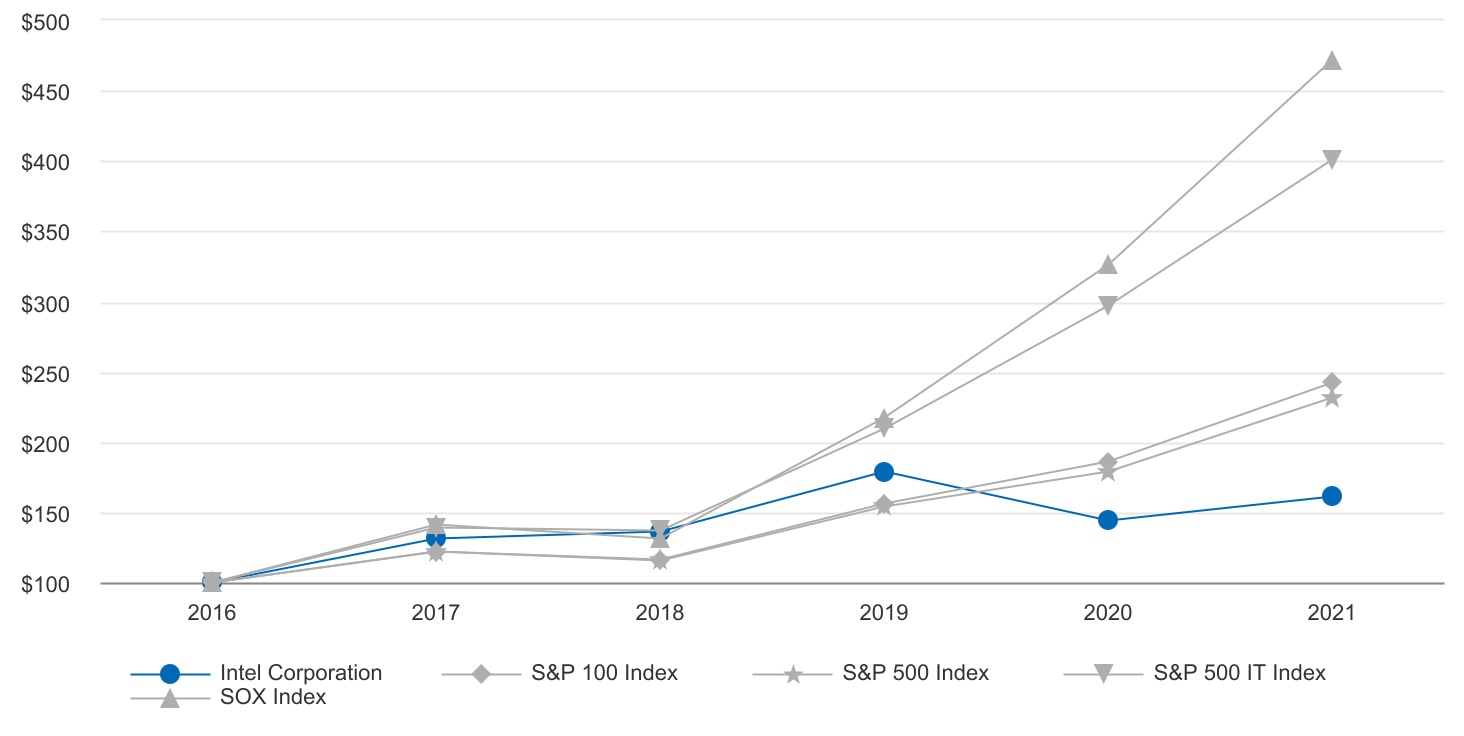000005086312-2510-KDecember 25, 20212021FYfalsefalse4,072226.80.0010.0015050——0.0010.00110,00010,0004,0704,0624,0704,0621.39001.321.26sixfoursix9156383319.07.02.09535,9896,9421.91.06001502676900.351.703.302.353.104.002.704.102.882.703.403.702.603.753.151.602.453.902.004.004.602.804.804.254.904.104.104.103.733.254.753.053.104.953.202.702.405.005.00no———P3Y00000508632020-12-272021-12-2500000508632021-06-25iso4217:USD00000508632022-01-21xbrli:shares00000508632019-12-292020-12-2600000508632018-12-302019-12-28iso4217:USDxbrli:shares00000508632021-12-2500000508632020-12-2600000508632019-12-2800000508632018-12-290000050863us-gaap:CommonStockIncludingAdditionalPaidInCapitalMember2018-12-290000050863us-gaap:AccumulatedOtherComprehensiveIncomeMember2018-12-290000050863us-gaap:RetainedEarningsMember2018-12-290000050863us-gaap:RetainedEarningsMember2018-12-302019-12-280000050863us-gaap:AccumulatedOtherComprehensiveIncomeMember2018-12-302019-12-280000050863us-gaap:CommonStockIncludingAdditionalPaidInCapitalMember2018-12-302019-12-280000050863us-gaap:CommonStockIncludingAdditionalPaidInCapitalMember2019-12-280000050863us-gaap:AccumulatedOtherComprehensiveIncomeMember2019-12-280000050863us-gaap:RetainedEarningsMember2019-12-280000050863us-gaap:RetainedEarningsMember2019-12-292020-12-260000050863us-gaap:AccumulatedOtherComprehensiveIncomeMember2019-12-292020-12-260000050863us-gaap:CommonStockIncludingAdditionalPaidInCapitalMember2019-12-292020-12-260000050863us-gaap:CommonStockIncludingAdditionalPaidInCapitalMember2020-12-260000050863us-gaap:AccumulatedOtherComprehensiveIncomeMember2020-12-260000050863us-gaap:RetainedEarningsMember2020-12-260000050863us-gaap:RetainedEarningsMembersrt:CumulativeEffectPeriodOfAdoptionAdjustmentMember2020-12-260000050863srt:CumulativeEffectPeriodOfAdoptionAdjustmentMember2020-12-260000050863srt:CumulativeEffectPeriodOfAdoptionAdjustedBalanceMemberus-gaap:CommonStockIncludingAdditionalPaidInCapitalMember2020-12-260000050863srt:CumulativeEffectPeriodOfAdoptionAdjustedBalanceMemberus-gaap:AccumulatedOtherComprehensiveIncomeMember2020-12-260000050863us-gaap:RetainedEarningsMembersrt:CumulativeEffectPeriodOfAdoptionAdjustedBalanceMember2020-12-260000050863srt:CumulativeEffectPeriodOfAdoptionAdjustedBalanceMember2020-12-260000050863us-gaap:RetainedEarningsMember2020-12-272021-12-250000050863us-gaap:AccumulatedOtherComprehensiveIncomeMember2020-12-272021-12-250000050863us-gaap:CommonStockIncludingAdditionalPaidInCapitalMember2020-12-272021-12-250000050863us-gaap:CommonStockIncludingAdditionalPaidInCapitalMember2021-12-250000050863us-gaap:AccumulatedOtherComprehensiveIncomeMember2021-12-250000050863us-gaap:RetainedEarningsMember2021-12-250000050863srt:MaximumMember2020-12-272021-12-250000050863us-gaap:CreditConcentrationRiskMember2020-12-272021-12-250000050863us-gaap:AccountsReceivableMemberintc:ThreeLargestCustomersMemberus-gaap:CreditConcentrationRiskMember2020-12-272021-12-25xbrli:pure0000050863intc:PlatformMemberintc:ClientComputingGroupMember2020-12-272021-12-250000050863intc:PlatformMemberintc:ClientComputingGroupMember2019-12-292020-12-260000050863intc:PlatformMemberintc:ClientComputingGroupMember2018-12-302019-12-280000050863intc:OtherProductOrServiceMemberintc:ClientComputingGroupMember2020-12-272021-12-250000050863intc:OtherProductOrServiceMemberintc:ClientComputingGroupMember2019-12-292020-12-260000050863intc:OtherProductOrServiceMemberintc:ClientComputingGroupMember2018-12-302019-12-280000050863intc:ClientComputingGroupMember2020-12-272021-12-250000050863intc:ClientComputingGroupMember2019-12-292020-12-260000050863intc:ClientComputingGroupMember2018-12-302019-12-280000050863intc:DCGPlatformMember2020-12-272021-12-250000050863intc:DCGPlatformMember2019-12-292020-12-260000050863intc:DCGPlatformMember2018-12-302019-12-280000050863intc:OtherProductOrServiceMemberintc:DataCenterGroupMember2020-12-272021-12-250000050863intc:OtherProductOrServiceMemberintc:DataCenterGroupMember2019-12-292020-12-260000050863intc:OtherProductOrServiceMemberintc:DataCenterGroupMember2018-12-302019-12-280000050863intc:DataCenterGroupMember2020-12-272021-12-250000050863intc:DataCenterGroupMember2019-12-292020-12-260000050863intc:DataCenterGroupMember2018-12-302019-12-280000050863intc:InternetOfThingsGroupMember2020-12-272021-12-250000050863intc:InternetOfThingsGroupMember2019-12-292020-12-260000050863intc:InternetOfThingsGroupMember2018-12-302019-12-280000050863intc:MobileyeMember2020-12-272021-12-250000050863intc:MobileyeMember2019-12-292020-12-260000050863intc:MobileyeMember2018-12-302019-12-280000050863intc:InternetofThingsMember2020-12-272021-12-250000050863intc:InternetofThingsMember2019-12-292020-12-260000050863intc:InternetofThingsMember2018-12-302019-12-280000050863intc:NonVolatileMemorySolutionsGroupMember2020-12-272021-12-250000050863intc:NonVolatileMemorySolutionsGroupMember2019-12-292020-12-260000050863intc:NonVolatileMemorySolutionsGroupMember2018-12-302019-12-280000050863intc:ProgrammableSolutionsGroupMember2020-12-272021-12-250000050863intc:ProgrammableSolutionsGroupMember2019-12-292020-12-260000050863intc:ProgrammableSolutionsGroupMember2018-12-302019-12-280000050863us-gaap:AllOtherSegmentsMember2020-12-272021-12-250000050863us-gaap:AllOtherSegmentsMember2019-12-292020-12-260000050863us-gaap:AllOtherSegmentsMember2018-12-302019-12-280000050863intc:CCGNotebookPlatformMember2020-12-272021-12-250000050863intc:CCGNotebookPlatformMember2019-12-292020-12-260000050863intc:CCGNotebookPlatformMember2018-12-302019-12-280000050863intc:CCGDesktopPlatformMember2020-12-272021-12-250000050863intc:CCGDesktopPlatformMember2019-12-292020-12-260000050863intc:CCGDesktopPlatformMember2018-12-302019-12-280000050863intc:OtherPlatformMember2020-12-272021-12-250000050863intc:OtherPlatformMember2019-12-292020-12-260000050863intc:OtherPlatformMember2018-12-302019-12-280000050863intc:IOTGPlatformMember2020-12-272021-12-250000050863intc:IOTGPlatformMember2019-12-292020-12-260000050863intc:IOTGPlatformMember2018-12-302019-12-280000050863intc:PlatformMember2020-12-272021-12-250000050863intc:PlatformMember2019-12-292020-12-260000050863intc:PlatformMember2018-12-302019-12-280000050863intc:OtherProductOrServiceMember2020-12-272021-12-250000050863intc:OtherProductOrServiceMember2019-12-292020-12-260000050863intc:OtherProductOrServiceMember2018-12-302019-12-280000050863us-gaap:SalesRevenueNetMemberus-gaap:CustomerConcentrationRiskMemberintc:ThreeLargestCustomersMember2020-12-272021-12-250000050863us-gaap:SalesRevenueNetMemberus-gaap:CustomerConcentrationRiskMemberintc:ThreeLargestCustomersMember2019-12-292020-12-260000050863us-gaap:SalesRevenueNetMemberus-gaap:CustomerConcentrationRiskMemberintc:ThreeLargestCustomersMember2018-12-302019-12-280000050863intc:DellIncMemberus-gaap:SalesRevenueNetMemberus-gaap:CustomerConcentrationRiskMember2020-12-272021-12-250000050863intc:DellIncMemberus-gaap:SalesRevenueNetMemberus-gaap:CustomerConcentrationRiskMember2019-12-292020-12-260000050863intc:DellIncMemberus-gaap:SalesRevenueNetMemberus-gaap:CustomerConcentrationRiskMember2018-12-302019-12-280000050863us-gaap:SalesRevenueNetMemberintc:LenovoGroupLimitedMemberus-gaap:CustomerConcentrationRiskMember2020-12-272021-12-250000050863us-gaap:SalesRevenueNetMemberintc:LenovoGroupLimitedMemberus-gaap:CustomerConcentrationRiskMember2019-12-292020-12-260000050863us-gaap:SalesRevenueNetMemberintc:LenovoGroupLimitedMemberus-gaap:CustomerConcentrationRiskMember2018-12-302019-12-280000050863intc:HPInc.Memberus-gaap:SalesRevenueNetMemberus-gaap:CustomerConcentrationRiskMember2020-12-272021-12-250000050863intc:HPInc.Memberus-gaap:SalesRevenueNetMemberus-gaap:CustomerConcentrationRiskMember2019-12-292020-12-260000050863intc:HPInc.Memberus-gaap:SalesRevenueNetMemberus-gaap:CustomerConcentrationRiskMember2018-12-302019-12-280000050863us-gaap:AccountsReceivableMemberintc:ThreeLargestCustomersMemberus-gaap:CreditConcentrationRiskMember2019-12-292020-12-260000050863intc:ChinaIncludingHongKongMember2020-12-272021-12-250000050863intc:ChinaIncludingHongKongMember2019-12-292020-12-260000050863intc:ChinaIncludingHongKongMember2018-12-302019-12-280000050863country:SG2020-12-272021-12-250000050863country:SG2019-12-292020-12-260000050863country:SG2018-12-302019-12-280000050863country:US2020-12-272021-12-250000050863country:US2019-12-292020-12-260000050863country:US2018-12-302019-12-280000050863country:TW2020-12-272021-12-250000050863country:TW2019-12-292020-12-260000050863country:TW2018-12-302019-12-280000050863intc:OtherCountriesMember2020-12-272021-12-250000050863intc:OtherCountriesMember2019-12-292020-12-260000050863intc:OtherCountriesMember2018-12-302019-12-280000050863intc:PrepaidSupplyAgreementsMember2020-12-260000050863intc:PrepaidSupplyAgreementsMember2020-12-272021-12-250000050863intc:PrepaidSupplyAgreementsMember2021-12-2500000508632021-03-270000050863intc:PrepaidSupplyAgreementsMember2021-03-270000050863intc:PrepaidSupplyAgreementsMember2020-12-272021-03-270000050863us-gaap:LandAndBuildingMember2021-12-250000050863us-gaap:LandAndBuildingMember2020-12-260000050863us-gaap:MachineryAndEquipmentMember2021-12-250000050863us-gaap:MachineryAndEquipmentMember2020-12-260000050863us-gaap:ConstructionInProgressMember2021-12-250000050863us-gaap:ConstructionInProgressMember2020-12-260000050863srt:MinimumMemberus-gaap:MachineryAndEquipmentMember2020-12-272021-12-250000050863srt:MaximumMemberus-gaap:MachineryAndEquipmentMember2020-12-272021-12-250000050863us-gaap:BuildingMembersrt:MinimumMember2020-12-272021-12-250000050863us-gaap:BuildingMembersrt:MaximumMember2020-12-272021-12-250000050863country:US2021-12-250000050863country:US2020-12-260000050863country:IL2021-12-250000050863country:IL2020-12-260000050863country:IE2021-12-250000050863country:IE2020-12-260000050863intc:OtherCountriesMember2021-12-250000050863intc:OtherCountriesMember2020-12-2600000508632020-12-272021-03-270000050863us-gaap:AllOtherSegmentsMember2021-03-282021-06-260000050863srt:MinimumMember2020-12-272021-12-250000050863us-gaap:ValuationAllowanceOfDeferredTaxAssetsMember2020-12-260000050863us-gaap:ValuationAllowanceOfDeferredTaxAssetsMember2020-12-272021-12-250000050863us-gaap:ValuationAllowanceOfDeferredTaxAssetsMember2021-12-250000050863us-gaap:ValuationAllowanceOfDeferredTaxAssetsMember2019-12-280000050863us-gaap:ValuationAllowanceOfDeferredTaxAssetsMember2019-12-292020-12-260000050863us-gaap:ValuationAllowanceOfDeferredTaxAssetsMember2018-12-290000050863us-gaap:ValuationAllowanceOfDeferredTaxAssetsMember2018-12-302019-12-280000050863us-gaap:DomesticCountryMember2021-12-250000050863us-gaap:ForeignCountryMember2021-12-250000050863us-gaap:DebtSecuritiesMember2020-12-272021-12-250000050863us-gaap:DebtSecuritiesMember2019-12-292020-12-260000050863us-gaap:DebtSecuritiesMember2018-12-302019-12-280000050863us-gaap:AvailableforsaleSecuritiesMember2020-12-272021-12-250000050863us-gaap:CostmethodInvestmentsMember2020-12-272021-12-250000050863us-gaap:CostmethodInvestmentsMember2019-12-292020-12-260000050863us-gaap:CostmethodInvestmentsMember2018-12-302019-12-280000050863intc:McAfeeMember2021-12-250000050863intc:McAfeeMember2020-12-272021-12-250000050863intc:McAfeeMemberintc:McAfeeEnterpriseBusinessMember2020-12-272021-12-250000050863intc:McAfeeMember2019-12-292020-12-260000050863intc:McAfeeMember2018-12-302019-12-280000050863intc:BejingUnisocTechnologyLtdMember2020-12-272021-03-270000050863intc:BejingUnisocTechnologyLtdMember2021-12-250000050863intc:BejingUnisocTechnologyLtdMember2020-12-260000050863us-gaap:SeriesOfIndividuallyImmaterialBusinessAcquisitionsMember2020-12-272021-12-25intc:Acquisition0000050863us-gaap:SeriesOfIndividuallyImmaterialBusinessAcquisitionsMember2019-12-292020-12-260000050863intc:MoovitMember2020-05-042020-05-040000050863intc:MoovitMember2020-05-040000050863intc:NANDMemoryBusinessMember2020-10-192020-10-190000050863intc:NANDMemoryBusinessMember2021-12-292021-12-290000050863intc:NANDMemoryBusinessMembersrt:ScenarioForecastMember2025-03-012025-03-310000050863intc:NANDMemoryBusinessMembersrt:ScenarioForecastMember2021-12-292021-12-290000050863intc:NANDMemoryBusinessMembersrt:ScenarioForecastMember2021-12-290000050863intc:NANDMemoryBusinessMembersrt:ScenarioForecastMember2022-04-020000050863intc:NANDMemoryBusinessMemberus-gaap:DiscontinuedOperationsHeldforsaleMember2021-12-250000050863intc:NANDMemoryBusinessMemberus-gaap:DiscontinuedOperationsHeldforsaleMember2020-12-260000050863srt:ScenarioForecastMember2020-12-272021-12-2500000508632020-07-312020-07-310000050863intc:SmartphoneModemBusinessMember2019-12-022019-12-020000050863intc:ClientComputingGroupMember2020-12-260000050863intc:ClientComputingGroupMember2021-12-250000050863intc:DataCenterGroupMember2020-12-260000050863intc:DataCenterGroupMember2021-12-250000050863intc:InternetOfThingsGroupMember2020-12-260000050863intc:InternetOfThingsGroupMember2021-12-250000050863intc:MobileyeMember2020-12-260000050863intc:MobileyeMember2021-12-250000050863intc:ProgrammableSolutionsGroupMember2020-12-260000050863intc:ProgrammableSolutionsGroupMember2021-12-250000050863us-gaap:AllOtherSegmentsMember2020-12-260000050863us-gaap:AllOtherSegmentsMember2021-12-250000050863intc:ClientComputingGroupMember2019-12-280000050863intc:DataCenterGroupMember2019-12-280000050863intc:InternetOfThingsGroupMember2019-12-280000050863intc:MobileyeMember2019-12-280000050863intc:ProgrammableSolutionsGroupMember2019-12-280000050863us-gaap:AllOtherSegmentsMember2019-12-280000050863us-gaap:DevelopedTechnologyRightsMember2021-12-250000050863us-gaap:DevelopedTechnologyRightsMember2020-12-260000050863us-gaap:CustomerRelationshipsMember2021-12-250000050863us-gaap:CustomerRelationshipsMember2020-12-260000050863intc:LicensedTechnologyAndPatentsMember2021-12-250000050863intc:LicensedTechnologyAndPatentsMember2020-12-260000050863us-gaap:InProcessResearchAndDevelopmentMember2021-12-250000050863us-gaap:InProcessResearchAndDevelopmentMember2020-12-260000050863us-gaap:OtherIntangibleAssetsMember2021-12-250000050863us-gaap:OtherIntangibleAssetsMember2020-12-260000050863us-gaap:DevelopedTechnologyRightsMember2020-12-272021-12-250000050863us-gaap:DevelopedTechnologyRightsMember2019-12-292020-12-260000050863us-gaap:DevelopedTechnologyRightsMember2018-12-302019-12-280000050863us-gaap:CustomerRelationshipsMember2020-12-272021-12-250000050863us-gaap:CustomerRelationshipsMember2019-12-292020-12-260000050863us-gaap:CustomerRelationshipsMember2018-12-302019-12-280000050863intc:LicensedTechnologyAndPatentsMember2020-12-272021-12-250000050863intc:LicensedTechnologyAndPatentsMember2019-12-292020-12-260000050863intc:LicensedTechnologyAndPatentsMember2018-12-302019-12-280000050863us-gaap:CommercialPaperMember2021-12-250000050863intc:DebtInstrumentFortyMember2021-12-250000050863intc:DebtInstrumentFortyMember2020-12-260000050863intc:DebtInstrumentThirtyOneMember2021-12-250000050863intc:DebtInstrumentThirtyOneMember2020-12-260000050863intc:DebtInstrumentSevenMember2021-12-250000050863intc:DebtInstrumentSevenMember2020-12-260000050863intc:DebtInstrumentThirtyNineMember2021-12-250000050863intc:DebtInstrumentThirtyNineMember2020-12-260000050863intc:DebtInstrumentFifteenMember2021-12-250000050863intc:DebtInstrumentFifteenMember2020-12-260000050863intc:DebtInstrumentTwentyThreeMember2021-12-250000050863intc:DebtInstrumentTwentyThreeMember2020-12-260000050863intc:DebtInstrumentTenMember2021-12-250000050863intc:DebtInstrumentTenMember2020-12-260000050863intc:DebtInstrumentTwentyNineMember2021-12-250000050863intc:DebtInstrumentTwentyNineMember2020-12-260000050863intc:DebtInstrumentFortyOneMember2021-12-250000050863intc:DebtInstrumentFortyOneMember2020-12-260000050863intc:DebtInstrumentFortyFourMember2021-12-250000050863intc:DebtInstrumentFortyFourMember2020-12-260000050863intc:FixedRateSeniorNotes340DueMarch2025Member2021-12-250000050863intc:FixedRateSeniorNotes340DueMarch2025Member2020-12-260000050863intc:DebtInstrumentSixteenMember2021-12-250000050863intc:DebtInstrumentSixteenMember2020-12-260000050863intc:DebtInstrumentThirtyTwoMember2021-12-250000050863intc:DebtInstrumentThirtyTwoMember2020-12-260000050863intc:FixedRateSeniorNotes375DueMarch2027Member2021-12-250000050863intc:FixedRateSeniorNotes375DueMarch2027Member2020-12-260000050863intc:DebtInstrumentFortyTwoMember2021-12-250000050863intc:DebtInstrumentFortyTwoMember2020-12-260000050863intc:FixedRateSeniorNotes160DueAugust2028Member2021-12-250000050863intc:FixedRateSeniorNotes160DueAugust2028Member2020-12-260000050863intc:A2019SeniorNotesDueNovember2029At245Member2021-12-250000050863intc:A2019SeniorNotesDueNovember2029At245Member2020-12-260000050863intc:FixedRateSeniorNotes390DueMarch2030Member2021-12-250000050863intc:FixedRateSeniorNotes390DueMarch2030Member2020-12-260000050863intc:FixedRateSeniorNotes200DueAugust2031Member2021-12-250000050863intc:FixedRateSeniorNotes200DueAugust2031Member2020-12-260000050863intc:DebtInstrumentElevenMember2021-12-250000050863intc:DebtInstrumentElevenMember2020-12-260000050863intc:FixedRateSeniorNotes460DueMarch2040Member2021-12-250000050863intc:FixedRateSeniorNotes460DueMarch2040Member2020-12-260000050863intc:FixedRateSeniorNotes280DueAugust2041Member2021-12-250000050863intc:FixedRateSeniorNotes280DueAugust2041Member2020-12-260000050863intc:DebtInstrumentEightMember2021-12-250000050863intc:DebtInstrumentEightMember2020-12-260000050863intc:DebtInstrumentTwelveMember2021-12-250000050863intc:DebtInstrumentTwelveMember2020-12-260000050863intc:DebtInstrumentSeventeenMember2021-12-250000050863intc:DebtInstrumentSeventeenMember2020-12-260000050863intc:DebtInstrumentThirtyThreeMember2021-12-250000050863intc:DebtInstrumentThirtyThreeMember2020-12-260000050863intc:DebtInstrumentFortyThreeMember2021-12-250000050863intc:DebtInstrumentFortyThreeMember2020-12-260000050863intc:A6404.10SeniorNotesdueAugust2047Member2021-12-250000050863intc:A6404.10SeniorNotesdueAugust2047Member2020-12-260000050863intc:A2017SeniornotesdueDecember2047at3.73Member2021-12-250000050863intc:A2017SeniornotesdueDecember2047at3.73Member2020-12-260000050863intc:A2019SeniorNotesdueDecember2049at3.25Member2021-12-250000050863intc:A2019SeniorNotesdueDecember2049at3.25Member2020-12-260000050863intc:FixedRateSeniorNotes475DueMarch2050Member2021-12-250000050863intc:FixedRateSeniorNotes475DueMarch2050Member2020-12-260000050863intc:FixedRateSeniorNotes305DueAugust2051Member2021-12-250000050863intc:FixedRateSeniorNotes305DueAugust2051Member2020-12-260000050863intc:FixedRateSeniorNotes310DueFebruary2060Member2021-12-250000050863intc:FixedRateSeniorNotes310DueFebruary2060Member2020-12-260000050863intc:FixedRateSeniorNotes495DueMarch2060Member2021-12-250000050863intc:FixedRateSeniorNotes495DueMarch2060Member2020-12-260000050863intc:FixedRateSeniorNotes320DueAugust2061Member2021-12-250000050863intc:FixedRateSeniorNotes320DueAugust2061Member2020-12-260000050863intc:OregonandArizonaBondsMember2021-12-250000050863intc:OregonandArizonaBondsMember2020-12-260000050863intc:StateofOregonBusinessDevelopmentCommissionMember2021-12-250000050863intc:StateofOregonBusinessDevelopmentCommissionMember2020-12-260000050863intc:IndustrialAuthorityoftheCityofChandlerArizonaMember2021-12-250000050863intc:IndustrialAuthorityoftheCityofChandlerArizonaMember2020-12-260000050863us-gaap:FairValueHedgingMemberus-gaap:InterestRateSwapMemberus-gaap:LongTermDebtMember2020-12-272021-12-250000050863us-gaap:FairValueHedgingMemberus-gaap:InterestRateSwapMemberus-gaap:LongTermDebtMember2019-12-292020-12-260000050863us-gaap:CrossCurrencyInterestRateContractMemberintc:A2015AUDdenominatedSeniorNotesMember2021-12-250000050863us-gaap:SeniorNotesMember2021-12-250000050863intc:DebtInstrumentThirtyOneMember2020-12-272021-12-250000050863intc:DebtInstrumentSevenMember2020-12-272021-12-250000050863us-gaap:SeniorNotesMember2020-12-260000050863intc:SeniorNotes185DueMay2020Member2019-12-292020-12-260000050863intc:SeniorNotes185DueMay2020Member2020-12-260000050863intc:SeniorNotes245DueJuly2020Member2019-12-292020-12-260000050863intc:SeniorNotes245DueJuly2020Member2020-12-260000050863intc:FloatingRateSeniorNotesDue2020Member2019-12-292020-12-260000050863us-gaap:RevolvingCreditFacilityMemberus-gaap:LineOfCreditMember2021-12-250000050863intc:DebtInstrumentFourMember2019-12-292020-12-260000050863intc:DebtInstrumentFortyMember2020-12-272021-12-250000050863intc:IndustrialAuthorityoftheCityofChandlerArizona2.70dueDecember2035Member2021-12-250000050863intc:StateofOregonBusinessDevelopmentCommission2.40dueDecember2035Member2021-12-250000050863intc:StateofOregonBusinessDevelopmentCommission5.00dueMarch2049Member2021-12-250000050863intc:IndustrialAuthorityoftheCityofChandlerArizona5.00dueJune2049Member2021-12-250000050863us-gaap:FairValueMeasurementsRecurringMemberus-gaap:CorporateDebtSecuritiesMemberus-gaap:FairValueInputsLevel1Memberus-gaap:CashEquivalentsMember2021-12-250000050863us-gaap:FairValueInputsLevel2Memberus-gaap:FairValueMeasurementsRecurringMemberus-gaap:CorporateDebtSecuritiesMemberus-gaap:CashEquivalentsMember2021-12-250000050863us-gaap:FairValueMeasurementsRecurringMemberus-gaap:CorporateDebtSecuritiesMemberus-gaap:FairValueInputsLevel3Memberus-gaap:CashEquivalentsMember2021-12-250000050863us-gaap:FairValueMeasurementsRecurringMemberus-gaap:CorporateDebtSecuritiesMemberus-gaap:CashEquivalentsMember2021-12-250000050863us-gaap:FairValueMeasurementsRecurringMemberus-gaap:CorporateDebtSecuritiesMemberus-gaap:FairValueInputsLevel1Memberus-gaap:CashEquivalentsMember2020-12-260000050863us-gaap:FairValueInputsLevel2Memberus-gaap:FairValueMeasurementsRecurringMemberus-gaap:CorporateDebtSecuritiesMemberus-gaap:CashEquivalentsMember2020-12-260000050863us-gaap:FairValueMeasurementsRecurringMemberus-gaap:CorporateDebtSecuritiesMemberus-gaap:FairValueInputsLevel3Memberus-gaap:CashEquivalentsMember2020-12-260000050863us-gaap:FairValueMeasurementsRecurringMemberus-gaap:CorporateDebtSecuritiesMemberus-gaap:CashEquivalentsMember2020-12-260000050863us-gaap:FairValueMeasurementsRecurringMemberus-gaap:FixedIncomeSecuritiesMemberus-gaap:FairValueInputsLevel1Memberus-gaap:CashEquivalentsMember2021-12-250000050863us-gaap:FairValueInputsLevel2Memberus-gaap:FairValueMeasurementsRecurringMemberus-gaap:FixedIncomeSecuritiesMemberus-gaap:CashEquivalentsMember2021-12-250000050863us-gaap:FairValueMeasurementsRecurringMemberus-gaap:FixedIncomeSecuritiesMemberus-gaap:FairValueInputsLevel3Memberus-gaap:CashEquivalentsMember2021-12-250000050863us-gaap:FairValueMeasurementsRecurringMemberus-gaap:FixedIncomeSecuritiesMemberus-gaap:CashEquivalentsMember2021-12-250000050863us-gaap:FairValueMeasurementsRecurringMemberus-gaap:FixedIncomeSecuritiesMemberus-gaap:FairValueInputsLevel1Memberus-gaap:CashEquivalentsMember2020-12-260000050863us-gaap:FairValueInputsLevel2Memberus-gaap:FairValueMeasurementsRecurringMemberus-gaap:FixedIncomeSecuritiesMemberus-gaap:CashEquivalentsMember2020-12-260000050863us-gaap:FairValueMeasurementsRecurringMemberus-gaap:FixedIncomeSecuritiesMemberus-gaap:FairValueInputsLevel3Memberus-gaap:CashEquivalentsMember2020-12-260000050863us-gaap:FairValueMeasurementsRecurringMemberus-gaap:FixedIncomeSecuritiesMemberus-gaap:CashEquivalentsMember2020-12-260000050863us-gaap:FairValueMeasurementsRecurringMemberus-gaap:RepurchaseAgreementsMemberus-gaap:FairValueInputsLevel1Memberus-gaap:CashEquivalentsMember2021-12-250000050863us-gaap:FairValueInputsLevel2Memberus-gaap:FairValueMeasurementsRecurringMemberus-gaap:RepurchaseAgreementsMemberus-gaap:CashEquivalentsMember2021-12-250000050863us-gaap:FairValueMeasurementsRecurringMemberus-gaap:RepurchaseAgreementsMemberus-gaap:FairValueInputsLevel3Memberus-gaap:CashEquivalentsMember2021-12-250000050863us-gaap:FairValueMeasurementsRecurringMemberus-gaap:RepurchaseAgreementsMemberus-gaap:CashEquivalentsMember2021-12-250000050863us-gaap:FairValueMeasurementsRecurringMemberus-gaap:RepurchaseAgreementsMemberus-gaap:FairValueInputsLevel1Memberus-gaap:CashEquivalentsMember2020-12-260000050863us-gaap:FairValueInputsLevel2Memberus-gaap:FairValueMeasurementsRecurringMemberus-gaap:RepurchaseAgreementsMemberus-gaap:CashEquivalentsMember2020-12-260000050863us-gaap:FairValueMeasurementsRecurringMemberus-gaap:RepurchaseAgreementsMemberus-gaap:FairValueInputsLevel3Memberus-gaap:CashEquivalentsMember2020-12-260000050863us-gaap:FairValueMeasurementsRecurringMemberus-gaap:RepurchaseAgreementsMemberus-gaap:CashEquivalentsMember2020-12-260000050863us-gaap:FairValueMeasurementsRecurringMemberus-gaap:ShortTermInvestmentsMemberus-gaap:CorporateDebtSecuritiesMemberus-gaap:FairValueInputsLevel1Member2021-12-250000050863us-gaap:FairValueInputsLevel2Memberus-gaap:FairValueMeasurementsRecurringMemberus-gaap:ShortTermInvestmentsMemberus-gaap:CorporateDebtSecuritiesMember2021-12-250000050863us-gaap:FairValueMeasurementsRecurringMemberus-gaap:ShortTermInvestmentsMemberus-gaap:CorporateDebtSecuritiesMemberus-gaap:FairValueInputsLevel3Member2021-12-250000050863us-gaap:FairValueMeasurementsRecurringMemberus-gaap:ShortTermInvestmentsMemberus-gaap:CorporateDebtSecuritiesMember2021-12-250000050863us-gaap:FairValueMeasurementsRecurringMemberus-gaap:ShortTermInvestmentsMemberus-gaap:CorporateDebtSecuritiesMemberus-gaap:FairValueInputsLevel1Member2020-12-260000050863us-gaap:FairValueInputsLevel2Memberus-gaap:FairValueMeasurementsRecurringMemberus-gaap:ShortTermInvestmentsMemberus-gaap:CorporateDebtSecuritiesMember2020-12-260000050863us-gaap:FairValueMeasurementsRecurringMemberus-gaap:ShortTermInvestmentsMemberus-gaap:CorporateDebtSecuritiesMemberus-gaap:FairValueInputsLevel3Member2020-12-260000050863us-gaap:FairValueMeasurementsRecurringMemberus-gaap:ShortTermInvestmentsMemberus-gaap:CorporateDebtSecuritiesMember2020-12-260000050863us-gaap:FairValueMeasurementsRecurringMemberus-gaap:ShortTermInvestmentsMemberus-gaap:FixedIncomeSecuritiesMemberus-gaap:FairValueInputsLevel1Member2021-12-250000050863us-gaap:FairValueInputsLevel2Memberus-gaap:FairValueMeasurementsRecurringMemberus-gaap:ShortTermInvestmentsMemberus-gaap:FixedIncomeSecuritiesMember2021-12-250000050863us-gaap:FairValueMeasurementsRecurringMemberus-gaap:ShortTermInvestmentsMemberus-gaap:FixedIncomeSecuritiesMemberus-gaap:FairValueInputsLevel3Member2021-12-250000050863us-gaap:FairValueMeasurementsRecurringMemberus-gaap:ShortTermInvestmentsMemberus-gaap:FixedIncomeSecuritiesMember2021-12-250000050863us-gaap:FairValueMeasurementsRecurringMemberus-gaap:ShortTermInvestmentsMemberus-gaap:FixedIncomeSecuritiesMemberus-gaap:FairValueInputsLevel1Member2020-12-260000050863us-gaap:FairValueInputsLevel2Memberus-gaap:FairValueMeasurementsRecurringMemberus-gaap:ShortTermInvestmentsMemberus-gaap:FixedIncomeSecuritiesMember2020-12-260000050863us-gaap:FairValueMeasurementsRecurringMemberus-gaap:ShortTermInvestmentsMemberus-gaap:FixedIncomeSecuritiesMemberus-gaap:FairValueInputsLevel3Member2020-12-260000050863us-gaap:FairValueMeasurementsRecurringMemberus-gaap:ShortTermInvestmentsMemberus-gaap:FixedIncomeSecuritiesMember2020-12-260000050863us-gaap:FairValueMeasurementsRecurringMemberus-gaap:ShortTermInvestmentsMemberus-gaap:FairValueInputsLevel1Memberintc:GovernmentDebtSecuritiesMember2021-12-250000050863us-gaap:FairValueInputsLevel2Memberus-gaap:FairValueMeasurementsRecurringMemberus-gaap:ShortTermInvestmentsMemberintc:GovernmentDebtSecuritiesMember2021-12-250000050863us-gaap:FairValueMeasurementsRecurringMemberus-gaap:ShortTermInvestmentsMemberus-gaap:FairValueInputsLevel3Memberintc:GovernmentDebtSecuritiesMember2021-12-250000050863us-gaap:FairValueMeasurementsRecurringMemberus-gaap:ShortTermInvestmentsMemberintc:GovernmentDebtSecuritiesMember2021-12-250000050863us-gaap:FairValueMeasurementsRecurringMemberus-gaap:ShortTermInvestmentsMemberus-gaap:FairValueInputsLevel1Memberintc:GovernmentDebtSecuritiesMember2020-12-260000050863us-gaap:FairValueInputsLevel2Memberus-gaap:FairValueMeasurementsRecurringMemberus-gaap:ShortTermInvestmentsMemberintc:GovernmentDebtSecuritiesMember2020-12-260000050863us-gaap:FairValueMeasurementsRecurringMemberus-gaap:ShortTermInvestmentsMemberus-gaap:FairValueInputsLevel3Memberintc:GovernmentDebtSecuritiesMember2020-12-260000050863us-gaap:FairValueMeasurementsRecurringMemberus-gaap:ShortTermInvestmentsMemberintc:GovernmentDebtSecuritiesMember2020-12-260000050863us-gaap:FairValueMeasurementsRecurringMemberus-gaap:CorporateDebtSecuritiesMemberus-gaap:FairValueInputsLevel1Member2021-12-250000050863us-gaap:FairValueInputsLevel2Memberus-gaap:FairValueMeasurementsRecurringMemberus-gaap:CorporateDebtSecuritiesMember2021-12-250000050863us-gaap:FairValueMeasurementsRecurringMemberus-gaap:CorporateDebtSecuritiesMemberus-gaap:FairValueInputsLevel3Member2021-12-250000050863us-gaap:FairValueMeasurementsRecurringMemberus-gaap:CorporateDebtSecuritiesMember2021-12-250000050863us-gaap:FairValueMeasurementsRecurringMemberus-gaap:CorporateDebtSecuritiesMemberus-gaap:FairValueInputsLevel1Member2020-12-260000050863us-gaap:FairValueInputsLevel2Memberus-gaap:FairValueMeasurementsRecurringMemberus-gaap:CorporateDebtSecuritiesMember2020-12-260000050863us-gaap:FairValueMeasurementsRecurringMemberus-gaap:CorporateDebtSecuritiesMemberus-gaap:FairValueInputsLevel3Member2020-12-260000050863us-gaap:FairValueMeasurementsRecurringMemberus-gaap:CorporateDebtSecuritiesMember2020-12-260000050863us-gaap:FairValueMeasurementsRecurringMemberus-gaap:FixedIncomeSecuritiesMemberus-gaap:FairValueInputsLevel1Member2021-12-250000050863us-gaap:FairValueInputsLevel2Memberus-gaap:FairValueMeasurementsRecurringMemberus-gaap:FixedIncomeSecuritiesMember2021-12-250000050863us-gaap:FairValueMeasurementsRecurringMemberus-gaap:FixedIncomeSecuritiesMemberus-gaap:FairValueInputsLevel3Member2021-12-250000050863us-gaap:FairValueMeasurementsRecurringMemberus-gaap:FixedIncomeSecuritiesMember2021-12-250000050863us-gaap:FairValueMeasurementsRecurringMemberus-gaap:FixedIncomeSecuritiesMemberus-gaap:FairValueInputsLevel1Member2020-12-260000050863us-gaap:FairValueInputsLevel2Memberus-gaap:FairValueMeasurementsRecurringMemberus-gaap:FixedIncomeSecuritiesMember2020-12-260000050863us-gaap:FairValueMeasurementsRecurringMemberus-gaap:FixedIncomeSecuritiesMemberus-gaap:FairValueInputsLevel3Member2020-12-260000050863us-gaap:FairValueMeasurementsRecurringMemberus-gaap:FixedIncomeSecuritiesMember2020-12-260000050863us-gaap:FairValueMeasurementsRecurringMemberus-gaap:FairValueInputsLevel1Memberintc:GovernmentDebtSecuritiesMember2021-12-250000050863us-gaap:FairValueInputsLevel2Memberus-gaap:FairValueMeasurementsRecurringMemberintc:GovernmentDebtSecuritiesMember2021-12-250000050863us-gaap:FairValueMeasurementsRecurringMemberus-gaap:FairValueInputsLevel3Memberintc:GovernmentDebtSecuritiesMember2021-12-250000050863us-gaap:FairValueMeasurementsRecurringMemberintc:GovernmentDebtSecuritiesMember2021-12-250000050863us-gaap:FairValueMeasurementsRecurringMemberus-gaap:FairValueInputsLevel1Memberintc:GovernmentDebtSecuritiesMember2020-12-260000050863us-gaap:FairValueInputsLevel2Memberus-gaap:FairValueMeasurementsRecurringMemberintc:GovernmentDebtSecuritiesMember2020-12-260000050863us-gaap:FairValueMeasurementsRecurringMemberus-gaap:FairValueInputsLevel3Memberintc:GovernmentDebtSecuritiesMember2020-12-260000050863us-gaap:FairValueMeasurementsRecurringMemberintc:GovernmentDebtSecuritiesMember2020-12-260000050863us-gaap:FairValueMeasurementsRecurringMemberus-gaap:FairValueInputsLevel1Memberus-gaap:OtherCurrentAssetsMember2021-12-250000050863us-gaap:FairValueInputsLevel2Memberus-gaap:FairValueMeasurementsRecurringMemberus-gaap:OtherCurrentAssetsMember2021-12-250000050863us-gaap:FairValueMeasurementsRecurringMemberus-gaap:FairValueInputsLevel3Memberus-gaap:OtherCurrentAssetsMember2021-12-250000050863us-gaap:FairValueMeasurementsRecurringMemberus-gaap:OtherCurrentAssetsMember2021-12-250000050863us-gaap:FairValueMeasurementsRecurringMemberus-gaap:FairValueInputsLevel1Memberus-gaap:OtherCurrentAssetsMember2020-12-260000050863us-gaap:FairValueInputsLevel2Memberus-gaap:FairValueMeasurementsRecurringMemberus-gaap:OtherCurrentAssetsMember2020-12-260000050863us-gaap:FairValueMeasurementsRecurringMemberus-gaap:FairValueInputsLevel3Memberus-gaap:OtherCurrentAssetsMember2020-12-260000050863us-gaap:FairValueMeasurementsRecurringMemberus-gaap:OtherCurrentAssetsMember2020-12-260000050863us-gaap:FairValueMeasurementsRecurringMemberus-gaap:FairValueInputsLevel1Memberus-gaap:EquitySecuritiesMember2021-12-250000050863us-gaap:FairValueInputsLevel2Memberus-gaap:FairValueMeasurementsRecurringMemberus-gaap:EquitySecuritiesMember2021-12-250000050863us-gaap:FairValueMeasurementsRecurringMemberus-gaap:FairValueInputsLevel3Memberus-gaap:EquitySecuritiesMember2021-12-250000050863us-gaap:FairValueMeasurementsRecurringMemberus-gaap:EquitySecuritiesMember2021-12-250000050863us-gaap:FairValueMeasurementsRecurringMemberus-gaap:FairValueInputsLevel1Memberus-gaap:EquitySecuritiesMember2020-12-260000050863us-gaap:FairValueInputsLevel2Memberus-gaap:FairValueMeasurementsRecurringMemberus-gaap:EquitySecuritiesMember2020-12-260000050863us-gaap:FairValueMeasurementsRecurringMemberus-gaap:FairValueInputsLevel3Memberus-gaap:EquitySecuritiesMember2020-12-260000050863us-gaap:FairValueMeasurementsRecurringMemberus-gaap:EquitySecuritiesMember2020-12-260000050863us-gaap:FairValueMeasurementsRecurringMemberus-gaap:CorporateDebtSecuritiesMemberus-gaap:OtherLongTermInvestmentsMemberus-gaap:FairValueInputsLevel1Member2021-12-250000050863us-gaap:FairValueInputsLevel2Memberus-gaap:FairValueMeasurementsRecurringMemberus-gaap:CorporateDebtSecuritiesMemberus-gaap:OtherLongTermInvestmentsMember2021-12-250000050863us-gaap:FairValueMeasurementsRecurringMemberus-gaap:CorporateDebtSecuritiesMemberus-gaap:OtherLongTermInvestmentsMemberus-gaap:FairValueInputsLevel3Member2021-12-250000050863us-gaap:FairValueMeasurementsRecurringMemberus-gaap:CorporateDebtSecuritiesMemberus-gaap:OtherLongTermInvestmentsMember2021-12-250000050863us-gaap:FairValueMeasurementsRecurringMemberus-gaap:CorporateDebtSecuritiesMemberus-gaap:OtherLongTermInvestmentsMemberus-gaap:FairValueInputsLevel1Member2020-12-260000050863us-gaap:FairValueInputsLevel2Memberus-gaap:FairValueMeasurementsRecurringMemberus-gaap:CorporateDebtSecuritiesMemberus-gaap:OtherLongTermInvestmentsMember2020-12-260000050863us-gaap:FairValueMeasurementsRecurringMemberus-gaap:CorporateDebtSecuritiesMemberus-gaap:OtherLongTermInvestmentsMemberus-gaap:FairValueInputsLevel3Member2020-12-260000050863us-gaap:FairValueMeasurementsRecurringMemberus-gaap:CorporateDebtSecuritiesMemberus-gaap:OtherLongTermInvestmentsMember2020-12-260000050863us-gaap:FairValueMeasurementsRecurringMemberus-gaap:OtherLongTermInvestmentsMemberus-gaap:FixedIncomeSecuritiesMemberus-gaap:FairValueInputsLevel1Member2021-12-250000050863us-gaap:FairValueInputsLevel2Memberus-gaap:FairValueMeasurementsRecurringMemberus-gaap:OtherLongTermInvestmentsMemberus-gaap:FixedIncomeSecuritiesMember2021-12-250000050863us-gaap:FairValueMeasurementsRecurringMemberus-gaap:OtherLongTermInvestmentsMemberus-gaap:FixedIncomeSecuritiesMemberus-gaap:FairValueInputsLevel3Member2021-12-250000050863us-gaap:FairValueMeasurementsRecurringMemberus-gaap:OtherLongTermInvestmentsMemberus-gaap:FixedIncomeSecuritiesMember2021-12-250000050863us-gaap:FairValueMeasurementsRecurringMemberus-gaap:OtherLongTermInvestmentsMemberus-gaap:FixedIncomeSecuritiesMemberus-gaap:FairValueInputsLevel1Member2020-12-260000050863us-gaap:FairValueInputsLevel2Memberus-gaap:FairValueMeasurementsRecurringMemberus-gaap:OtherLongTermInvestmentsMemberus-gaap:FixedIncomeSecuritiesMember2020-12-260000050863us-gaap:FairValueMeasurementsRecurringMemberus-gaap:OtherLongTermInvestmentsMemberus-gaap:FixedIncomeSecuritiesMemberus-gaap:FairValueInputsLevel3Member2020-12-260000050863us-gaap:FairValueMeasurementsRecurringMemberus-gaap:OtherLongTermInvestmentsMemberus-gaap:FixedIncomeSecuritiesMember2020-12-260000050863us-gaap:FairValueMeasurementsRecurringMemberus-gaap:OtherLongTermInvestmentsMemberus-gaap:FairValueInputsLevel1Memberintc:GovernmentDebtSecuritiesMember2021-12-250000050863us-gaap:FairValueInputsLevel2Memberus-gaap:FairValueMeasurementsRecurringMemberus-gaap:OtherLongTermInvestmentsMemberintc:GovernmentDebtSecuritiesMember2021-12-250000050863us-gaap:FairValueMeasurementsRecurringMemberus-gaap:OtherLongTermInvestmentsMemberus-gaap:FairValueInputsLevel3Memberintc:GovernmentDebtSecuritiesMember2021-12-250000050863us-gaap:FairValueMeasurementsRecurringMemberus-gaap:OtherLongTermInvestmentsMemberintc:GovernmentDebtSecuritiesMember2021-12-250000050863us-gaap:FairValueMeasurementsRecurringMemberus-gaap:OtherLongTermInvestmentsMemberus-gaap:FairValueInputsLevel1Memberintc:GovernmentDebtSecuritiesMember2020-12-260000050863us-gaap:FairValueInputsLevel2Memberus-gaap:FairValueMeasurementsRecurringMemberus-gaap:OtherLongTermInvestmentsMemberintc:GovernmentDebtSecuritiesMember2020-12-260000050863us-gaap:FairValueMeasurementsRecurringMemberus-gaap:OtherLongTermInvestmentsMemberus-gaap:FairValueInputsLevel3Memberintc:GovernmentDebtSecuritiesMember2020-12-260000050863us-gaap:FairValueMeasurementsRecurringMemberus-gaap:OtherLongTermInvestmentsMemberintc:GovernmentDebtSecuritiesMember2020-12-260000050863us-gaap:OtherNoncurrentAssetsMemberus-gaap:FairValueMeasurementsRecurringMemberus-gaap:FairValueInputsLevel1Member2021-12-250000050863us-gaap:OtherNoncurrentAssetsMemberus-gaap:FairValueInputsLevel2Memberus-gaap:FairValueMeasurementsRecurringMember2021-12-250000050863us-gaap:OtherNoncurrentAssetsMemberus-gaap:FairValueMeasurementsRecurringMemberus-gaap:FairValueInputsLevel3Member2021-12-250000050863us-gaap:OtherNoncurrentAssetsMemberus-gaap:FairValueMeasurementsRecurringMember2021-12-250000050863us-gaap:OtherNoncurrentAssetsMemberus-gaap:FairValueMeasurementsRecurringMemberus-gaap:FairValueInputsLevel1Member2020-12-260000050863us-gaap:OtherNoncurrentAssetsMemberus-gaap:FairValueInputsLevel2Memberus-gaap:FairValueMeasurementsRecurringMember2020-12-260000050863us-gaap:OtherNoncurrentAssetsMemberus-gaap:FairValueMeasurementsRecurringMemberus-gaap:FairValueInputsLevel3Member2020-12-260000050863us-gaap:OtherNoncurrentAssetsMemberus-gaap:FairValueMeasurementsRecurringMember2020-12-260000050863us-gaap:FairValueMeasurementsRecurringMemberus-gaap:FairValueInputsLevel1Member2021-12-250000050863us-gaap:FairValueInputsLevel2Memberus-gaap:FairValueMeasurementsRecurringMember2021-12-250000050863us-gaap:FairValueMeasurementsRecurringMemberus-gaap:FairValueInputsLevel3Member2021-12-250000050863us-gaap:FairValueMeasurementsRecurringMember2021-12-250000050863us-gaap:FairValueMeasurementsRecurringMemberus-gaap:FairValueInputsLevel1Member2020-12-260000050863us-gaap:FairValueInputsLevel2Memberus-gaap:FairValueMeasurementsRecurringMember2020-12-260000050863us-gaap:FairValueMeasurementsRecurringMemberus-gaap:FairValueInputsLevel3Member2020-12-260000050863us-gaap:FairValueMeasurementsRecurringMember2020-12-260000050863us-gaap:FairValueMeasurementsRecurringMemberus-gaap:OtherCurrentLiabilitiesMemberus-gaap:FairValueInputsLevel1Member2021-12-250000050863us-gaap:FairValueInputsLevel2Memberus-gaap:FairValueMeasurementsRecurringMemberus-gaap:OtherCurrentLiabilitiesMember2021-12-250000050863us-gaap:FairValueMeasurementsRecurringMemberus-gaap:OtherCurrentLiabilitiesMemberus-gaap:FairValueInputsLevel3Member2021-12-250000050863us-gaap:FairValueMeasurementsRecurringMemberus-gaap:OtherCurrentLiabilitiesMember2021-12-250000050863us-gaap:FairValueMeasurementsRecurringMemberus-gaap:OtherCurrentLiabilitiesMemberus-gaap:FairValueInputsLevel1Member2020-12-260000050863us-gaap:FairValueInputsLevel2Memberus-gaap:FairValueMeasurementsRecurringMemberus-gaap:OtherCurrentLiabilitiesMember2020-12-260000050863us-gaap:FairValueMeasurementsRecurringMemberus-gaap:OtherCurrentLiabilitiesMemberus-gaap:FairValueInputsLevel3Member2020-12-260000050863us-gaap:FairValueMeasurementsRecurringMemberus-gaap:OtherCurrentLiabilitiesMember2020-12-260000050863us-gaap:FairValueMeasurementsRecurringMemberus-gaap:OtherNoncurrentLiabilitiesMemberus-gaap:FairValueInputsLevel1Member2021-12-250000050863us-gaap:FairValueInputsLevel2Memberus-gaap:FairValueMeasurementsRecurringMemberus-gaap:OtherNoncurrentLiabilitiesMember2021-12-250000050863us-gaap:FairValueMeasurementsRecurringMemberus-gaap:OtherNoncurrentLiabilitiesMemberus-gaap:FairValueInputsLevel3Member2021-12-250000050863us-gaap:FairValueMeasurementsRecurringMemberus-gaap:OtherNoncurrentLiabilitiesMember2021-12-250000050863us-gaap:FairValueMeasurementsRecurringMemberus-gaap:OtherNoncurrentLiabilitiesMemberus-gaap:FairValueInputsLevel1Member2020-12-260000050863us-gaap:FairValueInputsLevel2Memberus-gaap:FairValueMeasurementsRecurringMemberus-gaap:OtherNoncurrentLiabilitiesMember2020-12-260000050863us-gaap:FairValueMeasurementsRecurringMemberus-gaap:OtherNoncurrentLiabilitiesMemberus-gaap:FairValueInputsLevel3Member2020-12-260000050863us-gaap:FairValueMeasurementsRecurringMemberus-gaap:OtherNoncurrentLiabilitiesMember2020-12-260000050863us-gaap:FairValueMeasurementsNonrecurringMemberus-gaap:CostmethodInvestmentsMember2020-12-272021-12-250000050863us-gaap:FairValueMeasurementsNonrecurringMemberus-gaap:CostmethodInvestmentsMember2019-12-292020-12-260000050863us-gaap:FairValueMeasurementsNonrecurringMemberus-gaap:CostmethodInvestmentsMember2018-12-302019-12-280000050863us-gaap:FairValueMeasurementsNonrecurringMemberus-gaap:CarryingReportedAmountFairValueDisclosureMember2021-12-250000050863us-gaap:FairValueMeasurementsNonrecurringMemberus-gaap:CarryingReportedAmountFairValueDisclosureMember2020-12-260000050863us-gaap:AccumulatedNetGainLossFromCashFlowHedgesIncludingPortionAttributableToNoncontrollingInterestMember2018-12-290000050863us-gaap:AccumulatedDefinedBenefitPlansAdjustmentNetGainLossIncludingPortionAttributableToNoncontrollingInterestMember2018-12-290000050863us-gaap:AccumulatedTranslationAdjustmentMember2018-12-290000050863us-gaap:AociIncludingPortionAttributableToNoncontrollingInterestMember2018-12-290000050863us-gaap:AccumulatedNetGainLossFromCashFlowHedgesIncludingPortionAttributableToNoncontrollingInterestMember2018-12-302019-12-280000050863us-gaap:AccumulatedDefinedBenefitPlansAdjustmentNetGainLossIncludingPortionAttributableToNoncontrollingInterestMember2018-12-302019-12-280000050863us-gaap:AccumulatedTranslationAdjustmentMember2018-12-302019-12-280000050863us-gaap:AccumulatedNetGainLossFromCashFlowHedgesIncludingPortionAttributableToNoncontrollingInterestMember2019-12-280000050863us-gaap:AccumulatedDefinedBenefitPlansAdjustmentNetGainLossIncludingPortionAttributableToNoncontrollingInterestMember2019-12-280000050863us-gaap:AccumulatedTranslationAdjustmentMember2019-12-280000050863us-gaap:AociIncludingPortionAttributableToNoncontrollingInterestMember2019-12-280000050863us-gaap:AccumulatedNetGainLossFromCashFlowHedgesIncludingPortionAttributableToNoncontrollingInterestMember2019-12-292020-12-260000050863us-gaap:AccumulatedDefinedBenefitPlansAdjustmentNetGainLossIncludingPortionAttributableToNoncontrollingInterestMember2019-12-292020-12-260000050863us-gaap:AccumulatedTranslationAdjustmentMember2019-12-292020-12-260000050863us-gaap:AccumulatedNetGainLossFromCashFlowHedgesIncludingPortionAttributableToNoncontrollingInterestMember2020-12-260000050863us-gaap:AccumulatedDefinedBenefitPlansAdjustmentNetGainLossIncludingPortionAttributableToNoncontrollingInterestMember2020-12-260000050863us-gaap:AccumulatedTranslationAdjustmentMember2020-12-260000050863us-gaap:AociIncludingPortionAttributableToNoncontrollingInterestMember2020-12-260000050863us-gaap:AccumulatedNetGainLossFromCashFlowHedgesIncludingPortionAttributableToNoncontrollingInterestMember2020-12-272021-12-250000050863us-gaap:AccumulatedDefinedBenefitPlansAdjustmentNetGainLossIncludingPortionAttributableToNoncontrollingInterestMember2020-12-272021-12-250000050863us-gaap:AccumulatedTranslationAdjustmentMember2020-12-272021-12-250000050863us-gaap:AccumulatedNetGainLossFromCashFlowHedgesIncludingPortionAttributableToNoncontrollingInterestMember2021-12-250000050863us-gaap:AccumulatedDefinedBenefitPlansAdjustmentNetGainLossIncludingPortionAttributableToNoncontrollingInterestMember2021-12-250000050863us-gaap:AccumulatedTranslationAdjustmentMember2021-12-250000050863us-gaap:AociIncludingPortionAttributableToNoncontrollingInterestMember2021-12-250000050863us-gaap:ForeignExchangeContractMember2021-12-250000050863us-gaap:ForeignExchangeContractMember2020-12-260000050863us-gaap:ForeignExchangeContractMember2019-12-280000050863us-gaap:InterestRateContractMember2021-12-250000050863us-gaap:InterestRateContractMember2020-12-260000050863us-gaap:InterestRateContractMember2019-12-280000050863us-gaap:OtherContractMember2021-12-250000050863us-gaap:OtherContractMember2020-12-260000050863us-gaap:OtherContractMember2019-12-280000050863us-gaap:FairValueHedgingMemberus-gaap:InterestRateSwapMemberus-gaap:LongTermDebtMember2021-12-250000050863us-gaap:FairValueHedgingMemberus-gaap:InterestRateSwapMemberus-gaap:LongTermDebtMember2020-12-260000050863us-gaap:InterestRateSwapMemberus-gaap:FairValueHedgingMember2019-12-280000050863us-gaap:OtherAssetsMemberus-gaap:ForeignExchangeContractMemberus-gaap:DesignatedAsHedgingInstrumentMember2021-12-250000050863us-gaap:ForeignExchangeContractMemberus-gaap:OtherLiabilitiesMemberus-gaap:DesignatedAsHedgingInstrumentMember2021-12-250000050863us-gaap:OtherAssetsMemberus-gaap:ForeignExchangeContractMemberus-gaap:DesignatedAsHedgingInstrumentMember2020-12-260000050863us-gaap:ForeignExchangeContractMemberus-gaap:OtherLiabilitiesMemberus-gaap:DesignatedAsHedgingInstrumentMember2020-12-260000050863us-gaap:OtherAssetsMemberus-gaap:DesignatedAsHedgingInstrumentMemberus-gaap:InterestRateContractMember2021-12-250000050863us-gaap:OtherLiabilitiesMemberus-gaap:DesignatedAsHedgingInstrumentMemberus-gaap:InterestRateContractMember2021-12-250000050863us-gaap:OtherAssetsMemberus-gaap:DesignatedAsHedgingInstrumentMemberus-gaap:InterestRateContractMember2020-12-260000050863us-gaap:OtherLiabilitiesMemberus-gaap:DesignatedAsHedgingInstrumentMemberus-gaap:InterestRateContractMember2020-12-260000050863us-gaap:OtherAssetsMemberus-gaap:DesignatedAsHedgingInstrumentMember2021-12-250000050863us-gaap:OtherLiabilitiesMemberus-gaap:DesignatedAsHedgingInstrumentMember2021-12-250000050863us-gaap:OtherAssetsMemberus-gaap:DesignatedAsHedgingInstrumentMember2020-12-260000050863us-gaap:OtherLiabilitiesMemberus-gaap:DesignatedAsHedgingInstrumentMember2020-12-260000050863us-gaap:OtherAssetsMemberus-gaap:ForeignExchangeContractMemberus-gaap:NondesignatedMember2021-12-250000050863us-gaap:ForeignExchangeContractMemberus-gaap:NondesignatedMemberus-gaap:OtherLiabilitiesMember2021-12-250000050863us-gaap:OtherAssetsMemberus-gaap:ForeignExchangeContractMemberus-gaap:NondesignatedMember2020-12-260000050863us-gaap:ForeignExchangeContractMemberus-gaap:NondesignatedMemberus-gaap:OtherLiabilitiesMember2020-12-260000050863us-gaap:OtherAssetsMemberus-gaap:NondesignatedMemberus-gaap:InterestRateContractMember2021-12-250000050863us-gaap:NondesignatedMemberus-gaap:OtherLiabilitiesMemberus-gaap:InterestRateContractMember2021-12-250000050863us-gaap:OtherAssetsMemberus-gaap:NondesignatedMemberus-gaap:InterestRateContractMember2020-12-260000050863us-gaap:NondesignatedMemberus-gaap:OtherLiabilitiesMemberus-gaap:InterestRateContractMember2020-12-260000050863us-gaap:OtherAssetsMemberus-gaap:NondesignatedMemberus-gaap:OtherContractMember2021-12-250000050863us-gaap:NondesignatedMemberus-gaap:OtherLiabilitiesMemberus-gaap:OtherContractMember2021-12-250000050863us-gaap:OtherAssetsMemberus-gaap:NondesignatedMemberus-gaap:OtherContractMember2020-12-260000050863us-gaap:NondesignatedMemberus-gaap:OtherLiabilitiesMemberus-gaap:OtherContractMember2020-12-260000050863us-gaap:OtherAssetsMemberus-gaap:NondesignatedMember2021-12-250000050863us-gaap:NondesignatedMemberus-gaap:OtherLiabilitiesMember2021-12-250000050863us-gaap:OtherAssetsMemberus-gaap:NondesignatedMember2020-12-260000050863us-gaap:NondesignatedMemberus-gaap:OtherLiabilitiesMember2020-12-260000050863us-gaap:OtherAssetsMember2021-12-250000050863us-gaap:OtherLiabilitiesMember2021-12-250000050863us-gaap:OtherAssetsMember2020-12-260000050863us-gaap:OtherLiabilitiesMember2020-12-260000050863us-gaap:ForeignExchangeContractMember2020-12-272021-12-250000050863us-gaap:ForeignExchangeContractMember2019-12-292020-12-260000050863us-gaap:ForeignExchangeContractMember2018-12-302019-12-280000050863us-gaap:InterestRateContractMember2020-12-272021-12-250000050863us-gaap:InterestRateContractMember2019-12-292020-12-260000050863us-gaap:InterestRateContractMember2018-12-302019-12-280000050863us-gaap:OtherNonoperatingIncomeExpenseMemberus-gaap:DesignatedAsHedgingInstrumentMember2020-12-272021-12-250000050863us-gaap:OtherNonoperatingIncomeExpenseMemberus-gaap:DesignatedAsHedgingInstrumentMember2019-12-292020-12-260000050863us-gaap:OtherNonoperatingIncomeExpenseMemberus-gaap:DesignatedAsHedgingInstrumentMember2018-12-302019-12-280000050863us-gaap:InterestRateSwapMemberus-gaap:FairValueHedgingMember2020-12-272021-12-250000050863us-gaap:InterestRateSwapMemberus-gaap:FairValueHedgingMember2019-12-292020-12-260000050863us-gaap:OtherNonoperatingIncomeExpenseMemberus-gaap:ForeignExchangeContractMemberus-gaap:NondesignatedMember2020-12-272021-12-250000050863us-gaap:OtherNonoperatingIncomeExpenseMemberus-gaap:ForeignExchangeContractMemberus-gaap:NondesignatedMember2019-12-292020-12-260000050863us-gaap:OtherNonoperatingIncomeExpenseMemberus-gaap:ForeignExchangeContractMemberus-gaap:NondesignatedMember2018-12-302019-12-280000050863us-gaap:OtherNonoperatingIncomeExpenseMemberus-gaap:NondesignatedMemberus-gaap:InterestRateContractMember2020-12-272021-12-250000050863us-gaap:OtherNonoperatingIncomeExpenseMemberus-gaap:NondesignatedMemberus-gaap:InterestRateContractMember2019-12-292020-12-260000050863us-gaap:OtherNonoperatingIncomeExpenseMemberus-gaap:NondesignatedMemberus-gaap:InterestRateContractMember2018-12-302019-12-280000050863intc:VariousMemberus-gaap:NondesignatedMemberus-gaap:OtherContractMember2020-12-272021-12-250000050863intc:VariousMemberus-gaap:NondesignatedMemberus-gaap:OtherContractMember2019-12-292020-12-260000050863intc:VariousMemberus-gaap:NondesignatedMemberus-gaap:OtherContractMember2018-12-302019-12-280000050863us-gaap:NondesignatedMember2020-12-272021-12-250000050863us-gaap:NondesignatedMember2019-12-292020-12-260000050863us-gaap:NondesignatedMember2018-12-302019-12-280000050863us-gaap:FairValueHedgingMember2020-12-272021-12-250000050863us-gaap:FairValueHedgingMember2019-12-292020-12-260000050863country:US2020-12-272021-12-250000050863country:US2019-12-292020-12-260000050863country:US2018-12-302019-12-280000050863country:USus-gaap:DefinedBenefitPostretirementHealthCoverageMember2021-12-250000050863country:USus-gaap:DefinedBenefitPostretirementHealthCoverageMember2020-12-260000050863country:USus-gaap:DefinedBenefitPostretirementHealthCoverageMemberus-gaap:EquitySecuritiesMember2021-12-250000050863country:USus-gaap:FixedIncomeSecuritiesMemberus-gaap:DefinedBenefitPostretirementHealthCoverageMember2021-12-250000050863us-gaap:DefinedBenefitPostretirementHealthCoverageMember2020-12-272021-12-250000050863intc:OtherlongtermliabilitiesMember2021-12-250000050863intc:OtherlongtermliabilitiesMember2020-12-260000050863country:US2021-12-250000050863us-gaap:ForeignPlanMember2021-12-250000050863country:US2020-12-260000050863us-gaap:ForeignPlanMember2020-12-260000050863country:USus-gaap:PensionPlansDefinedBenefitMember2020-12-272021-12-250000050863country:USus-gaap:PensionPlansDefinedBenefitMember2019-12-292020-12-260000050863country:USus-gaap:PensionPlansDefinedBenefitMember2018-12-302019-12-280000050863us-gaap:EquitySecuritiesMemberus-gaap:FairValueInputsLevel1Member2021-12-250000050863us-gaap:FairValueInputsLevel2Memberus-gaap:EquitySecuritiesMember2021-12-250000050863us-gaap:EquitySecuritiesMemberus-gaap:FairValueInputsLevel3Member2021-12-250000050863us-gaap:EquitySecuritiesMember2021-12-250000050863us-gaap:EquitySecuritiesMember2020-12-260000050863us-gaap:FixedIncomeSecuritiesMemberus-gaap:FairValueInputsLevel1Member2021-12-250000050863us-gaap:FairValueInputsLevel2Memberus-gaap:FixedIncomeSecuritiesMember2021-12-250000050863us-gaap:FixedIncomeSecuritiesMemberus-gaap:FairValueInputsLevel3Member2021-12-250000050863us-gaap:FixedIncomeSecuritiesMember2021-12-250000050863us-gaap:FixedIncomeSecuritiesMember2020-12-260000050863us-gaap:FairValueInputsLevel1Member2021-12-250000050863us-gaap:FairValueInputsLevel2Member2021-12-250000050863us-gaap:FairValueInputsLevel3Member2021-12-250000050863us-gaap:PensionPlansDefinedBenefitMember2021-12-250000050863us-gaap:PensionPlansDefinedBenefitMember2020-12-260000050863intc:AssetsmeasuredatnetassetvalueMember2021-12-250000050863intc:AssetsmeasuredatnetassetvalueMember2020-12-260000050863us-gaap:CashAndCashEquivalentsMember2021-12-250000050863us-gaap:CashAndCashEquivalentsMember2020-12-260000050863country:USus-gaap:FixedIncomeSecuritiesMember2021-12-250000050863country:USus-gaap:EquitySecuritiesMember2021-12-250000050863us-gaap:HedgeFundsMemberus-gaap:ForeignPlanMember2021-12-250000050863us-gaap:PensionPlansDefinedBenefitMember2020-12-272021-12-250000050863intc:EquityIncentivePlanOneMember2021-12-250000050863intc:MarketBasedRestrictedStockUnitsMembersrt:MinimumMember2021-12-250000050863intc:MarketBasedRestrictedStockUnitsMembersrt:MaximumMember2021-12-250000050863intc:MarketBasedRestrictedStockUnitsMember2021-12-250000050863us-gaap:RestrictedStockUnitsRSUMember2020-12-272021-12-250000050863us-gaap:EmployeeStockOptionMember2020-12-272021-12-250000050863us-gaap:RestrictedStockUnitsRSUMember2019-12-292020-12-260000050863us-gaap:RestrictedStockUnitsRSUMember2018-12-302019-12-280000050863intc:MarketBasedRestrictedStockUnitsMember2020-12-272021-12-250000050863intc:MarketBasedRestrictedStockUnitsMember2019-12-292020-12-260000050863intc:MarketBasedRestrictedStockUnitsMember2018-12-302019-12-280000050863us-gaap:RestrictedStockUnitsRSUMember2020-12-260000050863us-gaap:RestrictedStockUnitsRSUMember2021-12-250000050863intc:StockPurchasePlanMember2020-12-272021-12-250000050863intc:StockPurchasePlanMember2021-12-250000050863intc:StockPurchasePlanRIghtsMember2020-12-272021-12-250000050863intc:StockPurchasePlanRIghtsMember2019-12-292020-12-260000050863intc:StockPurchasePlanRIghtsMember2018-12-302019-12-280000050863intc:StockPurchasePlanRIghtsMember2021-12-250000050863us-gaap:OtherNoncurrentAssetsMember2021-12-250000050863us-gaap:AccruedLiabilitiesMember2021-12-250000050863us-gaap:OtherNoncurrentLiabilitiesMember2021-12-250000050863srt:MinimumMember2021-12-250000050863srt:MaximumMember2021-12-250000050863us-gaap:CapitalAdditionsMember2021-12-250000050863us-gaap:CapitalAdditionsMember2020-12-260000050863intc:EcFineMember2009-05-012009-05-31iso4217:EUR
UNITED STATES SECURITIES AND EXCHANGE COMMISSION
Washington, D.C. 20549
FORM 10-K
(Mark One)
| | | | | |
| ☑ | ANNUAL REPORT PURSUANT TO SECTION 13 OR 15(d) OF THE SECURITIES EXCHANGE ACT OF 1934 |
| For the fiscal year ended December 25, 2021. |
| or |
| ☐ | TRANSITION REPORT PURSUANT TO SECTION 13 OR 15(d) OF THE SECURITIES EXCHANGE ACT OF 1934 |
| For the transition period from to . |
Commission File Number 000-06217
INTEL CORPORATION
(Exact name of registrant as specified in its charter)
| | | | | | | | | | | | | | |
| Delaware | | | | 94-1672743 |
| (State or other jurisdiction of incorporation or organization) | | (I.R.S. Employer Identification No.) |
| | | | |
| 2200 Mission College Boulevard, | Santa Clara, | California | | 95054-1549 |
| (Address of principal executive offices) | | (Zip Code) |
Registrant’s telephone number, including area code (408) 765-8080
Securities registered pursuant to Section 12(b) of the Act:
| | | | | | | | | | | | | | |
| Title of each class | | Trading symbol | | Name of each exchange on which registered |
| Common stock, $0.001 par value | | INTC | | Nasdaq Global Select Market |
Securities registered pursuant to Section 12(g) of the Act:
None
Indicate by check mark if the registrant is a well-known seasoned issuer, as defined in Rule 405 of the Securities Act. Yes ☑ No ☐
Indicate by check mark if the registrant is not required to file reports pursuant to Section 13 or Section 15(d) of the Act. Yes ☐ No ☑
Indicate by check mark whether the registrant (1) has filed all reports required to be filed by Section 13 or 15(d) of the Securities Exchange Act of 1934 during the preceding 12 months (or for such shorter period that the registrant was required to file such reports), and (2) has been subject to such filing requirements for the past 90 days. Yes ☑ No ☐
Indicate by check mark whether the registrant has submitted electronically every interactive data file required to be submitted pursuant to Rule 405 of Regulation S-T (§ 232.405 of this chapter) during the preceding 12 months (or for such shorter period that the registrant was required to submit such files). Yes ☑ No ☐
Indicate by check mark whether the registrant is a large accelerated filer, an accelerated filer, a non-accelerated filer, a smaller reporting company, or an emerging growth company. See the definitions of "large accelerated filer," "accelerated filer," "smaller reporting company," and "emerging growth company" in Rule 12b-2 of the Exchange Act.
| | | | | | | | | | | | | | | | | |
| Large Accelerated Filer | | Accelerated Filer | | Non-Accelerated Filer | | Smaller Reporting Company | Emerging Growth Company |
| ☑ | | ☐ | | ☐ | | ☐ | ☐ |
If an emerging growth company, indicate by check mark if the registrant has elected not to use the extended transition period for complying with any new or revised financial accounting standards provided pursuant to Section 13(a) of the Exchange Act. ☐
Indicate by check mark whether the registrant has filed a report on and attestation to its management's assessment of the effectiveness of its internal control over financial reporting under Section 404(b) of the Sarbanes-Oxley Act (15 U.S.C 7262(b)) by the registered public accounting firm that prepared or issued its audit report. ☑
Indicate by check mark whether the registrant is a shell company (as defined in Rule 12b-2 of the Act). Yes ☐ No ☑
Aggregate market value of voting and non-voting common equity held by non-affiliates of the registrant as of June 25, 2021, based upon the closing price of the common stock as reported by the Nasdaq Global Select Market on such date, was $226.8 billion. 4,072 million shares of common stock were outstanding as of January 21, 2022.
DOCUMENTS INCORPORATED BY REFERENCE
Portions of the registrant’s proxy statement related to its 2022 Annual Stockholders' Meeting to be filed subsequently are incorporated by reference into Part III of this Form 10-K. Except as expressly incorporated by reference, the registrant's proxy statement shall not be deemed to be part of this report.
Table of Contents
Organization of Our Form 10-K
The order and presentation of content in our Form 10-K differs from the traditional SEC Form 10-K format. Our format is designed to improve readability and better present how we organize and manage our business. See "Form 10-K Cross-Reference Index" within the Financial Statements and Supplemental Details for a cross-reference index to the traditional SEC Form 10-K format.
We have defined certain terms and abbreviations used throughout our Form 10-K in "Key Terms" within the Financial Statements and Supplemental Details.
The preparation of our Consolidated Financial Statements is in conformity with US GAAP. Our Form 10-K includes key metrics that we use to measure our business, some of which are non-GAAP measures. See "Non-GAAP Financial Measures" within MD&A for an explanation of these measures and why management uses them and believes they provide investors with useful supplemental information.
| | | | | | | | |
| Fundamentals of Our Business | | Page |
| Introduction to Our Business | | |
| A Year in Review | | |
| Our Strategy | | |
| Our Capital | | |
| | |
| Management's Discussion and Analysis | | |
Our Products | | |
How We Organize Our Business | | |
| Segment Trends and Results | | |
| Consolidated Results of Operations | | |
| Liquidity and Capital Resources | | |
| | |
Critical Accounting Estimates | | |
| Non-GAAP Financial Measures | | |
| | |
| Other Key Information | | |
| | |
Sales and Marketing | | |
| | |
| | |
| | |
| Quantitative and Qualitative Disclosures About Market Risk | | |
Risk Factors | | |
Properties | | |
| Market for Our Common Stock | | |
| Information About Our Executive Officers | | |
| Availability of Company Information | | |
| Disclosure Pursuant to Section 13(r) of the Securities Exchange Act of 1934 | | |
| | |
| Financial Statements and Supplemental Details | | |
| Auditor's Reports | | |
| Consolidated Financial Statements | | |
Notes to Consolidated Financial Statements | | |
| Key Terms | | |
| | |
| Controls and Procedures | | |
| Exhibits | | |
| Form 10-K Cross-Reference Index | | |
Forward-Looking Statements
This Form 10-K contains forward-looking statements that involve a number of risks and uncertainties. Words such as "anticipate," "expect," "intend," "aim," "strive," "objective," "goals," "plans," "ambitions," "opportunity," "outlook," "forecast," "predict," "future," "to be," "pending," "roadmap," "achieve," "grow," "committed," "believe," "seek," "targets," "milestones," "estimated," "continue," "likely," "possible," "may," "might," "potentially," "will," "would," "should," "could," "accelerate," "upcoming," "positioned," "next generation," "progress," "on track," and variations of such words and similar expressions are intended to identify such forward-looking statements. In addition, any statements that refer to Intel’s strategy and the anticipated benefits of our strategy; manufacturing expansion plans; investment plans and impacts of investment plans; business plans; internal and external manufacturing plans, including future internal manufacturing volumes and external foundry usage; future responses to and effects of COVID-19; projections of our future financial performance, including future revenue, gross margins, capital expenditures, and cash flows; future business, social, and environmental performance, goals, measures, and strategies; our anticipated growth, future market share, and trends in our businesses and operations; projected growth and trends in markets relevant to our businesses; future technology trends; plans and goals related to Intel’s foundry business, including with respect to future manufacturing capacity and foundry service offerings, including technology and IP offerings; future products and technology, and the expected regulation, availability, and benefits of such products and technology, including future process nodes and technology, product roadmaps, future product architectures, expectations regarding process performance per watt parity and leadership, and expectations regarding product leadership; projected cost and yield trends; expected timing and impact of acquisitions, divestitures, and other significant transactions, including statements relating to the divestiture of our NAND memory business to SK hynix Inc. (SK hynix) and our expected use of proceeds; the proposed IPO of Mobileye; future cash requirements; availability, uses, sufficiency, and cost of capital of capital resources and sources of funding, including future capital and R&D investments, and expected returns to stockholders such as dividends and share repurchases; expectations regarding government incentives; future production capacity and product supply; anticipated trends and impacts related to industry component, substrate, and foundry capacity shortages and constraints; the future purchase, use, and availability of products, components, and services supplied by third parties, including third-party IP and foundry services; tax- and accounting-related expectations; LIBOR-related expectations; our role in the Rapid Assured Microelectronics Prototypes - Commercial program; expectations regarding our relationships with certain sanctioned parties; uncertain events or assumptions, including statements relating to TAM, market opportunity, or projections of future demand; and other characterizations of future events or circumstances are forward-looking statements. Such statements are based on management's expectations as of the date of this filing, unless an earlier date is specified, and involve many risks and uncertainties that could cause our actual results to differ materially from those expressed or implied in our forward-looking statements. Such risks and uncertainties include those described throughout this report and particularly in "Risk Factors" within Other Key Information. Given these risks and uncertainties, readers are cautioned not to place undue reliance on such forward-looking statements. Readers are urged to carefully review and consider the various disclosures made in this Form 10-K and in other documents we file from time to time with the SEC that disclose risks and uncertainties that may affect our business. Unless specifically indicated otherwise, the forward-looking statements in this Form 10-K do not reflect the potential impact of any divestitures, mergers, acquisitions, or other business combinations that have not been completed as of the date of this filing. In addition, the forward-looking statements in this Form 10-K are made as of the date of this filing, unless an earlier date is specified, including expectations based on third-party information and projections that management believes to be reputable, and Intel does not undertake, and expressly disclaims any duty, to update such statements, whether as a result of new information, new developments, or otherwise, except to the extent that disclosure may be required by law.
Note Regarding Third-Party Information
This Form 10-K includes market data and certain other statistical information and estimates that are based on reports and other publications from industry analysts, market research firms, and other independent sources, as well as management's own good faith estimates and analyses. Intel believes these third-party reports to be reputable, but has not independently verified the underlying data sources, methodologies, or assumptions. The reports and other publications referenced are generally available to the public and were not commissioned by Intel. Information that is based on estimates, forecasts, projections, market research, or similar methodologies is inherently subject to uncertainties, and actual events or circumstances may differ materially from events and circumstances reflected in this information.
Intel, 3D XPoint, Arc, Arria, Barefoot Networks, Barefoot logo, Celeron, Intel Agilex, Intel Atom, Intel Core, eASIC, the Footsie logo, Intel Evo, Intel Inside, the Intel logo, the Intel Inside logo, Intel Optane, Iris, Itanium, Killer, Movidius, Myriad, OpenVINO, OpenVINO logo, Pentium, Quark, Stratix, Thunderbolt and the Thunderbolt logo, Tofino, Intel vPro, and Xeon are trademarks of Intel Corporation or its subsidiaries.
The Bluetooth® word mark and logos are registered trademarks owned by Bluetooth SIG, Inc. and any use of such marks by Intel Corporation is under license.
* Other names and brands may be claimed as the property of others.
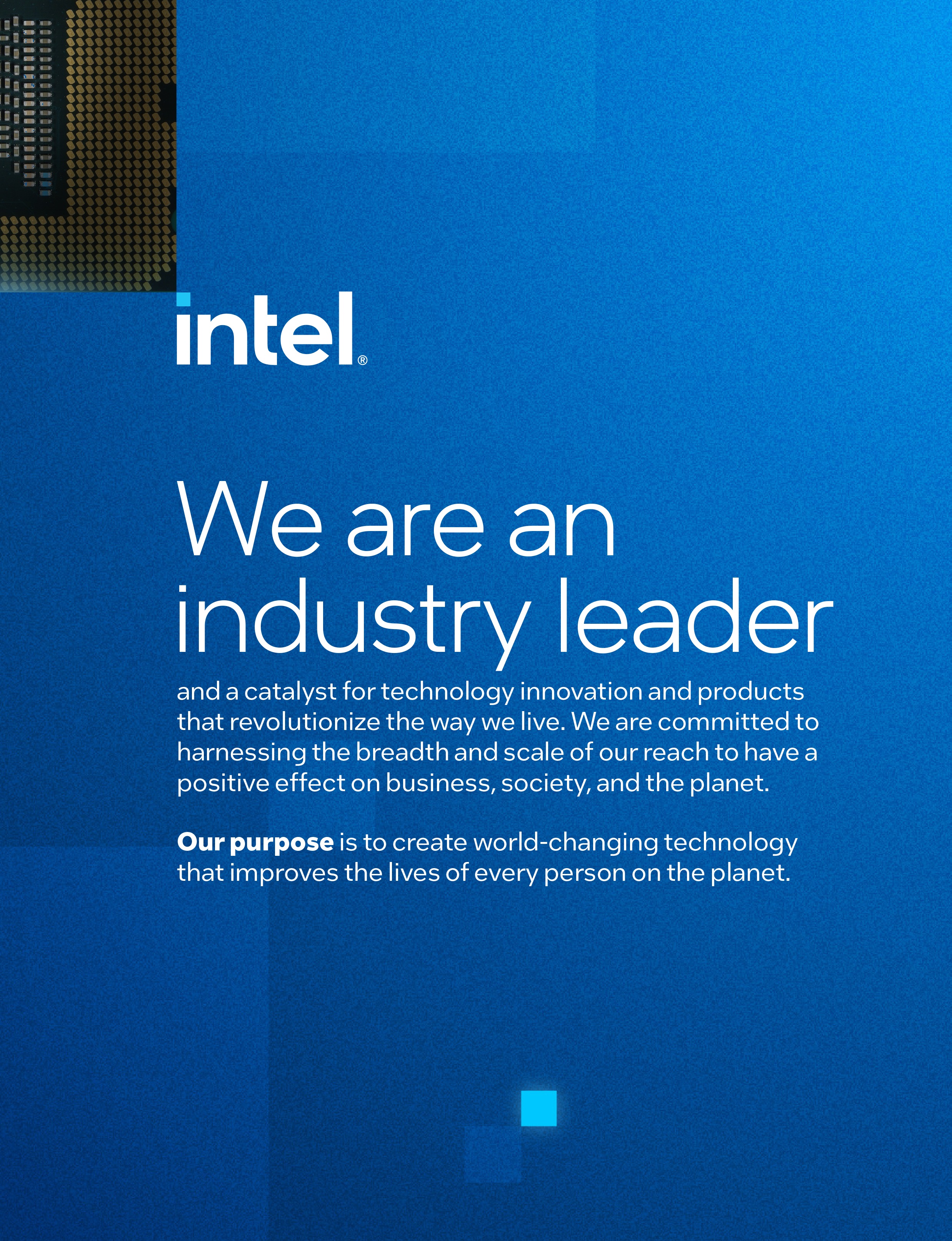
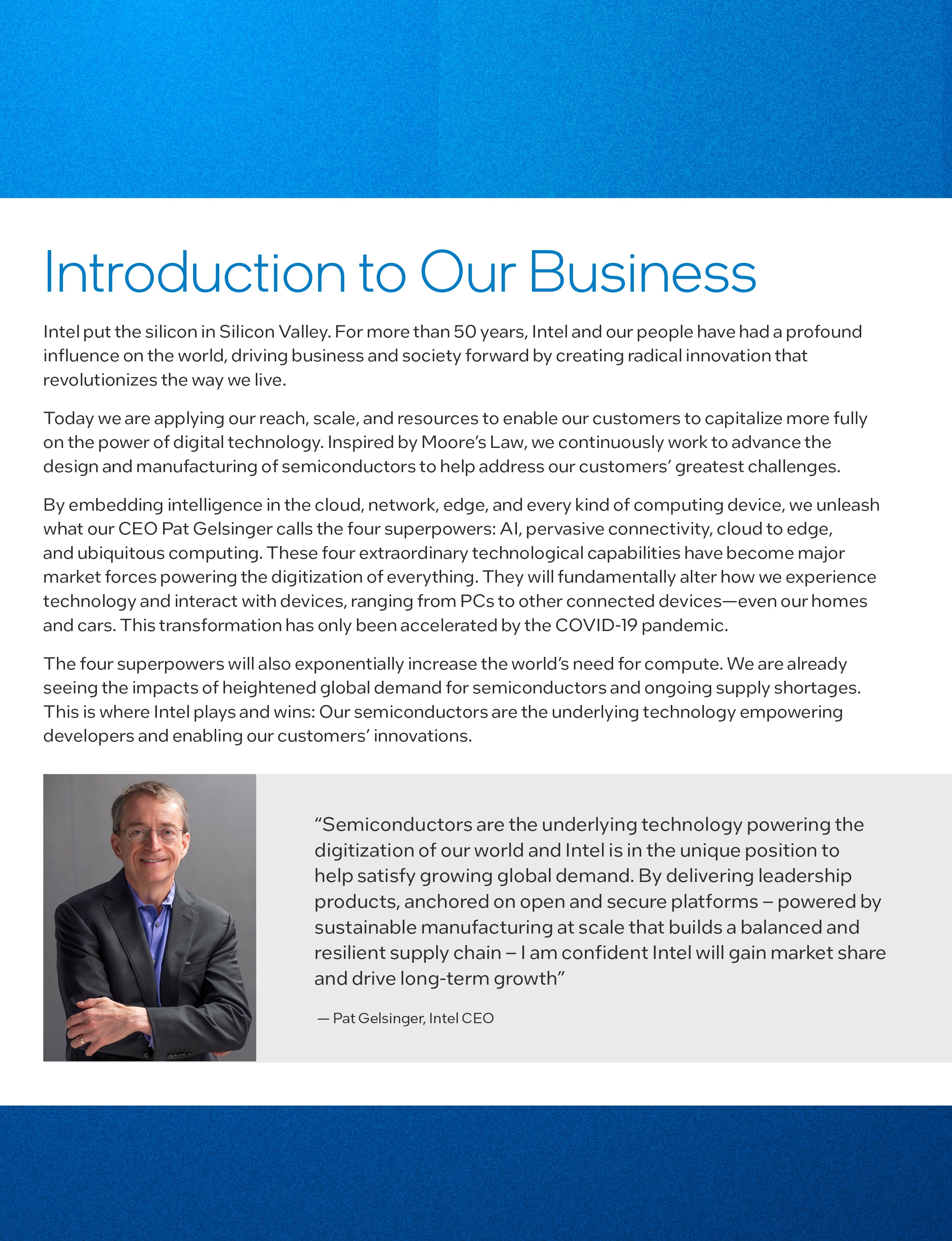
| | | | | | | |
Total revenue of $79.0 billion was up year over year, with CCG revenue up 1% and DCG revenue down 1%, both amid the effects of industry-wide supply constraints. We experienced strength in notebook demand and recovery in desktop demand, partially offset by lower notebook ASPs due to strength in the consumer and education market segments. DCG was down on lower ASPs driven by product mix and a competitive environment, partially offset by higher platform1 volume from recovery in the enterprise and government market segment. IOTG and Mobileye both achieved strong results on higher demand amid recovery from the economic impacts of COVID-19. We invested $15.2 billion in R&D, made capital investments of $18.7 billion, and generated $30.0 billion in cash from operations and $11.3 billion of free cash flow. | | | |
| |
| | "We achieved solid results amid a highly constrained industry-wide supply environment while continuing to maintain a strong balance sheet and liquidity position. With our IDM 2.0 strategy, we enter a phase of significant investment, positioning us for product leadership and long-term growth." —David Zinsner, Chief Financial Officer |
| | | | | | | | | | | | | | | | | | | | |
| Revenue | | Operating Income | | Diluted EPS | | Cash Flows |
■ GAAP $B ■ Non-GAAP $B | | ■ GAAP $B ■ Non-GAAP $B | | ■ GAAP ■ Non-GAAP | | ■ Operating Cash Flow $B ■ Free Cash Flow2 $B |
| | | | | | | | | | | | | | | | | | | | | | | | | | | | | | | | | | | | | | | | | |
| | | | | | |
| $79.0B | $74.7B | | $19.5B | | $22.2B | | $4.86 | | $5.47 | | $30.0B | | $11.3B |
| | | |
| GAAP | non-GAAP2 | | GAAP | | non-GAAP2 | | GAAP | | non-GAAP2 | | GAAP | | non-GAAP2 |
| Revenue up 1% from 2020 | Revenue up 2% from 2020 | | Operating income down $4.2B or 18% from 2020; 2021 operating margin at 25% | | Operating income down $2.2B or 9% from 2020; 2021 operating margin at 30% | | Diluted EPS down $0.08 or 2% from 2020 | | Diluted EPS up $0.37 or 7% from 2020 | | Operating cash flow down $5.4B or 15% | | Free cash flow down $9.9B or 47% |
| | | | | | | | | | | | |
| Higher revenue in CCG, IOTG, Mobileye, and PSG, partially offset by declines in DCG and NSG. Non-GAAP revenue excludes NSG. | | Higher gross margin from higher platform and adjacent1 revenue and Corporate revenue from a prepaid customer supply agreement, partially offset by a Corporate charge related to VLSI litigation, higher period charges from ramp of process technology, and higher operating expenses on increased R&D investment. Non-GAAP operating income incrementally excludes, amortization of acquisition-related intangibles, restructuring and the charge related to VLSI litigation. | | Lower operating income partially offset by equity investment gains, lower effective tax rate, and lower shares. Non-GAAP results incrementally exclude ongoing mark-to-market adjustments and tax impacts of non-GAAP adjustments. | | Lower operating cash flow driven by a decrease in net working capital
contributions and cash paid to settle a prepaid customer supply agreement in Q1 2021, partially offset by a McAfee special dividend received in Q3 2021. Free cash flow decreased due to lower operating cash flow and higher capital expenditures. |
Investing in our IDM 2.0 strategy for the long term
To support our IDM 2.0 strategy, we are making significant capital investments to increase our manufacturing capacity and accelerate our process technology roadmap, as well as increasing our investments in R&D. We believe these investments will position us for accelerating long-term revenue growth. We expect our long-term revenue outlook to accelerate to a 10% to 12% year-over-year growth rate by the end of our five-year horizon as supply normalizes and our investments add capacity and drive leadership products. We expect gross margins to be impacted by our investments in capacity and the acceleration of our process technology, resulting in expected non-GAAP gross margins percentages between 51% and 53%2 over the next several years before moving upward. We also expect our capital expenditures to increase above historical levels for the next several years. We expect our cash from operations to be strong, but our capital investments to pressure our free cash flow in the short term.
1 See "Our Products" within MD&A.
2 See "Non-GAAP Financial Measures" within MD&A.
| | | | | | | | |
| Fundamentals of Our Business | 4 |
New CEO and leadership team changes
Our new CEO Pat Gelsinger joined Intel on February 15, 2021 and made several senior leadership changes throughout the year. We also named our new CFO David Zinsner in January 2022. Mr. Gelsinger returns to Intel, where he previously spent 30 years of his career, learned at the feet of Intel’s founders, and served as our first Chief Technology Officer.
IDM 2.0
On March 23, 2021, we announced our "IDM 2.0" strategy, the next evolution of our IDM model. Our IDM 2.0 strategy combines our internal factory network, strategic use of external foundries, and our new IFS business to position us to drive technology and product leadership. To accelerate this strategy, we announced plans to invest $20 billion to build two new fabs in Arizona, which we broke ground on in September, and we recently announced plans to invest more than $20 billion in the construction of two new leading-edge fabs in Ohio. We also announced approximately $10.5 billion total investment to equip our Rio Rancho, New Mexico and Malaysia sites for advanced packaging manufacturing. In August, the US Department of Defense announced that IFS will lead the first phase of its multi-phase RAMP-C program to facilitate the use of a domestic commercial foundry infrastructure.
Process and packaging technology roadmaps
At the Intel Accelerated event in July 2021, we provided an update on our manufacturing process and packaging technology roadmaps. We introduced future nodes, including Intel 3 and Intel 20A, and discussed future process and packaging technologies, such as our PowerVia, RibbonFET, Foveros Omni, and Foveros Direct technologies. As part of the update, we also introduced a new naming structure for our manufacturing process nodes, which includes the name changes summarized in "Key Terms" within Notes to Consolidated Financial Statements.
| | | | | | | | |
| | |
12th Gen Intel® Core™ processors | | |
| We announced the 12th Gen Intel Core processor family (Alder Lake), the first on the Intel 7 process, with real-world performance for enthusiast gamers and professional creators. Alder Lake is the first processor based on our performance hybrid architecture featuring a combination of Performance-cores, the highest performing CPU cores Intel has built, and Efficient-cores designed for scalable multi-threaded workload performance. | |
| | |
| Ice Lake Server processors | | |
| We launched the 3rd Gen Intel® Xeon® Scalable CPU (Ice Lake), which boasts up to 40 cores and delivers a significant increase in performance, on average, compared to the previous generation. The chips include a set of built-in security features, cryptographic acceleration, and AI. | |
| 5G network products | | |
| We also introduced a broad, data-centric portfolio for 5G network infrastructure, including an SoC for wireless base stations, structured ASICs for 5G network acceleration, and a 5G network-optimized Ethernet NIC. | |
Intel® Arc™ graphics | | |
| We revealed the brand for our upcoming consumer high-performance graphics products: Intel Arc. The Arc brand will cover hardware, software, and services, and will span multiple hardware generations, with the first generation discrete GPU (Alchemist) based on the Xe HPG microarchitecture and shipping to OEMs in Q1 2022. | |
First closing of divestiture of NAND memory business
On December 29, 2021, subsequent to our fiscal 2021 year-end, we completed the first closing of the divestiture of our NAND memory business to SK hynix, Inc. (SK hynix). We intend to invest transaction proceeds to deliver leadership products and advance our long-term growth priorities.
| | | | | | | | |
| Fundamentals of Our Business | 5 |
The world is becoming more digital, and computing more pervasive. Semiconductors are the underlying technology powering the digitization of everything, which is being accelerated by four superpowers: ubiquitous compute, cloud-to-edge infrastructure, pervasive connectivity, and AI. Together these superpowers reinforce and amplify one another, and will exponentially increase the world’s need for computing by packing even more processing capability onto ever-smaller microchips. We intend to lead the industry by harnessing these superpowers for our customers’ growth and our own.
We are uniquely positioned with the depth and breadth of our software, silicon and platforms, and packaging and process technology with at-scale manufacturing. With these strengths and the tailwinds of the superpowers, our strategy to win is focused on three key themes: product leadership, open platforms, and manufacturing at scale.
Our Priorities
Lead and democratize compute with Intel x86 and xPU. Our product offerings provide end-to-end solutions, scaling from edge computing to 5G networks, the cloud, and the emerging fields of AI and autonomous driving, to serve an increasingly smart and connected world.
At our core is the x86 computing ecosystem, which supports an extensive and deep universe of software applications, with billions of lines of code written and optimized for x86 CPUs. We continue to advance this ecosystem with x86 microarchitectures focused on performance, which push the limits of low latency and single-threaded application performance, and microarchitectures focused on efficiency, which are designed for computing throughput efficiency to enable scalable multithreaded performance. Our innovative new 12th Gen client processors (Alder Lake) combine both performance cores and efficient cores in a performance hybrid architecture that can direct workloads to the right core depending on whether they require higher performance or power efficiency. We can also combine these architectural advances with our innovations in process and packaging technology, as in our next-generation Intel Xeon data center CPU (Sapphire Rapids), which will utilize performance cores on multiple compute tiles connected through our EMIB packaging technology in a scalable design, rather than being built on a monolithic silicon die.
Beyond the CPU, we are delivering a growing family of xPU products, which encompass client and data center GPUs, IPUs, FPGAs, and other accelerators. The xPU approach recognizes that different workloads benefit from different computing architectures, and our broad portfolio helps meet our customers' increasingly diverse computing needs. As part of our strategy, we seek to develop and offer leading products across each of these architectural categories. Our vision is that our products will help enable a future in which every human can have one petaflop of computing power and one petabyte of data less than one millisecond away.
| | | | | | | | |
| Fundamentals of Our Business | 6 |
We aim to deliver open software and hardware platforms with industry-defining standards. Around the globe, companies are building their networks, systems, and solutions on open standards-based platforms. Intel has helped set the stage for this movement, with our historic contributions in developing standards such as CXL, ThunderboltTM, and PCle. We also contributed to the design, build, and validation of new open-source products in the industry such as Linux, Android, and others. The world's developers constantly innovate and expand the capabilities of these open platforms while increasing their stability, reliability, and security. In addition, microservices have enabled the development of flexible, loosely coupled services that are connected via APIs to create end-to-end processes. We use industry collaboration, co-engineering, and open-source contributions to accelerate software innovation. Through our oneAPI initiative, developers use a unified language across CPUs, GPUs, and FPGAs to cut down on development time and to enhance productivity. We also deliver a steady stream of open-source code and optimizations for projects across virtually every platform and usage model. We are committed to co-engineering and jointly designing, building, and validating new products with software industry leaders to accelerate mutual technology advancements and help new software and hardware work better together. Our commitment extends to developers through our developer-first approach based on openness, choice, and trust.
In March 2021, we introduced IDM 2.0, the next evolution and expansion of our IDM model. IDM 2.0 is a differentiated strategy that combines three capabilities:
Internal factory network. Our global, internal factory network has been foundational to our success, enabling product optimization, improved economics, and supply resilience. We intend to remain a leading developer of process technology and a major manufacturer of semiconductors and will continue to build the majority of our products in our factories.
Strategic use of foundry capacity. We expect to expand our use of third-party foundry manufacturing capacity, which will provide us with increased flexibility and scale to optimize our product roadmaps for cost, performance, schedule, and supply. Our use of foundry capacity will include manufacturing for a range of modular tiles on advanced process technologies.
Foundry services. We intend to build a world-class foundry business to meet the growing global demand for semiconductors. We plan to differentiate our foundry offerings from those of others through a combination of leading-edge packaging and process technology, committed capacity in the US and Europe available for customers globally, and a world-class IP portfolio that will include x86 cores, as well as other ecosystem IP.
We believe our IDM 2.0 strategy will enable us to deliver leading process technology and products to meet growing demand, while providing superior capacity and supply resilience and an advantageous cost structure.
Delivering on our IDM 2.0 strategy and growth ambitions requires attracting, developing, and retaining top talent from across the world.
Fostering a culture of empowerment, inclusion, and accountability is also core to our strategy. We are committed to creating an inclusive workplace where the world’s best engineers and technologists can fulfill their dreams and create technology that improves the life of every person on the planet.
Growth Imperative
We are investing to position the company for accelerated long-term growth, focusing on both our core businesses and our growth businesses. In our client and server businesses, our strategy is to invest to strengthen the competitiveness of our product roadmap and to explore opportunities in both client and data center adjacencies. We believe we have significant opportunities to grow and gain share in graphics; mobility, including autonomous driving; networking and edge; and foundry services.
Focus on Innovation and Execution
We are focused on executing our product and process roadmap and accelerating our cadence of innovation. We have set a detailed process and packaging technology roadmap and announced key architectural innovations to further our goal of delivering leadership products in every area in which we compete. We are seeking to return our culture to its roots in innovation and execution, drawing on principles established by our former CEO Andy Grove that emphasize discipline and accountability.
| | | | | | | | |
| Fundamentals of Our Business | 7 |
We deploy various forms of capital to execute our strategy in a way that seeks to reflect our corporate values, help our customers succeed, and create value for our stakeholders.
| | | | | | | | | | |
| | | | |
| Capital | Strategy | Value |
| | | | |
| Financial |
| | | Leverage financial capital to invest in ourselves and drive our IDM 2.0 strategy, supplement and strengthen our capabilities through acquisitions, and provide returns to stockholders. | We strategically invest financial capital to create long-term value and provide returns to our stockholders. |
| | | | |
| | | | |
| Intellectual |
| | | Invest significantly in R&D and IP to enable us to deliver on our accelerated process technology roadmap, introduce leading x86 and xPU products, and develop new businesses and capabilities. | We develop IP to enable next-generation products, create synergies across our businesses, expand into new markets, and establish and support our brands. |
| | | | |
| | | | |
| Manufacturing |
| | | Aligned with our IDM 2.0 strategy, invest to efficiently build manufacturing capacity to address growing global demand for semiconductors. | Our geographically balanced manufacturing scope and scale enable us to provide our customers and consumers with a broad range of leading-edge products. |
| | | | |
| Human |
| | | Continue to build a diverse, inclusive, and safe work environment to attract, develop, and retain top talent needed to build transformative products. | Our talented employees enable the development of solutions and enhance the intellectual and manufacturing capital critical to helping our customers win the technology inflections of the future. |
| | | | |
| | | | |
| Social and Relationship |
| | | Build trusted relationships for both Intel and our stakeholders, including employees, suppliers, customers, local communities, and governments. | We collaborate with stakeholders on programs to empower underserved communities through education and technology, and on initiatives to advance accountability and capabilities across our global supply chain, including accountability for the respect of human rights. |
| | | | |
| | | | |
| Natural |
| | | Continually strive to reduce our environmental footprint through efficient and responsible use of natural resources and materials used to create our products. | With our proactive efforts, we seek to mitigate climate and water impacts, achieve efficiencies, and lower costs, and position us to respond to the expectations of our stakeholders. |
2030 RISE Strategy and Corporate Responsibility Goals
Our commitment to corporate responsibility and sustainability leadership is deeply integrated throughout our business. We strive to create an inclusive and positive work environment where every employee has a voice and a sense of belonging, and we are proactive in our efforts to reduce our environmental footprint through efficient and responsible use of natural resources and materials.
We continue to raise the bar for ourselves and leverage our leadership position in the global technology ecosystem to make greater strides in corporate responsibility and apply technology to address social and environmental challenges. Through our RISE strategy and 2030 goals, we aim to create a more responsible, inclusive, and sustainable world, enabled through our technology and the expertise and passion of our employees. Our corporate responsibility strategy is designed to increase the scale of our work through collaboration with our stakeholders and other organizations; we know that acting alone, we cannot achieve the broad social impact to which we aspire. More information about our 2030 goals, including progress we have made toward achieving them, is included in our Corporate Responsibility Report1.
1 The contents of our Corporate Responsibility Report are referenced for general information only and are not incorporated by reference in this Form 10-K.
| | | | | | | | | | | |
| Fundamentals of Our Business | Our Capital | 8 |
Our financial capital allocation strategy focuses on building stockholder value. Our allocation decisions are driven by our priorities to invest in the business, acquire and integrate businesses that complement our strategic objectives, and return cash to stockholders. As we invest in our IDM 2.0 strategy, our allocation priorities will shift more heavily toward investing in the business and away from share repurchases, as we plan our next phase of capacity expansions and the acceleration of our process technology roadmap. We will continue to look for opportunities to further our strategy through acquisitions and intend to maintain our dividend.
| | | |
| Cash from Operating Activities $B |
| | | | | | | | |
| ■ Capital Investment | ■ Free Cash Flow1 |
Our Financial Capital Allocation Decisions Are Driven by Three Priorities
Invest in the Business
Our first allocation priority is to invest in R&D and capital spending to capitalize on the opportunity presented by the world's demand for semiconductors. We expect to increase our R&D investment and our capital investments in support of our IDM 2.0 strategy.
Acquire and Integrate
Our second allocation priority is to invest in and acquire companies that complement our strategic objectives. We look for acquisitions that supplement and strengthen our capital and R&D investments. Our key acquisitions over the last three years include our 2020 acquisition of Moovit to accelerate Mobileye’s mobility-as-a-service offering and our 2019 acquisition of Habana Labs to strengthen and extend the reach of our AI portfolio.
We take action when investments do not strategically align to our key priorities, and subsequent to our fiscal 2021 year-end, we completed the first closing of the divestiture of our NAND memory business. Additionally, in 2020 we completed the divestiture of the majority of Home Gateway Platform, a division of CCG, and in 2019 we divested the majority of our smartphone modem business.
Return Cash to Stockholders
Our third allocation priority is to return cash to stockholders. We achieve this through our dividend and share repurchase programs. We expect our future stock repurchases to be significantly below our levels from the last few years.
| | | | | | | | | |
| R&D and Capital Investments $B | | Cash to Stockholders $B |
| | | | | | | | | | | | | | | | | | | | | | | | | | | | |
| | ■ R&D | ■ Logic | ■ Memory2 | | | ■ Buyback | ■ Dividend | | |
| | |
1 See "Non-GAAP Financial Measures" within MD&A.
2 2021 capital investments in Memory are not presented due to the divestiture of the NAND memory business announced in October 2020. 2017-2020 capital investments presented include Memory.
| | | | | | | | | | | |
| Fundamentals of Our Business | Our Capital | 9 |
Research and Development
R&D investment is critical to enable us to deliver on our accelerated process technology roadmap, introduce leading products, and develop new businesses and capabilities in the future. We seek to protect our R&D efforts through our IP rights and may augment R&D initiatives by acquiring or investing in companies, entering into R&D agreements, and directly purchasing or licensing technology.
Areas Key to Product Leadership
Every year we make significant investments in R&D and we have intensified our focus on areas key to product leadership. Our objective with each new generation of products is to improve user experiences and value through advances in performance, power, cost, connectivity, security, form factor, and other features. We also focus on reducing our design complexity, re-using IP, and increasing ecosystem collaboration to improve our efficiency.
| | | | | |
| |
| |
Process and packaging. At our Intel Accelerated event in July 2021, we provided an update on our manufacturing process and packaging technology roadmaps. As part of the update, we also introduced a new naming structure for our manufacturing process nodes, which includes the name changes summarized in "Key Terms". In addition, we introduced future nodes and discussed future process and packaging technologies on our roadmap. Our updates included the following: |
▪We introduced further optimizations to our Intel 7 process node, which is now in production for our 12th Gen Intel Core (Alder Lake) processors. ▪Intel 4 will make use of EUV to print incredibly small features using ultra-short wavelength light. Intel 4 will be used for our future Meteor Lake client processors. ▪Intel 3 will leverage further FinFET optimizations and increased EUV to deliver additional performance-per-watt and area improvements over Intel 4. ▪Intel 20A will follow Intel 3 and will introduce two breakthrough technologies: Ribbon FET and PowerVia. RibbonFET, Intel’s implementation of a gate-all-around transistor, will be our first new transistor architecture since we pioneered FinFET in 2011. The technology is expected to deliver faster transistor switching speeds while achieving the same drive current as multiple fins in a smaller footprint. PowerVia will be our unique industry-first implementation of backside power delivery, optimizing signal transmission by eliminating the need for power routing on the front side of the wafer. ▪Beyond Intel 20A, we are developing our Intel 18A node, with expected refinements to RibbonFET to deliver additional transistor performance improvements. We are also working to define, build, and deploy next-generation High Numerical Aperture EUV in our process technology roadmap. ▪Our future Foveros Omni advanced packaging technology will usher in the next generation of our 3D stacking Foveros technology, enabling us to mix multiple top die tiles with multiple base tiles across mixed fab nodes and giving us greater flexibility for disaggregated chip designs. With our future Foveros Direct technology, we will move to direct copper-to-copper bonding for low-resistance interconnects and blur the boundary between where the wafer ends and the package begins.
|
xPU architecture. The future is a diverse mix of scalar, vector, matrix, and spatial architectures deployed in CPU, GPU, accelerator, and FPGA sockets, enabled by a scalable software stack and integrated into systems by advanced packaging technology. We are building processors that span several major computing architectures, moving toward an era of heterogeneous computing: |
▪CPU. We started shipping our 3rd Gen Xeon Scalable processors (Ice Lake) with the new Sunny Cove core, built-in AI acceleration, cryptographic acceleration, and advanced security capabilities. We also launched our 12th Gen Intel Core processors (Alder Lake), which will scale from thin and light laptops to enthusiast desktop and notebook platforms. They utilize the new breakthrough Performance-core (Golden Cove) and Efficient-core (Gracemont) microarchitectures and work with Intel® Thread Director for scheduling optimization.
▪GPU. We announced Alchemist, our first Intel Arc branded high-performance discrete GPU family of products focused on gaming and content creation, which began shipping to OEMs in Q1 2022. We also powered on Ponte Vecchio, our discrete GPU focused on high-performance computing applications, which delivers leading floating-point operations per second (FLOPS) and compute density to accelerate AI, high-performance computing, and advanced analytics workloads. Ponte Vecchio will be released in 2022 for HPC and AI markets.
▪Interconnect. Mount Evans, Intel’s first ASIC IPU, is designed to address the complexity of diverse and dispersed data centers. An IPU is designed to enable cloud and communication service providers to reduce overhead and free up performance for CPUs.
▪Matrix Accelerator. Habana Gaudi accelerators are at the forefront of AI solutions for data centers. Amazon Web Services launched the EC2 DL1 instance featuring Habana Gaudi in Amazon Elastic Compute Cloud for training deep learning models.
| | | | | | | | | | | |
| Fundamentals of Our Business | Our Capital | 10 |
Software. Software unleashes the potential of our hardware platforms across all workloads, domains, and architectures.
▪In 2021, oneAPI adoption expanded across the industry. oneAPI enables developers to build cross-architecture applications using a single code base across xPUs that take advantage of unique hardware features and lower software development and maintenance costs. Developers can choose the best architecture for the problem at hand without rewriting their entire code base, accelerating their time to value.
▪We seek to accelerate adoption of oneAPI and Intel software developer tools through diverse ecosystem activities including developer trainings, summits, centers of excellence, and access to Intel hardware and software through a developer cloud. The Intel® DevCloud for oneAPI hosts global users spanning AI, data science, high-performance computing, and media & graphics and other accelerated computing workloads.
▪We believe AI will be ubiquitous, and with our tools and the broad open software ecosystem, we are well-positioned to scale AI. We optimize for the most widely used AI frameworks and libraries, including TensorFlow, Pytorch, Scikit-learn, NumPy, XGBoost, and Spark, with certain optimizations delivering up to 10 to 100 times performance improvements to support end-to-end AI, as well as OpenVINOTM and oneAPI AI Analytics toolkits.
▪We seek to continually improve our BIOS and firmware in support of our client, data center, networking, and graphics products, including delivering simplified and cloud-optimized open firmware for data center customers through our Firmware Support Package and Minimum Platform Architecture.
IP Rights
We own and develop significant IP and related IP rights around the world that support our products, services, R&D, and other activities and assets. Our IP portfolio includes patents, copyrights, trade secrets, trademarks, mask works, and other rights. We actively seek to protect our global IP rights and to deter unauthorized use of our IP and other assets.
We have obtained patents in the US and other countries. Because of the fast pace of innovation and product development, our products are often obsolete before the patents related to them expire, and in some cases may be obsolete before the patents are granted. As we expand our product offerings into new areas, we also seek to extend our patent development efforts to patent such products. In addition to developing patents based on our own R&D efforts, we may purchase or license patents from third parties.
The software that we distribute, including software embedded in our products, is entitled to copyright and other IP protection. To distinguish our products from our competitors' products, we have obtained trademarks and trade names for our products, and we maintain cooperative advertising programs with customers to promote our brands and to identify products containing genuine Intel components. We also protect details about our processes, products, and strategies as trade secrets, keeping confidential the information that we believe provides us with a competitive advantage.
Efforts to protect our IP can be difficult, particularly in countries that provide less protection to IP rights and in the absence of harmonized international IP standards. Competitors and others may already have IP rights covering similar products. There is no assurance that we will be able to obtain IP rights covering our own products, or that we will be able to obtain IP licenses from other companies on favorable terms or at all. For a discussion of IP-related risks, see "Risk Factors" within Other Key Information. While our IP rights are important to our success, our business as a whole is not significantly dependent on any single patent, copyright, or other IP right.
| | | | | | | | |
| "Here at Intel, we take pride in attracting some of the world’s best engineers, technologists, and innovators. We are advocates for a patent system that eliminates abuse by hedge funds and others who exploit weaknesses in the system to drive their profits at the expense of those of us who actually invent, create, and produce products that are central to the modern economy."
—Steve Rodgers, Executive Vice President and General Counsel |
Inspired by Moore's Law, a law of economics put forth by our co-founder Gordon Moore more than 50 years ago, we continuously work to advance the design and manufacturing of semiconductors to help address our customers' greatest challenges. This makes possible the innovation of new products with higher performance while balancing power efficiency, cost, and size. We continue to work across our supply chain to minimize disruptions, improve productivity, and increase overall capacity and output to meet customer expectations. In 2021, our factories performed well in a highly dynamic environment, where we adapted to rapid demand shifts and industry component shortages affecting us and our customers.
Our IDM 2.0 strategy allows us to deliver leadership products through the use of internal and external capacity while leveraging our core strengths for growth via providing foundry services to others. IDM 2.0 combines three factors. First, we will continue to build the majority of our products in Intel fabs. Second, we expect our use of third party foundry capacity to grow and to include manufacturing for a range of modular tiles on advanced process technologies. Third, we intend to build a world-class foundry business with IFS, which will combine leading-edge process and packaging technology, committed capacity in the US and Europe, and a world-class IP portfolio for customers, including x86 cores. During the year we began shipping packaging units for our first IFS customer, Amazon Web Services.
| | | | | | | | | | | |
| Fundamentals of Our Business | Our Capital | 11 |
| | | | | |
| “In alignment with our IDM 2.0 strategy, we are repositioning Intel for growth by increasing our investment in internal manufacturing, expanding our global capacity for supply chain resiliency, and delivering on world class manufacturing execution.”
—Keyvan Esfarjani, Senior Vice President and General Manager of Manufacturing, Supply Chain, and Operations |
|
| | | | | |
| "Process and packaging are at the very heart of Intel’s heritage and are the foundation of everything we build. With the roadmaps we unveiled this year, we plan to accelerate our rate of innovation to reach process performance-per-watt parity by 2024 and leadership by 2025, and to maintain advanced packaging leadership."
—Dr. Ann Kelleher, Executive Vice President and General Manager of Technology Development
|
|
Network and Supply Chain
Our global supply chain supports internal partners across architecture, product design, technology development, manufacturing and operations, sales and marketing, and business units, and our supply ecosystem comprises thousands of suppliers globally. Our mission is to enable product and process leadership, industry-leading total cost of ownership, and uninterrupted supply for our customers. In addition to our own manufacturing capacity, we continue to expand our use of third-party foundries.
The majority of our logic wafer manufacturing is conducted in the US. As of our fiscal 2021 year-end, we had ten manufacturing sites — six are wafer fabrication and four are assembly/test facilities. The following map shows these factory sites and the countries where we have a significant R&D and/or sales presence. In response to COVID-19, we maintained operational changes and measures to enable a continued safe environment for our employees and operation of our manufacturing sites.
Our manufacturing facilities are primarily used for silicon wafer manufacturing, assembling, and testing of our platform products. We operate in a network of manufacturing facilities integrated as one factory to provide the most flexible supply capacity, allowing us to better analyze our production costs and adapt to changes in capacity needs. Our new process technologies are transferred identically from a central development fab to each manufacturing facility. After transfer, the network of factories and the development fab collaborate to continue driving operational improvements. This enables fast ramp of the operation, fast learning, and quality control. We are expanding manufacturing capacity across multiple sites, including Arizona, Ireland, Israel, and Oregon. To accelerate our IDM 2.0 strategy, we announced plans to invest $20 billion to build two new fabs in Arizona, which we broke ground on in September, and we recently announced plans to invest more than $20 billion in the construction of two new leading-edge fabs in Ohio, while actively searching for additional manufacturing locations in Europe. Our plans include utilizing a "smart capital" strategy in which we focus first on aggressively building out fab shells, which are the smaller portion of the overall cost of a fab but have the longest lead time, giving us flexibility in how and when we bring additional capacity and tools online. We also announced approximately $10.5 billion total investment to equip our Rio Rancho, New Mexico and Malaysia sites for advanced packaging manufacturing.
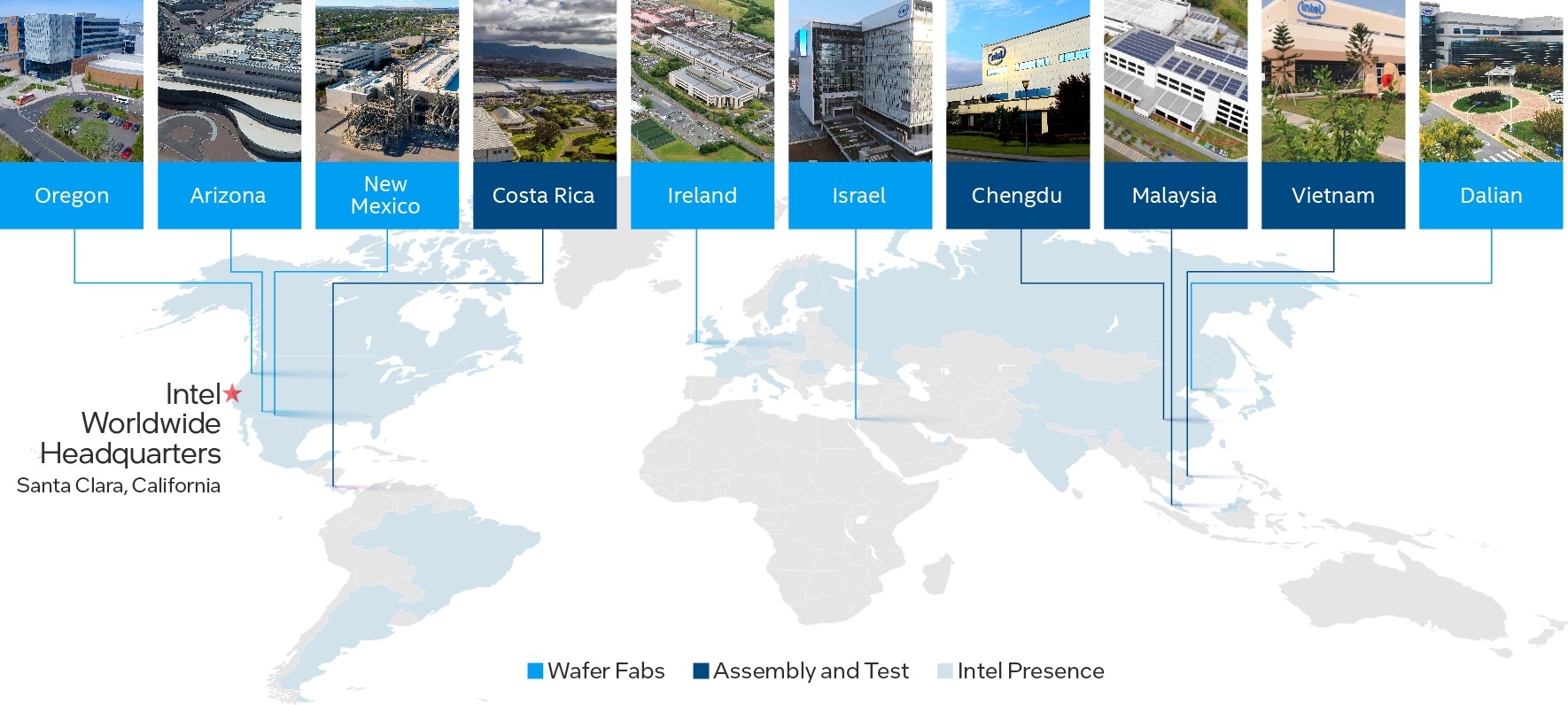
Note: The Dalian factory, presented above, was sold subsequent to year-end as part of the first closing of the divestiture of our NAND Memory business. See Note 10 : Acquisitions and Divestitures.
| | | | | | | | | | | |
| Fundamentals of Our Business | Our Capital | 12 |
Our human capital strategy is grounded in our belief that our people are fundamental to our success. Delivering on our IDM 2.0 strategy and growth ambitions requires attracting, developing, and retaining top talent from across the world. We are committed to creating an inclusive workplace where the world’s best engineers and technologists can fulfill their dreams and create technology that improves the life of every person on the planet. We invest in our highly skilled workforce of 121,100 people through creating practices, programs and benefits that support the evolving world of work and our employees’ needs.
Fostering a culture of empowerment, inclusion, and accountability is also core to our IDM 2.0 strategy. We are focused on reinvigorating our culture to strengthen our execution and accelerate our cadence of innovation. Our values—customer first, fearless innovation, results driven, one Intel, inclusion, quality, and integrity—inspire us and are key to delivering on our purpose. This year, we added a new value—results driven—as we seek to return to our roots of innovation and execution, making data-driven decisions quickly and setting disciplined goals that drive business results. All employees are responsible for upholding these values, the Intel Code of Conduct, and Intel's Global Human Rights Principles, which form the foundation of our policies and practices and ethical business culture.
| | | | | | | | |
| | | |
| | | | |
| | "At Intel we tackle hard problems, think boldly, and create technology that improves the life of every person on the planet. Our culture unleashes the diverse perspectives, experiences, and potential of our employees to drive innovation and business results for Intel and our customers."
—Christy Pambianchi, Executive Vice President and Chief People Officer
| | |
Talent Management
The digitization of everything is driving growth and global demand for semiconductors. Combined with the tightening labor market and economic recovery from COVID-19, this has driven a significant increase in competition throughout the industry to attract and retain talent – especially technical talent. In 2021, we intensified our efforts to continue to attract and retain talent, including introducing new employee referral programs, expanding wellness benefits and time off, heightening our focus on revitalizing our culture, and increasing mentoring in our technical community. In 2021, our undesired turnover rate1 was 5.6%, compared to 4.0% in 2020.
We invest significant resources to develop the talent needed to remain at the forefront of innovation and make Intel an employer of choice. We offer extensive training programs and provide rotational assignment opportunities. We evolved our performance management system to support our culture evolution and increase our focus on disciplined goal setting and results. Through our annual Employee Experience Surveys and Manager Development Feedback Surveys, employees can voice their perceptions of the company, their managers, their work experience, and learning and development opportunities.
| | | | | | | |
| Inclusion | | | |
Diversity and inclusion are core to Intel's values and instrumental to driving innovation and positioning us for growth. Over the past decade, we have taken actions to integrate diversity and inclusion expectations into our culture, performance and management systems, leadership expectations, and annual bonus metrics. We are proud of what we have accomplished to advance diversity and inclusion, but we recognize we still have work to do, including beyond the walls of Intel. We also recognize the additional challenges that COVID-19 has presented to our employees, including women and individuals with disabilities. Our RISE strategy and 2030 goals set our global ambitions for the rest of the decade, including doubling the number of women in senior leadership; doubling the number of underrepresented minorities in US senior leadership; and embedding inclusive leadership practices across our business. Our goals also include increasing the percentage of employees who self-identify as having a disability to 10%; and exceeding 40% representation of women in technical roles, including engineering positions and other roles with technical job requirements. To drive accountability, we continue to link a portion of our executive and employee compensation to diversity and inclusion metrics. We have committed our scale, expertise, and reach through our comprehensive RISE strategy to work with customers and other stakeholders to accelerate the adoption of inclusive business practices across industries. In 2021, we partnered with other technology companies to launch the Alliance for Global Inclusion to create and implement an Inclusion Index with unified goals and metrics. This collective effort will allow the industry to more clearly identify actions needed to advance progress on closing persistent gaps and advancing more inclusive practices in workplaces, industry, and society. We will also continue to collaborate on initiatives that expand the diverse pipeline of talent for our industry, advance social equity, make technology fully inclusive, and expand digital readiness for millions of people around the world. | | |
| |
| |
| |
| |
| |
1 Undesired turnover includes all regular Intel employees who voluntarily left Intel, but do not include Intel contract employees, interns, or employees who separated from Intel due to divestiture, retirement, voluntary separation packages, death, job elimination, or redeployment.
2 Senior leadership refers to salary grades 10+ and equivalent grades. While we present male and female, we acknowledge this is not fully encompassing of all gender identities.
3 The term underrepresented minority (URM) is used to describe diverse populations, including Black/African American, Hispanic, and Native American employees in the US.
| | | | | | | | | | | |
| Fundamentals of Our Business | Our Capital | 13 |
Compensation and Benefits
We structure pay, benefits, and services to meet the varying needs of our employees. Our total rewards package includes market-competitive pay, broad-based stock grants and bonuses, an employee stock purchase plan, healthcare and retirement benefits, paid time off and family leave, parent reintegration, fertility assistance, flexible work schedules, sabbaticals, and on-site services. Since 2019, we have achieved gender pay equity globally and we continue to maintain race/ethnicity pay equity in the US. We achieve pay equity by closing the gap in average pay between employees of different genders or race/ethnicity in the same or similar roles after accounting for legitimate business factors that can explain differences, such as location, time at grade level, and tenure. We have also advanced transparency in our pay and representation data by publicly releasing our EEO-1 survey pay data since 2019. We believe that our holistic approach toward pay equity, representation, and creating an inclusive culture enables us to cultivate a workplace that helps employees develop and progress in their careers at all levels. Though flexible work schedules are part of our existing total rewards package, the COVID-19 pandemic provided an opportunity to further reimagine how our employees work and collaborate. In designing the future of our workplace, we surveyed employees around the globe to inform our “hybrid-first” approach, where the majority of our employees will split their time between working remotely and in the office, with no company-wide mandate on the number of days per week employees should be on-site or how they should collaborate. Our goal is to enable remote and on-site work where it drives the best output, while ensuring our employees have equitable access to systems, resources, and opportunities that allow them to succeed.
Health, Safety, and Wellness
Our commitment in Intel's Environmental, Health, and Safety Policy is to provide a safe and injury-free workplace. We continually invest in programs designed to improve physical, mental, and social well-being. We provide access to a variety of innovative, flexible, and convenient health and wellness programs, including on-site health centers. Throughout our response to COVID-19, our priority has remained protecting the health and safety of our employees. This includes mental health, as we aim to increase awareness of and support for mental and behavioral health. In support of our 2030 goals, we will continue to build our strong safety culture and drive global expansion of our corporate wellness program through employee education and engagement activities.
| | | | | |
| Social and Relationship Capital |
We are committed to engaging in corporate responsibility and sustainability initiatives that support our communities and help us develop trusted relationships with our stakeholders. Proactive engagement with our stakeholders and investments in social impact initiatives, including those aligned with the United Nations Sustainable Development Goals, advance our position as a leading corporate citizen and create shared value for Intel, our global supply chain, and our communities.
Economic and social. The health of our business and local economies depends on continued investments in innovation. We provide high-skill, high-paying jobs around the world. Many of these are manufacturing and R&D jobs located in our own domestic and international factories. We also benefit economies through our R&D ecosystem spending, sourcing activities, consumer spending by our employees, and tax payments. We make sizable capital investments and provide leadership in public-private partnerships to spur economic growth and innovation. We engage third-party organizations to conduct analyses of the economic impact of our operations, including a US impact study in 2021 that found that for every US Intel job, Intel's economic activity in the US indirectly supports an additional 13 jobs.
We stand at the forefront of new technologies that are increasingly being used to empower individuals, companies, and governments around the world to solve global challenges. We also aim to empower people through education and advance social initiatives to create career pathways into the technology industry. This has included our global Intel Digital Readiness Programs, such as AI for Youth and AI for Workforce, scaled in partnership with governments and institutions to empower individuals with digital readiness and AI skills. Additionally, we have invested in multi-year partnerships with historically Black colleges and universities in the US to increase the number of Black/African Americans who pursue electrical engineering, computer engineering, and computer science fields. Our employees and retirees share their expertise through volunteer initiatives in the communities where we operate, volunteering more than 1.71 million hours over the past two years. These efforts contribute to the 2030 goal we established last year to volunteer 10 million hours over a decade. COVID-19 presented challenges over the last two years for in-person volunteering, but we continued to see an outpouring of support from employees in 2021 for virtual volunteering, donations, and innovative technology projects to support our communities. In 2020 we announced the Pandemic Response Technology Initiative to combat COVID-19. We expanded the initiative in 2021 and renamed it the RISE Technology Initiative to reflect a broader platform for action. It provides an expanded channel to build deeper relationships with our customers and partners aligned with our corporate purpose and work to create shared value through our 2030 RISE strategy. Specifically, we are funding projects in areas that include using technology to improve health and safety; making technology more inclusive while expanding digital readiness; and carbon neutral computing to help address climate change.
Human rights commitment. We are committed to maintaining and improving processes to avoid complicity in human rights violations related to our operations, supply chain, and products. We have established an integrated approach to managing human rights across our business, including board-level oversight and the involvement of senior-level Management Review Committees. We also meet throughout the year with external stakeholders and experts on human rights to continue to inform and evolve our human rights policies and oversight processes. While we do not always know nor can we control what products our customers create or the applications end users may develop, we do not tolerate our products being used to violate human rights. Where we become aware of a concern that our products are being used by a business partner in connection with abuses of human rights, we restrict or cease business with the third party until we have high confidence that our products are not being used to violate human rights.
1 This is a preliminary estimate. The final number will be reported in our 2021-22 Corporate Responsibility Report, to be issued later in 2022.
| | | | | | | | | | | |
| Fundamentals of Our Business | Our Capital | 14 |
Supply Chain Responsibility
We actively manage our supply chain to help reduce risk, improve product quality, achieve environmental and social goals, and improve overall performance and value creation for Intel, our customers, and our suppliers. To drive responsible and sustainable practices throughout our supply chain, we have robust programs to educate and engage suppliers that support our global manufacturing operations. We actively collaborate with other companies and lead industry initiatives on key issues such as improving transparency around climate and water impacts in the global electronics supply chain and, as part of our RISE strategy, we are advancing collaboration across our industry on responsible minerals sourcing. Through these efforts we help set electronics industry-wide standards, develop audit processes, and conduct training.
Over the past decade, we have directly engaged with our suppliers to verify compliance and build capacity to address risks of forced and bonded labor and other human rights issues. We perform supplier audits and identify critical direct suppliers to engage through capability-building programs, which help suppliers build sustainability acumen and verify compliance with the Responsible Business Alliance and our Code of Conduct. We also engage with indirect suppliers through our programs on forced and bonded labor, responsible minerals, and supplier diversity. To achieve our 2030 RISE goals, we will significantly expand the number of suppliers covered by our engagement activities.
Our commitment to diversity and inclusion also extends to our suppliers. We believe a diverse supply chain supports greater innovation and value for our business. We have set additional spending targets with women-owned suppliers outside the US and with minority-owned suppliers globally to accelerate progress toward our goal to increase global annual spending with diverse suppliers by 100% to reach $2 billion in annual spending by 2030. Continuing in 2022, we will only retain or use outside law firms in the US that are above average on diversity for their equity partners. We are applying a similar rule to firms used by our tax department, including non-legal firms.
Driving to the lowest possible environmental footprint as we grow helps us create efficiencies, lower costs, and respond to the needs of our stakeholders. We invest in conservation projects and set company-wide environmental targets to drive reductions in greenhouse gas emissions, energy use, water use, and waste generation. We build energy efficiency into our products to help our customers lower their own emissions and energy costs, and we collaborate with policymakers and other stakeholders to use technology to address environmental challenges. Through our 2030 goals we will continue to drive to higher levels of operational efficiency, including a goal of a further 10% reduction in our carbon emissions on an absolute basis even as we continue to grow. In 2021, we continued to take action on emissions reduction strategies focused on emissions abatement, additional investments in renewable electricity, process and equipment optimization, and energy conservation. Our 2030 strategy and goals also focus on improving product energy efficiency and increasing our "handprint"—the ways in which Intel technologies can help others reduce their footprints, including Internet of Things solutions that enable intelligence in machines, buildings, supply chains, and factories, and make electrical grids smarter, safer, and more efficient.
Climate and Energy
We focus on reducing our own climate impact, and over the past two decades have reduced our direct emissions and indirect emissions associated with energy consumption. Through our 2030 goals we have committed to conserve an additional 4 billion kWh of energy over 10 years. We have conserved more than 310 million kWh1 of energy since 2020. We also continue to link a portion of our executive and employee performance bonus to our corporate sustainability metrics. In 2021, this included our target to save 125 million kWh of energy during the year. We also invest in green power and on-site alternative energy projects in support of our 2030 goal to achieve 100% renewable energy use across our global manufacturing operations. We have reached 81%1 renewable energy globally. We are committed to transparency around our carbon footprint and climate risk and use the framework developed by the TCFD to inform our disclosure on climate governance, strategy, risk management, and metrics and targets. For governance and strategy, we follow an integrated approach to address climate change, with multiple teams responsible for managing climate-related activities, initiatives, and policies. Strategies and progress toward goals are reviewed with senior executives and the Intel Board of Directors' Corporate Governance and Nominating Committee. We describe our overall risk management processes in our Proxy Statement, and describe our climate-related risks and opportunities in our annual Corporate Responsibility Report, the Intel Climate Change Policy, and "Risk Factors" within this Form 10-K. In addition to what is included within this Form 10-K, information about and progress toward our 2030 goals is included in our Corporate Responsibility Report. Our Corporate Responsibility Report also includes a mapping of our disclosure to the TCFD, the Sustainability Accounting Standards Board framework, and our CDP Climate Change Survey, all of which are available on our website.2
1 This is a preliminary estimate. The final number will be reported in our 2021-22 Corporate Responsibility Report, to be issued later in 2022.
2 The contents of our website and our Corporate Responsibility Report, Climate Change Policy, and CDP Climate Change Survey are referenced for general information only and are not incorporated by reference in this Form 10-K.
| | | | | | | | | | | |
| Fundamentals of Our Business | Our Capital | 15 |
Water Stewardship
Water is essential to the semiconductor manufacturing process. We use ultrapure water to remove impurities from our silicon wafers, and we use fresh and reclaimed water to run our manufacturing facility systems. Through our 2030 goals, we have committed to conserve an additional 60 billion gallons in this decade. As part of this commitment, we plan to achieve net positive water use globally. We have conserved 15.4 billion gallons1 of water and enabled restoration of 3.5 billion gallons1 of water since 2020. In 2021, we linked a portion of our executive and employee performance bonus to our targets to conserve 7.5 billion gallons of water in our operations and complete projects to restore more than 1.5 billion gallons to local watersheds.
Circular Economy and Waste Management
We have long been committed to waste management, recycling, and circular economy strategies that enable the recovery and productive re-use of waste streams. Our 2030 goals include a target of zero total waste2 to landfill, as well as implementation of circular economy strategies for 60% of our manufacturing waste streams in partnership with our suppliers. This can include reuse of waste streams directly in our own operations or enabling reuse of our waste streams by other industries. Our 2030 goal of 60% will be challenging, given our projected operational growth and new waste streams, suppliers, and locations that will require new circular economy strategies. We continue to focus on opportunities to upcycle waste by working further on waste segregation practices and collaborating with our suppliers to evaluate new technologies for waste recovery.
'
1 This is a preliminary estimate. The final number will be reported in our 2021-22 Corporate Responsibility Report, to be issued later in 2022.
2 Intel defines zero waste as less than 1%.
| | | | | | | | | | | |
| Fundamentals of Our Business | Our Capital | 16 |
Value We Create
Each of our six forms of capital plays a critical role in our long-term value creation. We consider numerous indicators in determining the success of our capital deployment in creating value. Highlights of value created are as follows:
1 This is a preliminary estimate. The final number will be reported in our 2021-22 Corporate Responsibility Report, to be issued later in 2022.
2 See "Non-GAAP Financial Measures" within MD&A.
Note: The Dalian factory was sold subsequent to year-end as part of the first closing of the divestiture of our NAND Memory business. See Note 10 : Acquisitions and Divestitures.
| | | | | | | | | | | |
| Fundamentals of Our Business | Our Capital | 17 |
| | | | | |
Management's Discussion and Analysis | |
| |
Our Products
Our product offerings provide end-to-end solutions, scaling from edge computing to 5G networks, the cloud, and the emerging fields of AI and autonomous driving. Products, such as our gaming CPUs, may be sold directly to end consumers, or they may be further integrated by our customers into end products such as notebooks and storage servers. Combining some of these products—for example, integrating FPGAs and memory with Intel Xeon processors in a data center solution—enables incremental synergistic value and performance. We launched new products in 2021, such as the 12th Gen Intel Core processors (Alder Lake), the first on the Intel 7 process, and 3rd Gen Intel Xeon Scalable processors (Ice Lake).
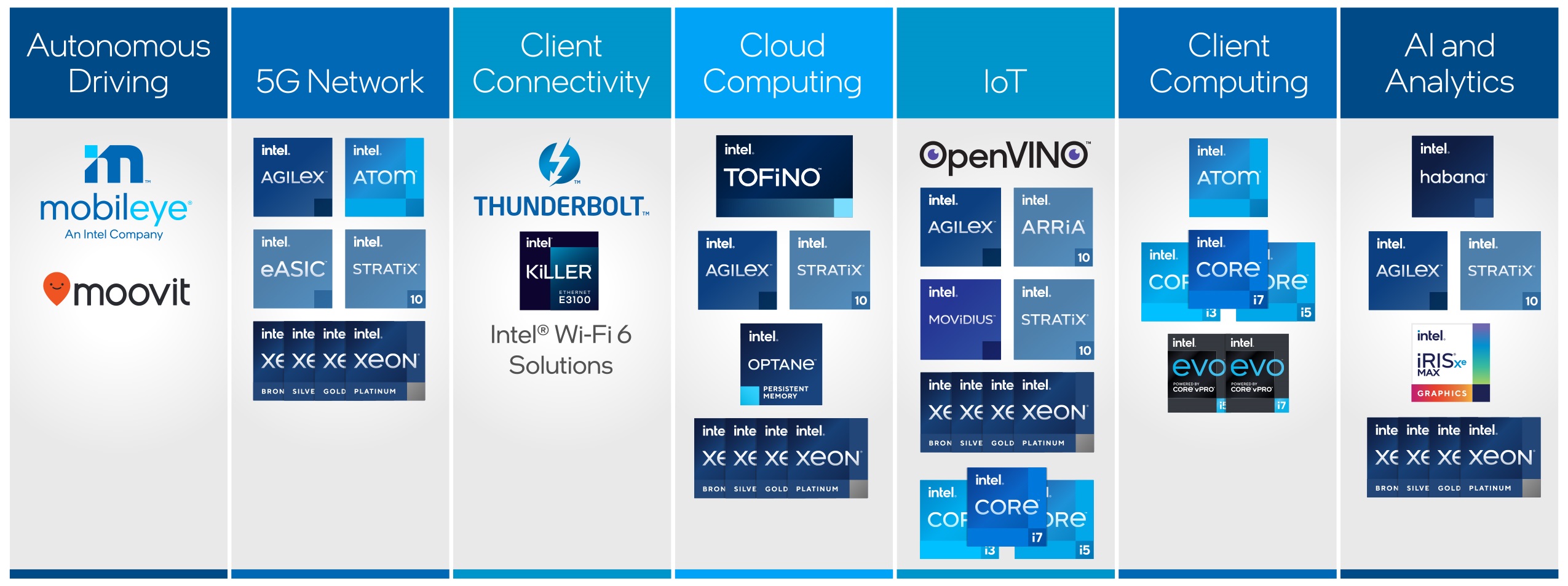
Platform Products: Our platform products can be a CPU and chipset, an SoC, or a multichip package based on Intel® architecture that processes data and controls other devices in a system. The primary CPU products in CCG are our Intel Core and Intel Atom® processors, which include Intel Core processors designed specifically for notebook and desktop applications. We introduced our 12th Gen Intel Core desktop processors and additional 11th Gen Intel Core processors (Tiger Lake) this year. The primary CPU product in DCG is our Intel Xeon processor, which includes solutions for data center compute, networking, and the intelligent edge. Our latest Xeon processor, the 3rd Gen Xeon, launched this year. We sell Xeon, Intel Core, and Intel Atom processor products as part of our IOTG offerings.
Adjacent Products: Our non-platform, or adjacent, products can be combined with platform products to form comprehensive platform solutions to meet customer needs. These products are used in solutions sold through each of our businesses and include the following:
▪Accelerators—Silicon products that can operate alone or accompany our processors in a system, such as Habana Gaudi for DCG, FPGAs for PSG, VPUs for IOTG, and Mobileye EyeQ SoCs
▪Boards and Systems—Server boards and small form factor systems such as Intel® NUCs for CCG
▪Connectivity Products—Ethernet controllers and silicon photonics for DCG; and cellular modems, Wi-Fi, and Bluetooth® for CCG
▪Graphics— Discrete graphics products for CCG and DCG
▪Memory and Storage Products—NAND SSD products for NSG and Intel® OptaneTM memory products sold through DCG
| | | | | | | | | | |
| | |
| | | “At Intel our customer first mindset means that we put customer needs at the center of our business. We are committed to our customers' success by delivering a portfolio of high quality products, performance, and experiences to solve the world’s most challenging problems."
—Michelle Johnston Holthaus, Executive Vice President and General Manager of the Sales, Marketing, and Communications Group |
|
How We Organize Our Business
| | | | | | | | | | | | | | | | | | | | | | | | | |
| | | | | |
| | | | | |
| % Intel Revenue | | | Key Markets and Products | |
| | | Includes platforms designed for end-user form factors, focusing on higher growth segments of 2-in-1, thin-and-light, commercial and gaming, and growing adjacencies such as connectivity and graphics. | | |
| | | | | | | | | |
| | | Includes workload-optimized platforms and related products designed for cloud service providers, enterprise and government, and communications service providers market segments. | | | |
| | | | | | | |
| | | Includes high-performance compute solutions for targeted verticals and embedded applications in market segments such as retail, industrial, and healthcare. | | | |
| | | | | | | | | |
| | | Includes comprehensive solutions required for autonomous driving, including compute platforms, computer vision, and machine learning-based sensing, mapping and localization, driving policy, and active sensors in development, utilized for both Robotaxi and consumer level autonomy. | | | |
| | | | | | | | | |
| | | Includes memory and storage products like Intel 3D NAND technology, primarily used in SSDs. | | | |
| | | | | | | | | |
| | | Includes programmable semiconductors, primarily FPGAs and structured ASICs, and related products for communications, cloud and enterprise, and embedded market segments. | | | |

| | | | | | | | |
| Overview | |
We are committed to advancing PC experiences by delivering an annual cadence of leadership products and deepening our relationships with industry partners to co-engineer and deliver leading platform innovation. We engage in an intentional effort focused on long-term operating system, system architecture, hardware, and application integration that enables industry-leading PC experiences. We will embrace these opportunities by investing more heavily in the PC, ramping its capabilities even more aggressively, and designing the PC experience even more deliberately. By doing this, we will continue to fuel innovation across Intel, providing a growing source of IP, scale, and cash flow. |
| |
| Key Developments |
| |
■ | We delivered our sixth consecutive year of revenue growth, to $40.5 billion, as the PC continues to be more essential than ever. | "The PC is one of the most essential tools of modern times. This makes Intel's role more critical than ever. You can count on us to boldly innovate and deliver industry-leading PC experiences that connect people globally to what matters most to them." —Jim Johnson, Interim General Manager, CCG |
■ | We launched our 11th Gen Intel Core H-series processors and introduced our 12th Gen Intel Core processor family, our all-new performance hybrid architecture built on Intel 7 process technology. |
■ | We launched the world's first Wi-Fi 6E certified product for PCs, enabling Intel Wi-Fi based PCs to access as much as 1200 MHz of new Wi-Fi spectrum – the first new spectrum for Wi-Fi in over a decade. In May, we launched the Intel 5G Solution 5000 modem for PCs, delivering speeds that significantly exceed those of our Intel Gigabit LTE. We also introduced our new high-performance discrete graphics products: Intel® Arc™, with our first generation (Alchemist) GPU shipping to OEMs in Q1 2022. |
■ | We worked with industry partners to co-engineer and deliver more than 100 verified Intel® Evo™ designs and grew the commercial market segment with the launch of our 11th Gen Intel Core vPro platform. |
| | | | | | | | | | | | | | | | | | | | |
| ■ Revenue $B | | ■ Op Income $B | |
Market and Business Overview
Market Trends and Strategy
Since the onset of the COVID-19 pandemic, time spent on PCs has increased dramatically across all major usage categories—as did PCs per household—reinforcing the importance of bringing innovative platforms and form factors to market that unlock real-world experiences. This trend is expected to remain in a post-pandemic world, driving a year over year growth in revenue TAM1. The ecosystem is shipping over one million PC units a day and we believe there is sustained strength in PC demand. In addition, the COVID-19 pandemic has driven significant behavior changes that have positioned the PC as an essential tool in people's lives.
PC density, or PCs per household, is increasing as COVID-19 has irreversibly changed the way we focus, create, connect, and care for each other. In addition, we continue to see an increase in PCs per student. There is a significant opportunity in the commercial segment, driven by refresh of older Windows devices. Currently, there are approximately 140 million devices that are more than four years old2. The experience and capabilities delivered on new PCs are dramatically better today, reinforcing the opportunity to drive a refresh cycle among enterprise customers.
Products and Competition
We operate in a particularly competitive market. In processors, we compete with AMD and vendors who design applications processors based on ARM* architecture, such as Qualcomm Inc. (Qualcomm), and, increasingly, Apple Inc., (Apple) with its most recent launch of M1 Max and M1 Pro. We expect this competitive environment to intensify in 2022.
Our role as a technology leader is more important than ever, and our commitment to creating an open ecosystem is critical to delivering on our ambition. That is why we embrace and collaborate with a vibrant ecosystem of OEM partners to identify innovation vectors. The breadth of a robust ecosystem like Windows/x86 is an incredibly powerful combination, bringing together hundreds of companies and creative and innovative advancements that are not possible for one company alone to deliver.
We launched our 12th Gen Intel Core desktop processors based on our first performance hybrid architecture, which combines two all-new core microarchitectures instead of one and can scale across PC segments and out to the edge. The 12th Gen processor family is set to deliver superior computing performance for every PC segment and out to the edge. In total, we expect to deliver more than 60 processors and 500 desktop and mobile designs from partners across major multinational corporations and leading manufacturers.
Unique to Intel, we innovate beyond the CPU to deliver premium PC experiences with Intel Evo and Intel vPro platforms. More than 100 advanced laptop designs have been built on the Intel Evo platform, which signals they are tested and verified in Intel labs. This ensures they deliver key experience indicators defined by real-world usage models and innovation across areas like responsiveness, battery life, instant wake, and connectivity. Intel vPro is designed for enterprise needs and delivers increased productivity improvements, connectivity, security features, and remote manageability.
We are leading Intel as we embark on our new IDM 2.0 strategy to develop more competitive products and more capabilities for customers. As a result, we are designing our product roadmap to drive product leadership grounded in a philosophy of openness and choice. We deliver value to our customers by leveraging our engineering capabilities and working with our partners across an open, innovative ecosystem to deliver technology that drives every major vector of the computing experience, including performance, battery life, connectivity, graphics, and form factors to create the most advanced PC platforms.
We continue to face industry-wide supply constraints, which are expected to persist into 2022. Given our unique position in the industry, we have taken major actions along the supply chain to eliminate bottlenecks—increasing substrate capacity, removing third-party component bottlenecks, increasing our own internal capacity, and obtaining more external capacity. We are also working with the industry to provide TAM forecasts that help our suppliers better deliver on industry needs.
1 Source: Intel calculated 2022 TAM derived from industry analyst reports.
2 Source: Intel calculated the volume of devices over four years old from industry analyst reports and internal data.
Financial Performance
| | | | | | | | | | | | | | |
| CCG Revenue $B | | CCG Operating Income $B | |
▪Increased unit sales driven by continued strength in notebook demand and recovery in desktop demand driven by consumer and commercial recovery from COVID-19 lows.
▪Lower notebook ASPs due to strength in the consumer and education market segments, partially offset by higher desktop ASPs driven by commercial recovery from COVID-19.
▪Decrease in adjacent revenue primarily driven by the continued ramp down from the exit of our 5G smartphone modem and Home Gateway Platform businesses, partially offset by strength in wireless and connectivity.
| | | | | | | | | | | | | | | | | | | | | | | | | | | | | | | | |
| | 2021 vs. 2020 | | 2020 vs. 2019 |
| (In Millions) | | % | | $ Impact | | % | | $ Impact |
| | | | | | | | | | |
Desktop platform volume | | up | 8% | | $ | 851 | | | down | (11)% | | $ | (1,316) | |
Desktop platform ASP | | up | 3% | | 292 | | | up | 2% | | 186 | |
Notebook platform volume | | up | 8% | | 2,102 | | | up | 28% | | 5,770 | |
Notebook platform ASP | | down | (6)% | | (1,530) | | | down | (6)% | | (1,646) | |
Adjacent products and other | | | | | (1,261) | | | | | | (83) | |
| | | | | | | | | | |
| Total change in revenue | | | | | $ | 454 | | | | | | $ | 2,911 | |
Operating income decreased 3% year over year, and operating margin was 36% in 2021.
| | | | | | | | |
| (In Millions) | | |
| $ | 14,672 | | | 2021 Operating Income |
| (850) | | | Higher operating expenses driven by increased investment in leadership products |
| (565) | | | Higher period charges primarily associated with the ramp up of Intel 4 |
| (240) | | | Higher period charges primarily associated with the ramp down of 14nm |
| (185) | | | Lower adjacent product margin primarily driven by the exit of our 5G smartphone modem business |
| (140) | | | Higher period charges driven by less sell-through of reserves on non-qualified platform products in 2021 as compared to in 2020, and other reserves taken in 2021 |
| 710 | | | Higher gross margin from platform revenue |
| 655 | | | Lower platform unit cost primarily due to cost improvements in 10nm SuperFin |
| 165 | | | Lower period charges primarily driven by a decrease in engineering samples |
| (7) | | | Other |
| $ | 15,129 | | | 2020 Operating Income |
| (3,025) | | | Higher platform unit cost primarily from increased mix of 10nm products |
| (125) | | | Primarily driven by higher logistic expenses due to COVID-19 |
| 1,715 | | | Higher gross margin from platform revenue |
| 640 | | | Lower operating expenses
|
| 420 | | | Lower period charges due to lower start-up cost associated with 10nm products and sell-through of previously reserved platform products related to our 10nm process technology |
| 300 | | | Higher CCG adjacent product margin |
| 2 | | | Other |
| $ | 15,202 | | | 2019 Operating Income |

| | | | | | | | |
| Overview | |
DCG develops workload-optimized platforms for compute, storage, and network functions. With unmatched scale, hardware and software portfolio breadth, and expansive partner ecosystem support, we are uniquely positioned to enable the world to unleash the potential of data, unlocking value for people, business, and society on a global scale. Market segments include cloud service providers, enterprise and government, and communications service providers. We serve the global appetite for cloud computing and enable digital transformation from edge to cloud. |
| |
| Key Developments | "Intel has the breadth and depth of leadership products to solve our customers' most complex problems in a world where the digitization of everything is accelerating the need for high-performance computing." —Sandra Rivera, Executive Vice President and General Manager, Data Center and AI Group |
| |
■ | We introduced multiple products and continued to invest in our leadership roadmap throughout the year. Amid effects of industry component supply constraints and a competitive environment, revenue decreased 1% year over year. |
■ | We launched the 3rd Gen Intel Xeon Scalable processors (Ice Lake), the only x86 data center processors with built-in AI acceleration. We also announced the IPU, a platform that enables superior security capabilities and enables our cloud customers to handle infrastructure tasks more efficiently. |
■ | We expanded our broad, data-centric portfolio for 5G network infrastructure including the 3rd Gen Intel Xeon Scalable processor "N-SKUs", a 5G network-optimized Ethernet NIC, and the Intel Network Platform. We also began sampling the next-generation Intel Xeon D processors, which are built for the edge. |
| |
| | |
| | | | | | | | | | | | | | | | | | | | |
| ■ Revenue $B | | ■ Op Income $B | |
Market and Business Overview
Market Trends and Strategy
Data is a significant force in society and is being generated at an unprecedented pace. In the context of the data center, four superpowers are shaping the future of technology:
▪Ubiquitous Compute: Businesses are demanding compute at the edge to drive insights more quickly from growing amounts of data as everything consumers interact with involves computer technology.
▪Pervasive Connectivity: Increased connectivity is enabling a universal reach with more data movement than ever before, connecting billions of devices and putting more powerful compute resources in the hands of consumers.
▪Cloud to Edge: The proliferation of cloud architectures, which started inside the data center to deliver new levels of efficiency and scale, is now the core of the data infrastructure. The growth and prevalence of the cloud is leading to the democratization of high-performance computing, which opens new frontiers of knowledge in areas like precision medicine and numerical weather prediction. Rapid adoption of 5G is enabling increased bandwidth and fueling continued transformation of the network. The evolution of the networks is creating unlimited scale and giving rise to the intelligent edge.
▪AI: AI is fundamental and becoming pervasive in all applications, creating intelligence everywhere, and enabling powerful new uses of compute across all fields.
Data centers—whether servicing compute, networking, or edge workloads—will go through a massive architectural transformation, leveraging heterogeneous computing with different types of processor architectures optimized for different workloads. With unmatched scale, hardware and software portfolio breadth, and ecosystem support, we are uniquely positioned to unlock the value of data for people, business, and society on a global scale.
The on-premise enterprise market segment revenue grew as customers demonstrated strong recovery from COVID-19. Cloud market segment revenue decreased in 2021 driven by an increasingly competitive environment, and industry component supply constraints. The communications service provider segment continued to see strong growth with the build-out of 5G, and we collaborated with operators on the next wave of virtualization in the radio access network and build-out of the intelligent edge.
Products and Competition
| | | | | | |
We offer customers a broad portfolio of silicon and software designed to provide workload-optimized performance across computing, storage, and networking. As a leading provider of data center platforms, we have competitors such as Advanced Micro Devices, Inc. (AMD), providers of GPU products such as NVIDIA Corporation (NVIDIA), companies using ARM architecture, new entrants developing products customized for specific data center workloads, and internally developed solutions by cloud service providers and others. We expect the competitive environment to continue in 2022.
| | |
In 2021, we launched our 3rd Gen Intel Xeon Scalable processors (Ice Lake), and we shipped 1 million units faster than the previous Xeon generations. All of our OEM partners are currently shipping 3rd Gen Intel Xeon enabled systems and all major cloud service provider customers have deployed services using 3rd Gen Intel Xeon processors. In 2021, we also introduced the Intel Optane Persistent Memory 200 Series and Optane SSD P5800X and began sampling the next generation of Intel Xeon D processors, which are built for the edge.
In 2021, we also announced the IPU, a platform that enables superior security capabilities and lets our cloud customers handle infrastructure tasks more efficiently, enabling the Intel Xeon CPU to focus on the tenant software. Intel announced two types of IPUs, an FPGA-based IPU (Oak Springs Canyon) and an ASIC-based IPU co-developed with Google (Mount Evans).
Financial Performance
| | | | | | | | | | | | | | |
| DCG Revenue $B | | DCG Operating Income $B | |
▪Lower platform ASP driven by product mix and a competitive environment, partially offset by recovery in the enterprise and government market segment, compared to COVID-driven lows in 2020.
▪Higher platform volume driven by recovery in the enterprise and government market segment (up 21% from 2020) and growth in the communications service providers market segment (up 9% from 2020), partially offset by a decline in the cloud service providers market segment (down 19% from 2020). (2020 compared to 2019, the cloud service providers market segment was up 20% and communications service providers market segment up 17%, partially offset by enterprise and government market segment down 8%).
▪Adjacent revenue grew primarily due to the inclusion of the Intel Optane memory business and growth in Ethernet, partially offset by a reduction in the 5G networking volume from elevated levels in 2020.
| | | | | | | | | | | | | | | | | | | | | | | | | | | | | | | | |
| | 2021 vs. 2020 | | 2020 vs. 2019 |
| (In Millions) | | % Growth | | $ Impact | | % Growth | | $ Impact |
| | | | | | | | | | |
| Platform ASP | | down | (4)% | | $ | (924) | | | down | (3)% | | $ | (701) | |
| Platform volume | | up | 2% | | 571 | | | up | 11% | | 2,316 | |
| Adjacent products | | up | 2% | | 71 | | | up | 49% | | 1,007 | |
| | | | | | | | | | |
| Total change in revenue | | | | | $ | (282) | | | | | | $ | 2,622 | |
| | | | | | | | | | |
| | | | | | | | | | |
| | | | | | | | | | |
| | | | | | | | | | |
| | | | | | | | | | |
| | |
Operating income decreased 34% year over year, and operating margin was 27% in 2021.
| | | | | | | | |
| (In Millions) | | |
| $ | 6,997 | | | 2021 Operating Income |
| (1,185) | | | Higher operating expenses driven by investment in leadership products |
| (840) | | | Higher platform unit cost primarily from increased mix of 10nm SuperFin products |
| (685) | | | Higher period charges primarily associated with ramp up of Intel 4 |
| (435) | | | Lower gross margin from platform revenue |
| (250) | | | Higher period charges primarily associated with ramp down of 14nm |
| (160) | | | Higher period charges driven by increased engineering samples |
| (155) | | | Lower adjacent product margin |
| 145 | | | Lower period charges driven by absence of other reserves taken in 2020, partially offset by reserves recorded in 2021 |
| (9) | | | Other |
| $ | 10,571 | | | 2020 Operating Income |
| 1,325 | | | Higher gross margin from platform revenue |
| 235 | | | Lower period charges due to lower factory start-up costs associated with the initial ramp of 10nm, partially offset by lower platform product reserves |
| (425) | | | Higher operating expenses |
| (375) | | | Lower DCG adjacent product margin |
| (295) | | | Higher platform unit cost |
| (125) | | | Primarily driven by higher logistic expenses due to COVID-19 |
| 4 | | | Other |
| $ | 10,227 | | | 2019 Operating Income |
More industries are harnessing the power of data to create business value, innovate, and grow. This requires that intelligence move closer to the edge, allowing data to be acted on where it is created. Working with our partners and developers, we use our architecture, accelerators, and software to develop and scale a growing Internet of Things portfolio and ecosystem. Our Internet of Things portfolio is comprised of our IOTG and Mobileye businesses.
Internet of Things Group
| | | | | | | | |
| Overview | |
IOTG develops high-performance compute platforms that solve the technology needs for business use cases that scale across vertical industries and embedded markets. Our customers include retailers, manufacturers, health and life sciences providers, researchers, governments, and education providers. We reduce complexity in the ecosystem with common silicon architectures and software to help enable our customers to create, store, and process data at the edge. |
| |
| Key Developments |
| | "The market continues to validate the strategic direction we began several years ago; for operational workloads, compute will move closer to where the data is created and AI inference will be the dominant technology driver."
—Tom Lantzsch, IOTG General Manager |
■ | Revenue was up 33%, driven by increased demand for IOTG platform products due to recovery from the economic impacts of COVID-19 across all key market segments. Most notably, we saw strength in our retail, industrial, and healthcare market segments. |
■ | We announced enhanced product capabilities, which include the 11th Gen Intel Core processors and 3rd Gen Intel Xeon Scalable processors, both bring new AI and operational technology features to customers. These products are a response to needs across the verticals we serve to reduce edge complexity, add capabilities to developers, lower the cost of ownership, and support a range of environmental conditions. |
■ | We continue to update solutions to improve developers' digital strategies and to accelerate market adoption of AI applications at the edge. This includes advancing the OpenVINO toolkit for AI inference model deployment. It is supported by Intel DevCloud for the Edge, which allows users to prototype and experiment with AI workloads on Intel hardware prior to deployment. In addition, the Intel® Edge Software Hub provides access to software packages from Intel and our partners to deliver proven business outcomes. |
■ | We continue to work with our ecosystem partners to expand the portfolio of Intel® MRS and Intel® IoT RFP Ready Kit products—scalable, end-to-end solutions that provide solid business results today and lay the foundation for the future. Currently, IOTG has approved over 600 Intel MRS and Intel IoT RFP Ready Kit offerings, with approximately 50,000 new deployments across 160 countries. |
| | | | | | | | | | | | | | | | | | | | |
| ■ Revenue $B | | ■ Op Income $B | |
Market and Business Overview
Market Trends and Strategy
We are at the center of a global digital transformation. Through our broad portfolio of technology, solutions, and tools, we are transforming the way businesses create products, deliver services, and conduct operations—across schools, hospitals, retailers, governments, utilities, and manufacturers. Driving business benefits requires solving customer challenges in a highly fragmented global market with scalable horizontal technologies. Additionally, it requires building relevant ecosystems and scaling developers specific to diverse verticals. Our vertical market segments include the following:
| | | | | | | | | | | | | | | | | |
| | Retail—Retailers produce mountains of data that can be used to proactively address evolving customer demands and improve operations. We provide solutions that enable retailers to extract the right insights from their data, in the right place, at the right time, allowing them to use intelligence to transform their businesses and to achieve their full potential. The result is greater efficiency, reduced complexity, increased sales, and a more personalized customer experience. |
|
|
| Industrial—We are transforming manufacturing today and expanding what is possible for tomorrow's autonomous operations. We are driving the realization of Industry 4.0 and, together with our ecosystem partners, addressing industry challenges like the convergence of information technology with operational technology, while bringing AI and analytics to operations. This enables customers to make informed decisions that lower maintenance costs, create new service opportunities, and increase productivity.
|
|
|
|
| Healthcare—We are advancing technologies to enable healthcare providers to focus on patients and their care. Technologies like AI, robotics, and 5G are making healthcare and life sciences more connected, personalized, and intelligent. Our technology innovations give researchers powerful tools to make breakthrough discoveries and solve some of the world's largest healthcare and life science challenges in lab and research environments. By working together with solution providers and end users in the healthcare community, we will continue to develop transformative technologies for the future of healthcare and life sciences. |
|
|
|
|
Products and Competition
IOTG utilizes Intel's technology portfolio to provide horizontal platforms while making additional investments needed to adapt products to the specific requirements for our vertical segments. We offer end-to-end solutions with our wide spectrum of products, including Intel Atom, Intel Core, Intel Xeon, VPU accelerators, and developer toolkits such as OpenVINO. IOTG product development focuses on addressing the key challenges businesses face, including interoperability, connectivity, safety, and security, to implement transformative edge solutions. We invest heavily in developing the tools to service operational technology developers and independent software vendors.
We have a long-standing position as a supplier of components and software for embedded products. As businesses continue to create a deluge of data from more and more smart and connected devices across industries, the demand for high-performance computing at the edge has expanded exponentially. The installed base of Intel architecture-based hardware, and applications that run natively on them, helps us to offer compelling solutions in these markets. As this marketplace evolves, we face numerous large and small incumbent processor competitors, as well as new entrants that use the ARM architecture. The solutions require a broad range of connectivity solutions and we face competition from semiconductor companies providing traditional wireless solutions such as cellular, Wi-Fi, and Bluetooth, as well as several new entrants who are taking advantage of new focused communications protocols with the goal of expanding into computational silicon. The market is fragmented and complex, requiring interoperability, standard-based approaches, software, developer tools, and the ecosystem working together to accelerate time to value with commercial solutions at scale.
Mobileye
| | | | | | | | |
| Overview | |
Mobileye is a global leader in driving assistance and self-driving solutions. Our product portfolio covers the entire stack required for assisted and autonomous driving, including compute platforms, computer vision and machine learning-based sensing, mapping and localization, driving policy, and active sensors in development. Mobileye's unique assets in ADAS allow for building a scalable self-driving stack that meets the requirements for both Robotaxi and consumer level autonomy. Our customers and strategic partners include major global OEMs, Tier 1 automotive system integrators, and public transportation operators.
|
| |
| Key Developments |
| |
■ | We achieved record revenue in 2021 as global vehicle production improved amid recovery from the economic impacts of COVID-19. Our EyeQ SoC volume grew 42% and we expect to see additional growth in the adoption of enhanced ADAS technologies. We have shipped over 100 million chips to date, including 28 million EyeQ SoCs in 2021. | "The future of autonomous driving will be driven by the expansion of Robotaxis, followed by the proliferation of consumer level AVs. While it is too early to determine which realm will dominate, Mobileye is uniquely positioned to become a leader in both spaces."
—Prof. Amnon Shashua, President and Chief Executive Officer, Mobileye |
■ | We secured a record 41 new ADAS design wins, including deals with major OEMs such as Toyota, VW, BMW, Nissan, Honda, and PSA Group. We are currently active in 71 production programs1 across over 30 OEMs. |
■ | We launched our SAE L4 SDS, Mobileye Drive™, and secured multiple collaborations for commercial use, including with Udelv for autonomous cargo delivery, and with Transdev for self-driving mobility services. We also achieved our first consumer L4 design win with Geely. |
| |
| |
■ | We unveiled the Mobileye Robotaxi, a production-grade self-driving electric vehicle, with mobility rider services and MaaS platform, as well as mobility intelligence, tele-operations and data services by Moovit. Through the partnership with SIXT, Robotaxi services will begin in Germany in 2022, along with the already announced Robotaxi services in Tel Aviv. |
| |
■ | In December 2021, we announced our intention to take Mobileye public in the US via an IPO of newly issued Mobileye stock. Intel expects to retain majority ownership of Mobileye following the completion of the IPO. | |
| | | | | | | | | | | | | | | | | |
| ■ Revenue $B | | ■ Op Income $B |
Market and Business Overview
Market Trends and Strategy
While the vehicle industry shows recovery from the COVID-19 pandemic with approximately 2%3 growth year over year, production is still roughly 15% below 2019 levels. We expect ADAS volume to overcome the COVID-19 effects faster than overall global vehicle production, given the significant growth shown in 2021. We anticipate long-term ADAS growth from a strong build-up in L1-L2 ADAS fitment rates, increasing the number of vehicles that will have basic ADAS features from the factory. In addition, we expect increased demand for new generations of cloud-enhanced ADAS as OEMs continue to look to boost current L2 solutions by improving system fidelity, availability, and performance. A crucial building block for L4 autonomy, our REM high-definition maps with constant updates, global coverage, and crowd-based semantics provide a unique value proposition for enhanced L2 systems. We see great traction from leading OEMs (including VW and Ford, as recently announced) as REM-based enhancements can be achieved based on economical configuration.
We believe the future of autonomous driving will unfold in two phases: commercial services like Robotaxi and cargo, followed by series-production passenger car consumer AVs. We expect consumer AVs to materialize only after the Robotaxi industry deploys and matures. The main inhibitors of a mass market product offering of consumer AV are the cost of AV technology, ability to scale at a low cost, regulatory framework, public acceptance, and the ability to scale geographically. Thus, we see the Robotaxi phase as a necessary corridor to consumer AV. Because of our scalable approach, Mobileye is well-positioned to play a significant role in both the Robotaxi market and the future consumer AV market. This is driven by three elements in our strategy: lean compute enabled by the tight co-design of hardware and software, REM crowdsourced maps that provide unparalleled global coverage and constant updates, and development of high-resolution imaging radars to reduce the use of costly LiDAR sensors.
1 This refers to the total number of production programs with active project managers. Intel's definition of program is included in "Key Terms" within the Financial Statements and Supplemental Details.
2 Mobileye was acquired in Q3 2017; 2017 results do not represent the full year.
3 Source: IHS Markit.
In Robotaxi, Mobileye is active via two major business models: First, we are positioning ourselves to be an end-to-end service provider together with Moovit's complementary go-to-market assets and service layers. Second, we are also engaging with various public transportation operators, goods delivery, and mobility providers via a Vehicle-as-a-Service business model in which we provide a fully integrated self-driving platform.
Regulatory approval and framework are a prerequisite for AV proliferation. In 2021, Germany became the first country in the world to allow autonomous vehicles onto public roads without requiring a human backup safety driver behind the wheel. We anticipate one or more additional countries will soon provide similar regulation, enabling regular deployment and operation of MaaS fleets with self-driving vehicles starting in 2022.
Products and Competition
Our offering for ADAS and AV is propelled by our computer vision, AI expertise, and software assets, deployed on our EyeQ SoC family. The tight co-design of hardware and software gives the EyeQ SoC the ability to support complex and computationally intense tasks and sets it apart from competition because it is purpose-fit for high-compute, low-power, automotive-compliant mission profiles. Our 5th Gen EyeQ5 SoC is designed to act as the core building block of central compute for fully autonomous driving vehicles. We have been able to achieve power, performance, and cost targets by employing proprietary computational cores that are optimized for a wide variety of computer vision, signal processing, and machine learning tasks, including deep neural networks. Starting with EyeQ5, we are supporting an automotive-grade standard operating system and providing a complete software development kit to allow customers to differentiate their solutions by deploying their algorithms on EyeQ5. The EyeQ5 SoC is already available for commercial vehicles and is already operational in our autonomous test vehicles.
EyeQ5 serves as the computational foundation for our scalable camera-only surround sensing system. The system consists of multiple independent computer vision engines and deep networks for algorithmic redundancy. The result is a robust and comprehensive model of the environment that allows end-to-end autonomous driving. The surround computer vision system is the backbone of Mobileye's AV architecture and the flagship offering for next-generation ADAS.
We recently introduced EyeQ6L and EyeQ6H, which are designed to provide a scalable solution from entry level ADAS to L2+ and L4 systems. The EyeQ6 platform opens Mobileye to host and process parking and DMS data. EyeQ6L is expected to be deployed in 2023, while EyeQ6H will start production in 2024.
We also introduced the EyeQ® Ultra™, our most advanced, highest performing SoC purpose-built for autonomous driving. EyeQ Ultra maximizes both performance and efficiency at 176 tera operations per second. This efficiently designed SoC builds on six generations of proven EyeQ architecture and four classes of proprietary accelerator cores to deliver the power and performance needed for AVs. The first silicon for the EyeQ Ultra SoC is expected at the end of 2023, with full automotive-grade production in 2025.
The next significant building block in our complete offering is REM mapping technology, which compiles crowdsourced mapping data from EyeQ SoC-equipped vehicles. Together with our OEM partners, we are utilizing our strong presence in ADAS to gain crowd knowledge that is required for building AV maps. After five years of intense development, the REM technology is fully functional for L2/L2+ applications and provides a variety of advanced features, including predictive adaptive cruise control, lane-level localization in all weather and road conditions, hands-free driving application, and real-time alerts. REM also provides intelligent speed adaptation functionality for regulation required by GSR and EUNCAP starting in 2022. REM technology is one of our key differentiators.
The third building block in our full stack offering is our unique formal model for AV safety (RSS). At its core, RSS is a pragmatic method to design and then efficiently validate the safety of an AV, serving as the governing safety layer for the decision-making system. RSS formalizes human decision making for safe driving. It acknowledges the need to balance safety with useful driving by making plausible worst-case scenario assumptions for other road users. By using induction and analytical calculations, the RSS model allows for a lean driving policy with high computational efficiency.
The fourth building block is True Redundancy™, which manifests our approach to AV sensing. True Redundancy combines two independent perception sub-systems—one powered by cameras, and another by radar and LiDAR—and supports full end-to-end autonomous capabilities. Our Level 4 self-driving system, Mobileye Drive, incorporates both systems.
Our last building block is active sensors development. Mobileye and Intel's combined competencies put us in a unique position to advance with the development of a software-defined imaging radar designed to deliver rich point cloud modeling capabilities to enable sensing-state and driving decisions solely on radar. Our imaging radars would replace most of the field of view covered by today's costly LiDARs. LiDAR would be retained only for the front-facing field of view, where it would operate in three-way redundancy with cameras and radar, enabling a major cost reduction for the entire sensor configuration. The proof of concept and modelling using this new radar technology has already been demonstrated. We are also developing a unique Frequency-Modulated Continuous Wave LiDAR designed to provide high point density with relative speed measurement and superior immunity for additional safety in time-critical decisions.
Financial Performance
| | | | | | | | | | | | | | |
| Internet of Things Revenue $B | | Internet of Things Op Income $B | |
2021 vs. 2020
IOTG revenue increased $991 million, primarily driven by $1.1 billion related to higher demand for IOTG platform products amid recovery from the economic impacts of COVID-19, partially offset by $115 million due to lower ASPs.
Mobileye revenue increased $419 million, driven by improvement in global vehicle production, recovery from the economic impacts of COVID-19, and increasing adoption of ADAS compared to 2020.
2020 vs. 2019
IOTG revenue decreased $814 million, or 21%, primarily driven by the economic impacts of COVID-19 with $470 million in lower ASPs driven by weaker core mix and $265 million driven by weaker demand for IOTG platform products. Revenue was also negatively affected by considerations related to the US government Entity List.
Mobileye revenue was $967 million, up $88 million, driven by higher demand from improved global vehicle production in the second half of 2020, offsetting the decline in production experienced in the first half of the year due to the effects of the COVID-19 pandemic.
2021 vs. 2020
IOTG operating income increased $548 million, primarily due to higher platform revenue.
Mobileye operating income increased $219 million, due to higher revenue driven by improvement in global vehicle production, recovery from the economic impacts of COVID-19, and increasing adoption of ADAS compared to 2020.
2020 vs. 2019
IOTG operating income decreased $600 million, primarily due to lower platform revenue.
Mobileye operating income was $241 million, down $4 million, due to higher spending primarily driven by the Moovit acquisition, partially offset by growth in revenue.
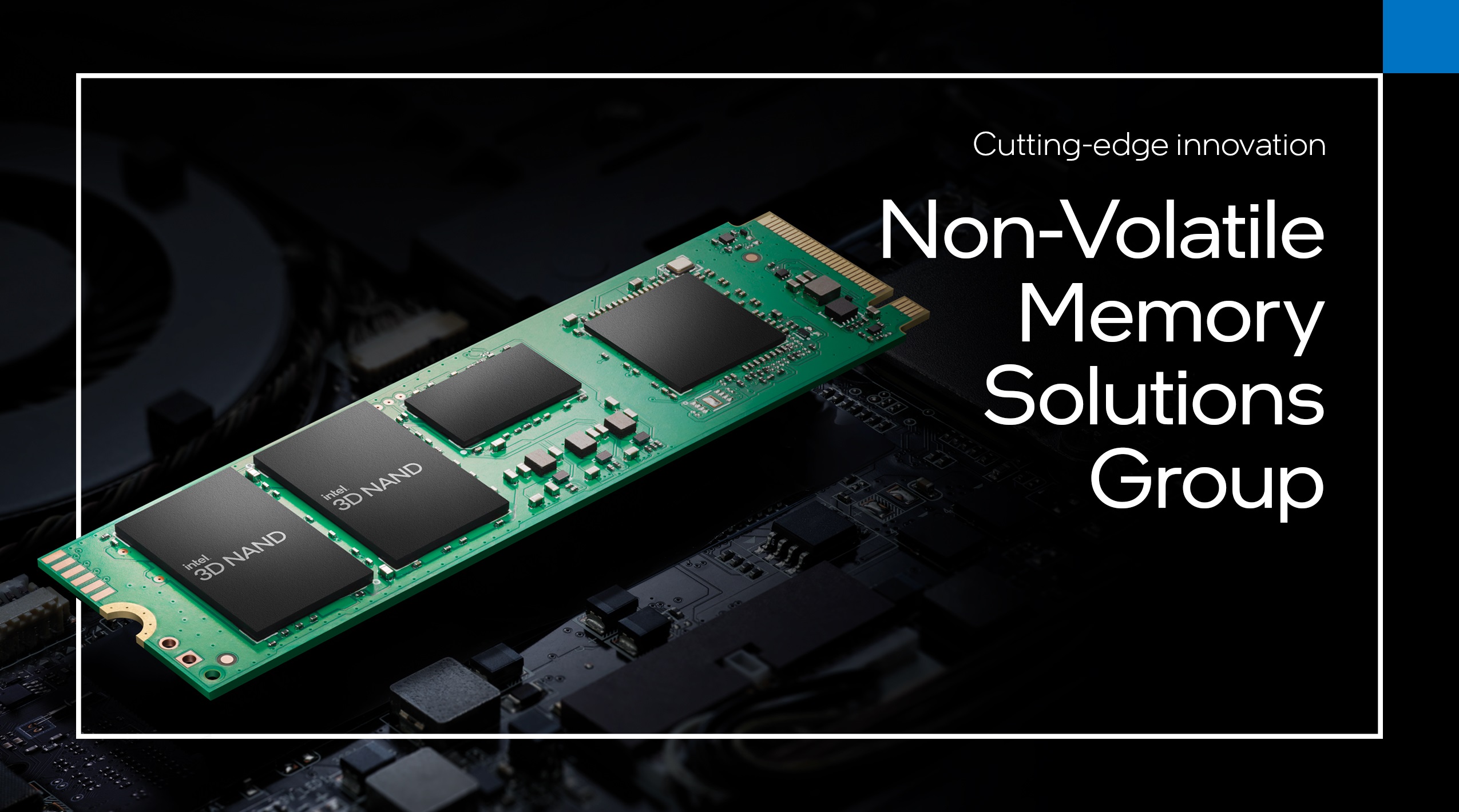
| | | | | | | | |
| Overview | |
NSG provides next-generation memory and storage products based on innovative Intel 3D NAND technology. NSG is disrupting the memory and storage hierarchy with new tiers that balance capacity, performance, and cost. Our products are available in innovative form factors and densities to address the memory and storage challenges our customers face in a rapidly evolving technological landscape. Our customers include enterprise and cloud-based data centers, and users of business and consumer desktops and laptops. |
| |
| Key Developments |
| | "Storage technologies help drive the computing experience. Put simply, in today’s data-driven world, advances in both data center and client computing need to be matched by cutting-edge innovation in the memory-and-storage space."
—Rob Crooke, NSG General Manager |
■ | Revenue was lower in 2021, driven by market softness and pricing pressure. NAND profitability improved due to the absence of depreciation expense from NAND property, plant and equipment that was held for sale throughout 2021. |
■ | We launched the Intel® SSD D5-P5316, our first 144-layer QLC NAND SSD for the Data Center, which is available up to 30.72TB in both the U.2 and efficient E1.L form factors. An upgrade of our SATA drive, the Intel® SSD D3-S4520 and D3-S4620, also launched with Intel’s latest-gen 144-layer TLC NAND and is available in 2.5” and M.2 form factors up to 7.68TB capacity. For our consumer market, the Intel® SSD 670p with 144-layer QLC NAND launched with improved performance, storage responsiveness, and endurance with high capacity (up to 2TB). |
■ | In October 2020, we signed an agreement with SK hynix to divest our NAND memory business. The NAND memory business makes up our NSG segment. The transaction will occur over two closings, the first of which was completed on December 29, 2021, subsequent to our fiscal 2021 year-end. We will fully deconsolidate our ongoing interests in the NAND OpCo Business in the first quarter of 2022. Refer to "Note 10 : Acquisitions and Divestitures" within Notes to Consolidated Financial Statements for further information on the divestiture. |
| | | | | | | | | | | | | | | | | |
| ■ Revenue $B | | ■ Op Income $B | |
Market and Business Overview
Market Trends and Strategy
The combination of ever-exploding growth in data and the desire to analyze data for actionable insights requires our customers to balance performance, real-time access, and cost. Our 3D NAND TLC and QLC technology innovations enable our customers to have access to efficient, cost-effective capacity storage.
In October of 2020, we signed an agreement with SK hynix to divest our NAND memory business, including our NAND memory fabrication facility in Dalian, China and certain related equipment and tangible assets (the Fab Assets), our NAND SSD Business (the NAND SSD Business), and our NAND memory technology and manufacturing business (the NAND OpCo Business). The first closing was completed on December 29, 2021, subsequent to our fiscal 2021 year-end. At first closing, we sold to SK hynix the Fab Assets and the NAND SSD Business. In connection with the first closing, we and certain affiliates of SK hynix also entered into a NAND wafer manufacturing and sale agreement, pursuant to which we will manufacture and sell to SK hynix NAND memory wafers to be manufactured using the Fab Assets in Dalian, China until the second closing.
Products and Competitiveness
We compete against other providers of NAND products. We offer 96-layer and 64-layer TLC NAND high-capacity SSDs, and 144-layer QLC NAND high-capacity SSDs. We focus our efforts primarily on incorporating NAND into solution products.
The acceleration in data growth across our customer base requires significant innovation in storage technology. Our storage roadmap led the way in re-imagining usages and architecting innovative solutions that have disrupted the industry with 96-layer and 144-layer 3D NAND TLC and QLC solutions. We launched four new products with multiple densities to keep up with the evolving business needs of our customers.
Financial Performance
| | | | | | | | | | | | | | |
| NSG Revenue $B | | NSG Operating Income $B | |
2021 vs. 2020
Revenue decreased $1.1 billion, driven by $712 million lower ASPs due to market softness and pricing pressure and $392 million due to the transfer of the Intel Optane memory business to DCG.
2020 vs. 2019
Revenue increased $996 million, driven by $716 million higher ASP from improved NAND pricing and $280 million from improved overall demand.
2021 vs. 2020
NSG had an operating profit of $1.4 billion, up from an operating profit of $361 million in 2020. The operating profit was driven by $1.4 billion of improvements in unit cost, primarily driven by the absence of depreciation expense from NAND property, plant and equipment that was held for sale, $366 million of lower period charges, and $220 million of lower operating expenses, partially offset by $929 million of lower revenue primarily on ASP decline. Operating income also benefited from the transfer of the Intel Optane memory business from 2021 NSG results (a loss of $576 million in 2020).
2020 vs. 2019
NSG had an operating profit of $361 million, up from an operating loss of $1.2 billion in 2019. The operating profit was driven by $716 million higher ASPs from market pricing recovery and $741 million due to continued improvements in unit cost.

| | | | | | | | | |
| Overview | |
| PSG offers programmable semiconductors, primarily FPGAs, structured ASICs, and related products, for a broad range of applications across our embedded, communications, and cloud and enterprise market segments. Our product portfolio delivers FPGA acceleration in tandem with Intel microprocessors, which enables us to combine the benefits of our broad portfolio of technologies to allow more flexibility for systems to operate with increased efficiency and higher performance.
|
| | |
| Key Developments |
| | |
| ■ | Revenue was up 4% year over year, driven by recovery in the embedded and communications market segments from COVID-19 lows. Revenue was limited by ongoing industry component, substrate, and foundry capacity shortages. | "Intel FPGAs and Structured ASICs, unleashed with software, platform and workload innovations, are accelerating a smart and connected world."
—Shannon Poulin, PSG General Manager |
| ■ | We are shipping our Intel® Agilex™ FPGA family, featuring industry-leading FPGA fabric performance, power efficiency, and transceiver performance. We released our Intel® eASIC™ N5X device family (Diamond Mesa) for low-latency 5G network acceleration, cloud acceleration, and storage, AI, and edge applications. |
| ■ | We announced Arrow Creek, an FPGA-based Acceleration Development Platform SmartNIC adapter for high-performance 100G networking acceleration, and RedHat support for our Intel Open FPGA Stack scalable, source-accessible FPGA hardware and software infrastructure. |
| ■ | We announced that Intel® FPGA-based IPU platforms are currently deployed at multiple cloud service providers. We also announced Oak Springs Canyon, an IPU platform built with the Intel® Xeon® D processor and the Intel Agilex FPGA. |
| | |
| | | | | | | | | | | | | | | | | | | | |
| ■ Revenue $B | | ■ Op Income $B | |
Market and Business Overview
Market Trends and Strategy
With the rise of pervasive connectivity and autonomous transactions, vast networks of devices and systems are linked from the edge through infrastructure to the cloud. Our FPGA and structured ASIC technologies enhance Intel's ability to meet the needs of customers in the data center, across the network, and at the edge by extending platform capabilities, intercepting evolving requirements when standards are still changing, and enabling customers to validate next-generation technology proof points early in the market transition. The Intel FPGA portfolio enables this transformation with discrete FPGAs and software-defined, hardware-based, multi-function acceleration cards and IPUs that allow faster development times, high performance, and power efficiency with lower overall total cost of ownership.
We enable a broad range of solutions targeting applications across our embedded, communications, and cloud and enterprise market segments. The configurability and efficiency of FPGAs provide advantages to enable transformative applications such as 5G wireless, network function virtualization acceleration, and edge acceleration for video analytics and Industry 4.0. At the edge, where systems ingest large amounts of data, Intel FPGAs are ideal for pre-processing data to accelerate Intel processors. In the network, where data traffic is increasing and network functions are being virtualized to improve transport efficiency, Intel FPGAs are built to deliver high-bandwidth aggregation and processing. In the cloud, where workloads shift dynamically and algorithms change, Intel FPGAs are the ideal solution for adapting to new demands through reconfigurability and enabling the offload of infrastructure processing tasks from CPUs as part of an IPU platform.
Products and Competition
We deliver solutions in the PLD market, primarily FPGAs and structured ASICs, to accelerate applications that help secure, power, and connect billions of devices and the infrastructure of the smart, connected, data-centric world. We face competition from other programmable logic companies, as well as companies that make other types of semiconductor products, such as ASICs, application-specific standard products, GPUs, digital signal processors, and CPUs. Targeted growth areas for our programmable solutions include 5G, AI, intelligent edge, and cloud applications. The FPGA life cycle generally takes three or more years from the time that a design win is secured before a customer starts volume production and we receive the associated revenue.
| | | | | |
| We continue to leverage our heterogeneous architecture on advanced nodes to deliver innovative products at an accelerated pace, allowing the integration of analog, memory, custom computing, custom I/O, and Intel eASIC chiplets into a single package. Our Intel Agilex FPGA family, built on Intel 10nm SuperFin technology, is now shipping. The Agilex family delivers leading performance and power efficiency for diverse workloads. | |
| We continue to invest in our Intel eASIC portfolio. Our Intel eASIC N5X, the next-generation Intel eASIC device, is now in production. Structured ASIC products serve as an intermediary technology between FPGAs and standard-cell ASICs that provides lower unit cost and lower power compared to FPGAs, and faster time-to-market and lower non-recurring engineering cost compared to standard-cell ASICs. Intel eASIC products have growth opportunities through adoption in 5G applications and scale across a wide range of markets. |
We continue to execute to our developer-first strategy with oneAPI support for several Intel FPGA families and the Intel® FPGA Programmable Acceleration Card. The oneAPI programming model allows users to save significant development time and enhance productivity while using a single, unified language for CPUs, GPUs, and FPGAs. |
| We introduced several new platforms, solutions, and partnerships during the year. We announced Arrow Creek, an FPGA-based Acceleration Development Platform SmartNIC adapter that can flexibly accelerate several infrastructure workloads and enable high-performance 100G connectivity by combining Intel’s Agilex FPGA and the Intel Ethernet 800 Series controller. We introduced RedHat support for Intel Open FPGA Stack, further enabling solution and board providers to build their own differentiated FPGA platforms for servers with Intel Xeon CPUs. We also announced with the US Defense Advanced Research Projects Agency a three-year partnership to advance the development of domestically manufactured structured ASIC platforms. |
| Intel FPGAs play a critical role in Intel’s announced IPU vision, enabling cloud and communications service providers to reduce overhead and free up performance for CPUs. Intel FPGA-based IPU platforms are currently deployed at multiple cloud service providers. We also announced Oak Springs Canyon, an IPU reference platform built with our Intel Xeon D processor and our Intel Agilex FPGA. |
Financial Performance
| | | | | | | | | | | | | | |
| PSG Revenue $B | | PSG Operating Income $B | |
2021 vs. 2020
Revenue increased $81 million, driven by recovery in the embedded and communications market segments from COVID-19 lows, partially offset by customer inventory digestion in the cloud market segment.
2020 vs. 2019
Revenue decreased $134 million, driven by a decline in our communications market segment due to customer transition to 5G ASICs that benefited DCG adjacencies, and decline in our embedded market segment. The decline was partially offset by strength in the cloud and enterprise market segment.
2021 vs. 2020
Operating income increased $37 million, driven by higher revenue due to recovery in the embedded and communications market segments from COVID-19 lows, partially offset by a decrease in the cloud market segment.
2020 vs. 2019
Operating income decreased $58 million, driven by lower revenue in our embedded and communications market segments, partially offset by strength in the cloud and enterprise market segment
| | | | | |
Consolidated Results of Operations | |
| |
For additional key highlights of our results of operations, see "A Year in Review."
| | | | | | | | | | | | | | | | | | | | | | | | | | | | | | | | | | | | | | |
Years Ended
(In Millions, Except Per Share Amounts) | | December 25, 2021 | | December 26, 2020 | | December 28, 2019 |
| Amount | | % of Net
Revenue | | Amount | | % of Net
Revenue | | Amount | | % of Net
Revenue |
| Net revenue | | $ | 79,024 | | | 100.0 | % | | $ | 77,867 | | | 100.0 | % | | $ | 71,965 | | | 100.0 | % |
| Cost of sales | | 35,209 | | | 44.6 | % | | 34,255 | | | 44.0 | % | | 29,825 | | | 41.4 | % |
| Gross margin | | 43,815 | | | 55.4 | % | | 43,612 | | | 56.0 | % | | 42,140 | | | 58.6 | % |
| Research and development | | 15,190 | | | 19.2 | % | | 13,556 | | | 17.4 | % | | 13,362 | | | 18.6 | % |
| Marketing, general and administrative | | 6,543 | | | 8.3 | % | | 6,180 | | | 7.9 | % | | 6,350 | | | 8.8 | % |
| Restructuring and other charges | | 2,626 | | | 3.3 | % | | 198 | | | 0.3 | % | | 393 | | | 0.5 | % |
| | | | | | | | | | | | |
| Operating income | | 19,456 | | | 24.6 | % | | 23,678 | | | 30.4 | % | | 22,035 | | | 30.6 | % |
| Gains (losses) on equity investments, net | | 2,729 | | | 3.5 | % | | 1,904 | | | 2.4 | % | | 1,539 | | | 2.1 | % |
| Interest and other, net | | (482) | | | (0.6) | % | | (504) | | | (0.6) | % | | 484 | | | 0.7 | % |
| Income before taxes | | 21,703 | | | 27.5 | % | | 25,078 | | | 32.2 | % | | 24,058 | | | 33.4 | % |
| Provision for taxes | | 1,835 | | | 2.3 | % | | 4,179 | | | 5.4 | % | | 3,010 | | | 4.2 | % |
| Net income | | $ | 19,868 | | | 25.1 | % | | $ | 20,899 | | | 26.8 | % | | $ | 21,048 | | | 29.2 | % |
| Earnings per share—diluted | | $ | 4.86 | | | | | $ | 4.94 | | | | | $ | 4.71 | | | |
Revenue
Our total revenue grew from $62.8 billion in 2017 to $79.0 billion in 2021, representing 6% CAGR.
2021 vs. 2020
In 2021, revenue was $79.0 billion, up $1.2 billion, or 1%, from 2020. CCG revenue grew 1% due to continued strength in notebook demand and recovery in desktop demand, partially offset by lower notebook ASPs due to strength in the consumer and education market segments. CCG adjacent revenue decreased primarily due to the continued ramp down from the exit of our 5G smartphone modem and Home Gateway Platform businesses. IOTG and Mobileye were both up 33% and 43%, respectively, on higher demand amid recovery from the economic impacts of COVID-19. DCG revenue decreased 1% primarily due to lower ASPs driven by product mix and a competitive environment, partially offset by higher platform volume from recovery in the enterprise and government market segment. NSG revenue decreased primarily driven by lower ASPs due to market softness and pricing pressure. Our "all other" revenue increased primarily due to $584 million from a prepaid customer supply agreement settled in Q1 2021 for which we recognized related revenue for completing performance.
We saw impacts from ongoing industry component, substrate, and foundry silicon shortages across a majority of our businesses and we expect these constraints to continue.
2020 vs. 2019
In 2020, revenue was $77.9 billion, up $5.9 billion, or 8%, from 2019. Our DCG revenue grew 11% due to increased platform volume as cloud service providers increased capacity to serve customer demand. We also saw continued growth in DCG communications service providers, partially offset by enterprise and government decline. We saw growth in DCG adjacencies driven by 5G networking deployment and saw improved NAND pricing and higher demand in NSG, partially offset by weaker core mix and higher demand in IOTG platform products due to COVID-19. Our CCG revenue was up 8% year over year driven by strength in notebook and Wi-Fi sales. That growth was slightly offset by lower desktop volume and lower notebook ASPs resulting from higher demand for consumer and education PCs, and volume decline in LTE modem and connected home following the exit of those businesses.
Gross Margin
We derived a substantial majority of our overall gross margin dollars from the sale of platform products in the CCG and DCG operating segments. Our overall gross margin dollars in 2021 increased by $203 million, or approximately flat compared to 2020, and in 2020 increased by $1.5 billion, or 3%, compared to 2019. Our gross margin percentage was down as the increase in platform revenue was offset by higher period charges and higher unit cost.
| | | |
| Gross Margin $B |
| (Percentages in chart indicate gross margin as a percentage of total revenue) |
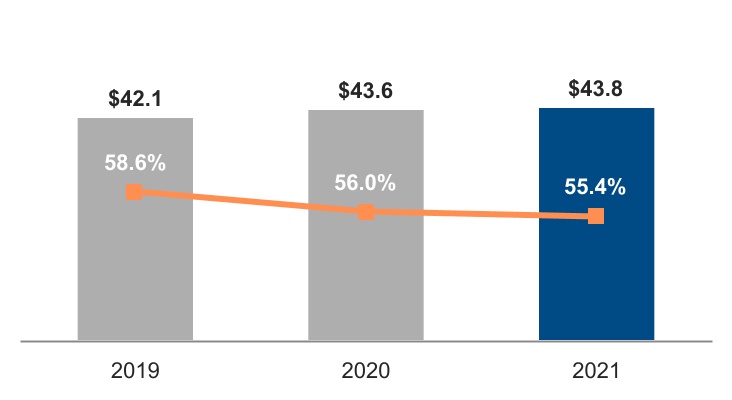
| | | | | | | | |
| (In Millions) | | |
| $ | 43,815 | | | 2021 Gross Margin |
| 1,010 | | | Higher gross margin from platform revenue |
| 680 | | | Higher gross margin from adjacent businesses primarily due to the absence of depreciation expense from NAND property, plant and equipment that was held for sale, increased Mobileye volume and higher margins on wireless and connectivity |
| 585 | | | Prepaid customer supply agreement settled and recognized to revenue in Q1 2021 |
| 75 | | | Lower period charges driven by a decrease in engineering samples and lower reserves taken on non-qualified platform products compared to 2020, partially offset by 2020 sell-through of other reserves and other reserves taken in 2021 |
| (1,325) | | | Higher period charges primarily associated with the ramp up of Intel 4 |
| (515) | | | Higher period charges primarily associated with the ramp down of 14nm |
| (235) | | | Higher platform unit cost primarily from increased mix of 10nm SuperFin products |
| (72) | | | Other |
| $ | 43,612 | | | 2020 Gross Margin |
| 2,360 | | | Higher gross margin from platform revenue |
| 1,855 | | | Higher gross margin from adjacent businesses primarily due to higher margins on NAND, modem, and WIFI, partially offset by lower margins on DCG adjacencies |
| 630 | | | Lower factory start-up costs associated with our 10nm process technology |
| 155 | | | Lower period charges |
| (3,285) | | | Higher platform unit cost primarily from increased mix of 10nm products |
| (255) | | | Primarily driven by higher logistic expenses due to COVID-19 |
| 12 | | | Other |
| | |
| | |
| | |
| $ | 42,140 | | | 2019 Gross Margin |
Operating Expenses
Total R&D and MG&A expenses for 2021 were $21.7 billion, up 10% compared to 2020. These expenses represented 27.5% of revenue for 2021 and 25.3% of revenue for 2020. We continue to invest in R&D to accelerate our growth.
| | | | | | | | |
| Research and Development $B | | Marketing, General and Administrative $B |
| (Percentages indicate expenses as a percentage of total revenue) |
| | | | | | | |
| 2021 vs. 2020 | | |
| | | |
| R&D spending increased by $1.6 billion, or 12.1%, driven by the following: | | |
| | | |
| + | Investments in DCG, CCG, and Mobileye | | |
| + | Investments in our process technology | | |
| + | Incentive-based cash compensation | | |
| | | |
| | | |
| | | |
| 2020 vs. 2019 | | |
| | | |
| R&D spending increased by $194 million, or 1%, driven by the following: | | |
| | | |
| + | Investments in our process technology | | |
| + | Investments in CCG and DCG | | |
| - | Ramp down of 5G smartphone modem business | | |
| - | Incentive-based cash compensation | | |
| | | |
| | |
| Marketing, General and Administrative |
| | | | | | | |
| 2021 vs. 2020 | | |
| | | |
| MG&A spending increased by $363 million, or 5.9%, driven by the following: | | |
| | | |
| + | Increase in corporate spending | | |
| + | Incentive-based cash compensation | | |
| | | |
| | | |
| | | |
| 2020 vs. 2019 | | |
| | | |
| MG&A spending decreased by $170 million, or 3%, driven by the following: | | |
| | | |
| - | Corporate spending efficiencies | | |
| | | |
| - | Incentive-based cash compensation | | |
| | | |
| | | |
| | | |
Restructuring and Other Charges
| | | | | | | | | | | | | | | | |
| Years Ended (In Millions) | | Dec 25, 2021 | | Dec 26, 2020 | | |
| Employee severance and benefit arrangements | | $ | 48 | | | $ | 124 | | | |
| Litigation charges and other | | 2,291 | | | 67 | | | |
| Asset impairment charges | | 287 | | | 7 | | | |
| Total restructuring and other charges | | $ | 2,626 | | | $ | 198 | | | |
Litigation charges and other includes a charge of $2.2 billion in the first quarter of 2021 related to the VLSI Technology LLC (VLSI) litigation, which is recorded as a corporate charge in the "all other" category presented in "Note 3: Operating Segments" within Notes to Consolidated Financial Statements. Refer to "Note 19: Commitments and Contingencies" within Notes to Consolidated Financial Statements for further information on legal proceedings related to the VLSI litigation.
Asset impairment charges includes impairments related to the shutdown in the second quarter of 2021 of two of our non-strategic businesses, the results of which are included in the "all other" category presented in "Note 3: Operating Segments" within Notes to Consolidated Financial Statements. The goodwill related to these businesses was impaired, resulting in a charge of $238 million recognized in the second quarter of 2021 in the "all other" category along with other impairment charges related to these businesses.
Gains (Losses) on Equity Investments and Interest and Other, Net
| | | | | | | | | | | | | | | | | | | | |
| Years Ended (In Millions) | | Dec 25, 2021 | | Dec 26, 2020 | | Dec 28, 2019 |
| Ongoing mark-to-market adjustments on marketable equity securities | | $ | (130) | | | $ | (133) | | | $ | 277 | |
| Observable price adjustments on non-marketable equity securities | | 750 | | | 176 | | | 293 | |
| Impairment charges | | (154) | | | (303) | | | (122) | |
Sale of equity investments and other | | 2,263 | | | 2,164 | | | 1,091 | |
| Gains (losses) on equity investments, net | | $ | 2,729 | | | $ | 1,904 | | | $ | 1,539 | |
| | | | | | |
| Interest and other, net | | $ | (482) | | | $ | (504) | | | $ | 484 | |
Gains (Losses) on Equity Investments, Net
Ongoing mark-to-market net gains and losses reported during 2021 were primarily driven by Montage Technology, Co. Ltd. (Montage); 2020 and 2019 net gains and losses were primarily driven by Montage and Cloudera. We sold our interest in Cloudera in 2020.
In the first quarter of 2021, we recognized $471 million in observable price adjustments in our investment in Beijing Unisoc Technology Ltd.
In sale of equity investments and other, we recognized $447 million of initial fair value adjustments related to four companies that went public in 2021; in 2020 we recognized $1.1 billion from Montage becoming marketable and $606 million related to four other equity investments that went public. During 2021, we recognized McAfee Corp. (McAfee) dividends of $1.3 billion, which included a special dividend of $1.1 billion paid in connection with the sale of McAfee's Enterprise Business to Symphony Technology Group, and recognized $228 million related to the partial sale of our investment in McAfee. We recognized McAfee dividends of $126 million in 2020 and $632 million in 2019. In November 2021, McAfee announced an agreement to be acquired by an investor group, which is subject to closing conditions.
Interest and Other, Net
The net loss in interest and other, net in 2021 was relatively flat compared to 2020.
We recognized a net loss in interest and other, net in 2020 compared to a net gain in 2019, primarily due to lower divestiture gains in 2020 compared to 2019.
Provision for Taxes
| | | | | | | | | | | | | | | | | | | | |
| Years Ended (Dollars in Millions) | | Dec 25, 2021 | | Dec 26, 2020 | | Dec 28, 2019 |
| Income before taxes | | $ | 21,703 | | | $ | 25,078 | | | $ | 24,058 | |
| Provision for taxes | | $ | 1,835 | | | $ | 4,179 | | | $ | 3,010 | |
| Effective tax rate | | 8.5 | % | | 16.7 | % | | 12.5 | % |
Our effective tax rate decreased in 2021 compared to 2020, primarily driven by one-time tax benefits due to the restructuring of certain non-US subsidiaries as well as a higher proportion of our income in non-US jurisdictions. As a result of the restructuring, we established deferred tax assets and released the valuation allowances of certain foreign deferred tax assets. The majority of these deferred tax assets established in 2021 fully offset the deferred tax liabilities recognized in 2020 driven by a change in our permanent reinvestment assertion with respect to undistributed earnings in China, as a result of our planned divestiture of our NAND memory business.
Our effective tax rate increased in 2020 compared to 2019, primarily driven by a change in our permanent reinvestment assertion with respect to undistributed earnings in China, as a result of our planned divestiture of our NAND memory business. It also increased due to the reduction in our foreign derived intangible income benefit in 2020.
Liquidity and Capital Resources
We believe we have sufficient sources of funding to meet our business requirements for the next 12 months and in the longer term. Cash generated by operations, supplemented by our total cash and investments1, is our primary source of liquidity for funding our strategic business requirements. Our short-term requirements include capital expenditures for worldwide manufacturing and assembly and test, including investments in our process technology roadmap; working capital requirements; and potential acquisitions, strategic investments, and dividends. Our long-term requirements incrementally contemplate additional investments in the significant manufacturing expansion plans we announced as part of our IDM 2.0 strategy and additional investments to accelerate our process technology. These plans include investment to build two new fabs in Arizona as well as plans for a next phase of capacity expansions in Ohio, Europe, and other global locations. Our plans include utilizing a "smart capital" strategy in which we focus first on aggressively building out fab shells, which are the smaller portion of the overall cost of a fab but have the longest lead time, giving us flexibility in how and when we bring additional capacity and tools online. Additionally, as we have faced industry shortages of substrates and other components, we have increasingly entered into long-term agreements with suppliers and foundry service providers, some of which involve prepayments that will help us secure future supply.
As we invest in these expansions and in the acceleration of our process technology roadmap, we expect our capital expenditures to increase above historical levels for the next several years. The prepayments for future supply of substrates and other components accelerate cash outflows into the near term, and we expect to apply the prepayments to future purchases, resulting in a positive impact on our liquidity in subsequent periods.
We expect our capital expenditures to increase above historical levels for the next several years. As of December 25, 2021 we had commitments for capital expenditures of $22.3 billion for 2022, and we expect our total capital expenditures for 2022 to be above that amount. We also had $4.6 billion in capital expenditures committed in the long term. As of December 25, 2021, other purchase obligations and commitments in 2022 under our binding commitments for purchases of goods and services were $3.1 billion with an additional $9.3 billion committed in the long term.
We have additional obligations as part of our ordinary course of business, beyond those committed for capital expenditures and other purchase obligations and commitments for purchases of goods and services. For example, see "Note 19: Commitments and Contingencies" within Consolidated Financial Statements for information about our lease obligations, which include supply agreements structured as leases, "Note 8: Income Taxes" within Consolidated Financial Statements for information about our tax obligations related to Tax Reform enacted in 2017 for the one-time transition tax on previously untaxed foreign earnings, and "Note 13: Borrowings" within Consolidated Financial Statements for information about our long-term debt obligations. The expected timing of payments of our obligations is estimated based on current information. Timing of payments and actual amounts paid may be different, depending on the timing of receipt of goods or services, or changes to agreed-upon amounts for some obligations. In addition, some of our purchasing requirements are not current obligations and are therefore not included in the amounts above. For example, some of these requirements are not handled through binding contracts or are fulfilled by vendors on a purchase order basis within short time horizons.
We anticipate that we will continue to primarily rely on operating cash flows, supplemented by our total cash and investments1, to fund IDM 2.0 and other cash requirements in the ordinary course of business. We also expect to benefit from government incentives under pending legislation, and any incentives above our current expectations would enable us to increase the pace and size of our IDM 2.0 investments. Conversely, incentives below our expectations would increase our anticipated cash requirements. We expect our increased capital investments to pressure our free cash flow in the short term. When assessing our current sources of liquidity, we include our total cash and investments1 as shown in the following table:
| | | | | | | | | | | | | | |
| (In Millions) | | Dec 25, 2021 | | Dec 26, 2020 |
| Cash and cash equivalents | | $ | 4,827 | | | $ | 5,865 | |
| Short-term investments | | 2,103 | | | 2,292 | |
| Trading assets | | 21,483 | | | 15,738 | |
| Other long-term investments | | 840 | | | 2,192 | |
| Loans receivable and other | | 240 | | | 947 | |
Total cash and investments1 | | $ | 29,493 | | | $ | 27,034 | |
| Total debt | | $ | 38,101 | | | $ | 36,401 | |
| | | | |
| | | | |
1 See "Non-GAAP Financial Measures" within MD&A.
Other potential sources of liquidity include our commercial paper program and our automatic shelf registration statement on file with the SEC, pursuant to which we may offer an unspecified amount of debt, equity, and other securities. Under our commercial paper program, we have an ongoing authorization from our Board of Directors to borrow up to $10.0 billion. During 2021, we issued a total of $5.0 billion aggregate principal amount of senior notes, and entered into a $5.0 billion variable-rate revolving credit facility that matures in March 2026. We repaid $500 million of our 1.70% senior notes that matured in May 2021 and $2.0 billion of our 3.30% senior notes that matured in October 2021. As of December 25, 2021, we had no outstanding commercial paper or borrowing on the revolving credit facility.
We maintain a diverse investment portfolio that we continually analyze based on issuer, industry, and country. Substantially all of our investments in debt instruments are in investment-grade securities.
In the first quarter of 2021, we repurchased the remaining $2.4 billion in shares of our planned $20.0 billion share repurchases announced in October 2019. We expect our future stock repurchases to be significantly below our levels from the last few years.
| | | |
Sources and Uses of Cash (In Millions) | |
In summary, our cash flows for each period were as follows:
| | | | | | | | | | | | | | | | | | | | |
| Years Ended (In Millions) | | Dec 25, 2021 | | Dec 26, 2020 | | Dec 28, 2019 |
| Net cash provided by operating activities | | $ | 29,991 | | | $ | 35,384 | | | $ | 33,145 | |
| Net cash used for investing activities | | (25,167) | | | (20,796) | | | (14,405) | |
| Net cash provided by (used for) financing activities | | (5,862) | | | (12,917) | | | (17,565) | |
| | | | | | |
| Net increase (decrease) in cash and cash equivalents | | $ | (1,038) | | | $ | 1,671 | | | $ | 1,175 | |
Operating Activities
Cash provided by operating activities is net income adjusted for certain non-cash items and changes in assets and liabilities.
For 2021 compared to 2020, the $5.4 billion decrease in cash provided by operating activities was primarily driven by a decrease in net working capital contributions and cash paid to settle a prepaid customer supply agreement in Q1 2021, partially offset by a McAfee special dividend received in Q3 2021.
For 2020 compared to 2019, the $2.2 billion increase in cash provided by operating activities was primarily due to changes in working capital. Changes in working capital were driven by accounts receivable, inventory, and income taxes, offset by other assets and liabilities.
Investing Activities
Investing cash flows consist primarily of capital expenditures, investment purchases, sales, maturities, and disposals, and proceeds from divestitures and cash used for acquisitions. Our capital expenditures were $18.7 billion in 2021 ($14.3 billion in 2020 and $16.2 billion in 2019).
The increase in cash used for investing activities in 2021 compared to 2020 was primarily due to an increase in capital expenditures, partially offset by a decrease in purchases of available-for-sale debt investments.
The increase in cash used for investing activities in 2020 compared to 2019 was primarily due to an increase in purchases of available-for-sale debt investments and trading assets, offset by an increase in maturities and sales of available-for-sale debt investments and trading assets, and a decrease in capital expenditures and cash paid for acquisitions.
Financing Activities
Financing cash flows consist primarily of payment of dividends to stockholders, issuance and repayment of short-term and long-term debt, repurchases of common stock, and proceeds from the sale of shares of common stock through employee equity incentive plans.
The decrease in cash used for financing activities in 2021 compared to 2020 was primarily due to a decrease in repurchases of common stock and a decrease in repayments of debt and debt conversions, partially offset by a decrease in cash provided by long-term debt issuances.
During 2021, we repurchased $2.4 billion of common stock under our authorized common stock repurchase program, compared to $14.2 billion in 2020. Our total dividend payments were $5.6 billion in 2021 compared to $5.6 billion in 2020. We have paid a cash dividend in each of the past 117 quarters.
The decrease in cash used for financing activities in 2020 compared to 2019 was primarily due to an increase in cash provided by long-term debt issuances, offset by an increase in repayments of debt and debt conversions and an increase in repurchases of common stock.
Critical Accounting Estimates
The methods, assumptions, and estimates that we use in applying our accounting policies may require us to apply judgments regarding matters that are inherently uncertain. We consider an accounting policy to be a critical estimate if: (1) we must make assumptions that were uncertain when the judgment was made, and (2) changes in the estimate assumptions, or selection of a different estimate methodology, could have a significant impact on our financial position and the results that we report in our Consolidated Financial Statements. While we believe that our estimates, assumptions, and judgments are reasonable, they are based on information available when the estimate was made.
Refer to "Note 2: Accounting Policies" within the Consolidated Financial Statements for further information on our critical accounting estimates and policies, which are as follows:
▪Inventories—the transition of manufacturing costs to inventory, excluding factory excess capacity costs. Inventory reflected at the lower of cost or net realizable value considering future demand and market conditions;
▪Long-lived assets—the valuation methods and assumptions used in assessing the impairment of property, plant and equipment, identified intangibles, and goodwill, including the determination of asset groupings and the identification and allocation of goodwill to reporting units;
▪Non-marketable equity investments—the valuation estimates and assessment of impairment and observable price adjustments; and
▪Loss contingencies—the estimation of when a loss is probable and reasonably estimable.
Non-GAAP Financial Measures
In addition to disclosing financial results in accordance with US GAAP, this document contains references to the non-GAAP financial measures below. We believe these non-GAAP financial measures provide investors with useful supplemental information about our operating performance, enable comparison of financial trends and results between periods where certain items may vary independent of business performance, and allow for greater transparency with respect to key metrics used by management in operating our business and measuring our performance. Certain of these non-GAAP financial measures are used in our performance-based RSUs and our annual cash bonus plan.
Long-term gross margin outlook range is provided on a non-GAAP basis and excludes the impact of amortization of acquisition-related intangible assets and share-based compensation expense. We are unable to provide a full reconciliation of this measure to the corresponding GAAP measure without unreasonable efforts, as the amount and timing of such adjustments on a long-term basis are subject to considerable uncertainty. We believe such a reconciliation would also imply a degree of precision that is inappropriate for this forward-looking measure.
Our non-GAAP financial measures reflect adjustments based on one or more of the following items, as well as the related income tax effects where applicable. Income tax effects have been calculated using an appropriate tax rate for each adjustment. These non-GAAP financial measures should not be considered a substitute for, or superior to, financial measures calculated in accordance with US GAAP, and the financial results calculated in accordance with US GAAP and reconciliations from these results should be carefully evaluated.
| | | | | | | | |
| Non-GAAP adjustment or measure | Definition | Usefulness to management and investors |
| NAND memory business | Our NAND memory business is subject to a pending sale to SK hynix, as announced in October 2020. While the second closing of the sale is still pending, we completed the first closing on December 29, 2021, subsequent to our fiscal 2021 year-end. We will fully deconsolidate our ongoing interests in the NAND OpCo Business in the first quarter of 2022. | We exclude the impact of our NAND memory business in certain non-GAAP measures. While the second closing of the sale is still pending and subject to closing conditions, management does not currently view the business as part of the company’s core operations or its long-term strategic direction. We believe these adjustments provide investors with a useful view, through the eyes of management, of the company’s core business model and how management currently evaluates core operational performance. We believe they also provide investors with an additional means to understand the potential impact of the divestiture over time. In making these adjustments, we have not made any changes to our methods for measuring and calculating revenue or other financial statement amounts. |
| Acquisition-related adjustments | Amortization of acquisition-related intangible assets consists of amortization of intangible assets such as developed technology, brands, and customer relationships acquired in connection with business combinations. Charges related to the amortization of these intangibles are recorded within both cost of sales and MG&A in our US GAAP financial statements. Amortization charges are recorded over the estimated useful life of the related acquired intangible asset, and thus are generally recorded over multiple years. | We exclude amortization charges for our acquisition-related intangible assets for purposes of calculating certain non-GAAP measures because these charges are inconsistent in size and are significantly impacted by the timing and valuation of our acquisitions. These adjustments facilitate a useful evaluation of our current operating performance and comparison to our past operating performance and provide investors with additional means to evaluate cost and expense trends. |
| | | | | | | | |
| Non-GAAP adjustment or measure | Definition | Usefulness to management and investors |
| Restructuring and other charges | Restructuring charges are costs associated with a formal restructuring plan and are primarily related to employee severance and benefit arrangements. Other charges include a charge related to the VLSI litigation, goodwill and asset impairments, pension charges, and costs associated with restructuring activity. | We exclude restructuring and other charges, including any adjustments to charges recorded in prior periods, for purposes of calculating certain non-GAAP measures because these costs do not reflect our core operating performance. These adjustments facilitate a useful evaluation of our core operating performance and comparisons to past operating results and provide investors with additional means to evaluate expense trends. |
| | |
| (Gains) losses from divestiture | Gains or losses are recognized in connection with a divestiture. | We exclude gains or losses resulting from divestitures for purposes of calculating certain non-GAAP measures because they do not reflect our current operating performance. These adjustments facilitate a useful evaluation of our current operating performance and comparisons to past operating results. |
| Ongoing mark-to-market on marketable equity securities | After the initial mark-to-market adjustment is recorded upon a security becoming marketable, gains and losses are recognized from ongoing mark-to-market adjustments of our marketable equity securities. | We exclude these ongoing gains and losses for purposes of calculating certain non-GAAP measures because we do not believe this volatility correlates to our core operational performance. These adjustments facilitate a useful evaluation of our current operating performance and comparisons to past operating results. |
| | |
| Free cash flow | We reference a non-GAAP financial measure of free cash flow, which is used by management when assessing our sources of liquidity, capital resources, and quality of earnings. Free cash flow is operating cash flow adjusted to exclude additions to property, plant and equipment. | This non-GAAP financial measure is helpful in understanding our capital requirements and provides an additional means to evaluate the cash flow trends of our business. We exclude additions to held for sale NAND property, plant and equipment because the additions are not representative of our long-term capital requirements and these assets were sold upon the first closing of the transaction that occurred on December 29, 2021, subsequent to our fiscal 2021 year-end. |
| Total cash and investments | Total cash and investments is used by management when assessing our sources of liquidity, which includes cash and cash equivalents, short-term investments, trading assets, other long-term investments, and loans receivable and other. | This non-GAAP measure is helpful in understanding our capital resources and liquidity position. |
Following are the reconciliations of our most comparable US GAAP measures to our non-GAAP measures presented:
| | | | | | | | | | | | | | | | | | |
| Years Ended (In Millions, Except Per Share Amounts) | | Dec 25, 2021 | | Dec 26, 2020 | | Dec 28, 2019 |
| Net revenue | | $ | 79,024 | | | $ | 77,867 | | | $ | 71,965 | |
| NAND memory business | | (4,306) | | | (4,967) | | | (4,059) | |
| Non-GAAP net revenue | | $ | 74,718 | | | $ | 72,900 | | | $ | 67,906 | |
| | | | | | |
| | | | | | |
| | | | | | |
| | | | | | |
| | | | | | |
| Operating income | | $ | 19,456 | | | $ | 23,678 | | | $ | 22,035 | |
| Acquisition-related adjustments | | 1,492 | | | 1,416 | | | 1,324 | |
| | | | | | |
| | | | | | |
| | | | | | |
| | | | | | |
| Restructuring and other charges | | 2,626 | | | 198 | | | 393 | |
| | | | | | |
| NAND memory business | | (1,369) | | | (937) | | | 600 | |
| Non-GAAP operating income | | $ | 22,205 | | | $ | 24,355 | | | $ | 24,352 | |
| | | | | | |
| Operating margin | | 24.6 | % | | 30.4 | % | | 30.6 | % |
| Acquisition-related adjustments | | 1.9 | % | | 1.8 | % | | 1.8 | % |
| | | | | | |
| | | | | | |
| | | | | | |
| | | | | | |
| Restructuring and other charges | | 3.3 | % | | 0.3 | % | | 0.5 | % |
| | | | | | |
| NAND memory business | | (0.1) | % | | 0.9 | % | | 2.9 | % |
| Non-GAAP operating margin | | 29.7 | % | | 33.4 | % | | 35.9 | % |
| | | | | | |
| | | | | | |
| | | | | | |
| | | | | | |
| | | | | | |
| | | | | | |
| | | | | | |
| | | | | | |
| | | | | | |
| | | | | | |
| | | | | | |
| | | | | | |
| | | | | | |
| | | | | | |
| | | | | | |
| | | | | | |
| | | | | | |
| Earnings per share—diluted | | $ | 4.86 | | | $ | 4.94 | | | $ | 4.71 | |
| Acquisition-related adjustments | | 0.36 | | | 0.33 | | | 0.29 | |
| | | | | | |
| | | | | | |
| | | | | | |
| | | | | | |
| Restructuring and other charges | | 0.65 | | | 0.05 | | | 0.09 | |
| | | | | | |
| (Gains) losses from divestiture | | — | | | — | | | (0.16) | |
| Ongoing mark-to-market on marketable equity securities | | 0.03 | | | 0.03 | | | (0.06) | |
| | | | | | |
| NAND memory business | | (0.33) | | | (0.22) | | | 0.13 | |
| Income tax effects | | (0.10) | | | (0.03) | | | (0.03) | |
| Non-GAAP earnings per share—diluted | | $ | 5.47 | | | $ | 5.10 | | | $ | 4.97 | |
| | | | | | | | | | | | | | | | | | | | | | | | | | | | | | | | |
| Years Ended (In Millions) | | Dec 25, 2021 | | Dec 26, 2020 | | Dec 28, 2019 | | Dec 29, 2018 | | Dec 30, 2017 |
| Net cash provided by operating activities | | $ | 29,991 | | | $ | 35,384 | | | $ | 33,145 | | | $ | 29,432 | | | $ | 22,110 | |
| Additions to property, plant and equipment | | (18,733) | | | (14,259) | | | (16,213) | | | (15,181) | | | (11,778) | |
| Free cash flow | | $ | 11,258 | | | $ | 21,125 | | | $ | 16,932 | | | $ | 14,251 | | | $ | 10,332 | |
| | | | | | | | | | |
| Net cash used for investing activities | | $ | (25,167) | | | $ | (20,796) | | | $ | (14,405) | | | $ | (11,239) | | | $ | (15,762) | |
| Net cash provided by (used for) financing activities | | $ | (5,862) | | | $ | (12,917) | | | $ | (17,565) | | | $ | (18,607) | | | $ | (8,475) | |
Sales and Marketing
Customers
We sell our products primarily to OEMs, ODMs, and cloud service providers. ODMs provide design and manufacturing services to branded and unbranded private-label resellers. In addition, our customers include other manufacturers and service providers, such as industrial and communication equipment manufacturers and other cloud service providers, who buy our products through distributor, reseller, retail, and OEM channels throughout the world. For more information about our customers, including customers who accounted for greater than 10% of our net consolidated revenue, see "Note 3: Operating Segments" within the Consolidated Financial Statements.
Our worldwide reseller sales channel consists of thousands of indirect customers; systems builders that purchase Intel processors and other products from our distributors. We have incentive programs that allow distributors to sell our microprocessors and other products in small quantities to systems integrators. Our microprocessors and other products are also available in direct retail outlets.
Sales Arrangements
Our products are sold through distribution channels throughout the world. Sales of our products are frequently made via purchase order acknowledgments that contain standard terms and conditions covering matters such as pricing, payment terms, and warranties, as well as indemnities for issues specific to our products, such as patent and copyright indemnities. Because our customers generally order from us on a purchase order basis, they can typically cancel, change, or delay product purchase commitments with little or no notice to us and without penalty. From time to time, we may enter into additional agreements with customers covering, for example, changes from our standard terms and conditions, new product development and marketing, and private-label branding. Our sales are routinely made using electronic and web-based processes that allow the customer to review inventory availability and track the progress of specific goods ordered. Pricing on particular products may vary based on volumes ordered and other factors. We also offer discounts, rebates, and other incentives to customers to increase acceptance of our products and technology.
In accordance with contract terms, revenue for product sales is recognized at the time of product shipment from our facilities or delivery to the customer location, as determined by the agreed upon shipping terms. Our standard terms and conditions of sale typically provide that payment is due at a later date, usually 30 days after shipment or delivery. We assess credit risk through quantitative and qualitative analysis. From this analysis, we establish shipping and credit limits, and determine whether we will seek to use one or more credit support protection devices, such as obtaining a parent guarantee, standby letter of credit, or credit insurance. Credit losses may still be incurred due to bankruptcy, fraud, or other failure of the customer to pay.
Our sales to distributors are typically made under agreements allowing for price protection on unsold merchandise and a right of return on stipulated quantities of unsold merchandise. Under the price protection program, we give distributors credits for the difference between the original price paid and the current price that we offer. Our products typically have no contractual limit on the amount of price protection, nor is there a limit on the time horizon under which price protection is granted. The right of return granted generally consists of a stock rotation program in which distributors can exchange certain products based on the number of qualified purchases made by the distributor.
Distribution
Distributors typically handle a wide variety of products, including those that compete with our products, and fill orders for many customers. Customers may place orders directly with us or through distributors. We have several distribution warehouses that are located in proximity to key customers.
Seasonal Trends
Historically, our net revenue has typically been higher in the second half of the year than in the first half of the year, accelerating in the third quarter and peaking in the fourth quarter. In 2021, continued strong COVID-driven notebook demand in the first half of the year contributed to a flatter trend than we historically observe.
Marketing
Our global marketing objectives are to build a strong, well-known, differentiated, and meaningful Intel corporate brand that drives preference with businesses and consumers, and to offer a limited number of meaningful and valuable brands in our portfolio to aid businesses and consumers in making informed choices about technology purchases. The Intel Core processor family and the Intel Atom, Celeron®, Pentium®, and Intel Xeon trademarks make up our key CPU brands. This year, we introduced the Intel Arc brand for our upcoming high-performance graphics products.
We promote brand awareness and preference, and generate demand through our own direct marketing, as well as through co-marketing programs. Our direct marketing activities primarily include advertising through digital and social media and television, as well as consumer and trade events, industry and consumer communications, and press relations. We market to consumer and business audiences and focus on building awareness and generating demand for our products. Our key messaging focuses on increased performance, improved energy efficiency, and other capabilities such as connectivity.
Certain customers participate in cooperative advertising and marketing programs. These cooperative advertising and marketing programs broaden the reach of our brands beyond the scope of our own direct marketing. Certain customers are licensed to place Intel® logos on computing devices containing our microprocessors and processor technologies, and to use our brands in their marketing activities. The program partially reimburses customers for marketing activities for products featuring Intel brands, subject to customers meeting defined criteria. These marketing activities primarily include advertising through digital and social media and television, as well as press relations. We have also entered into joint marketing arrangements with certain customers.
Quantitative and Qualitative Disclosures About Market Risk
We are affected by changes in currency exchange and interest rates, as well as equity and commodity prices. Our risk management programs are designed to reduce, but may not eliminate, the impacts of these risks. All of the following potential changes are based on sensitivity analyses performed on our financial positions as of December 25, 2021 and December 26, 2020. Actual results may differ materially.
Currency Exchange Rates
We are exposed to currency exchange risks of non-US-dollar-denominated investments in debt and equity instruments and loans receivable, and may economically hedge this risk with foreign currency contracts, such as currency forward contracts or currency interest rate swaps. Gains or losses on these non-US-currency investments are generally offset by corresponding losses or gains on the related hedging instruments. We are exposed to currency exchange risks from our non-US-dollar-denominated debt indebtedness and may use foreign currency contracts designated as cash flow hedges to manage this risk.
Substantially all of our revenue is transacted in US dollars. However, a significant portion of our operating expenditures and capital purchases are incurred in other currencies, primarily the European Union euro, the Israeli shekel, the Malaysian ringgit, the Japanese yen, and the Chinese yuan. We have established currency risk management programs to protect against currency exchange rate risks associated with non-US dollar forecasted future cash flows and existing non-US dollar monetary assets and liabilities. We may also hedge currency risk arising from funding of foreign currency-denominated future investments. We may utilize foreign currency contracts, such as currency forwards or option contracts in these hedging programs. We considered the historical trends in currency exchange rates and determined that it was reasonably possible that a weighted average adverse change of 10% in currency exchange rates could be experienced in the near term. Such an adverse change, after taking into account balance sheet hedges only and offsetting recorded monetary asset and liability positions outstanding as of December 25, 2021 and December 26, 2020, would result in an adverse impact on income before taxes of less than $38 million and less than $61 million, respectively.
Interest Rates
We are exposed to interest rate risk related to our fixed-rate investment portfolio and outstanding debt. The primary objective of our investment policy is to preserve principal and provide financial flexibility to fund our business while maximizing yields, which generally track the US dollar three-month LIBOR. We generally enter into interest rate contracts to convert the returns on our fixed-rate debt investment with remaining maturities longer than six months into US dollar three-month LIBOR-based returns. We also enter into swaps to convert fixed-rate coupon payments into floating-rate coupon payments for our existing indebtedness. Gains or losses on these instruments are generally offset by corresponding losses or gains on the related hedging instruments.
A hypothetical increase in benchmark interest rates of 1%, after taking into account investment hedges, would have resulted in a decrease in the fair value of our investment portfolio of approximately $68 million as of December 25, 2021 (a hypothetical decrease of 1% would have resulted in an increase in the fair value of our investment portfolio of approximately $75 million as of December 26, 2020).
Taking into account floating-rate debt and fixed-rate debt that is swapped to floating-rate debt, a hypothetical increase in interest rates of 1% would result in an increase in annual interest expense of approximately $132 million from debt outstanding as of December 25, 2021 (a hypothetical increase of 1% would have resulted in an increase in annual interest expense of approximately $132 million from debt outstanding as of December 26, 2020).
Equity Prices
We are exposed to equity market risk through our investments in marketable equity securities, which we typically do not attempt to reduce or eliminate through hedging activities.
As of December 25, 2021, the fair value of our marketable equity securities was $2.2 billion ($1.8 billion as of December 26, 2020). The substantial majority of our marketable equity securities portfolio as of December 25, 2021 was concentrated in securities traded on the Chinese Shanghai Stock Exchange Science and Technology Innovation Board. To determine reasonably possible decreases in the market value of our marketable equity securities, we have analyzed the historical market price sensitivity of our portfolio. Assuming a decline of 60% in market prices, the aggregate value of our marketable equity securities could decrease by approximately $1.3 billion, based on the value as of December 25, 2021 (a decrease in value of approximately $1.1 billion, based on the value as of December 26, 2020 using an assumed decline of 60%).
We utilize total return swaps to offset changes in liabilities related to the equity market risks of certain deferred compensation arrangements. Gains or losses from changes in fair value of these total return swaps are generally offset by the losses or gains on the related liabilities.
Many of the same factors that could result in an adverse movement of equity market prices affect our non-marketable equity investments, although we cannot always quantify the impacts directly. Financial markets are volatile, which could negatively affect the prospects of the companies we invest in, their ability to raise additional capital, and the likelihood of our ability to realize value in our investments through liquidity events such as initial public offerings, mergers, and private sales. These types of investments involve a great deal of risk, and there can be no assurance that any specific company will grow or become successful; consequently, we could lose all or part of our investment. Our non-marketable equity securities had a carrying amount of $4.1 billion as of December 25, 2021 ($3.3 billion as of December 26, 2020) and includes our investment in Beijing Unisoc Technology Ltd. of $1.1 billion ($658 million as of December 26, 2020).
Commodity Price Risk
Although we operate facilities that consume commodities, we are not directly affected by commodity price risk to a material degree. We have established forecasted transaction risk management programs to protect against fluctuations in commodity prices. We may use commodity derivatives contracts, such as commodity swaps, in these hedging programs. In addition, we have sourcing plans in place that are designed to mitigate the risk of a potential supplier concentration for our key commodities.
Risk Factors
When any one or more of the following risks materialize from time to time, our business, reputation, financial condition, cash flows, and results of operations can be materially and adversely affected, and the trading price of our common stock could decline. These risk factors do not identify all risks that we face; our operations can also be affected by factors that are not presently known to us or that we currently consider to be immaterial to our operations. Due to risks and uncertainties, known and unknown, our past financial results may not be a reliable indicator of future performance, and historical trends should not be used to anticipate results or trends in future periods. Refer also to the other information set forth in this Form 10-K, including in the MD&A and Financial Statements and Supplemental Details sections.
Changes in product demand can adversely affect our financial results.
Demand for our products is variable and hard to predict. Our products are used in different market segments, and demand for our products varies within or among them. It is difficult to forecast these changes and their impact. For example, we expect the PC TAM to grow over time driven by factors such as a larger installed base, new platforms, shorter replacement cycles, and adoption in new markets; however, the PC industry has been highly cyclical in the past, and these growth expectations may not materialize or we may fail to capitalize on them. Changes in the demand for our products, particularly our CCG and DCG platform products, can reduce our revenue, lower our gross margin, or require us to write down the value of our assets.
Important factors that lead to variation in the demand for our products include:
▪business conditions, including downturns in the market segments in which we operate, or in global or regional economies;
▪consumer confidence, income levels, and customer capital spending, which can be impacted by changes in market conditions, including changes in government borrowing or spending, taxation, interest rates, the credit market, current or expected inflation, employment, and energy or other commodity prices;
▪geopolitical conditions, including trade policies;
▪our ability to timely introduce competitive products;
▪competitive and pricing pressures, including new product introductions and other actions taken by competitors;
▪the level of our customers' inventories and computing capacity;
▪customer order patterns and order cancellations, including as a result of maturing product cycles for our products, customers' products, and related products such as operating system upgrade cycles; and disruptions affecting customers, such as the ongoing industry substrate and component shortages that negatively impacted demand across several of our businesses in 2021;
▪market acceptance and industry support of our products, including the introduction and availability of software and other products used together with our products; and
▪customer product needs and emerging technology trends, including changes in the levels and nature of customer and end-user computing workloads, such as work- and learn-from-home trends.
Due to the complexity of our manufacturing operations, we are not always able to timely respond to fluctuations in demand and we may incur significant charges and costs. Because we own and operate high-tech fabrication facilities, our operations have high costs that are fixed or difficult to reduce in the short term, including our costs related to utilization of existing facilities, facility construction and equipment, R&D, and the employment and training of a highly skilled workforce. To the extent product demand decreases or we fail to forecast demand accurately, we could be required to write off inventory or record excess capacity charges, which would lower our gross margin. To the extent the demand decrease is prolonged, our manufacturing or assembly and test capacity could be underutilized, and we may be required to write down our long-lived assets, which would increase our expenses. We may also be required to shorten the useful lives of under-used facilities and equipment and accelerate depreciation. As we make substantial investments in increasing our manufacturing capacity as part of our IDM 2.0 strategy, these underutilization risks may be heightened. Conversely, at times demand increases or we fail to forecast accurately or produce the mix of products demanded. To the extent we are unable to add capacity or increase production fast enough, we are at times required to make production decisions and/or are unable to fully meet market demand, which can result in a loss of revenue opportunities or market share, legal claims, and/or damage to customer relationships.
Our IDM 2.0 investments in capacity and our process technology roadmap will require capital expenditures above our historical levels, and if demand for our IFS business grows rapidly, we anticipate that we would need to accelerate our planned investments to meet that demand. To the extent we do not generate expected cash flows, we may be required to increase our use of external funding sources to fund our investments and operations, which may not be available on favorable terms or at all. There is legislation under consideration in the US and EU to provide government funding for semiconductor manufacturing expansions in those regions, but there can be no assurance that such funding will be enacted, and there is uncertainty as to the amounts and timing of funding we may receive and as to any restrictions on recipients. To the extent such funding is below our expectations, our anticipated cash requirements would increase. Our construction projects to expand capacity require available sources of labor, materials, and equipment. Increasing demand for such sources, including from other foundries; supply constraints, labor shortages, and other adverse market conditions; issues with permits or approvals; and other construction issues arise from time to time and can result in significant delays and increased costs for our projects.
We face significant competition. The industry in which we operate is highly competitive and subject to rapid technological and market developments; changes in industry standards; changes in customer and end-user needs, expectations, and preferences; and frequent product introductions and improvements. When we do not anticipate or respond to these developments, our competitive position can weaken, and our products or technologies can become uncompetitive or obsolete. Our competitive environment has intensified, and we expect it to continue to do so in the future.
Our products primarily compete based on performance, energy efficiency, integration, ease-of-use, innovative design, features, workload optimization, price, quality, reliability, security, software ecosystem and developer support, time-to-market, reliable product roadmap execution, brand recognition, customer support and customization, and availability. The importance of these factors varies by product and market segment. For example, our competitors have introduced data center and client platform products with performance improvements and additional processor core counts that have contributed to an increasingly competitive environment. In our IOTG business, for example, interoperability, connectivity, safety, security, industrial use conditions, and long-life support are among the key competitive factors. To the extent our products do not meet our customers' requirements across these factors in an increasingly competitive landscape, our business and results of operation can be harmed.
We face intense competition across our product portfolio from companies offering platform products, such as AMD and Qualcomm; accelerator products such as GPUs, including those offered by NVIDIA; other accelerator products such as ASICs, application-specific standard products, and FPGAs; memory and storage products; connectivity and networking products; and other semiconductor products. Some of these competitors have developed or utilize competing computing architectures and platforms, such as the ARM architecture, and these architectures and platforms can produce beneficial network effects for competitors when an ecosystem of customers and application developers for such architectures and platforms grows at scale. For example, ARM-based products are being used in PCs and servers, which could lead to further development and growth of the ARM ecosystem. We also compete with internally developed semiconductors from OEMs, cloud service providers, and others, some of whom are customers. Some of these customers vertically integrate their own semiconductor designs with their software assets and/or customize their designs for specific computing workloads. For example, in 2020, Apple introduced PC products utilizing its own internally developed ARM-based semiconductor designs in place of our client CPUs, and we face increasing competition from Apple's products and ecosystem.
Most of our competitors rely on third-party foundries, such as Taiwan Semiconductor Manufacturing Company, Ltd. (TSMC) or Samsung Electronics Co., Ltd., and subcontractors for manufacture and assembly and test of their semiconductor components and products. Manufacturing process improvements introduced by TSMC have contributed, and may continue to contribute, to increasingly competitive offerings by our competitors. While we have set out a process technology roadmap to attain future process performance-per-watt parity and leadership relative to TSMC, our plans are subject to a number of risks and we could fail to realize our goals, including due to changes in competitor technology roadmaps, changes affecting our projections regarding our technology or competing technology, and the risks described in the section "We are vulnerable to product and manufacturing-related risks." As an IDM, we have higher capital expenditures and R&D spending than many of our "fabless" competitors. We also face new sources of competition as a result of changes in industry participants through, for example, acquisitions or business collaborations, as well as new entrants, including in China, which could have a significant impact on our competitive position. For example, we could face increased competition as a result of China's programs to promote a domestic semiconductor industry and supply chains.
Introduction of competitive new products and technologies, aggressive pricing, and other actions taken by competitors can harm demand for our products, exert downward pricing pressure on our products, and adversely affect our business. For example, our DCG revenue and platform ASPs were negatively impacted by the competitive environment during 2021. Additionally, a number of business combinations and strategic partnerships in the semiconductor industry have occurred over the last several years, and more could occur in the future. For example, in 2020, NVIDIA announced an agreement to acquire ARM Holdings plc, and AMD announced an agreement to acquire Xilinx, Inc. Consolidation could also lead to fewer customers, partners, or suppliers, any of which could negatively affect our financial results.
If we are not able to compete effectively, our financial results will be adversely affected, including reduced revenue and gross margin, and we may be required to accelerate the write-down of the value of certain assets.
We invest significantly in R&D, and to the extent our R&D efforts are unsuccessful, our competitive position can be harmed and we may not realize a return on our investments. To compete successfully, we must maintain an effective R&D program, develop new products and manufacturing processes, and improve our existing products and processes, all ahead of competitors. We are focusing our R&D efforts across several key areas, including process and packaging technology, our xPU products and features, and software. These include ambitious initiatives, such as our unified oneAPI portfolio of developer tools. We cannot guarantee that all of these efforts will deliver the benefits we anticipate. For example, we previously experienced significant delays in the implementation of our 10nm process technology, and during 2020, we announced that our Intel 4 process technology (formerly 7nm) would be delayed relative to our prior expectations. To the extent we do not timely introduce new manufacturing process technologies that improve performance, performance per watt, and/or transistor density with sufficient manufacturing yields and operational efficiency, relative to competing foundry processes, we can face cost, product performance, and time-to-market disadvantages. In addition, we are not always able to timely or successfully develop new products, including as a result of bugs, late changes to features due to customer requests, or other design challenges. To the extent our R&D efforts do not develop new products on schedule with improvements in areas like performance, performance per watt, die utilization, and core counts, and/or with new features such as optimizations for AI and other workloads, our competitive position can be harmed. We have adopted a disaggregated design approach for some of our future products, in which different processors and components can be manufactured on different processes and connected by advanced packaging technology into a single package. This approach introduces new areas of complexity in design and manufacturability, particularly in the deployment of advanced packaging technologies, several of which are novel, have a limited manufacturing history, and/or have increased costs. Delays or failures in implementing disaggregated designs could adversely affect our ability to timely introduce competitive products. For example, adapting a processor or component design for a new or different manufacturing process involves additional R&D expense and can result in delays in the development of the associated product.
We do not expect all of our R&D investments to be successful. Some of our efforts to develop and market new products and technologies fail or fall short of our expectations, or are not well-received by customers, who may adopt competing technologies. We make significant investments in R&D, and we expect our investments to grow as we pursue our IDM 2.0 strategy. Our investments at times do not contribute to our future operating results for several years, if at all, and such contributions at times do not meet our expectations or even cover the costs of such investments.
Our investments in new businesses, products, and technologies are inherently risky and do not always succeed. We have entered new areas and introduced new products and services as we seek to capitalize on the opportunities presented by ubiquitous computing, cloud to edge infrastructure, pervasive connectivity, and AI. In recent years, we have expanded our product offerings in areas such as discrete GPUs, mobility solutions, AI accelerators, IPU products, silicon photonics solutions, and Intel Optane technology products. As part of our IDM 2.0 strategy, we have announced plans to become a major provider of foundry capacity to manufacture semiconductors for others, establishing IFS. IFS faces competition from well-established competitors such as TSMC and Samsung, and to succeed, we will need to compete effectively across factors such as availability and time-to-market of manufacturing technology; advances in manufacturing processes in areas such as performance, performance per watt, and density; manufacturing capacity; price; ease of use; quality; yields; customer satisfaction; and ecosystem support. Our "big bets" are inherently risky and are not always successful. For example, in 2019, we exited the 5G smartphone modem business, one of our prior big bets, based on our determination that there was no clear path to profitability for the business.
These new and developing areas and products represent a significant portion of our revenue growth opportunity, and they also introduce new sources of competition, including, in some cases, incumbent competitors with established technologies, ecosystems, and customer bases, lower prices or costs, and greater brand recognition. These developing products and market segments require significant investment, do not always grow as projected or at all, or sometimes adopt competing technologies, and we may not realize an adequate return on our investments. For example, AI and machine learning are increasingly driving innovations in technology, but if we fail to develop leading products for these workloads, or if our customers use competing technologies, we may not realize a return on our investments in these areas. Similarly, while we see significant opportunity in networking infrastructure and the distribution of computing to the network edge, we expect intense competition for this opportunity and may not succeed in our efforts. To be successful, we need to cultivate relationships with customers and partners in these market segments and continue to improve our offerings. Despite our ongoing efforts, there is no guarantee that we will achieve or maintain market demand or acceptance for our products and services in these various market segments or realize an adequate return on our investments, which could lead to impairment of assets and restructuring charges, as well as opportunity costs.
Changes in the mix of products sold can materially impact our financial results. Our pricing and margins vary across our products and market segments due in part to marketability of our products and differences in their features or manufacturing costs. For example, our platform product offerings range from lower-priced and entry-level platforms, such as those based on Intel Atom processors, to higher-end platforms based on Intel Xeon processors. Our adjacent products also typically have significantly lower margins than our higher-priced platform products, and at times are not profitable. To the extent demand shifts from our higher-priced to lower-priced platform products in any of our market segments, or our adjacent products represent a greater share of our mix of products sold, our gross margin percentage may decrease.
We are vulnerable to product and manufacturing-related risks.
We are subject to risks associated with the development and implementation of new manufacturing technologies. Production of integrated circuits is a complex process. We are continually engaged in the development of next-generation process technologies at increasingly advanced nodes as we seek to realize the benefits of Moore's Law. Forecasting our progress and schedule for developing advanced nodes is challenging, and at times we encounter unexpected delays due to the complexity of interactions among steps in the manufacturing process, challenges in using new materials or new production equipment, and other issues. Diagnosing defects in our manufacturing processes often takes a long time, as manufacturing throughput times can delay our receipt of data about defects and the effectiveness of fixes, and defects can be more serious and difficult to resolve than initially understood.
We are not always successful or efficient in developing or implementing new process nodes and manufacturing processes. We experienced significant delays in implementing our 10nm process technology, and in 2020, we encountered a defect mode in the development of our Intel 4 process technology (formerly 7nm) that resulted in delays relative to our prior expectations. These delays have allowed competitors using third-party foundries such as TSMC to benefit from advancements in manufacturing processes introduced ahead of us by foundries, including improvements in performance, energy efficiency, and other features, which have helped increase the competitiveness of their products. Because of these prior delays in our process technologies, we may experience greater adverse competitive impacts in the event of delays in the development of future manufacturing process technologies and products.
Our efforts to innovate involve significant expense and carry inherent risks, including difficulties in designing and developing next-generation process and packaging technologies, and investments in manufacturing assets and facilities that are made years in advance of the technology introduction. We cannot guarantee that we will realize the expected benefits of next-generation process technologies, including the expected cost, performance, power, and density advantages, or that we will achieve an adequate return on our capital and R&D investments, particularly as development of new nodes has grown increasingly expensive. In such circumstances, we may be required to write down the value of some of our manufacturing assets and facilities, increasing our expenses.
Risks inherent in the development of next-generation process technologies include production timing delays, lower-than-anticipated manufacturing yields, longer manufacturing throughput times, failure to achieve expected performance, power, and area improvements, and product defects and errata. Production timing delays have at times caused us to miss customer product design windows, which can result in lost revenue opportunities and damage to our customer relationships. Furthermore, when the introduction of next-generation process nodes is delayed, adding cores or other competitive features to our products can result in larger die size products, manufacturing supply constraints, and increased product costs. Lower manufacturing yields and longer manufacturing throughput times, compared to previous process nodes, can increase our product costs and adversely affect our gross margins, and can contribute to manufacturing supply constraints. A new process node typically has higher costs compared to a mature node due to factors that include higher depreciation costs and lower yields, and costs and yields at times do not improve at the same rate as on prior nodes. As the die size of our products has increased and our manufacturing process nodes have shrunk, our products and manufacturing processes have grown increasingly complex and more susceptible to product defects and errata, which at times also contribute to production timing delays and lower yields.
From time to time, disruptions in the production process result from errors, defects in materials, delays in obtaining or revising permits and licenses, interruptions in our supply of materials, resources, or production equipment, adverse changes in equipment productivity, and disruptions at our fabrication and assembly and test facilities due to accidents, maintenance issues, power interruptions, equipment malfunctions, or unsafe working conditions—all of which could affect the timing of production ramps and yields. Production issues periodically lead to increased costs and affect our ability to meet product demand, which can adversely impact our business and the results of operations. In addition, delays in our product introductions can cause us to become less competitive and lose revenue opportunities, and our gross margin could be adversely affected because we incur significant costs up front in the product development stage and earn revenue to offset these costs over time.
We face supply chain risks. We have a highly complex global supply chain composed of thousands of suppliers. These suppliers provide direct materials for our production processes; supply tools, equipment, and IP for our factories; deliver logistics and packaging services; and supply software, lab and office equipment, and other goods and services used in our business. We also rely on suppliers to provide certain components for our products and to manufacture and assemble and test some of our components and products. From time to time we are negatively impacted by supply chain issues, including the following:
▪suppliers extending lead times, experiencing capacity constraints, limiting or canceling supply, allocating supply to other customers including competitors, delaying or canceling deliveries, or increasing prices;
▪supplier quality issues;
▪cybersecurity events, IP or other litigation, manmade or natural disasters, operational failures, or other events that disrupt suppliers;
▪long lead times to qualify alternate or additional suppliers, or the unavailability of qualified alternate suppliers; and
▪increased regulation or stakeholder expectations regarding responsible sourcing practices, or supplier conduct that does not meet such standards, which can cause our compliance costs to increase or result in publicity that negatively affects our reputation.
These and other supply chain issues can increase our costs, disrupt or reduce our production, delay our product shipments, prevent us from meeting customer demand, and damage our customer relationships. They may keep us from successfully implementing our business strategy and can materially harm our business, competitive position, results of operation, and financial condition. From time to time, our customers experience disruptions or shortages in their own supply chains that constrain their demand for our products. During 2021, the semiconductor industry experienced widespread shortages of substrates and other components and available foundry manufacturing capacity, and we anticipate that such shortages will continue in 2022. These shortages have limited our ability to supply customer demand in certain of our businesses, such as for our PSG products, and have adversely affected customer demand for our products, including in our CCG and DCG businesses, as some customers have been unable to procure sufficient quantities of third-party components used together with our products to produce finished systems. It is difficult to predict the future impact of these ongoing shortages.
To obtain future supply of certain materials and components, particularly substrates, and third-party foundry manufacturing capacity, we have increasingly entered into arrangements with some of our suppliers that involve long-term purchase commitments and/or large prepayments. These arrangements could still prove inadequate to meet our requirements, or our suppliers may fail to deliver committed volumes on time or at all, or their financial condition may deteriorate. If future customer demand over the horizon of these arrangements falls below our expectations, we could have excess or obsolete inventory, unneeded capacity, and increased costs, and our prepayments may not be fully utilized, and in some cases may not be fully recoverable.
We utilize third-party foundries and component suppliers to manufacture or supply certain components and products for areas such as networking, communications, graphics, programmable semiconductor solutions, and memory. As part of our IDM 2.0 strategy, we expect to increase our use of third-party foundries for manufacturing, which will include modular tiles manufactured on advanced foundry process technologies for use in our core computing offerings. Delays in the development of foundries’ future manufacturing processes could delay the introduction of products or components we design for such processes, and insufficient foundry capacity could prevent us from meeting customer demand. We typically have less control over delivery schedules, design and manufacturing co-optimization, manufacturing yields, quality, product quantities, and costs for components and products that are manufactured by third parties.
Where possible, we seek to have several sources of supply. However, for certain components, services, materials, and equipment, we rely on a single or a limited number of suppliers, or upon suppliers in a single location. For example, ASML is currently the sole supplier of EUV photolithography tools that we will be deploying in our Intel 4 and other future manufacturing process nodes. These tools are highly complex to develop and produce, and increasingly costly, and from time to time there are increases in lead times or delays in their development and availability, which could delay the development or ramp of our future process nodes. As a further example, a limited number of third-party foundries offer leading-edge manufacturing processes, and these providers are geographically concentrated in Asia. Supplier consolidation or business failures can also reduce the pool of qualified suppliers. Sole- or limited-source suppliers can impact the nature, quality, availability, and pricing of the products and services available to us and intensify the other risks described in this risk factor.
Our disaggregated design strategy introduces additional production risks. Our disaggregated design strategy poses increased logistical risks and challenges, particularly where we decide to manufacture different product components on different process technologies, including third-party foundries' process technologies. To combine components in a single package, they need to be manufactured on a timely basis and in sufficient quantities, while the manufacturing processes we utilize may have differing yields, throughput times, and capacity constraints. We may be required to safely store some components pending the manufacture of others. Delays or quality issues with one component could limit our ability to manufacture the entire completed product. In addition, the packaging technologies used to combine these components can increase our costs and may introduce additional complexity and quality issues. To the extent we are unable to manage these risks, our ability to timely supply competitive products can be harmed and our costs could increase.
We are subject to the risks of product defects, errata, or other product issues. From time to time, we identify product defects, errata (deviations from published specifications), and other product issues, which can result from problems in our product design or our manufacturing and assembly and test processes. Components and products we purchase or license from third-party suppliers, or gain through acquisitions, can also contain defects. Product issues also sometimes result from the interaction between our products and third-party products and software. We face risks if products that we design, manufacture, or sell, or that include our technology, cause personal injury or property damage, even where the cause is unrelated to product defects or errata. These risks may increase as our products are introduced into new devices, market segments, technologies, or applications, including transportation, autonomous driving, healthcare, communications, financial services, and other industrial, critical infrastructure, and consumer uses.
Costs from defects, errata, or other product issues could include:
▪writing off some or all of the value of inventory;
▪recalling products that have been shipped;
▪providing product replacements or modifications;
▪providing consideration to customers, including reimbursement for certain costs they incur;
▪defending against litigation and/or paying resulting damages; and
▪paying fines imposed by regulatory agencies.
These costs could be large and may increase expenses and lower gross margin, and/or result in delay or loss of revenue. Mitigation techniques designed to address product issues, including software and firmware updates, are not always available on a timely basis—or at all—and do not always operate as intended or effectively resolve such issues for all applications. We and third parties, such as hardware and software vendors, make prioritization decisions about which product issues to address, which can delay, limit, or prevent development or deployment of a mitigation and harm our reputation and result in costs. Product defects, errata, or other product issues and/or mitigation techniques can result in product failures, adverse performance and power effects, reboots, system instability or unavailability, loss of functionality, data loss or corruption, unpredictable system behavior, decisions by customers and end users to limit or change the applications in which they use our products or product features, and other issues. Product issues can damage our reputation, negatively affect product demand, delay product releases or deployment, result in legal liability, or make our products less competitive, which could harm our business and financial results. Subsequent events or new information can develop that changes our assessment of the impact of a product issue. In addition, our liability insurance coverage has certain exclusions or may not adequately cover liabilities incurred. Our insurance providers may be unable or unwilling to pay a claim, and losses not covered by insurance could be large, which could harm our financial condition.
We face risks related to security vulnerabilities in our products. We or third parties regularly identify security vulnerabilities with respect to our processors and other products, as well as the operating systems and workloads that run on them and the components that interact with them. Components and IP we purchase or license from third parties for use in our products, as well as industry-standard specifications we implement in our products, are also regularly subject to security vulnerabilities. Our processors and other products are being used in application areas that create new or increased cybersecurity and privacy risks, including applications that gather and process large amounts of data, such as the cloud or Internet of Things, and critical infrastructure and automotive applications. The security vulnerabilities identified in our processors include a category known as side-channel vulnerabilities, such as the variants referred to as "Spectre" and "Meltdown." Additional categories and variants have been identified and are expected to continue to be identified. Publicity about these and other security vulnerabilities has resulted in, and is expected to continue to result in, increased attempts by third parties to identify additional vulnerabilities. Security and manageability features in our products cannot make our products absolutely secure, and these features themselves are subject to vulnerabilities and attempts by third parties to identify additional vulnerabilities. Vulnerabilities are not always mitigated before they become known. We, our customers, and the users of our products do not always promptly learn of or have the ability to fully assess the magnitude or effects of a vulnerability, including the extent, if any, to which a vulnerability has been exploited. Subsequent events or new information can develop that changes our assessment of the impact of a security vulnerability, including additional information learned as we develop and deploy mitigations or updates, become aware of additional variants, evaluate the competitiveness of existing and new products, and address future warranty or other claims or customer satisfaction considerations, as well as developments in the course of any litigation or regulatory inquiries or actions over these matters.
Mitigation techniques designed to address security vulnerabilities, including software and firmware updates or other preventative measures, are not always available on a timely basis—or at all—and at times do not operate as intended or effectively resolve vulnerabilities for all applications. In addition, we are often required to rely on third parties, including hardware, software, and services vendors, as well as our customers and end users, to develop and/or deploy mitigation techniques, and the availability, effectiveness, and performance impact of mitigation techniques can depend solely or in part on the actions of these third parties in determining whether, when, and how to develop and deploy mitigations. We and such third parties make prioritization decisions about which vulnerabilities to address, which can delay, limit, or prevent development or deployment of a mitigation and harm our reputation. Security vulnerabilities and/or mitigation techniques can result in adverse performance or power effects, reboots, system instability or unavailability, loss of functionality, data loss or corruption, unpredictable system behavior, decisions by customers and end users to limit or change the applications in which they use our products or product features, and/or the misappropriation of data by third parties.
Security vulnerabilities and any limitations or adverse effects of mitigation techniques can adversely affect our results of operations, financial condition, customer relationships, prospects, and reputation in a number of ways, any of which may be material. For example, whether or not vulnerabilities involve attempted or successful exploits, they may result in our incurring significant costs related to developing and deploying updates and mitigations, writing down inventory value, defending against product claims and litigation, responding to regulatory inquiries or actions, paying damages, addressing customer satisfaction considerations, providing product replacements or modifications, or taking other remedial steps with respect to third parties. Adverse publicity about security vulnerabilities or mitigations could damage our reputation with customers or users and reduce demand for our products and services. These effects may be greater to the extent that competing products are not susceptible to the same vulnerabilities or if vulnerabilities can be more effectively mitigated in competing products. Moreover, third parties can release information regarding potential vulnerabilities of our products before mitigations are available, which, in turn, could lead to attempted or successful exploits, adversely affect our ability to introduce mitigations, or otherwise harm our business and reputation.
We are subject to risks associated with environmental, health, and safety regulations. The manufacturing and assembly and test of our products require the use of hazardous materials that are subject to a broad array of environmental, health, and safety laws and regulations. Our failure to comply with these laws or regulations can result in regulatory penalties, fines, and legal liabilities; suspension of production; alteration of our manufacturing and assembly and test processes; damage to our reputation; and restrictions on our operations or sales. In addition, failure to comply by our suppliers of these materials can require us to suspend or alter our production processes.
Our failure to manage the use, transportation, emissions, discharge, storage, recycling, or disposal of hazardous materials can lead to increased costs or future liabilities. Environmental regulations, such as air quality and wastewater requirements, may impede our ability to expand or modify our manufacturing capability in the future. Environmental laws and regulations sometimes require us to acquire additional pollution abatement or remediation equipment, modify product designs, or incur other expenses. Regulations in response to climate change could result in increased manufacturing costs associated with air pollution requirements. For example, semiconductor manufacturing uses perfluorocarbons, which have historically made up a large portion of our direct greenhouse gas emissions. New or increased regulations limiting the use of such compounds, or other greenhouse gas emissions, could require us to install additional abatement equipment, purchase carbon offsets, and/or alter our production processes. In addition, new or increased climate change regulation could increase our energy costs, for example as a result of carbon pricing impacts on electrical utilities. As we expand our manufacturing capacity as part of our IDM 2.0 strategy, the impacts of future regulation could be magnified. Many new materials that we are evaluating for use in our operations are subject to regulation under environmental laws and regulations. These restrictions could harm our business and results of operations by increasing our expenses or requiring us to alter manufacturing and assembly and test processes.
The COVID-19 pandemic could materially adversely affect our financial condition and results of operations.
The COVID-19 pandemic has previously adversely affected significant portions of our business and could have a material adverse effect on our financial condition and results of operations. Authorities have imposed, and businesses and individuals have implemented, numerous measures to try to contain the virus or treat its impact, such as travel bans and restrictions, quarantines, shelter-in-place/stay-at-home and social distancing orders, shutdowns, and vaccine requirements. These measures have impacted and may further impact our workforce and operations, the operations of our customers, and those of our respective suppliers and partners. We have experienced, and could in the future experience, reduced workforce availability at some of our sites, construction delays, and reduced capacity at some of our suppliers. We have significant manufacturing operations in the US, Ireland, Israel, China, Malaysia, and Vietnam, and each of these countries is taking measures in response to the pandemic. Restrictions on our manufacturing or support operations or workforce, similar limitations for our suppliers, and transportation restrictions or disruptions can limit our ability to meet customer demand and could have a material adverse effect on our financial condition and results of operations. Our customers have experienced, and may in the future experience, disruptions in their operations and supply chains, which can result in delayed, reduced, or cancelled orders, or collection risks, and which may adversely affect our results of operations.
The pandemic has caused us to modify our business practices, including with respect to employee travel; employee work locations; cancellation of physical participation in meetings, events, and conferences; and social distancing measures. As a US federal government contractor, we are subject to a federal executive order requiring our US employees to be vaccinated unless they qualify for medical or religious exemptions. The order has been challenged in court and its ultimate status, and the impact on our business, is uncertain. However, this requirement or other future vaccine mandates could adversely affect our workforce retention and hiring. Similarly, this requirement would apply to our suppliers working at our US sites, and to the extent such suppliers refuse to comply or decline to work with us based on the requirement or other future vaccine mandates, our business may be adversely affected, including higher costs or delays for our construction projects. We may take further actions as required by government authorities or others, or that we determine are in the best interests of our employees, customers, suppliers, and partners. Work-from-home and other measures introduce additional operational risks, including cybersecurity risks, and have affected the way we conduct our product development, validation, and qualification, customer support, and other activities, which could have a material adverse effect on our operations. There is no certainty that such measures will be sufficient to mitigate the risks posed by the virus, and illness and workforce disruptions could lead to unavailability of key personnel and harm our ability to perform critical functions.
The pandemic has significantly increased economic and demand uncertainty, and has led to volatility in capital markets and credit markets. Risks related to adverse changes in global economic conditions are described in our risk factor titled "Global or regional conditions can harm our financial results," and include the risk that demand for our products will be significantly harmed. Given the continued and substantial economic uncertainty and volatility created by the pandemic, it is difficult to predict the nature and extent of impacts on demand for our products. For example, the increased demand for notebook products as a result of work- and learn-from-home dynamics may not continue as the pandemic progresses.
The degree to which COVID-19 impacts our results will depend on future developments, which are highly uncertain and cannot be predicted, including the duration and severity of the pandemic; the actions taken to contain the virus or treat its impact; other actions taken by governments, businesses, and individuals in response to the virus and resulting economic disruption; and how quickly and to what extent normal economic and operating conditions can resume. Additional impacts and risks may arise that we are not aware of or able to respond to effectively. We are similarly unable to predict the extent of the impact of the pandemic on our customers, suppliers, and other partners, but a material effect on these parties could also materially adversely affect us. The impact of COVID-19 can also exacerbate other risks discussed in this Risk Factors section and throughout this report.
We operate globally and are subject to significant risks in many jurisdictions.
Global or regional conditions can harm our financial results. We have manufacturing, assembly and test, R&D, sales, and other operations in many countries, and some of our business activities are concentrated in one or more geographic areas. Moreover, sales outside the US accounted for 82% of our revenue for the fiscal year ended December 25, 2021, with revenue from billings to China contributing 27% of our total revenue. As a result, our operations and our financial results, including our ability to manufacture, assemble and test, design, develop, or sell products, and the demand for our products, are at times adversely affected by a number of global and regional factors outside of our control.
Adverse changes in global or regional economic conditions periodically occur, including recession or slowing growth, changes or uncertainty in fiscal, monetary, or trade policy, higher interest rates, tighter credit, inflation, lower capital expenditures by businesses including on IT infrastructure, increases in unemployment, and lower consumer confidence and spending. Adverse changes in economic conditions, including those related to the COVID-19 pandemic, can significantly harm demand for our products and make it more challenging to forecast our operating results and make business decisions, including regarding prioritization of investments in our business. An economic downturn or increased uncertainty may also lead to increased credit and collectability risks, higher borrowing costs or reduced availability of capital and credit markets, reduced liquidity, adverse impacts on our suppliers, failures of counterparties including financial institutions and insurers, asset impairments, and declines in the value of our financial instruments.
We can be adversely affected by other global and regional factors that periodically occur, including:
▪geopolitical and security issues, such as armed conflict and civil or military unrest, political instability, human rights concerns, and terrorist activity, including, for example, geopolitical tensions and conflict affecting Israel, where our Mobileye business headquarters and certain of our fabrication facilities are located;
▪natural disasters, public health issues (including the COVID-19 pandemic), and other catastrophic events;
▪inefficient infrastructure and other disruptions, such as supply chain interruptions and large-scale outages or unreliable provision of services from utilities, transportation, data hosting, or telecommunications providers;
▪formal or informal imposition of new or revised export, import, or doing-business regulations, including trade sanctions, tariffs, and changes in the ability to obtain export licenses, which could be changed without notice;
▪government restrictions on, or nationalization of, our operations in any country, or restrictions on our ability to repatriate earnings from a particular country;
▪adverse changes relating to government grants, tax credits, or other government incentives, including more favorable incentives provided to competitors;
▪differing employment practices and labor issues;
▪ineffective legal protection of our IP rights in certain countries;
▪local business and cultural factors that differ from our current standards and practices;
▪continuing uncertainty regarding social, political, immigration, and tax and trade policies in the US and abroad; and
▪fluctuations in the market values of our domestic and international investments, which can be negatively affected by liquidity, credit deterioration or losses, interest rate changes, financial results, political risk, sovereign risk, or other factors.
We are also subject to risks related to the cessation of US dollar LIBOR. Certain of our derivatives and floating-rate investments reference US dollar LIBOR, and a portion of our indebtedness bears interest at variable interest rates, primarily based on US dollar LIBOR. No new US dollar LIBOR-based activity should be conducted after 2021, and US dollar LIBOR will be unavailable for use in our existing contracts and financial instruments beyond June 30, 2023. While reasonable alternatives to LIBOR have been introduced into markets, our transition from LIBOR to alternative reference rates could result in an increase in our interest expense and/or a reduction in our interest income.
We are subject to risks related to trade policies and regulations. Trade policies and disputes at times result in increased tariffs, trade barriers, and other protectionist measures, which can increase our manufacturing costs, make our products less competitive, reduce demand for our products, limit our ability to sell to certain customers, limit our ability to procure components or raw materials, or impede or slow the movement of our goods across borders. Increasing protectionism and economic nationalism may lead to further changes in trade policies and regulations, domestic sourcing initiatives, or other formal and informal measures that could make it more difficult to sell our products in, or restrict our access to, some markets.
In particular, trade tensions between the US and China have led to increased tariffs and trade restrictions, including tariffs applicable to some of our products, and have affected customer ordering patterns. The US has imposed restrictions on the export of US-regulated products and technology to certain Chinese technology companies, including certain of our customers. These restrictions have reduced our sales, and continuing or future restrictions could adversely affect our financial performance, result in reputational harm to us, or lead such companies to develop or adopt technologies that compete with our products. It is difficult to predict what further trade-related actions governments may take, which may include trade restrictions and additional or increased tariffs and export controls imposed on short notice, and we may be unable to quickly and effectively react to or mitigate such actions.
Trade disputes and protectionist measures, or continued uncertainty about such matters, could result in declining consumer confidence and slowing economic growth or recession, and could cause our customers to reduce, cancel, or alter the timing of their purchases with us. Sustained geopolitical tensions could lead to long-term changes in global trade and technology supply chains, and decoupling of global trade networks, which could have a material adverse effect on our business and growth prospects.
Laws and regulations can have a negative impact on our business. We are subject to laws and regulations worldwide that differ among jurisdictions, affecting our operations in areas including, but not limited to: IP ownership and infringement; tax; import and export requirements; anti-corruption; foreign exchange controls and cash repatriation restrictions; data privacy and localization requirements; competition; advertising; employment; product regulations; environment, health, and safety requirements; and consumer laws. Compliance with such requirements can be onerous and expensive, and may otherwise impact our business operations negatively. For example, unfavorable developments with evolving laws and regulations worldwide related to 5G or autonomous driving technology and MaaS may limit global adoption, impede our strategy, or negatively impact our long-term expectations for our investments in these areas. Expanding privacy legislation and compliance costs of privacy-related and data protection measures could adversely affect our customers and their products and services, particularly in cloud, Internet of Things, and AI applications, which could in turn reduce demand for our products used for those workloads.
Although we have policies, controls, and procedures designed to help ensure compliance with applicable laws, there can be no assurance that our employees, contractors, suppliers, or agents will not violate such laws or our policies. Violations of these laws and regulations can result in fines; criminal sanctions against us, our officers, or our employees; prohibitions on the conduct of our business; and damage to our reputation. The technology industry is subject to intense media, political, and regulatory scrutiny, which can increase our exposure to government investigations, legal actions, and penalties.
We are affected by fluctuations in currency exchange rates. We are exposed to adverse as well as beneficial movements in currency exchange rates. Although most of our sales occur in US dollars, expenses may be paid in local currencies. An increase in the value of the dollar can increase the real cost to our customers of our products in those markets outside the US where we sell in dollars, and a weakened dollar can increase the cost of expenses such as payroll, utilities, tax, and marketing expenses, as well as overseas capital expenditures. We also conduct certain investing and financing activities in local currencies. Our hedging programs may not be effective to offset any, or more than a portion, of the adverse impact of currency exchange rate movements; therefore, changes in exchange rates can harm our results of operations and financial condition.
Catastrophic events can have a material adverse effect on our operations and financial results. Our operations and business, and those of our customers and suppliers, can be disrupted by natural disasters; industrial accidents; public health issues (including the COVID-19 pandemic); cybersecurity incidents; interruptions of service from utilities, transportation, telecommunications, or IT systems providers; manufacturing equipment failures; or other catastrophic events. For example, we have at times experienced disruptions in our manufacturing processes as a result of power outages, improperly functioning equipment, and disruptions in supply of raw materials or components, including due to cybersecurity incidents affecting our suppliers. Our headquarters and many of our operations and facilities are in locations that are prone to earthquakes and other natural disasters. Global climate change can result in certain natural disasters occurring more frequently or with greater intensity, such as drought, wildfires, storms, sea-level rise, and flooding, and could disrupt the availability of water necessary for the operation of our fabrication facilities, including facilities located in water-sensitive regions such as Arizona and Israel. In addition, to the extent we are unable to successfully manage and conserve water resources, our reputation could be harmed. In recent years, the west coast of the US has experienced significant wildfires, including in Oregon, where we have major manufacturing facilities. The long-term effects of climate change on the global economy and the technology industry in particular are unclear, but could be severe.
Catastrophic events could make it difficult or impossible to manufacture or deliver products to our customers, receive production materials from our suppliers, or perform critical functions, which could adversely affect our revenue and require significant recovery time and expenditures to resume operations. While we maintain business recovery plans, some of our systems are not fully redundant and we cannot be sure that our plans will fully protect us from such disruptions. Furthermore, even if our operations are unaffected or recover quickly, if our customers or suppliers cannot timely resume their own operations due to a catastrophic event, we may experience reduced or cancelled orders or disruptions to our supply chain that may adversely affect our results of operations.
We maintain a program of insurance coverage for a variety of property, casualty, and other risks. The types and amounts of insurance we obtain vary depending on availability, cost, and decisions with respect to risk retention. Some of our policies have large deductibles and broad exclusions. In addition, one or more of our insurance providers may be unable or unwilling to pay a claim. Losses not covered by insurance may be large, which could harm our results of operations and financial condition.
Damage to our reputation can damage our business. Our reputation is a critical factor in our relationships with customers, employees, governments, suppliers, and other stakeholders. Our failure to address, or the appearance of our failure to address, issues that give rise to reputational risk, including those described throughout this Risk Factors section, could significantly harm our reputation and our brands. Our reputation can be impacted by catastrophic events (including our response to the COVID-19 pandemic); incidents involving unethical behavior or misconduct; product quality, security, or safety issues; allegations of legal noncompliance; internal control failures; corporate governance issues; data breaches; workplace safety incidents; environmental incidents; our response to climate change, including our greenhouse gas emission levels; the use of our products for illegal or objectionable applications, including AI and machine learning applications that present ethical, regulatory, or other issues; marketing practices; media statements; the conduct of our suppliers or representatives; and other issues, incidents, or statements that, whether actual or perceived, result in adverse publicity. To the extent we fail to respond quickly and effectively to address corporate crises, the ensuing negative public reaction could significantly harm our reputation and our brands and could lead to increases in litigation claims and asserted damages or subject us to regulatory actions or restrictions.
Damage to our reputation could reduce demand for our products and adversely affect our business and operating environment. It could reduce investor confidence in us, adversely affecting our stock price. It may also limit our ability to be seen as an employer of choice when competing for highly skilled employees. Moreover, repairing our reputation and brands may be difficult, time-consuming, and expensive.
We are subject to cybersecurity and privacy risks.
We face risks related to cybersecurity threats and incidents. We regularly face attempts by others to gain unauthorized access through the Internet, or to introduce malicious software, to our IT systems. Individuals or organizations, including malicious hackers, state-sponsored organizations, insider threats including employees and third-party service providers, or intruders into our physical facilities, at times attempt to gain unauthorized access and/or corrupt the processes used to design and manufacture our hardware products and our associated software and services. Due to the widespread use of our products, we are a frequent target of computer hackers and organizations that intend to sabotage, compromise, take control of, or otherwise corrupt our manufacturing or other processes, products, and services. We are also a target of malicious attackers who attempt to gain access to our network or data centers or those of our suppliers, customers, partners, or end users; steal proprietary information related to our business, products, employees, suppliers, and customers; interrupt our systems and services or those of our suppliers, customers, or others; or demand ransom to return control of such systems and services. Such attempts are increasing in number and in technical sophistication, and if successful, expose us and the affected parties to risk of loss or misuse of proprietary or confidential information or disruptions of our business operations, including our manufacturing operations. Our IT infrastructure also includes products and services provided by third parties, and these providers can experience breaches of their systems and products, or provide inadequate updates or support, which can impact the security of our systems and our proprietary or confidential information.
From time to time, we encounter intrusions or unauthorized access to our network, products, services, or infrastructure, as well as those of third parties who provide products and services to us. For example, in the fourth quarter of 2020, our Habana Labs subsidiary’s network was breached, resulting in unauthorized third-party access of certain confidential information, in connection with a suspected unsuccessful ransomware attack. The breach was confined to our subsidiary's network and has not had a material impact on Habana Labs’ business. We are also subject to risks associated with attacks involving our supply chain, such as the compromise of IT infrastructure management software provided by SolarWinds Corporation, reported in the fourth quarter of 2020. During 2021, we have observed an increase in ransomware attacks in our supply chain. In December 2021, a vulnerability named “Log4Shell” was reported for the widely used Java logging library, Apache Log4j 2. We have reviewed the use of this library within our software product portfolio and in our IT environment and have taken steps to mitigate the vulnerability. To date, cybersecurity incidents have not resulted in a material adverse impact to our business or operations, but there can be no guarantee we will not experience such an impact. Such incidents, whether or not successful, could result in our incurring significant costs related to, for example, rebuilding internal systems, writing down inventory value, implementing additional threat protection measures, providing modifications to our products and services, defending against litigation, responding to regulatory inquiries or actions, paying damages, providing customers with incentives to maintain the business relationship, or taking other remedial steps with respect to third parties, as well as reputational harm. In addition, these threats are constantly evolving, thereby increasing the difficulty of successfully defending against them or implementing adequate preventative measures. As a result of the COVID-19 pandemic, remote work and remote access to our systems has increased significantly, which also increases our cybersecurity attack surface. We have also seen an increase in cyberattack volume, frequency, and sophistication driven by the global enablement of remote workforces. We seek to detect and investigate unauthorized attempts and attacks against our network, products, and services, and to prevent their recurrence where practicable through changes or updates to our internal processes and tools and changes or updates to our products and services; however, we remain potentially vulnerable to additional known or unknown threats. In some instances, we, our suppliers, our customers, and the users of our products and services can be unaware of an incident or its magnitude and effects. There is increasing regulation regarding responses to cybersecurity incidents, including reporting to regulators, which could subject us to additional liability and reputational harm.
Theft, loss, or misuse of personal data about our employees, customers, or other third parties could increase our expenses, damage our reputation, or result in legal or regulatory proceedings. The theft, loss, or misuse of personal data collected, used, stored, or transferred by us to run our business, including data stored with vendors or other third parties, could result in significantly increased business and security costs or costs related to defending legal claims. We anticipate that our collection of such personal data will increase as we enter into the MaaS market in our Mobileye business, and it may increase as we enter into other new or adjacent businesses. Global privacy legislation, enforcement, and policy activity in this area are rapidly expanding and creating a complex regulatory compliance environment. Costs to comply with and implement these privacy-related and data protection measures could be significant, and noncompliance could expose us to significant monetary penalties, damage to our reputation, suspension of online services or sites in certain countries, and even criminal sanctions. Even our inadvertent failure to comply with federal, state, or international privacy-related or data-protection laws and regulations could result in audits, regulatory inquiries, or proceedings against us by governmental entities or other third parties.
We are subject to IP risks and risks associated with litigation and regulatory proceedings.
We cannot always protect our IP or enforce our IP rights. We regard our patents, copyrights, trade secrets, and other IP rights as important to the success of our business. We rely on IP law—as well as confidentiality and licensing agreements with our customers, employees, technology development partners, and others—to protect our IP and IP rights. Our ability to enforce these rights is subject to general litigation risks, as well as uncertainty as to the enforceability of our IP rights in various countries. We are not always able to obtain protection for our IP or enforce or protect our IP rights. Enforcement is costly and time-consuming and can divert management attention. When we seek to enforce our rights, we may be subject to claims that our IP rights are invalid, not enforceable, or licensed to an opposing party. Our assertion of IP rights may result in another party seeking to assert claims against us, which could harm our business. From time to time, governments adopt regulations—and governments or courts render decisions—requiring compulsory licensing of IP rights, or governments require products to meet standards that favor local companies. Our inability to enforce our IP rights under any of these circumstances can harm our competitive position and business. In some cases, our IP rights can offer inadequate protection for our innovations. In addition, the theft or unauthorized use or publication of our trade secrets and other confidential business information could harm our competitive position and reduce acceptance of our products; as a result, the value of our investment in R&D, product development, and marketing could be reduced. This risk is heightened as competitors for technical talent increasingly seek to hire our employees.
Our licenses with other companies and participation in industry initiatives at times allow competitors to use some of our patent rights. Technology companies often bilaterally license patents between each other to settle disputes or as part of business agreements. Some of our competitors have in the past had, and may in the future have, licenses to some of our patents, and under current case law, some of the licenses can exhaust our patent rights as to licensed product sales under some circumstances. Our participation in industry standards organizations or with other industry initiatives at times requires us to offer to license our patents to companies that adopt industry-standard specifications. Depending on the rules of the organization, government regulations, or court decisions, we sometimes have to grant licenses to some of our patents for little or no cost, and as a result, we may be unable to enforce certain patents against others, and the value of our IP rights may be impaired.
Third parties assert claims based on IP rights against us and our products, which could harm our business. We face claims based on IP rights from individuals, companies, non-practicing entities, academic and research institutions, and other parties, including claims from those who have aggregated patents acquired from multiple sources to form a new, larger portfolio to assert claims against us and other companies. Additionally, large patent portfolio owners sometimes divest portions of their portfolios to more than one individual or company, increasing the number of parties who own IP rights previously all held by a single party. We have seen an increase in patent assertions and lawsuits initiated by well-funded non-practicing entities, including entities funded by investment firms and other third parties. In some instances, these entities have filed multi-jurisdiction litigation seeking large monetary damages and/or injunctions against us. These lawsuits can increase our cost of doing business and could disrupt our operations if they succeed in blocking the trade of our products. For example, in the multi-jurisdiction litigation brought against us by VLSI, a jury in one of the pending US federal court cases returned a verdict in February 2021 awarding approximately $2.2 billion in damages to VLSI, as discussed in Note 19: Commitments and Contingencies within the Consolidated Financial Statements. The patent litigation environment has also become more challenging due to the emergence of venues adopting procedural and substantive rules that make them more favorable for patent asserters, including the availability of injunctive relief for non-practicing entities, and the US Patent and Trademark Office’s reduction of inter partes patent review under the America Invents Act. As a result, we believe we are facing a more hostile IP litigation environment.
We are typically engaged in a number of disputes involving IP rights. Claims that our products, technologies, or processes infringe the IP rights of others, regardless of their merits, cause us to incur large costs to respond to, defend, and resolve the claims, and they divert the efforts and attention of our management and technical personnel from our business and operations. In addition, we may face claims based on the alleged theft or unauthorized use or disclosure of third-party trade secrets, confidential information, or end-user data that we obtain in conducting our business. Any such incidents and claims could severely disrupt our business, and we could suffer losses, including the cost of product recalls and returns, and reputational harm. Furthermore, we have agreed to indemnify customers for certain IP rights claims against them. IP rights claims against our customers could also limit demand for our products or disrupt our customers' businesses, which could in turn adversely affect our results of operations.
As a result of IP rights claims, we could:
▪pay monetary damages, payments to satisfy indemnification obligations, royalties, fines, or penalties;
▪stop manufacturing, using, selling, offering to sell, or importing products or technology subject to claims;
▪need to develop other products or technology not subject to claims, which could be time-consuming or costly; and/or
▪enter into settlement or license agreements, which may not be available on commercially reasonable terms and may be costly.
These IP rights claims could harm our competitive position, result in expenses, or require us to impair our assets. If we alter or stop production of affected items, our revenue could be harmed.
We rely on access to third-party IP, which may not be available to us on commercially reasonable terms or at all. Many of our products are designed to include third-party technology or implement industry standards, which may require licenses from third parties. In addition, from time to time, third parties notify us that they believe we are using their IP. There is no assurance that necessary licenses to such third-party IP can be obtained on commercially reasonable terms or at all, or that our existing licenses to third-party IP will continue to be available on commercially reasonable terms or at all. Failure to obtain the right to use third-party technology, or to license IP on commercially reasonable terms, could preclude us from selling certain products or otherwise have a material adverse impact on our financial condition and operating results. To the extent our products include software that contains or is derived from open-source software, we may be required to make the software's source code publicly available and/or license the software under open-source licensing terms.
We are subject to risks associated with litigation and regulatory matters. From time to time, we face legal claims or regulatory matters involving stockholder, consumer, competition, commercial, IP, labor and employment, compliance, and other issues on a global basis. As described in "Note 19: Commitments and Contingencies" within the Consolidated Financial Statements, we are engaged in a number of litigation and regulatory matters. Litigation and regulatory proceedings are inherently uncertain, and adverse rulings, excessive verdicts, or other events could occur, including monetary damages, fines, penalties, or an injunction stopping us from manufacturing or selling certain products, engaging in certain business practices, or requiring other remedies, such as compulsory licensing of patents. An unfavorable outcome can result in a material adverse impact on our business, financial condition, and results of operations. Regardless of the outcome, litigation and regulatory proceedings can be costly, time-consuming, disruptive to our operations, harmful to our reputation, and distracting to management.
We must attract, retain, and motivate key employees.
Hiring and retaining qualified executives, scientists, engineers, technical staff, and sales representatives are critical to our business. The competition for highly skilled employees in our industry is increasingly intense. Competitors for technical talent increasingly seek to hire our employees, and the increased availability of work-from-home arrangements, accelerated by the COVID-19 pandemic, has both intensified and expanded competition. In addition, changes in immigration policies may further limit the pool of available talent and impair our ability to recruit and hire technical and professional talent. We have intensified our efforts to recruit and retain talent. These efforts have increased our expenses, and they may not be successful in attracting, retaining, and motivating the workforce necessary to deliver on our strategy. Changes in employment-related laws applicable to our workforce practices may also result in increased expenses and less flexibility in how we meet our changing workforce needs. To help attract, retain, and motivate qualified employees, we use share-based awards, such as RSUs, and performance-based cash incentive awards. Sustained declines in our stock price, or lower stock price performance relative to competitors, can reduce the retention value of our share-based awards. Our employee hiring and retention also depend on our ability to build and maintain a diverse and inclusive workplace culture and be viewed as an employer of choice. To the extent our compensation programs and workplace culture are not viewed as competitive, our ability to attract, retain, and motivate employees can be weakened, which could harm our results of operations.
Changes in our management team can also disrupt our business. For example, we appointed a new CEO effective in February 2021 and a new CFO in January 2022 and made several other changes to our senior leadership during the past year. The failure to successfully transition and assimilate key employees could adversely affect our results of operations. To the extent we do not effectively hire, onboard, retain, and motivate key employees, our business can be harmed.
We are subject to risks associated with our strategic transactions.
Our acquisitions, divestitures, and other strategic transactions could fail to achieve our financial or strategic objectives, disrupt our ongoing business, and adversely impact our results of operations. Strategic transactions are an important component of our financial capital allocation strategy. We routinely evaluate opportunities and enter into agreements for possible acquisitions, divestitures, and other strategic transactions. These transactions involve numerous risks, including:
▪our inability to identify opportunities in a timely manner or on terms acceptable to us;
▪failure of the transaction to advance our business strategy and failure of its anticipated benefits to materialize;
▪disruption of our ongoing operations and diversion of our management's attention;
▪failure to complete a transaction in a timely manner, if at all, due to our inability to obtain required government or other approvals at all or without materially burdensome conditions, IP disputes or other litigation, difficulty in obtaining financing on terms acceptable to us, or other unforeseen factors;
▪our failure to realize a satisfactory return on our investment, potentially resulting in an impairment of goodwill and other assets, and restructuring charges;
▪our inability to effectively enter new market segments through our strategic transactions or retain customers and partners of acquired businesses;
▪our inability to retain key personnel of acquired businesses or our difficulty in integrating employees, business systems, and technology;
▪controls, processes, and procedures of acquired businesses that do not adequately ensure compliance with laws and regulations, and our failure to identify compliance issues or liabilities;
▪our failure to identify, or our underestimation of, commitments, liabilities, and other risks associated with acquired businesses or assets; and
▪the potential for our acquisitions to result in dilutive issuances of our equity securities or significant additional debt.
Any of these risks could have a material adverse effect on our business, results of operations, financial condition, or cash flows, particularly in the case of a large acquisition or several concurrent acquisitions. Moreover, our resources are limited and our decision to pursue a transaction has opportunity costs; accordingly, if we pursue a particular transaction, we at times need to forgo the prospect of entering into other transactions that could help us achieve our financial or strategic objectives.
Where an existing investment does not strategically align to our key priorities, we routinely evaluate opportunities for possible divestitures and other options. We may not realize the anticipated benefits of divestitures due to risks that include unfavorable prices and terms; changes in market conditions or geopolitical conditions affecting the regions or industries in which we or counterparties operate; failure to receive regulatory or governmental approvals; limitations or restrictions due to regulatory or governmental approvals, litigation, contractual terms, or other conditions; delays in closing; lack of support by third parties; actions by competitors; adverse effects on our business relationships, operating results, or business due to the announcement and pendency of such transactions; and continued financial obligations, unanticipated liabilities, or transition costs associated with such transactions. In some cases, we are not able to divest investments on acceptable terms or at all.
We invest in public and private companies and do not always realize a return on our investments. We make investments in public and private companies to further our strategic and financial objectives and to support certain key business initiatives. These companies can include early-stage companies still defining their strategic direction. Many of the instruments in which we invest are non-marketable and illiquid at the time of our initial investment, and we are not always able to achieve a return in a timely fashion, if at all. Our ability to realize a return on our investment in a private company, if any, is typically dependent on the company participating in a liquidity event, such as a public offering or acquisition. To the extent any of the companies in which we invest are not successful, which at times includes bankruptcy, we could recognize an impairment and/or lose all or part of our investment.
There are risks associated with our previously-announced proposed IPO of Mobileye. We announced that we intend to take Mobileye public in the US via an IPO of newly issued Mobileye stock, and that we expect to retain majority ownership of Mobileye following the completion of the IPO. The IPO may not be completed in our expected timeframe, or at all, due to factors that include adverse changes in economic or market conditions or in our business; delays in regulatory, stock exchange, or other approvals; loss of Mobileye key employees, and changes in our business strategy. If we do not complete the IPO, our ability to retain and attract Mobileye employees could be adversely affected, and we will have incurred expenses that we will be unable to recover, and for which we will not receive any benefit. If completed, the IPO may not produce any increase for our stockholders in the market value of their holdings in our company. In addition, the market price of our common stock could be more volatile after the IPO.
We are subject to sales-related risks.
We face risks related to sales through distributors and other third parties. We sell a significant portion of our products through third parties such as distributors, value-added resellers, and channel partners (collectively referred to as distributors), as well as OEMs and ODMs. We depend on many distributors to help us create end-customer demand, provide technical support and other value-added services to customers, fill customer orders, and stock our products. At times, we rely on one or more key distributors for a product, and a material change in our relationship with one or more of these distributors or their failure to perform as expected could reduce our revenue. Our ability to add or replace distributors for some of our products is limited. In addition, our distributors' expertise in the determination and stocking of acceptable inventory levels for some of our products is not always easily transferable to a new distributor; as a result, end customers may be hesitant to accept the addition or replacement of a distributor. Using third parties for distribution exposes us to many risks, including competitive pressure and concentration, credit, and compliance risks. Distributors and other third parties sell products that compete with our products, and we sometimes need to provide financial and other incentives to focus them on the sale of our products. From time to time, they face financial difficulties, including bankruptcy, which could harm our collection of accounts receivable and financial results. Violations of the Foreign Corrupt Practices Act or similar laws by distributors or other third-party intermediaries could have a material impact on our business. Failure to manage risks related to our use of distributors and other third parties may reduce sales, increase expenses, and weaken our competitive position.
From time to time, our products are resold by third parties in an unauthorized "gray market." Gray market products can distort demand and pricing dynamics in our distribution channel and certain geographies, which at times adversely affects our revenue opportunities. Gray market activity is difficult to monitor and can make forecasting demand more challenging. Gray market products also sometimes include parts that have been altered or damaged, and our reputation may be harmed when these products fail or are found to be substandard.
We receive a significant portion of our revenue from a limited number of customers. Collectively, our three largest customers accounted for 43% of our net revenue in 2021 and 39% of our net revenue in 2020. We expect a small number of customers will continue to account for a significant portion of our revenue in the foreseeable future.
Industry trends, such as the increasing shift of data center workloads to the public cloud, have increased the significance and purchasing power of certain customers, particularly cloud service providers, in some of our data center-focused businesses. The cloud and cloud applications represent a new and increasingly demanding computing environment. The further consolidation of computing workloads in the cloud, and consolidation among cloud service providers, can heighten the competitive importance of factors such as collaboration and customization with cloud service provider customers to optimize products for their environments; optimization for cloud services and applications; product performance; energy efficiency; feature differentiation; product quality, reliability, and factors affecting server uptime; and product security and security features. Our competitive position can be eroded to the extent we do not execute effectively across these factors. We are operating in an increasingly competitive environment, including in serving cloud service provider customers, and the competitive environment adversely affected our results in DCG in 2021.
Some cloud service provider customers have also internally developed, and may continue to develop, their own semiconductors, including designs customized for their specific computing workloads. In addition, cloud services can be marketed to end users based on service levels or features rather than hardware specifications, or they can abstract hardware under layers of software, which can make it more difficult to differentiate our products to customers and end users. The shift of data center workloads to the cloud has also adversely affected, and may continue to affect, sales to enterprise and government market segment customers when end users have elected to migrate workloads. To the extent we differentiate our products through customization to meet cloud customer specifications, order changes, delays, or cancellations may result in non-recoverable costs.
The loss of a key customer, a substantial reduction in sales to them, or changes in the timing of their orders can lead to a reduction in our revenue, increase the volatility of our results, and harm our results of operations and financial condition. For more information about our customers, including customers who accounted for greater than 10% of our net consolidated revenue, see "Note 3: Operating Segments" within the Consolidated Financial Statements.
We face risks related to transactions with government entities. We receive proceeds from US federal, state, local, and foreign government entities associated with grants, incentives, and sales of our products and services. Government demand and payment are often affected by public sector budgetary cycles and funding authorizations, including, with respect to US government contracts, congressional approval of appropriations. Government contracts are subject to procurement laws and regulations relating to the award, administration, and performance of those contracts, as well as oversight and penalties for violations. For example, certain agreements with the US government are subject to special rules on accounting, IP rights, expenses, reviews, information handling, security, and/or employees, and failure to comply with these rules could result in civil and criminal penalties and sanctions, including termination of contracts, fines, and suspension or debarment from future business with the US government.
Changes in our effective tax rate may reduce our net income.
A number of factors can increase our effective tax rate, which could reduce our net income, including:
▪changes in the volume and mix of profits earned and location of assets across jurisdictions with varying tax rates;
▪the resolution of issues arising from tax audits, including payment of interest and penalties;
▪changes in the valuation of our deferred tax assets and liabilities, and in deferred tax valuation allowances;
▪adjustments to income taxes upon finalization of tax returns;
▪increases in expenses not deductible for tax purposes, including impairments of goodwill;
▪changes in available tax credits;
▪changes in our ability to secure new, or renew existing, tax holidays and incentives;
▪changes in US federal, state, or foreign tax laws or their interpretation, including changes in the US to the taxation of manufacturing enterprises and of non-US income and expenses and changes resulting from the adoption by countries of OECD recommendations or other legislative actions;
▪changes in accounting standards; and
▪our decision to repatriate non-US earnings for which we have not previously provided for local country withholding taxes incurred upon repatriation.
We have fluctuations in the amount and frequency of our stock repurchases.
We are not obligated to make repurchases under our stock repurchase program. The amount, timing, and execution of our repurchases fluctuate based on factors that include prioritizing cash for other purposes, such as investing in our business, including operational spending, capital spending, and acquisitions, and returning cash to our stockholders as dividend payments. Our stock repurchase program may be suspended or terminated at any time. Moreover, we cannot guarantee that repurchases will enhance long-term stockholder value. We expect our future stock repurchases to be significantly below our levels from the last few years.
Properties
As of December 25, 2021, our major facilities consisted of:
| | | | | | | | | | | | | | | | | | | | |
| (Square Feet in Millions) | | United
States | | Other
Countries | | Total |
| Owned facilities | | 31 | | | 24 | | | 55 | |
| Leased facilities | | 1 | | | 5 | | | 6 | |
| Total facilities | | 32 | | | 29 | | | 61 | |
Our principal executive offices are located in the US. For more information on our wafer fabrication and our assembly and test facilities, see "Manufacturing Capital" within Fundamentals of Our Business.
The facilities described above are suitable for our present purposes, and the productive capacity in our facilities is being utilized or being prepared for utilization as we continue to make investments to expand our manufacturing capacity.
We do not identify or allocate assets by operating segment, as they are interchangeable in nature and used by multiple operating segments. For information on net property, plant and equipment by country, see "Note 6: Other Financial Statement Details" within the Financial Statements and Supplemental Details.
Market for Our Common Stock
The principal US market on which Intel's common stock (symbol INTC) is traded is the Nasdaq Global Select Market.
As of January 21, 2022, there were approximately 102,962 registered holders of record of Intel's common stock. A substantially greater number of holders of Intel common stock are "street name" or beneficial holders, whose shares of record are held by banks, brokers, and other financial institutions.
Stock Performance Graph
The graph and table that follow compare the cumulative TSR of Intel's common stock with the cumulative total return of the S&P 100 Index*, the S&P 500 Index*, the S&P 500 IT Index*, and the SOX Index*1 for the five years ended December 25, 2021. The cumulative returns shown on the graph are based on Intel's fiscal year.
Comparison of Five-Year Cumulative Return for
Intel, S&P 100 Index, S&P 500 Index, S&P 500 IT Index, and SOX Index
| | | | | | | | | | | | | | | | | | | | | | | | | | | | | | | | | | | | | | |
| Years Ended | | Dec 31, 2016 | | Dec 30, 2017 | | Dec 29, 2018 | | Dec 28, 2019 | | Dec 26, 2020 | | Dec 25, 2021 |
| Intel Corporation | | $ | 100 | | | $ | 131 | | | $ | 136 | | | $ | 179 | | | $ | 144 | | | $ | 161 | |
| | | | | | | | | | | | |
| S&P 100 Index | | $ | 100 | | | $ | 122 | | | $ | 116 | | | $ | 156 | | | $ | 186 | | | $ | 242 | |
| S&P 500 Index | | $ | 100 | | | $ | 122 | | | $ | 115 | | | $ | 154 | | | $ | 179 | | | $ | 231 | |
| S&P 500 IT Index | | $ | 100 | | | $ | 139 | | | $ | 137 | | | $ | 209 | | | $ | 297 | | | $ | 401 | |
| SOX Index | | $ | 100 | | | $ | 141 | | | $ | 131 | | | $ | 217 | | | $ | 326 | | | $ | 472 | |
1 The graph and table assume that $100 was invested on the last day of trading for the fiscal year ended December 31, 2016 in Intel's common stock, the S&P 100 Index, S&P 500 Index, S&P 500 IT Index, and PHLX Semiconductor Sector Index (SOX), and that all dividends were reinvested.
Issuer Purchases of Equity Securities
We have an ongoing authorization, originally approved by our Board of Directors in 2005 and subsequently amended, to repurchase shares of our common stock in open market or negotiated transactions. As of December 25, 2021, we were authorized to repurchase up to $110.0 billion, of which $7.2 billion remained available. Common stock repurchase activity under our publicly announced stock repurchase program during 2021 was as follows:
| | | | | | | | | | | | | | | | | | | | |
| Period | | Total Number of
Shares Purchased
(In Millions) | | Average Price
Paid Per Share | | Dollar Value of Shares That May Yet Be Purchased Under the Program (In Millions) |
| December 27, 2020 - March 27, 2021 | | 39.5 | | | $ | 61.12 | | | $ | 7,243 | |
| Total | | 39.5 | | | | | |
We issue RSUs as part of our equity incentive plans. In our Consolidated Financial Statements, we treat shares of common stock withheld for tax purposes on behalf of our employees in connection with the vesting of RSUs as common stock repurchases because they reduce the number of shares that would have been issued upon vesting. These withheld shares of common stock are not considered common stock repurchases under our authorized common stock repurchase program and are excluded from the preceding table.
Information About Our Executive Officers
| | | | | | | | | | | | | | |
Name Current Title | | Age | | Experience |
| | | | |
| | | | |
| | | |
| | | |
| | | |
| | | | |
| Patrick P. Gelsinger | | 60 | | Mr. Gelsinger has been our Chief Executive Officer and a member of our Board of Directors since February 2021. He joined Intel from VMware, Inc., a provider of cloud computing and virtualization software and services, where he served as Chief Executive Officer from September 2012 to February 2021. Prior to joining VMware, Mr. Gelsinger served as President and Chief Operating Officer, EMC Information Infrastructure Products at EMC Corp., a data storage, information security and cloud computing company, from September 2009 to August 2012. Mr. Gelsinger’s career began at Intel, where he spent 30 years before joining EMC Corp. During his initial tenure at Intel, Mr. Gelsinger served in a number of roles, including Senior Vice President and Co-General Manager of the Digital Enterprise Group from 2005 to September 2009, Senior Vice President, Chief Technology Officer from 2002 to 2005, and leader of Desktop Products Group prior to that. |
| Chief Executive Officer | | | |
| | | |
| | | |
| | | | |
| Sandra L. Rivera | | 57 | | Ms. Rivera has served as our Executive Vice President and General Manager of the Data Center and AI Group since July 2021. In this role, she leads strategy and product development for our data center products, including Intel Xeon and FPGA products, and leads our overall AI strategy and product roadmap. Before her current role, Ms. Rivera served as our Chief People Officer from June 2019 to July 2021. Prior to that, she oversaw strategy and product development for network infrastructure solutions as the General Manager of our Network Platforms Group from January 2015 to June 2019, most recently as Senior Vice President and General Manager. Ms. Rivera joined Intel in 2000 and has served in a variety of marketing and business development positions. Before joining Intel, she held management positions with Dialogic Corporation and Catalyst Telecom, Inc. and was co-founder and president of The CTI Authority, Inc. She is a member of the board of directors of Equinix, Inc. |
| Executive Vice President and General Manager, Data Center and AI Group | | | |
| | | |
| | | |
| | | | |
| Steven R. Rodgers | | 56 | | Mr. Rodgers has been our Executive Vice President and General Counsel since January 2017 and oversees our legal, government, and trade groups. He previously led our legal and government groups as Senior Vice President and General Counsel from January 2015 to January 2017 and as Corporate Vice President and General Counsel from June 2014 to January 2015. Mr. Rodgers joined Intel in 2000 and has held a number of roles in our legal department, including Corporate Vice President and Deputy General Counsel from January 2014 until his appointment as Intel's fifth General Counsel in June 2014. Prior to joining Intel, he was a litigation partner at the firm of Brown & Bain, P.A. |
| Executive Vice President and General Counsel | | | |
| | | |
| | | |
| | | | |
| David Zinsner | | 53 | | Mr. Zinsner joined Intel in January 2022 as our Executive Vice President and Chief Financial Officer, overseeing our global finance organization. He joined Intel from Micron Technology, Inc., a manufacturer of memory and storage products, where he most recently served as Executive Vice President and Chief Financial Officer. From February 2018 to October 2021, he served as Senior Vice President and Chief Financial Officer of Micron. Previously, from April 2017 to February 2018, he served as the President and Chief Operating Officer of Affirmed Networks, Inc. From January 2009 to April 2017, he served as Senior Vice President of Finance and Chief Financial Officer of Analog Devices, Inc. From July 2005 to January 2009, Mr. Zinsner served as Senior Vice President and Chief Financial Officer of Intersil Corporation. |
| Executive Vice President and Chief Financial Officer | | | |
| | | |
| | | |
Availability of Company Information
Our Internet address is www.intel.com. We publish voluntary reports on our website that outline our performance with respect to corporate responsibility, including environmental, health, and safety compliance.
We use our Investor Relations website, www.intc.com, as a routine channel for distribution of important information, including news releases, information about upcoming webcasts, analyst presentations, financial information, corporate governance practices, and corporate responsibility information. We post our filings at www.intc.com the same day they are electronically filed with, or furnished to, the SEC, including our annual and quarterly reports on Forms 10-K and 10-Q and current reports on Form 8-K; our proxy statements; and any amendments to those reports or statements. We post our quarterly and annual earnings results at www.intc.com, and do not distribute our financial results via a news wire service. All such postings and filings are available on our Investor Relations website free of charge. In addition, our Investor Relations website allows interested persons to sign up to automatically receive e-mail alerts when we post financial information and issue press releases, and to receive information about upcoming events.
The content on any website referred to in this Form 10-K is not incorporated by reference in this Form 10-K unless expressly noted.
Disclosure Pursuant to Section 13(r) of the Securities Exchange Act of 1934
Section 13(r) of the Exchange Act requires an issuer to disclose certain information in its periodic reports if it or any of its affiliates knowingly engaged in certain activities, transactions, or dealings with individuals or entities subject to specific US economic sanctions during the reporting period, even when the activities, transactions, or dealings are conducted in compliance with applicable law. On March 2, 2021, the US Secretary of State designated the Federal Security Service of the Russian Federation (FSB) as a party subject to one such sanction. From time to time, our local subsidiary is required to engage with the FSB as a licensing authority and file documents in order to conduct business within the Russian Federation. All such dealings are explicitly authorized by General License 1B issued by the US Department of the Treasury’s Office of Foreign Assets Control (OFAC), and there are no gross revenues or net profits directly associated with any such dealings by us with the FSB. We plan to continue these activities as required to conduct business in the Russian Federation to the extent permitted by applicable law.
On April 15, 2021, the US Department of the Treasury designated Pozitiv Teknolodzhiz, AO (Positive Technologies), a Russian IT security firm, as a party subject to one of the sanctions specified in Section 13(r). Prior to the designation, we communicated with Positive Technologies regarding its IT security research and coordinated disclosure of security vulnerabilities identified by the firm. Based on a license issued by OFAC, we resumed such communications. There are no gross revenues or net profits directly associated with any such activities. We plan to continue these communications in accordance with the terms and conditions of the OFAC license.
Financial Statements and Supplemental Details
We have defined certain terms and abbreviations used throughout our Form 10-K in "Key Terms" within this section.
| | | | | | | | | | | |
| Index to Consolidated Financial Statements | Page |
| Reports of Independent Registered Public Accounting Firm | (PCAOB ID: 42) | | |
| | | |
| | | |
| Consolidated Statements of Income | |
| Consolidated Statements of Comprehensive Income | |
| Consolidated Balance Sheets | |
| Consolidated Statements of Cash Flows | |
| Consolidated Statements of Stockholders' Equity | |
| | | |
| Notes to Consolidated Financial Statements | |
| | | |
| Basis | |
| Note 1: Basis of Presentation | |
| Note 2: Accounting Policies | |
| | | |
| Performance and Operations | |
| Note 3: Operating Segments | |
| Note 4: Earnings Per Share | |
| Note 5: Contract Liabilities | |
| Note 6: Other Financial Statement Details | |
| Note 7: Restructuring and Other Charges | |
| Note 8: Income Taxes | |
| Investments, Long-term Assets, and Debt | |
| Note 9: Investments | |
| Note 10: Acquisitions and Divestitures | |
| Note 11: Goodwill | |
| Note 12: Identified Intangible Assets | |
| | | |
| Note 13: Borrowings | |
| Note 14: Fair Value | |
| Risk Management and Other | |
| Note 15: Other Comprehensive Income (Loss) | |
| Note 16: Derivative Financial Instruments | |
| Note 17: Retirement Benefit Plans | |
| Note 18: Employee Equity Incentive Plans | |
| Note 19: Commitments and Contingencies | |
| Key Terms | |
| | | |
| Index to Supplemental Details | |
| | | |
| Controls and Procedures | |
| Exhibits | |
| Form 10-K Cross-Reference Index | |
| | | | | |
| Report of Independent Registered Public Accounting Firm | |
| |
To the Stockholders and the Board of Directors of Intel Corporation
Opinion on the Financial Statements
We have audited the accompanying Consolidated Balance Sheets of Intel Corporation (the Company) as of December 25, 2021 and December 26, 2020, the related Consolidated Statements of Income, Comprehensive Income, Cash Flows and Stockholders' Equity for each of the three years in the period ended December 25, 2021, and the related notes (collectively referred to as the "Consolidated Financial Statements"). In our opinion, the Consolidated Financial Statements present fairly, in all material respects, the financial position of the Company at December 25, 2021 and December 26, 2020, and the results of its operations and its cash flows for each of the three years in the period ended December 25, 2021, in conformity with U.S. generally accepted accounting principles.
We also have audited, in accordance with the standards of the Public Company Accounting Oversight Board (United States) (PCAOB), the Company's internal control over financial reporting as of December 25, 2021, based on criteria established in Internal Control—Integrated Framework issued by the Committee of Sponsoring Organizations of the Treadway Commission (2013 framework) and our report dated January 26, 2022 expressed an unqualified opinion thereon.
Basis for Opinion
These financial statements are the responsibility of the Company's management. Our responsibility is to express an opinion on the Company's financial statements based on our audits. We are a public accounting firm registered with the PCAOB and are required to be independent with respect to the Company in accordance with the U.S. federal securities laws and the applicable rules and regulations of the Securities and Exchange Commission and the PCAOB.
We conducted our audits in accordance with the standards of the PCAOB. Those standards require that we plan and perform the audit to obtain reasonable assurance about whether the financial statements are free of material misstatement, whether due to error or fraud. Our audits included performing procedures to assess the risks of material misstatement of the financial statements, whether due to error or fraud, and performing procedures that respond to those risks. Such procedures included examining, on a test basis, evidence regarding the amounts and disclosures in the financial statements. Our audits also included evaluating the accounting principles used and significant estimates made by management, as well as evaluating the overall presentation of the financial statements. We believe that our audits provide a reasonable basis for our opinion.
Critical Audit Matter
The critical audit matter communicated below is a matter arising from the current period audit of the financial statements that was communicated or required to be communicated to the audit committee and that: (1) relates to accounts or disclosures that are material to the financial statements and (2) involved our especially challenging, subjective or complex judgments. The communication of the critical audit matter does not alter in any way our opinion on the Consolidated Financial Statements, taken as a whole, and we are not, by communicating the critical audit matter below, providing a separate opinion on the critical audit matter or on the accounts or disclosures to which it relates.
| | | | | | | | |
| | Inventory Valuation |
| | |
| Description of the Matter | | The Company's net inventory totaled $10.8 billion as of December 25, 2021, representing 6.4% of total assets. As explained in "Note 2: Accounting Policies" within the Consolidated Financial Statements, the Company computes inventory cost on a first-in, first-out basis, and applies judgment in determining saleability of products and the valuation of inventories. The Company assesses inventory at each reporting date in order to assert that it is recorded at net realizable value, giving consideration to, among other factors: whether the products have achieved the substantive engineering milestones to qualify for sale to customers; the determination of normal capacity levels in its manufacturing process to determine which manufacturing overhead costs can be included in the valuation of inventory; whether the product is valued at the lower of cost or net realizable value; and the estimation of excess and obsolete inventory or that which is not of saleable quality. |
| |
| Auditing management's assessment of net realizable value for inventory was challenging because the determination of lower of cost or net realizable value and excess and obsolete inventory reserves is judgmental and considers a number of factors that are affected by market and economic conditions, such as customer forecasts, dynamic pricing environments, and industry supply and demand. Additionally, for certain new product launches there is limited historical data with which to evaluate forecasts. |
| | |
How We Addressed
the Matter in Our Audit | | We evaluated and tested the design and operating effectiveness of the Company's internal controls over the costing of inventory, the determination of whether inventory is of saleable quality, the calculation of lower of cost or net realizable value reserves including related estimated costs and selling prices, and the determination of demand forecasts and related application against on hand inventory. |
| |
| Our audit procedures included, among others, testing the significant assumptions (e.g., estimated product costs and selling prices, and product demand forecasts) and the underlying data used in management's inventory valuation assessment. We compared the significant assumptions used by management to current industry and economic trends. We assessed whether there were any potential sources of contrary information, including historical forecast accuracy or history of significant revisions to previously recorded inventory valuation adjustments, and performed sensitivity analyses over significant assumptions to evaluate the changes in inventory valuation that would result from changes in the assumptions. |
/s/ Ernst & Young LLP
We have served as the Company's auditor since 1968.
San Jose, California
January 26, 2022
| | | | | |
| Report of Independent Registered Public Accounting Firm | |
| |
To the Stockholders and the Board of Directors of Intel Corporation
Opinion on Internal Control Over Financial Reporting
We have audited Intel Corporation's internal control over financial reporting as of December 25, 2021, based on criteria established in Internal Control—Integrated Framework issued by the Committee of Sponsoring Organizations of the Treadway Commission (2013 framework), (the COSO criteria). In our opinion, Intel Corporation (the Company) maintained, in all material respects, effective internal control over financial reporting as of December 25, 2021, based on the COSO criteria.
We also have audited, in accordance with the standards of the Public Company Accounting Oversight Board (United States) (PCAOB), the 2021 Consolidated Financial Statements of the Company and our report dated January 26, 2022 expressed an unqualified opinion thereon.
Basis for Opinion
The Company's management is responsible for maintaining effective internal control over financial reporting and for its assessment of the effectiveness of internal control over financial reporting included in the accompanying Management Report on Internal Control Over Financial Reporting. Our responsibility is to express an opinion on the Company's internal control over financial reporting based on our audit. We are a public accounting firm registered with the PCAOB and are required to be independent with respect to the Company in accordance with the U.S. federal securities laws and the applicable rules and regulations of the Securities and Exchange Commission and the PCAOB.
We conducted our audit in accordance with the standards of the PCAOB. Those standards require that we plan and perform the audit to obtain reasonable assurance about whether effective internal control over financial reporting was maintained in all material respects.
Our audit included obtaining an understanding of internal control over financial reporting, assessing the risk that a material weakness exists, testing and evaluating the design and operating effectiveness of internal control based on the assessed risk, and performing such other procedures as we considered necessary in the circumstances. We believe that our audit provides a reasonable basis for our opinion.
Definition and Limitations of Internal Control Over Financial Reporting
A company's internal control over financial reporting is a process designed to provide reasonable assurance regarding the reliability of financial reporting and the preparation of financial statements for external purposes in accordance with generally accepted accounting principles. A company's internal control over financial reporting includes those policies and procedures that (1) pertain to the maintenance of records that, in reasonable detail, accurately and fairly reflect the transactions and dispositions of the assets of the company; (2) provide reasonable assurance that transactions are recorded as necessary to permit preparation of financial statements in accordance with generally accepted accounting principles, and that receipts and expenditures of the company are being made only in accordance with authorizations of management and directors of the company; and (3) provide reasonable assurance regarding prevention or timely detection of unauthorized acquisition, use, or disposition of the company's assets that could have a material effect on the financial statements.
Because of its inherent limitations, internal control over financial reporting may not prevent or detect misstatements. Also, projections of any evaluation of effectiveness to future periods are subject to the risk that controls may become inadequate because of changes in conditions, or that the degree of compliance with the policies or procedures may deteriorate.
/s/ Ernst & Young LLP
San Jose, California
January 26, 2022
| | | | | |
| Consolidated Statements of Income | |
| |
| | | | | | | | | | | | | | | | | | | | |
| Years Ended (In Millions, Except Per Share Amounts) | | Dec 25, 2021 | | Dec 26, 2020 | | Dec 28, 2019 |
| Net revenue | | $ | 79,024 | | | $ | 77,867 | | | $ | 71,965 | |
| Cost of sales | | 35,209 | | | 34,255 | | | 29,825 | |
| Gross margin | | 43,815 | | | 43,612 | | | 42,140 | |
| Research and development | | 15,190 | | | 13,556 | | | 13,362 | |
| Marketing, general and administrative | | 6,543 | | | 6,180 | | | 6,350 | |
| Restructuring and other charges | | 2,626 | | | 198 | | | 393 | |
| | | | | | |
| Operating expenses | | 24,359 | | | 19,934 | | | 20,105 | |
| Operating income | | 19,456 | | | 23,678 | | | 22,035 | |
| Gains (losses) on equity investments, net | | 2,729 | | | 1,904 | | | 1,539 | |
| Interest and other, net | | (482) | | | (504) | | | 484 | |
| Income before taxes | | 21,703 | | | 25,078 | | | 24,058 | |
| Provision for taxes | | 1,835 | | | 4,179 | | | 3,010 | |
| Net income | | $ | 19,868 | | | $ | 20,899 | | | $ | 21,048 | |
| Earnings per share—basic | | $ | 4.89 | | | $ | 4.98 | | | $ | 4.77 | |
| Earnings per share—diluted | | $ | 4.86 | | | $ | 4.94 | | | $ | 4.71 | |
| | | | | | |
| Weighted average shares of common stock outstanding: | | | | | | |
| Basic | | 4,059 | | | 4,199 | | | 4,417 | |
| Diluted | | 4,090 | | | 4,232 | | | 4,473 | |
See accompanying notes.
| | | | | | | | | | | |
| Financial Statements | Consolidated Statements of Income | 72 |
| | | | | |
| Consolidated Statements of Comprehensive Income | |
| |
| | | | | | | | | | | | | | | | | | | | |
| Years Ended (In Millions) | | Dec 25, 2021 | | Dec 26, 2020 | | Dec 28, 2019 |
| Net income | | $ | 19,868 | | | $ | 20,899 | | | $ | 21,048 | |
| Changes in other comprehensive income, net of tax: | | | | | | |
| | | | | | |
| | | | | | |
| Net unrealized holding gains (losses) on derivatives | | (520) | | | 677 | | | 177 | |
| Actuarial valuation and other pension benefits (expenses), net | | 451 | | | (183) | | | (564) | |
| Translation adjustments and other | | (60) | | | 35 | | | 81 | |
| Other comprehensive income (loss) | | (129) | | | 529 | | | (306) | |
| Total comprehensive income | | $ | 19,739 | | | $ | 21,428 | | | $ | 20,742 | |
See accompanying notes.
| | | | | | | | | | | |
| Financial Statements | Consolidated Statements of Comprehensive Income | 73 |
| | | | | |
| Consolidated Balance Sheets | |
| |
| | | | | | | | | | | | | | |
| (In Millions, Except Par Value) | | Dec 25, 2021 | | Dec 26, 2020 |
| Assets | | | | |
| Current assets: | | | | |
| Cash and cash equivalents | | $ | 4,827 | | | $ | 5,865 | |
| Short-term investments | | 2,103 | | | 2,292 | |
| Trading assets | | 21,483 | | | 15,738 | |
| Accounts receivable, net of allowance for doubtful accounts | | 9,457 | | | 6,782 | |
| Inventories | | 10,776 | | | 8,427 | |
| | | | |
| Assets held for sale | | 6,942 | | | 5,400 | |
| Other current assets | | 2,130 | | | 2,745 | |
| Total current assets | | 57,718 | | | 47,249 | |
| | | | |
| Property, plant and equipment, net | | 63,245 | | | 56,584 | |
| Equity investments | | 6,298 | | | 5,152 | |
| Other long-term investments | | 840 | | | 2,192 | |
| Goodwill | | 26,963 | | | 26,971 | |
| Identified intangible assets, net | | 7,270 | | | 9,026 | |
| Other long-term assets | | 6,072 | | | 5,917 | |
| Total assets | | $ | 168,406 | | | $ | 153,091 | |
| | | | |
| Liabilities and stockholders' equity | | | | |
| Current liabilities: | | | | |
| Short-term debt | | $ | 4,591 | | | $ | 2,504 | |
| Accounts payable | | 5,747 | | | 5,581 | |
| Accrued compensation and benefits | | 4,535 | | | 3,999 | |
| | | | |
| | | | |
| | | | |
| Other accrued liabilities | | 12,589 | | | 12,670 | |
| Total current liabilities | | 27,462 | | | 24,754 | |
| | | | |
| Debt | | 33,510 | | | 33,897 | |
| Contract liabilities | | 185 | | | 1,367 | |
| Income taxes payable | | 4,305 | | | 4,578 | |
| Deferred income taxes | | 2,667 | | | 3,843 | |
| Other long-term liabilities | | 4,886 | | | 3,614 | |
| Commitments and Contingencies (Note 19) | | | | |
| | | | |
| Stockholders' equity: | | | | |
| Preferred stock, $0.001 par value, 50 shares authorized; none issued | | — | | | — | |
| Common stock, $0.001 par value, 10,000 shares authorized; 4,070 shares issued and outstanding (4,062 issued and outstanding in 2020) and capital in excess of par value | | 28,006 | | | 25,556 | |
| Accumulated other comprehensive income (loss) | | (880) | | | (751) | |
| Retained earnings | | 68,265 | | | 56,233 | |
| Total stockholders' equity | | 95,391 | | | 81,038 | |
| Total liabilities and stockholders' equity | | $ | 168,406 | | | $ | 153,091 | |
See accompanying notes.
| | | | | | | | | | | |
| Financial Statements | Consolidated Balance Sheets | 74 |
| | | | | |
| Consolidated Statements of Cash Flows | |
| |
| | | | | | | | | | | | | | | | | | | | |
| Years Ended (In Millions) | | Dec 25, 2021 | | Dec 26, 2020 | | Dec 28, 2019 |
| Cash and cash equivalents, beginning of period | | $ | 5,865 | | | $ | 4,194 | | | $ | 3,019 | |
| Cash flows provided by (used for) operating activities: | | | | | | |
| Net income | | 19,868 | | | 20,899 | | | 21,048 | |
| Adjustments to reconcile net income to net cash provided by operating activities: | | | | | | |
| Depreciation | | 9,953 | | | 10,482 | | | 9,204 | |
| Share-based compensation | | 2,036 | | | 1,854 | | | 1,705 | |
| | | | | | |
| Restructuring and other charges | | 2,626 | | | 198 | | | 393 | |
| Amortization of intangibles | | 1,839 | | | 1,757 | | | 1,622 | |
| (Gains) losses on equity investments, net | | (1,458) | | | (1,757) | | | (892) | |
| | | | | | |
| | | | | | |
| | | | | | |
| Changes in assets and liabilities: | | | | | | |
| Accounts receivable | | (2,674) | | | 883 | | | (935) | |
| Inventories | | (2,339) | | | (687) | | | (1,481) | |
| Accounts payable | | 1,190 | | | 405 | | | 696 | |
| Accrued compensation and benefits | | 515 | | | 348 | | | (260) | |
| Prepaid customer supply agreements | | (1,583) | | | (181) | | | (782) | |
| Income taxes | | (441) | | | 1,620 | | | 885 | |
| Other assets and liabilities | | 459 | | | (437) | | | 1,942 | |
| Total adjustments | | 10,123 | | | 14,485 | | | 12,097 | |
| Net cash provided by operating activities | | 29,991 | | | 35,384 | | | 33,145 | |
| Cash flows provided by (used for) investing activities: | | | | | | |
| Additions to property, plant and equipment | | (18,733) | | | (14,259) | | | (16,213) | |
| Additions to held for sale NAND property, plant and equipment | | (1,596) | | | (194) | | | — | |
| Acquisitions, net of cash acquired | | (209) | | | (837) | | | (1,958) | |
| Purchases of available-for-sale debt investments | | (5,051) | | | (6,862) | | | (2,268) | |
| | | | | | |
| Maturities and sales of available-for-sale debt investments | | 6,467 | | | 6,781 | | | 4,226 | |
| Purchases of trading assets | | (35,503) | | | (22,377) | | | (9,162) | |
| Maturities and sales of trading assets | | 28,832 | | | 15,377 | | | 7,178 | |
| | | | | | |
| | | | | | |
| Purchases of equity investments | | (613) | | | (720) | | | (522) | |
| Sales of equity investments | | 581 | | | 910 | | | 2,688 | |
| | | | | | |
| | | | | | |
| Other investing | | 658 | | | 1,385 | | | 1,626 | |
| Net cash used for investing activities | | (25,167) | | | (20,796) | | | (14,405) | |
| Cash flows provided by (used for) financing activities: | | | | | | |
| | | | | | |
| | | | | | |
| | | | | | |
| Issuance of term debt, net of issuance costs | | 4,974 | | | 10,247 | | | 3,392 | |
| Repayment of term debt and debt conversions | | (2,500) | | | (4,525) | | | (2,627) | |
| Proceeds from sales of common stock through employee equity incentive plans | | 1,020 | | | 897 | | | 750 | |
| Repurchase of common stock | | (2,415) | | | (14,229) | | | (13,576) | |
| | | | | | |
| | | | | | |
| Payment of dividends to stockholders | | (5,644) | | | (5,568) | | | (5,576) | |
| | | | | | |
| | | | | | |
| | | | | | |
| | | | | | |
| Other financing | | (1,297) | | | 261 | | | 72 | |
| Net cash provided by (used for) financing activities | | (5,862) | | | (12,917) | | | (17,565) | |
| | | | | | |
| Net increase (decrease) in cash and cash equivalents | | (1,038) | | | 1,671 | | | 1,175 | |
| Cash and cash equivalents, end of period | | $ | 4,827 | | | $ | 5,865 | | | $ | 4,194 | |
| Supplemental disclosures: | | | | | | |
| Acquisition of property, plant and equipment included in accounts payable and accrued liabilities | | 1,619 | | | $ | 2,973 | | | $ | 1,761 | |
| | | | | | |
| | | | | | |
| Cash paid during the year for: | | | | | | |
| Interest, net of capitalized interest | | 545 | | | $ | 594 | | | $ | 469 | |
| Income taxes, net of refunds | | 2,263 | | | $ | 2,436 | | | $ | 2,110 | |
| | | | | | |
See accompanying notes. | | | | | | | | | | | |
| Financial Statements | Consolidated Statements of Cash Flows | 75 |
| | | | | |
| Consolidated Statements of Stockholders' Equity | |
| |
| | | | | | | | | | | | | | | | | | | | | | | | | | | | | | | | |
| | Common Stock and Capital
in Excess of Par Value | | Accumulated
Other
Comprehensive
Income (Loss) | | Retained
Earnings | | Total |
| (In Millions, Except Per Share Amounts) | | Number of
Shares | | Amount | |
| | | | | | | | | | |
| | | | | | | | | | |
| Balance as of December 29, 2018 | | 4,516 | | | $ | 25,365 | | | $ | (974) | | | $ | 50,172 | | | $ | 74,563 | |
| Components of comprehensive income, net of tax: | | | | | | | | | | |
| Net income | | — | | | — | | — | | 21,048 | | | 21,048 | |
| Other comprehensive income (loss) | | — | | | — | | (306) | | | — | | (306) | |
| Total comprehensive income | | | | | | | | | | 20,742 | |
| Employee equity incentive plans and other | | 55 | | | 892 | | | — | | — | | 892 | |
| Share-based compensation | | — | | | 1,705 | | | — | | — | | 1,705 | |
| Temporary equity reduction | | — | | | 265 | | | — | | — | | 265 | |
| Convertible debt | | — | | | (1,032) | | | — | | — | | (1,032) | |
| Repurchase of common stock | | (272) | | | (1,592) | | | — | | (11,973) | | | (13,565) | |
| Restricted stock unit withholdings | | (9) | | | (342) | | | — | | (146) | | | (488) | |
| Cash dividends declared ($1.26 per share of common stock) | | — | | | — | | — | | (5,578) | | | (5,578) | |
| Balance as of December 28, 2019 | | 4,290 | | | 25,261 | | | (1,280) | | | 53,523 | | | 77,504 | |
| Components of comprehensive income, net of tax: | | | | | | | | | | |
| Net income | | — | | | — | | — | | 20,899 | | | 20,899 | |
| Other comprehensive income (loss) | | — | | | — | | 529 | | | — | | 529 | |
| Total comprehensive income | | | | | | | | | | 21,428 | |
| Employee equity incentive plans and other | | 55 | | | 1,018 | | | — | | — | | | 1,018 | |
| Share-based compensation | | — | | | 1,854 | | | — | | — | | 1,854 | |
| Temporary equity reduction | | — | | | 155 | | | — | | | — | | 155 | |
| Convertible debt | | — | | | (750) | | | — | | — | | (750) | |
| Repurchase of common stock | | (275) | | | (1,628) | | | — | | (12,481) | | | (14,109) | |
| Restricted stock unit withholdings | | (8) | | | (354) | | | — | | (140) | | | (494) | |
| Cash dividends declared ($1.32 per share of common stock) | | — | | | — | | — | | (5,568) | | | (5,568) | |
| Balance as of December 26, 2020 | | 4,062 | | | 25,556 | | | (751) | | | 56,233 | | | 81,038 | |
| Adjustment to opening balance for change in accounting principle | | | | | | | | 35 | | | 35 | |
| Opening balance as of December 27, 2020 | | 4,062 | | | 25,556 | | | (751) | | | 56,268 | | | 81,073 | |
| Components of comprehensive income, net of tax: | | | | | | | | | | |
| Net income | | — | | | — | | — | | 19,868 | | | 19,868 | |
| Other comprehensive income (loss) | | — | | | — | | (129) | | | — | | (129) | |
| Total comprehensive income | | | | | | | | | | 19,739 | |
| Employee equity incentive plans and other | | 54 | | | 1,022 | | | — | | — | | | 1,022 | |
| Share-based compensation | | — | | | 2,036 | | | — | | — | | 2,036 | |
| Temporary equity reduction | | — | | | — | | | — | | — | | — | |
| Convertible debt | | — | | | — | | | — | | — | | — | |
| Repurchase of common stock | | (40) | | | (249) | | | — | | (2,166) | | | (2,415) | |
| Restricted stock unit withholdings | | (6) | | | (359) | | | — | | (61) | | | (420) | |
| Cash dividends declared ($1.39 per share of common stock) | | — | | | — | | — | | (5,644) | | | (5,644) | |
| Balance as of December 25, 2021 | | 4,070 | | | $ | 28,006 | | | $ | (880) | | | $ | 68,265 | | | $ | 95,391 | |
See accompanying notes.
| | | | | | | | | | | |
| Financial Statements | Consolidated Statements of Stockholders' Equity | 76 |
| | | | | |
Notes to Consolidated Financial Statements | |
| |
| | | | | |
| Note 1 : | Basis of Presentation |
We have a 52- or 53-week fiscal year that ends on the last Saturday in December. Fiscal years 2021, 2020, and 2019 were 52-week fiscal years; 2022 is a 53-week fiscal year. Our Consolidated Financial Statements include the accounts of Intel and our subsidiaries. We have eliminated intercompany accounts and transactions. We have reclassified certain prior period amounts to conform to current period presentation.
Use of Estimates
The preparation of Consolidated Financial Statements in conformity with US GAAP requires us to make estimates and judgments that affect the amounts reported in our Consolidated Financial Statements and the accompanying notes. The actual results that we experience may differ materially from our estimates.
| | | | | |
| Note 2 : | Accounting Policies |
Revenue Recognition
We recognize net product revenue when we satisfy performance obligations as evidenced by the transfer of control of our products or services to customers. Substantially all of our revenue is derived from product sales. In accordance with contract terms, revenue for product sales is recognized at the time of product shipment from our facilities or delivery to the customer location, as determined by the agreed upon shipping terms.
We measure revenue based on the amount of consideration we expect to be entitled to in exchange for products or services. Variable consideration is estimated and reflected as an adjustment to the transaction price. We determine variable consideration, which consists primarily of various sales price concessions, by estimating the most likely amount of consideration we expect to receive from the customer based on historical analysis of customer purchase volumes. Sales rebates earned by customers are offset against their receivable balances. Rebates earned by customers when they do not have outstanding receivable balances are recorded within other accrued liabilities.
We make payments to our customers through cooperative advertising programs for marketing activities for some of our products. We generally record the payment as a reduction in revenue in the period that the revenue is earned, unless the payment is for a distinct service, which we record as expense when the marketing activities occur.
Inventories
We compute inventory cost on a first-in, first-out basis. Our process and product development life cycle corresponds with substantive engineering milestones. These engineering milestones are regularly and consistently applied in assessing the point at which our activities and associated costs change in nature from R&D to cost of sales, and when cost of sales can be capitalized as inventory.
For a product to be manufactured in high volumes and sold to our customers under our standard warranty, it must meet our rigorous technical quality specifications. This milestone is known as PRQ. We have identified PRQ as the point at which the costs incurred to manufacture our products are included in the valuation of inventory. A single PRQ has previously valued inventory up to $870 million in the quarter the PRQ milestone was achieved. Prior to PRQ, costs that do not meet the criteria for R&D are included in cost of sales in the period incurred.
The valuation of inventory includes determining which fixed production overhead costs can be included in inventory based on the normal capacity of our manufacturing and assembly and test facilities. We apply our historical loadings compared to our total available capacity in a statistical model to determine our normal capacity level. If the factory loadings are below the established normal capacity level, a portion of our fixed production overhead costs would not be included in the cost of inventory; instead, it would be recognized as cost of sales in that period. We refer to these costs as excess capacity charges. Excess capacity charges are insignificant in the years presented. Charges in years prior to those presented have ranged up to $1.1 billion taken in connection with the 2009 economic recession.
Inventory is valued at the lower of cost or net realizable value, based upon assumptions about future demand and market conditions. Product-specific facts and circumstances reviewed in the inventory valuation process include a review of our customer base, the stage of the product life cycle, variations in market pricing, and an assessment of selling price in relation to product cost. Lower of cost or net realizable value inventory reserves fluctuate as we ramp new process technologies, with costs improving over time due to scale and improved yields. Additionally, inventory valuation is impacted by cyclical changes in market conditions and the associated pricing environment.
| | | | | | | | | | | |
| Financial Statements | Notes to Consolidated Financial Statements | 77 |
The valuation of inventory also requires us to estimate obsolete and excess inventory, as well as inventory that is not of saleable quality. We use the demand forecast to develop our short-term manufacturing plans to enable consistency between inventory valuations and build decisions. For certain new products, we have limited historical data when developing these demand forecasts. We compare the estimate of future demand to work in process and finished goods inventory levels to determine the amount, if any, of obsolete or excess inventory. When our demand forecast for specific products is greater than actual demand and we fail to reduce manufacturing output accordingly, we write off amounts considered to be excess inventory.
Property, Plant and Equipment
We compute depreciation using the straight-line method over the estimated useful life of assets. We also capitalize interest on borrowings related to eligible capital expenditures. Capitalized interest is added to the cost of qualified assets and depreciated together with that asset cost. We record capital-related government grants earned as a reduction to property, plant and equipment.
We evaluate the period over which we expect to recover the economic value of our property, plant and equipment, considering factors such as the process technology cadence between node transitions, changes in machinery and equipment technology, and re-use of machinery and tools across each generation of process technology. As we make manufacturing process conversions and other factory planning decisions, we use assumptions involving the use of management judgments regarding the remaining useful lives of assets, primarily process-specific semiconductor manufacturing tools and building improvements. When we determine that the useful lives of assets are shorter or longer than we had originally estimated, we adjust the rate of depreciation to reflect the assets' revised useful lives.
Assets are categorized and evaluated for impairment at the lowest level of identifiable cash flows. Factors that we consider in deciding when to perform an impairment review include significant under-performance of a business or product line in relation to expectations, significant negative industry or economic trends, and significant changes or planned changes in our use and fungibility of the assets. If an asset grouping carrying value is not recoverable through the related undiscounted cash flows, the asset grouping is considered to be impaired.
Fair Value
When determining fair value, we consider the principal or most advantageous market in which we would transact, as well as assumptions that market participants would use when pricing the asset or liability. Our financial assets are measured and recorded at fair value on a recurring basis, except for equity securities measured using the measurement alternative, equity method investments, and grants receivable. We assess fair value hierarchy levels for our issued debt and fixed-income investment portfolio based on the underlying instrument type.
The three levels of inputs that may be used to measure fair value are:
▪Level 1. Quoted prices in active markets for identical assets or liabilities. We evaluate security-specific market data when determining whether a market is active.
▪Level 2. Observable inputs other than Level 1 prices, such as quoted prices for similar assets or liabilities, quoted prices in less active markets, or model-derived valuations. All significant inputs used in our valuations, such as discounted cash flows, are observable or can be derived principally from or corroborated with observable market data for substantially the full term of the assets or liabilities. We use LIBOR-based yield curves, overnight indexed swap curves, currency spot and forward rates, and credit ratings as significant inputs in our valuations. Level 2 inputs also include non-binding market consensus prices, as well as quoted prices that were adjusted for security-specific restrictions. When we use non-binding market consensus prices, we corroborate them with quoted market prices for similar instruments or compare them to output from internally developed pricing models such as discounted cash flow models.
▪Level 3. Unobservable inputs to the valuation methodology that are significant to the measurement of the fair value of assets or liabilities. We monitor and review the inputs and results of these valuation models to help ensure the fair value measurements are reasonable and consistent with market experience in similar asset classes. Level 3 inputs also include non-binding market consensus prices or non-binding broker quotes that we were unable to corroborate with observable market data.
Debt Investments
We consider all highly liquid debt investments with original maturities from the date of purchase of three months or less as cash equivalents. Cash equivalents can include investments such as corporate debt, financial institution instruments, government debt, and reverse repurchase agreements.
Marketable debt investments are generally designated as trading assets when a market risk is economically hedged at inception with a related derivative instrument, or when the marketable debt investment itself is used to economically hedge currency exchange rate risk from remeasurement. Investments designated as trading assets are reported at fair value. Gains or losses on these investments arising from changes in fair value due to interest rate and currency market fluctuations and credit market volatility, largely offset by losses or gains on the related derivative instruments and balance sheet remeasurement, are recorded in interest and other, net.
| | | | | | | | | | | |
| Financial Statements | Notes to Consolidated Financial Statements | 78 |
Marketable debt investments are considered available-for-sale investments when the interest rate and foreign currency risks are not hedged at the inception of the investment or when our criteria for designation as trading assets are not met. Available-for-sale debt investments with original maturities of approximately three months or less from the date of purchase are classified within cash and cash equivalents. Available-for-sale debt investments with original maturities at the date of purchase greater than approximately three months and remaining maturities of less than one year are classified as short-term investments. Available-for-sale debt investments with remaining maturities beyond one year are classified as other long-term investments. Available-for-sale debt investments are reported at fair value, with unrealized gains or losses, net of tax, recorded in accumulated other comprehensive income (loss). We determine the cost of the investment sold based on an average cost basis at the individual security level, and record the interest income and realized gains or losses on the sale of these investments in interest and other, net.
Our available-for-sale debt investments are subject to periodic impairment reviews. For investments in an unrealized loss position, we determine whether a credit loss exists by considering information about the collectability of the instrument, current market conditions, and reasonable and supportable forecasts of economic conditions. We recognize an allowance for credit losses, up to the amount of the unrealized loss when appropriate, and write down the amortized cost basis of the investment if it is more likely than not we will be required or we intend to sell the investment before recovery of its amortized cost basis. Allowances for credit losses and write-downs are recognized in interest and other, net, and unrealized losses not related to credit losses are recognized in other comprehensive income (loss).
Equity Investments
We regularly invest in equity securities of public and private companies to promote business and strategic objectives. Equity investments are measured and recorded as follows:
▪Marketable equity securities are equity securities with RDFV that are measured and recorded at fair value on a recurring basis with changes in fair value, whether realized or unrealized, recorded through the income statement.
▪Non-marketable equity securities are equity securities without RDFV that are measured and recorded using a measurement alternative that measures the securities at cost minus impairment, if any, plus or minus changes resulting from qualifying observable price changes.
▪Equity method investments are equity securities in investees we do not control but over which we have the ability to exercise significant influence. Equity method investments are measured at cost minus impairment, if any, plus or minus our share of equity method investee income or loss. Our proportionate share of the income or loss from equity method investments is recognized on a one-quarter lag.
Realized and unrealized gains and losses resulting from changes in fair value or the sale of our equity investments are recorded in gains (losses) on equity investments, net. The carrying value of our non-marketable equity securities is adjusted for qualifying observable price changes resulting from the issuance of similar or identical securities in an orderly transaction by the same issuer. Determining whether an observed transaction is similar to a security within our portfolio requires judgment based on the rights and preferences of the securities. Recording upward and downward adjustments to the carrying value of our equity securities as a result of observable price changes requires quantitative assessments of the fair value of our securities using various valuation methodologies and involves the use of estimates.
Non-marketable equity securities and equity method investments (collectively referred to as non-marketable equity investments) are also subject to periodic impairment reviews. Our quarterly impairment analysis considers both qualitative and quantitative factors that may have a significant impact on the investee's fair value. Qualitative factors considered include the investee's financial condition and business outlook, industry and sector performance, market for technology, operational and financing cash flow activities, and other relevant events and factors affecting the investee. When indicators of impairment exist, we prepare quantitative assessments of the fair value of our non-marketable equity investments using both the market and income approaches, which require judgment and the use of estimates, including discount rates, investee revenue and costs, and comparable market data of private and public companies, among others.
▪Non-marketable equity securities are tested for impairment using a qualitative model similar to the model used for goodwill and long-lived assets. Upon determining that an impairment may exist, the security's fair value is calculated and compared to its carrying value and an impairment is recognized immediately if the carrying value exceeds the fair value.
▪Equity method investments are subject to periodic impairment reviews using the other-than-temporary impairment model, which considers the severity and duration of a decline in fair value below cost and our ability and intent to hold the investment for a sufficient period of time to allow for recovery.
Impairments of equity investments are recorded in gains (losses) on equity investments, net.
| | | | | | | | | | | |
| Financial Statements | Notes to Consolidated Financial Statements | 79 |
Derivative Financial Instruments
Our primary objective for holding derivative financial instruments is to manage currency exchange rate risk and interest rate risk, and, to a lesser extent, equity market risk, commodity price risk, and credit risk. We enter into master netting arrangements to mitigate credit risk in derivative transactions by permitting net settlement of transactions with the same counterparty. We also enter into collateral security arrangements with certain of our counterparties to exchange cash collateral when the net fair value of certain derivative instruments fluctuates from contractually established thresholds. For presentation on our Consolidated Balance Sheets, we do not offset fair value amounts recognized for derivative instruments under master netting arrangements. Our derivative financial instruments, including related collateral amounts, are presented at fair value on a gross basis and are included in other current assets, other long-term assets, other accrued liabilities, or other long-term liabilities.
Cash flow hedges use foreign currency contracts, such as currency forwards and currency interest rate swaps, to hedge exposures for variability in the US-dollar equivalent of non-US-dollar-denominated cash flows associated with our forecasted operating and capital purchases spending.
The after-tax gains or losses from the effective portion of a cash flow hedge is reported as a component of accumulated other comprehensive income (loss) and reclassified into earnings in the same period or periods in which the hedged transaction affects earnings, and in the same line item on the Consolidated Statements of Income as the impact of the hedge transaction. For foreign currency contracts hedging our capital purchases, forward points are excluded from the hedge effectiveness assessment, and are recognized in earnings in the same income statement line item used to present the earnings effect of the hedged item. If the cash flow hedge transactions become improbable, the corresponding amounts deferred in accumulated other comprehensive income (loss) would be immediately reclassified to interest and other, net. These derivatives are classified in the Consolidated Statements of Cash Flows in the same section as the underlying item.
Fair value hedges use interest rate contracts, such as interest rate swaps, to hedge against changes in the fair value on certain of our fixed-rate indebtedness attributable to changes in the benchmark interest rate. The gains or losses on these hedges, as well as the offsetting losses or gains related to the changes in the fair value of the underlying hedged item attributable to the hedged risk, are recognized in earnings in the current period, primarily in interest and other, net. These derivatives are classified in the Consolidated Statements of Cash Flows in the same section as the underlying item, primarily within cash flows from financing activities.
Non-designated hedges use foreign currency contracts to economically hedge the functional currency equivalent cash flows of recognized monetary assets and liabilities, non-US-dollar-denominated debt instruments classified as trading assets, and non-US-dollar-denominated loans receivable recognized at fair value. We also use interest rate contracts to hedge interest rate risk related to our US-dollar-denominated fixed-rate debt investments classified as trading assets. The change in fair value of these derivatives is recorded through earnings in the line item on the Consolidated Statements of Income to which the derivatives most closely relate, primarily in interest and other, net. Changes in the fair value of the underlying assets and liabilities associated with the hedged risk are generally offset by the changes in the fair value of the related derivatives.
Loans Receivable
We elect the fair value option when the interest rate or foreign currency exchange rate risk is economically hedged at the inception of the loan with a related derivative instrument. When the fair value option is not elected, the loans are carried at amortized cost. We measure interest income for all loans receivable using the interest method, which is based on the effective yield of the loans rather than the stated coupon rate. We classify our loans within other current and long-term assets.
Credit Risk
Financial instruments that potentially subject us to concentrations of credit risk consist principally of investments in debt instruments, derivative financial instruments, loans receivable, reverse repurchase agreements, and trade receivables. We generally place investments with high-credit-quality counterparties and, by policy, we limit the amount of credit exposure to any one counterparty based on our analysis of that counterparty's relative credit standing. As required per our investment policy, substantially all of our investments in debt instruments are in investment-grade instruments. Credit-rating criteria for derivative instruments are similar to those for other investments.
We enter into master netting arrangements to mitigate credit risk in derivative transactions by permitting net settlement of transactions with the same counterparty. Due to master netting arrangements, the amounts subject to credit risk related to derivative instruments are generally limited to the amounts, if any, by which the counterparty's obligations exceed our obligations with that counterparty. As of December 25, 2021, our total credit exposure to any single counterparty, excluding money market funds invested in US treasury and US agency securities and reverse repurchase agreements collateralized by treasury and agency securities, did not exceed $2.6 billion. To further reduce credit risk, we enter into collateral security arrangements with certain of our derivative counterparties and obtain and secure collateral from counterparties against obligations, including securities lending transactions when we deem it appropriate. Cash collateral exchanged under our collateral security arrangements are included in other current assets, other long-term assets, other accrued liabilities, or other long-term liabilities. For reverse repurchase agreements collateralized by other securities, we do not record the collateral as an asset or a liability unless the collateral is repledged.
| | | | | | | | | | | |
| Financial Statements | Notes to Consolidated Financial Statements | 80 |
A substantial majority of our trade receivables are derived from sales to OEMs and ODMs. We also have accounts receivable derived from sales to industrial and communications equipment manufacturers in the computing and communications industries. We believe the net accounts receivable balances from our three largest customers (42% as of December 25, 2021) do not represent a significant credit risk, based on cash flow forecasts, balance sheet analysis, and past collection experience.
We have adopted credit policies and standards intended to accommodate industry growth and inherent risk. We believe credit risks are moderated by the financial stability of our major customers. We assess credit risk through quantitative and qualitative analysis. From this analysis, we establish shipping and credit limits, and determine whether we will seek to use one or more credit support protection devices, such as obtaining a parent guarantee, standby letter of credit, or credit insurance.
Business Combinations
We allocate the purchase price paid for assets acquired and liabilities assumed in connection with our acquisitions based on their estimated fair values at the time of acquisition. This allocation involves a number of assumptions, estimates, and judgments in determining the fair value of the following:
▪inventory; property, plant and equipment; pre-existing liabilities or legal claims; and contingent consideration, each as may be applicable;
▪intangible assets, including the valuation methodology, estimations of future cash flows, discount rates, market segment growth rates, and our assumed market segment share, as well as the estimated useful life of intangible assets;
▪deferred tax assets and liabilities, uncertain tax positions, and tax-related valuation allowances, which are initially estimated as of the acquisition date; and
▪goodwill as measured as the excess of consideration transferred over the net of the acquisition date fair values of the assets acquired and the liabilities assumed.
Our assumptions and estimates are based upon comparable market data and information obtained from our management and the management of the acquired companies. We allocate goodwill to the reporting units of the business that are expected to benefit from the business combination.
Goodwill
We perform an annual impairment assessment of goodwill at the reporting unit level in the fourth quarter of each year, or more frequently if indicators of potential impairment exist. The analysis may include both qualitative and quantitative factors to assess the likelihood of an impairment. The reporting unit's carrying value used in an impairment test represents the assignment of various assets and liabilities, excluding certain corporate assets and liabilities, such as cash, investments, and debt.
Qualitative factors include industry and market considerations, overall financial performance, and other relevant events and factors affecting the reporting unit. Additionally, as part of this assessment, we may perform a quantitative analysis to support the qualitative factors above by applying sensitivities to assumptions and inputs used in measuring a reporting unit's fair value.
Our quantitative impairment test considers both the income approach and the market approach to estimate a reporting unit's fair value. Significant estimates include market segment growth rates, our assumed market segment share, estimated gross margins, operating expenses, and discount rates based on a reporting unit's weighted average cost of capital.
We test the reasonableness of the inputs and outcomes of our discounted cash flow analysis against available market data. In the current year, the fair value for all of our reporting units substantially exceeds their carrying value, and our annual qualitative assessment did not indicate that a more detailed quantitative analysis was necessary.
Identified Intangible Assets
We amortize acquisition-related intangible assets that are subject to amortization over their estimated useful life. Acquisition-related in-process R&D assets represent the fair value of incomplete R&D projects that had not reached technological feasibility as of the date of acquisition; initially, these are classified as in-process R&D and are not subject to amortization. Once these R&D projects are completed, the asset balances are transferred from in-process R&D to acquisition-related developed technology and are subject to amortization from that point forward. The asset balances relating to projects that are abandoned after acquisition are impaired and expensed to R&D.
We perform a quarterly review of significant finite-lived identified intangible assets to determine whether facts and circumstances indicate that the carrying amount may not be recoverable. These reviews can be affected by various factors, including external factors such as industry and economic trends, and internal factors such as changes in our business strategy and our forecasts for specific product lines.
Employee Equity Incentive Plans
We use the straight-line amortization method to recognize share-based compensation expense over the service period of the award, net of estimated forfeitures. Upon exercise, cancellation, forfeiture, or expiration of stock options, or upon vesting or forfeiture of RSUs, we eliminate deferred tax assets for options and RSUs with multiple vesting dates for each vesting period on a first-in, first-out basis as if each vesting period were a separate award.
| | | | | | | | | | | |
| Financial Statements | Notes to Consolidated Financial Statements | 81 |
For the majority of RSUs granted, the number of shares of common stock issued on the date the RSUs vest is net of the minimum statutory withholding requirements that we pay in cash to the appropriate taxing authorities on behalf of our employees. The obligation to pay the relevant taxing authority is contingent upon continued employment. In addition, the amount of the obligation is unknown, as it is based in part on the market price of our common stock when the awards vest.
Income Taxes
We compute the provision for income taxes using the asset and liability method, under which deferred tax assets and liabilities are recognized for the expected future tax consequences of temporary differences between the financial reporting and tax bases of assets and liabilities, and for operating losses and tax credit carryforwards. We measure deferred tax assets and liabilities using the currently enacted tax rates that apply to taxable income in effect for the years in which those tax assets are expected to be realized or settled.
We assess the likelihood that we will be able to recover our deferred tax assets. If recovery is not likely, we must increase our provision for taxes by recording a valuation allowance against the deferred tax assets that we estimate will not ultimately be recoverable. We believe that we will ultimately recover the deferred tax assets recorded on our Consolidated Balance Sheets. Recovery of a portion of our deferred tax assets is affected by management's plans with respect to holding or disposing of certain investments; therefore, such changes could also affect our future provision for taxes.
We recognize tax benefits from uncertain tax positions only if (based on the technical merits of the position) it is more likely than not that the tax positions will be sustained on examination by the tax authority. The tax benefits recognized in the financial statements from such positions are measured based on the largest amount that is more than 50% likely to be realized upon ultimate settlement. We recognize interest and penalties related to unrecognized tax benefits within the provision for taxes on the Consolidated Statements of Income.
We recognize the tax impact of including certain foreign earnings in US taxable income as a period cost. We have recognized deferred income taxes for local country income and withholding taxes that could be incurred on distributions of certain non-US earnings or for outside basis differences in our subsidiaries, because we do not plan to indefinitely reinvest such earnings and basis differences. Remittances of non-US earnings are based on estimates and judgments of projected cash flow needs, as well as the working capital and investment requirements of our non-US and US operations. Material changes in our estimates of cash, working capital, and investment needs in various jurisdictions could require repatriation of indefinitely reinvested non-US earnings, which could be subject to applicable non-US income and withholding taxes.
Leases
Leases consist of real property and machinery and equipment. Our lease terms may include options to extend when it is reasonably certain that we will exercise that option. We have lease agreements with lease and non-lease components, and the non-lease components are accounted for separately and not included in our leased assets and corresponding liabilities. Payments on leases may be fixed or variable, and variable lease payments are based on output of the underlying leased assets.
Loss Contingencies
We are subject to loss contingencies, including various legal and regulatory proceedings, asserted and potential claims, liabilities related to repair or replacement of parts in connection with product defects, as well as product warranties and potential asset impairments that arise in the ordinary course of business. An estimated loss from such contingencies is recognized as a charge to income if it is probable that a liability has been incurred and the amount of the loss can be reasonably estimated. We evaluate developments that could affect the amount of liability that has been previously accrued and reasonably possible losses disclosed, and make adjustments as appropriate. Significant judgment is required to determine both likelihood of there being, and the estimated amount of, a loss related to such matters.
| | | | | |
| Note 3 : | Operating Segments |
We manage our business through the following operating segments:
▪CCG
▪DCG
▪IOTG
▪Mobileye
▪NSG
▪PSG
We derive a substantial majority of our revenue from platform products, which are our principal products and considered as one class of product. We offer platform products that incorporate various components and technologies, including a microprocessor and chipset, a stand-alone SoC, or a multichip package, based on Intel architecture. Platform products are used in various form factors across our CCG, DCG, and IOTG operating segments. Our non-platform, or adjacent, products can be combined with platform products to form comprehensive platform solutions to meet customer needs.
| | | | | | | | | | | |
| Financial Statements | Notes to Consolidated Financial Statements | 82 |
CCG and DCG are our reportable operating segments. IOTG, Mobileye, NSG, and PSG do not meet the quantitative thresholds to qualify as reportable operating segments; however, we have elected to disclose the results of these non-reportable operating segments. Our Internet of Things portfolio, presented as Internet of Things, is comprised of the IOTG and Mobileye operating segments. For 2021, the results of our Intel Optane memory business are included in our DCG operating segment, and our NSG segment is comprised of our NAND memory business to align to the pending divestiture of our NAND memory business. Refer to "Note 10 : Acquisitions and Divestitures" within Notes to Consolidated Financial Statements for further information on the divestiture.
We have sales and marketing, manufacturing, engineering, finance, and administration groups. Expenses for these groups are generally allocated to the operating segments.
We have an "all other" category that includes revenue, expenses, and charges such as:
▪results of operations from non-reportable segments not otherwise presented;
▪historical results of operations from divested businesses;
▪results of operations of start-up businesses that support our initiatives, including our foundry business;
▪amounts included within restructuring and other charges;
▪a portion of employee benefits, compensation, and other expenses not allocated to the operating segments; and
▪acquisition-related costs, including amortization and any impairment of acquisition-related intangibles and goodwill.
The CODM, who is our CEO, allocates resources to and assesses the performance of each operating segment using information about the operating segment's revenue and operating income (loss). The CODM does not evaluate operating segments using discrete asset information and we do not identify or allocate assets by operating segments. Based on the interchangeable nature of our manufacturing and assembly and test assets, most of the related depreciation expense is not directly identifiable within our operating segments, as it is included in overhead cost pools and subsequently absorbed into inventory as each product passes through our manufacturing process. Because our products are then sold across multiple operating segments, it is impracticable to determine the total depreciation expense included as a component of each operating segment's operating income (loss) results. Operating segments do not record inter-segment revenue. We do not allocate gains and losses from equity investments, interest and other income, or taxes to operating segments. Although the CODM uses operating income to evaluate the segments, operating costs included in one segment may benefit other segments. The accounting policies for segment reporting are the same as for Intel as a whole.
| | | | | | | | | | | |
| Financial Statements | Notes to Consolidated Financial Statements | 83 |
Net revenue and operating income (loss) for each period were as follows:
| | | | | | | | | | | | | | | | | | | | |
| Years Ended (In Millions) | | Dec 25, 2021 | | Dec 26, 2020 | | Dec 28, 2019 |
| Net revenue: | | | | | | |
| Client Computing Group | | | | | | |
| Platform | | $ | 37,376 | | | $ | 35,642 | | | $ | 32,681 | |
| Adjacent | | 3,135 | | | 4,415 | | | 4,465 | |
| | 40,511 | | | 40,057 | | | 37,146 | |
| Data Center Group | | | | | | |
| Platform | | 22,703 | | | 23,056 | | | 21,441 | |
| Adjacent | | 3,118 | | | 3,047 | | | 2,040 | |
| | 25,821 | | | 26,103 | | | 23,481 | |
| Internet of Things | | | | | | |
| IOTG | | 3,998 | | | 3,007 | | | 3,821 | |
| Mobileye | | 1,386 | | | 967 | | | 879 | |
| | 5,384 | | | 3,974 | | | 4,700 | |
| | | | | | |
| Non-Volatile Memory Solutions Group | | 4,306 | | | 5,358 | | | 4,362 | |
| Programmable Solutions Group | | 1,934 | | | 1,853 | | | 1,987 | |
| All other | | 1,068 | | | 522 | | | 289 | |
| Total net revenue | | $ | 79,024 | | | $ | 77,867 | | | $ | 71,965 | |
| | | | | | |
| Operating income (loss): | | | | | | |
| Client Computing Group | | $ | 14,672 | | | $ | 15,129 | | | $ | 15,202 | |
| Data Center Group | | 6,997 | | | 10,571 | | | 10,227 | |
| | | | | | |
| Internet of Things | | | | | | |
| IOTG | | 1,045 | | | 497 | | | 1,097 | |
| Mobileye | | 460 | | | 241 | | | 245 | |
| | 1,505 | | | 738 | | | 1,342 | |
| | | | | | |
| Non-Volatile Memory Solutions Group | | 1,369 | | | 361 | | | (1,176) | |
| Programmable Solutions Group | | 297 | | | 260 | | | 318 | |
| All other | | (5,384) | | | (3,381) | | | (3,878) | |
| Total operating income | | $ | 19,456 | | | $ | 23,678 | | | $ | 22,035 | |
Disaggregated net revenue for each period was as follows:
| | | | | | | | | | | | | | | | | | | | |
| Years Ended (In Millions) | | Dec 25, 2021 | | Dec 26, 2020 | | Dec 28, 2019 |
| Platform revenue | | | | | | |
| CCG notebook platform | | $ | 25,475 | | | $ | 24,903 | | | $ | 20,779 | |
| CCG desktop platform | | 11,835 | | | 10,692 | | | 11,822 | |
CCG other platform1 | | 66 | | | 47 | | | 80 | |
| DCG platform | | 22,703 | | | 23,056 | | | 21,441 | |
| IOTG platform | | 3,658 | | | 2,705 | | | 3,440 | |
| | 63,737 | | | 61,403 | | | 57,562 | |
| | | | | | |
Adjacent revenue2 | | 15,287 | | | 16,464 | | | 14,403 | |
| Total revenue | | $ | 79,024 | | | $ | 77,867 | | | $ | 71,965 | |
1 Includes our tablet and service provider revenue.
2 Includes all of our non-platform products for CCG, DCG, and IOTG, such as modem, Ethernet, and silicon photonics, as well as Mobileye, NSG, and PSG products.
| | | | | | | | | | | |
| Financial Statements | Notes to Consolidated Financial Statements | 84 |
In 2021, our three largest customers accounted for 43% of our net revenue (39% in 2020 and 41% in 2019), with Dell Inc. accounting for 21% (17% in 2020 and 17% in 2019), Lenovo Group Limited accounting for 12% (12% in 2020 and 13% in 2019), and HP Inc. accounting for 10% (10% in 2020 and 11% in 2019). These three customers accounted for 42% of our accounts receivable as of December 25, 2021 (43% as of December 26, 2020). Substantially all of the revenue from these customers was from the sale of platforms and other components by the CCG and DCG operating segments.
Net revenue by region, based on the billing location of the customer, was as follows:
| | | | | | | | | | | | | | | | | | | | |
| Years Ended (In Millions) | | Dec 25, 2021 | | Dec 26, 2020 | | Dec 28, 2019 |
| China | | $ | 21,141 | | | $ | 20,257 | | | $ | 20,026 | |
| Singapore | | 14,254 | | | 17,845 | | | 15,650 | |
| United States | | 14,107 | | | 16,573 | | | 15,617 | |
| Taiwan | | 13,461 | | | 11,605 | | | 10,058 | |
| Other regions | | 16,061 | | | 11,587 | | | 10,614 | |
| Total net revenue | | $ | 79,024 | | | $ | 77,867 | | | $ | 71,965 | |
| | | | | |
| Note 4 : | Earnings Per Share |
| | | | | | | | | | | | | | | | | | | | |
| Years Ended (In Millions, Except Per Share Amounts) | | Dec 25, 2021 | | Dec 26, 2020 | | Dec 28, 2019 |
| Net income available to common stockholders | | $ | 19,868 | | | $ | 20,899 | | | $ | 21,048 | |
| Weighted average shares of common stock outstanding—basic | | 4,059 | | | 4,199 | | | 4,417 | |
| Dilutive effect of employee incentive plans | | 31 | | | 33 | | | 41 | |
| Dilutive effect of convertible debt | | — | | | — | | | 15 | |
| Weighted average shares of common stock outstanding—diluted | | 4,090 | | | 4,232 | | | 4,473 | |
| Earnings per share—basic | | $ | 4.89 | | | $ | 4.98 | | | $ | 4.77 | |
| Earnings per share—diluted | | $ | 4.86 | | | $ | 4.94 | | | $ | 4.71 | |
We computed diluted earnings per share of common stock based on the weighted average number of shares of common stock outstanding plus potentially dilutive shares of common stock outstanding during the period. Potentially dilutive shares of common stock from employee incentive plans are determined by applying the treasury stock method to the assumed exercise of outstanding stock options, the assumed vesting of outstanding RSUs, and the assumed issuance of common stock under the 2006 ESPP. In January 2020, we fully redeemed the remaining principal of our 2009 Debentures. We included our 2009 Debentures in the calculation of diluted earnings per share of common stock in 2019 by applying the treasury stock method because the average market price was above the conversion price.
Securities that would have been anti-dilutive are insignificant and are excluded from the computation of diluted earnings per share in all periods presented.
| | | | | |
| Note 5 : | Contract Liabilities |
Contract liabilities consist of prepayments received on long-term prepaid customer supply agreements toward future product delivery and other revenue deferrals from regular ongoing business activity. Contract liabilities were $498 million as of December 25, 2021 ($1.9 billion as of December 26, 2020).
The following table shows the changes in contract liability balances relating to long-term prepaid customer supply agreements during 2021:
| | | | | | | | |
| (In Millions) | | |
| Prepaid customer supply agreements balance as of December 26, 2020 | | $ | 1,625 | |
| | |
| Concession payment | | (950) | |
| Prepaids utilized | | (633) | |
| Prepaid customer supply agreements balance as of December 25, 2021 | | $ | 42 | |
During the first quarter of 2021, we settled an agreement with our largest prepaid customer, whose prepayment balance made up $1.6 billion of our contract liability balance as of December 26, 2020. We returned $950 million to the customer and recognized $584 million in revenue for having completed performance of the prepaid customer supply agreement. The prepaid customer supply agreement is excluded from the NAND memory business and is recorded as Corporate revenue in 2021 in the "all other" category presented in "Note 3: Operating Segments" within the Consolidated Financial Statements.
| | | | | | | | | | | |
| Financial Statements | Notes to Consolidated Financial Statements | 85 |
| | | | | |
| Note 6 : | Other Financial Statement Details |
Inventories
| | | | | | | | | | | | | | |
(In Millions) | | Dec 25, 2021 | | Dec 26, 2020 |
| Raw materials | | $ | 1,441 | | | $ | 908 | |
| Work in process | | 6,656 | | | 5,693 | |
| Finished goods | | 2,679 | | | 1,826 | |
| Total inventories | | $ | 10,776 | | | $ | 8,427 | |
Property, Plant and Equipment
| | | | | | | | | | | | | | |
| (In Millions) | | Dec 25, 2021 | | Dec 26, 2020 |
| Land and buildings | | $ | 40,039 | | | $ | 37,536 | |
| Machinery and equipment | | 86,955 | | | 79,384 | |
| Construction in progress | | 21,545 | | | 17,309 | |
| Total property, plant and equipment, gross | | 148,539 | | | 134,229 | |
| Less: accumulated depreciation | | (85,294) | | | (77,645) | |
| Total property, plant and equipment, net | | $ | 63,245 | | | $ | 56,584 | |
Our depreciable property, plant and equipment assets are depreciated over the following estimated useful lives: machinery and equipment, 2 to 5 years; and buildings, 10 to 25 years.
Net property, plant and equipment by country at the end of each period was as follows:
| | | | | | | | | | | | | | | | |
| (In Millions) | | Dec 25, 2021 | | Dec 26, 2020 | | |
| United States | | $ | 43,428 | | | $ | 38,829 | | | |
| Israel | | 7,754 | | | 7,837 | | | |
| Ireland | | 7,503 | | | 5,828 | | | |
| | | | | | |
| Other countries | | 4,560 | | | 4,090 | | | |
| Total property, plant and equipment, net | | $ | 63,245 | | | $ | 56,584 | | | |
Other Accrued Liabilities
Other accrued liabilities include deferred compensation of $2.8 billion as of December 25, 2021 ($2.5 billion as of December 26, 2020) and collateral received for derivatives under credit support annex agreements of $1.0 billion as of December 25, 2021 ($2.0 billion as of December 26, 2020).
Advertising
Advertising costs, including direct marketing, are expensed as incurred and recorded within MG&A expenses. Advertising costs were $1.1 billion in 2021 ($763 million in 2020 and $832 million in 2019).
Interest and Other, Net
| | | | | | | | | | | | | | | | | | | | |
| Years Ended (In Millions) | | Dec 25, 2021 | | Dec 26, 2020 | | Dec 28, 2019 |
| Interest income | | $ | 144 | | | $ | 272 | | | $ | 483 | |
| Interest expense | | (597) | | | (629) | | | (489) | |
| Other, net | | (29) | | | (147) | | | 490 | |
| Total interest and other, net | | $ | (482) | | | $ | (504) | | | $ | 484 | |
Interest expense in the preceding table is net of $398 million of interest capitalized in 2021 ($338 million in 2020 and $472 million in 2019).
| | | | | | | | | | | |
| Financial Statements | Notes to Consolidated Financial Statements | 86 |
| | | | | |
| Note 7 : | Restructuring and Other Charges |
Restructuring and other charges (benefits) by type are as follows:
| | | | | | | | | | | | | | |
| Years Ended (In Millions) | | Dec 25, 2021 | | Dec 26, 2020 |
| Employee severance and benefit arrangements | | $ | 48 | | | $ | 124 | |
| Litigation charges and other | | 2,291 | | | 67 | |
| Asset impairment charges | | 287 | | | 7 | |
| Total restructuring and other charges | | $ | 2,626 | | | $ | 198 | |
A restructuring program was approved in the first quarter of 2020 to further align our workforce with our continuing investments in the business and to execute the planned divestiture of Home Gateway Platform, a division of CCG. These actions were substantially complete as of September 25, 2021.
Litigation charges and other includes a charge of $2.2 billion in the first quarter of 2021 related to the VLSI Technology LLC (VLSI) litigation, which is recorded as a Corporate charge in the "all other" category presented in "Note 3: Operating Segments" within Notes to Consolidated Financial Statements. Refer to "Note 19: Commitments and Contingencies" within Notes to Consolidated Financial Statements for further information on legal proceedings related to the VLSI litigation.
Asset impairment charges includes impairments related to the shutdown in the second quarter of 2021 of two of our non-strategic businesses, the results of which are included in the "all other" category presented in "Note 3: Operating Segments" within Notes to Consolidated Financial Statements. The goodwill related to these businesses was impaired, resulting in a charge of $238 million recognized in the second quarter of 2021 in the "all other" category along with other impairment charges related to these businesses.
Income Tax Provision
| | | | | | | | | | | | | | | | | | | | |
| Years Ended (In Millions) | | Dec 25, 2021 | | Dec 26, 2020 | | Dec 28, 2019 |
| Income before taxes: | | | | | | |
| US | | $ | 9,361 | | | $ | 15,452 | | | $ | 13,729 | |
| Non-US | | 12,342 | | | 9,626 | | | 10,329 | |
| Total income before taxes | | 21,703 | | | 25,078 | | | 24,058 | |
| Provision for taxes: | | | | | | |
| Current: | | | | | | |
| Federal | | 1,304 | | | 1,120 | | | 1,391 | |
| State | | 75 | | | 46 | | | 37 | |
| Non-US | | 1,198 | | | 1,244 | | | 1,060 | |
| Total current provision for taxes | | 2,577 | | | 2,410 | | | 2,488 | |
| Deferred: | | | | | | |
| Federal | | (863) | | | 1,369 | | | 597 | |
| State | | (25) | | | 25 | | | 1 | |
| Non-US | | 146 | | | 375 | | | (76) | |
| Total deferred provision for taxes | | (742) | | | 1,769 | | | 522 | |
| Total provision for taxes | | $ | 1,835 | | | $ | 4,179 | | | $ | 3,010 | |
| Effective tax rate | | 8.5 | % | | 16.7 | % | | 12.5 | % |
| | | | | | | | | | | |
| Financial Statements | Notes to Consolidated Financial Statements | 87 |
The difference between the tax provision at the statutory federal income tax rate and the tax provision as a percentage of income before income taxes (effective tax rate) for each period was as follows:
| | | | | | | | | | | | | | | | | | | | |
Years Ended | | Dec 25, 2021 | | Dec 26, 2020 | | Dec 28, 2019 |
| Statutory federal income tax rate | | 21.0 | % | | 21.0 | % | | 21.0 | % |
| Increase (reduction) in rate resulting from: | | | | | | |
| Non-US income taxed at different rates | | (5.9) | | | (3.7) | | | (3.7) | |
| Research and development tax credits | | (2.4) | | | (2.1) | | | (2.3) | |
| Restructuring of certain non-U.S. subsidiaries | | (3.4) | | | — | | | — | |
| Foreign derived intangible income benefit | | (2.2) | | | (1.9) | | | (3.2) | |
| Change in permanent reinvestment assertion | | — | | | 1.6 | | | — | |
| | | | | | |
| | | | | | |
| Other | | 1.4 | | | 1.8 | | | 0.7 | |
| Effective tax rate | | 8.5 | % | | 16.7 | % | | 12.5 | % |
Our effective tax rate decreased in 2021 compared to 2020, primarily driven by one-time tax benefits due to the restructuring of certain non-US subsidiaries as well as a higher proportion of our income in non-US jurisdictions. As a result of the restructuring, we established deferred tax assets and released the valuation allowances of certain foreign deferred tax assets. The majority of these deferred tax assets established in 2021 fully offset the deferred tax liabilities recognized in 2020 driven by a change in our permanent reinvestment assertion with respect to undistributed earnings in China, as a result of the planned divestiture of our NAND memory business.
Our effective tax rate increased in 2020 compared to 2019, primarily driven by a change in our permanent reinvestment assertion with respect to undistributed earnings in China, as a result of the planned divestiture of our NAND memory business. It also increased due to the reduction in our foreign derived intangible income benefit in 2020.
We derive the effective tax rate benefit attributed to non-US income taxed at different rates primarily from our operations in Hong Kong, Ireland, Israel, and Malaysia. The statutory tax rates in these jurisdictions range from 12.5% to 24.0%. We are subject to reduced tax rates in Israel and Malaysia as long as we conduct certain eligible activities and make certain capital investments. We have conditional reduced tax rates that expire at various dates through 2056 and we expect to apply for renewals upon expiration.
| | | | | | | | | | | |
| Financial Statements | Notes to Consolidated Financial Statements | 88 |
Deferred and Current Income Taxes
Deferred income taxes reflect the net tax effects of temporary differences between the carrying amounts of assets and liabilities for financial reporting purposes and the amounts for income tax purposes. Significant components of our deferred tax assets and liabilities at the end of each period were as follows:
| | | | | | | | | | | | | | |
(In Millions) | | Dec 25, 2021 | | Dec 26, 2020 |
| Deferred tax assets: | | | | |
| Accrued compensation and other benefits | | $ | 1,019 | | | $ | 865 | |
| Share-based compensation | | 477 | | | 324 | |
| Litigation charge | | 467 | | | — | |
| Inventory | | 914 | | | 835 | |
| R&D expenditures capitalization | | 519 | | | — | |
| State credits and net operating losses | | 2,010 | | | 1,829 | |
| Other, net | | 819 | | | 617 | |
| Gross deferred tax assets | | 6,225 | | | 4,470 | |
| Valuation allowance | | (2,259) | | | (1,963) | |
| Total deferred tax assets | | 3,966 | | | 2,507 | |
| Deferred tax liabilities: | | | | |
| Property, plant and equipment | | (4,213) | | | (3,109) | |
| Licenses and intangibles | | (486) | | | (725) | |
| | | | |
| Unrealized gains on investments and derivatives | | (819) | | | (735) | |
| Unremitted earnings of non-US subsidiaries | | — | | | (403) | |
| Other, net | | (241) | | | (146) | |
| Total deferred tax liabilities | | (5,759) | | | (5,118) | |
| Net deferred tax assets (liabilities) | | $ | (1,793) | | | $ | (2,611) | |
| | | | |
| Reported as: | | | | |
| Deferred tax assets | | 874 | | | 1,232 | |
| Deferred tax liabilities | | (2,667) | | | (3,843) | |
| Net deferred tax assets (liabilities) | | $ | (1,793) | | | $ | (2,611) | |
Change in valuation allowance for deferred tax assets were as follows:
| | | | | | | | | | | | | | | | | | | | | | | | | | |
| Years Ended (In Millions) | | Balance at Beginning of Year | | Additions Charged to Expenses/
Other Accounts | | Net
(Deductions)
Recoveries | | Balance at
End of Year |
| | | | | | | | |
| | | | | | | | |
| | | | | | | | |
| | | | | | | | |
| Valuation allowance for deferred tax assets | | | | | | | | |
| December 25, 2021 | | $ | 1,963 | | | $ | 442 | | | $ | (146) | | | $ | 2,259 | |
| December 26, 2020 | | $ | 1,534 | | | $ | 378 | | | $ | 51 | | | $ | 1,963 | |
| December 28, 2019 | | $ | 1,302 | | | $ | 239 | | | $ | (7) | | | $ | 1,534 | |
Deferred tax assets are included within other long-term assets on the Consolidated Balance Sheets.
The valuation allowance as of December 25, 2021 included allowances primarily related to unrealized state credit carryforwards of $2.0 billion.
As of December 25, 2021, our federal and non-US net operating loss carryforwards for income tax purposes were $644 million and $1.1 billion, respectively. Most of the non-US net operating loss carryforwards have no expiration date. The remaining non-US and US federal net operating loss carryforwards expire at various dates through 2040. A significant amount of the net operating loss carryforwards in the US relates to acquisitions and, as a result, is limited in the amount that can be recognized in any one year. The federal and non-US net operating loss carryforwards include $357 million and $860 million, respectively, that is not likely to be recovered and has been reduced by a valuation allowance.
At December 25, 2021, we have undistributed earnings of certain foreign subsidiaries of approximately $18.9 billion that we have indefinitely invested, and on which we have not recognized deferred taxes. Estimating the amount of potential tax is not practicable because of the complexity and variety of assumptions necessary to compute the tax.
| | | | | | | | | | | |
| Financial Statements | Notes to Consolidated Financial Statements | 89 |
Current income taxes receivable of $23 million as of December 25, 2021 ($131 million as of December 26, 2020) are included in other current assets. Current income taxes payable of $1.1 billion as of December 25, 2021 ($756 million as of December 26, 2020) are included in other accrued liabilities.
Long-term income taxes payable of $4.3 billion as of December 25, 2021 ($4.6 billion as of December 26, 2020) is primarily comprised of the transition tax from Tax Reform, which is payable over eight years beginning in 2018, as well as amounts for uncertain tax positions, reduced by the associated deduction for state taxes and non-US tax credits.
Uncertain Tax Positions
| | | | | | | | | | | | | | | | | | | | |
| (In Millions) | | Dec 25, 2021 | | Dec 26, 2020 | | Dec 28, 2019 |
| Beginning gross unrecognized tax benefits | | $ | 828 | | | $ | 548 | | | $ | 283 | |
| Settlements and effective settlements with tax authorities | | (25) | | | (142) | | | (4) | |
| | | | | | |
| Changes in balances related to tax position taken during prior periods | | (26) | | | 165 | | 122 | |
| | | | | | |
| Changes in balances related to tax position taken during current period | | 243 | | 257 | | 147 |
| Ending gross unrecognized tax benefits | | $ | 1,020 | | | $ | 828 | | | $ | 548 | |
If the remaining balance of unrecognized tax benefits were recognized in a future period, it would result in a tax benefit of $721 million as of December 25, 2021 ($550 million as of December 26, 2020) and a reduction in the effective tax rate. Interest, penalties, and accrued interest related to unrecognized tax benefits were insignificant in the periods presented.
We regularly engage in discussions and negotiations with tax authorities regarding tax matters in the various jurisdictions in which we conduct business. Although the timing of the resolutions and/or closures of audits is highly uncertain, it is reasonably possible that certain US federal and non-US tax audits may be concluded within the next 12 months, which could increase or decrease the balance of our gross unrecognized tax benefits. We estimate that the unrecognized tax benefits as of December 25, 2021 could decrease by as much as $327 million in the next 12 months.
We file federal, state, and non-US tax returns. Excluding pre-acquisition Altera tax years, we are no longer subject to US federal and non-US tax examinations for years prior to 2013. For US state tax returns, we are no longer subject to tax examination for years prior to 2014.
Debt Investments
Trading Assets
For trading assets still held at the reporting date, we recorded net losses of $606 million in 2021 (net gains of $694 million in 2020 and net gains of $26 million in 2019). Net gains on the related derivatives were $609 million in 2021 (net losses of $667 million in 2020 and net gains of $22 million in 2019).
Available-for-Sale Debt Investments
Available-for-sale investments include corporate debt, government debt, and financial institution instruments. Government debt includes instruments such as non-US government bonds and US agency securities. Financial institution instruments include instruments issued or managed by financial institutions in various forms, such as commercial paper, fixed- and floating-rate bonds, money market fund deposits, and time deposits. As of December 25, 2021 and December 26, 2020, substantially all time deposits were issued by institutions outside the US. The adjusted cost of our available-for-sale investments was $5.0 billion as of December 25, 2021 ($7.8 billion as of December 26, 2020). The adjusted cost of our available-for-sale investments approximated the fair value for these periods.
The fair values of available-for-sale debt investments by contractual maturity as of December 25, 2021 were as follows:
| | | | | | | | |
| (In Millions) | | Fair Value |
| Due in 1 year or less | | $ | 2,931 | |
| Due in 1–2 years | | 559 | |
| Due in 2–5 years | | 281 | |
| Due after 5 years | | — | |
| Instruments not due at a single maturity date | | 1,216 | |
| Total | | $ | 4,987 | |
| | | | | | | | | | | |
| Financial Statements | Notes to Consolidated Financial Statements | 90 |
Equity Investments
| | | | | | | | | | | | | | |
(In Millions) | | Dec 25, 2021 | | Dec 26, 2020 |
Marketable equity securities | | $ | 2,171 | | | $ | 1,830 | |
Non-marketable equity securities | | 4,111 | | | 3,304 | |
Equity method investments | | 16 | | | 18 | |
| Total | | $ | 6,298 | | | $ | 5,152 | |
The components of gains (losses) on equity investments, net for each period were as follows:
| | | | | | | | | | | | | | | | | | | | |
| Years Ended (In Millions) | | Dec 25, 2021 | | Dec 26, 2020 | | Dec 28, 2019 |
Ongoing mark-to-market adjustments on marketable equity securities | | $ | (130) | | | $ | (133) | | | $ | 277 | |
| Observable price adjustments on non-marketable equity securities | | 750 | | | 176 | | | 293 | |
| Impairment charges | | (154) | | | (303) | | | (122) | |
Sale of equity investments and other 1 | | 2,263 | | | 2,164 | | | 1,091 | |
| Total gains (losses) on equity investments, net | | $ | 2,729 | | | $ | 1,904 | | | $ | 1,539 | |
1 Sale of equity investments and other includes initial fair value adjustments recorded upon a security becoming marketable, realized gains (losses) on sales of non-marketable equity investments, and our share of equity method investee gains (losses) and distributions.
In 2021, we recognized impairments of $154 million on non-marketable equity securities ($290 million in 2020 and $122 million in 2019).
As of December 25, 2021 the cumulative amount of impairments for equity securities without readily determinable fair value is $916 million and upward observable price adjustments were $1.1 billion.
Net unrealized gains and losses for our marketable and non-marketable equity securities during each period were as follows:
| | | | | | | | | | | | | | | | | | | | | |
| | | | | | | |
| (In Millions) | | | Dec 25, 2021 | | Dec 26, 2020 | | Dec 28, 2019 |
| Net gains (losses) recognized during the period on equity securities | | | $ | 1,210 | | | $ | 1,679 | | | $ | 734 | |
| Less: Net (gains) losses recognized during the period on equity securities sold during the period | | | (259) | | | (254) | | | (424) | |
| Net unrealized gains (losses) recognized during the period on equity securities still held at the reporting date | | | $ | 951 | | | $ | 1,425 | | | $ | 310 | |
McAfee Corp.
McAfee completed its initial public offering in October 2020. Due to our 41% ownership and significant influence as of December 25, 2021, we account for it as an equity method investment. We had no accounting carrying value as of December 25, 2021 and as of December 26, 2020. During 2021, we recognized McAfee dividends of $1.3 billion, which includes a special dividend of $1.1 billion paid in connection with the sale of McAfee's Enterprise Business to Symphony Technology Group and $228 million related to the partial sale of our investment in McAfee. We recognized McAfee dividends of $126 million in 2020 and $632 million in 2019.
In November 2021, McAfee announced an agreement to be acquired by an investor group, which is subject to closing conditions.
Beijing Unisoc Technology Ltd.
We account for our interest in Beijing Unisoc Technology Ltd. (Unisoc) as a non-marketable equity security. In the first quarter of 2021, we recognized $471 million in observable price adjustments in our investment in Unisoc and as of December 25, 2021, the net book value of the investment was $1.1 billion ($658 million as of December 26, 2020).
| | | | | |
| Note 10 : | Acquisitions and Divestitures |
Acquisitions
We completed four acquisitions in 2021 and six acquisitions in 2020, all of which qualified as business combinations. The consideration for the acquisitions in 2021 and 2020 primarily consisted of cash and was allocated to goodwill and identified intangible assets. For information on the assignment of goodwill to our operating segments, see "Note 11: Goodwill," and for information on the classification of intangible assets, see "Note 12: Identified Intangible Assets."
| | | | | | | | | | | |
| Financial Statements | Notes to Consolidated Financial Statements | 91 |
Moovit
On May 4, 2020, we acquired Moovit, a MaaS solutions company, for total consideration of $915 million. The fair values of the assets acquired relate to goodwill of $638 million and intangible assets of $331 million. The goodwill arising from the acquisition is attributed to the expected synergies and other benefits that will be generated from the combination of Intel and Moovit. Substantially all of the goodwill will not be deductible for local tax purposes. The acquisition-related intangible assets are primarily related to Moovit's monthly active user base and application platform. The goodwill and operating results of Moovit are included in our Mobileye operating segment.
Divestitures
NAND Memory Business
In October 2020, we signed an agreement with SK hynix Inc. (SK hynix) to divest our NAND memory business for $9.0 billion in cash. The NAND memory business includes our NAND memory fabrication facility in Dalian, China and certain related equipment and tangible assets (the Fab Assets), our NAND SSD business (the NAND SSD Business), and our NAND memory technology and manufacturing business (the NAND OpCo Business). The transaction will be completed in two closings.
The first closing was completed on December 29, 2021, subsequent to our fiscal 2021 year-end. At first closing, SK hynix paid $7.0 billion of consideration, with the remaining $2.0 billion to be received at the second closing of the transaction, expected to be no earlier than March 2025. In connection with the first closing, we expect to recognize a pre-tax gain of approximately $1.0 billion within interest and other, net, and tax expense of approximately $450 million. Based on our ongoing obligation under the NAND wafer manufacturing and sale agreement, approximately $600 million of the initial closing consideration will be deferred and recognized between first and second closing within interest and other, net.
At the first closing, we sold to SK hynix the Fab Assets and the NAND SSD Business and transferred certain employees, IP, and other assets related to the NAND OpCo Business to separately created wholly owned subsidiaries of Intel. The equity interest of the NAND OpCo Business will transfer to SK hynix at the second closing. In connection with the first closing, we and certain affiliates of SK hynix also entered into a NAND wafer manufacturing and sale agreement, pursuant to which we will manufacture and sell to SK hynix NAND memory wafers to be manufactured using the Fab Assets in Dalian, China until the second closing. We have concluded based on the terms of the transaction agreements that the subsidiaries will be variable interest entities for which we are not the primary beneficiary, because the governance structure of these entities does not allow us to direct the activities that would most significantly impact their economic performance. In line with this conclusion, we will fully deconsolidate our ongoing interests in the NAND OpCo Business in the first quarter of 2022, and will record a receivable for the second closing proceeds of $1.9 billion.
The carrying amounts of the major classes of NAND assets held for sale included the following:
| | | | | | | | | | | | | | |
| (In Millions) | | Dec 25, 2021 | | Dec 26, 2020 |
| Inventories | | $ | 953 | | | $ | 962 | |
| Property, plant and equipment, net | | 5,989 | | | 4,363 | |
| Total assets | | $ | 6,942 | | | $ | 5,325 | |
We ceased recording depreciation on property, plant and equipment as of the date the assets triggered held for sale accounting. The agreement provided for continued capital purchases through first closing and we invested $1.6 billion in 2021, which is classified as assets held for sale at period end and sold at first closing.
Home Gateway Platform Division
On July 31, 2020, we completed the divestiture of the majority of Home Gateway Platform, a division of CCG, for proceeds of $150 million. The divestiture included the transfer of certain employees, equipment, and an ongoing supply agreement for future units.
Smartphone Modem Business
On December 2, 2019, we completed the divestiture of the majority of our smartphone modem business, including certain employees, IP, equipment, and leases. Net assets sold were $267 million. We recognized a pre-tax gain of $690 million on the divestiture.
| | | | | | | | | | | |
| Financial Statements | Notes to Consolidated Financial Statements | 92 |
| | | | | | | | | | | | | | | | | | | | | | | | | | | | |
(In Millions)
| | Dec 26, 2020 | | Acquisitions | | | | Other | | Dec 25, 2021 |
| Client Computing Group | | $ | 4,360 | | | $ | 73 | | | | | $ | — | | | $ | 4,433 | |
| Data Center Group | | 7,232 | | | 123 | | | | | — | | | 7,355 | |
| Internet of Things Group | | 1,591 | | | — | | | | | — | | | 1,591 | |
| Mobileye | | 10,928 | | | — | | | | | — | | | 10,928 | |
| Programmable Solutions Group | | 2,622 | | | — | | | | | 34 | | | 2,656 | |
| | | | | | | | | | |
| All other | | 238 | | | — | | | | | (238) | | | — | |
| Total | | $ | 26,971 | | | $ | 196 | | | | | $ | (204) | | | $ | 26,963 | |
| | | | | | | | | | | | | | | | | | | | | | | | | | | | |
| (In Millions) | | Dec 28, 2019 | | Acquisitions | | | | Other | | Dec 26, 2020 |
| Client Computing Group | | $ | 4,333 | | | $ | 27 | | | | | $ | — | | | $ | 4,360 | |
| Data Center Group | | 7,182 | | | 50 | | | | | — | | | 7,232 | |
| Internet of Things Group | | 1,579 | | | 12 | | | | — | | | 1,591 |
| Mobileye | | 10,290 | | | 638 | | | | — | | | 10,928 |
| Programmable Solutions Group | | 2,654 | | | 2 | | | | (34) | | | 2,622 |
| | | | | | | | | | |
| All other | | 238 | | | — | | | | | — | | | 238 |
| Total | | $ | 26,276 | | | $ | 729 | | | | | $ | (34) | | | $ | 26,971 | |
During the second quarter of 2021, we recognized a goodwill impairment loss of $238 million related to two non-strategic businesses that we exited, recorded within our "all other" category. During the fourth quarters of 2021 and 2020, we completed our annual impairment assessments and concluded that goodwill was not impaired. The accumulated impairment loss as of December 25, 2021 was $957 million: $365 million associated with CCG, $275 million associated with DCG, $79 million associated with IOTG, and the remainder associated with non-reportable segments.
| | | | | |
| Note 12 : | Identified Intangible Assets |
| | | | | | | | | | | | | | | | | | | | | | | | | | | | | | | | | | | | | | |
| | December 25, 2021 | | December 26, 2020 |
| (In Millions) | | Gross Assets | | Accumulated Amortization | | Net | | Gross Assets | | Accumulated Amortization | | Net |
| Developed technology | | $ | 11,102 | | | $ | (6,026) | | | $ | 5,076 | | | $ | 10,188 | | | $ | (4,880) | | | $ | 5,308 | |
| Customer relationships and brands | | 2,110 | | | (1,063) | | | 1,047 | | | 2,110 | | | (854) | | | 1,256 | |
| Licensed technology and patents | | 2,893 | | | (1,746) | | | 1,147 | | | 2,836 | | | (1,629) | | | 1,207 | |
| In-process R&D | | — | | | — | | | — | | | 954 | | | — | | | 954 | |
| Other non-amortizing intangibles | | — | | | — | | | — | | | 301 | | | — | | | 301 | |
| Total identified intangible assets | | $ | 16,105 | | | $ | (8,835) | | | $ | 7,270 | | | $ | 16,389 | | | $ | (7,363) | | | $ | 9,026 | |
Amortization expenses recorded for identified intangible assets in the Consolidated Statements of Income for each period and the weighted average useful life were as follows:
| | | | | | | | | | | | | | | | | | | | | | | | | | | | | | | | |
| Years Ended (In Millions) | | Location | | Dec 25, 2021 | | Dec 26, 2020 | | Dec 28, 2019 | | Weighted Average Useful Life1 |
| Developed technology | | Cost of sales | | $ | 1,283 | | | $ | 1,211 | | | $ | 1,124 | | | 9 years |
| Customer relationships and brands | | Marketing, general and administrative | | 209 | | | 205 | | | 200 | | | 11 years |
| Licensed technology and patents | | Cost of sales | | 347 | | | 341 | | | 298 | | | 13 years |
| Total amortization expenses | | | | $ | 1,839 | | | $ | 1,757 | | | $ | 1,622 | | | |
1 Represents weighted average useful life in years of intangible assets during 2021.
We expect future amortization expense for the next five years and thereafter to be as follows:
| | | | | | | | | | | | | | | | | | | | | | | | | | | | | | | | | | | | | | | | | | | | |
| (In Millions) | | 2022 | | 2023 | | 2024 | | 2025 | | 2026 | | Thereafter | | Total |
| Future amortization expenses | | $ | 1,854 | | | $ | 1,622 | | | $ | 1,188 | | | $ | 779 | | | $ | 598 | | | $ | 1,229 | | | $ | 7,270 | |
| | | | | | | | | | | |
| Financial Statements | Notes to Consolidated Financial Statements | 93 |
Short-Term Debt
Short-term debt, which primarily includes the current portion of long-term debt, was $4.6 billion as of December 25, 2021 and $2.5 billion as of December 26, 2020.
The current portion of long-term debt includes debt classified as short term based on time remaining until maturity.
We have an ongoing authorization from our Board of Directors to borrow up to $10.0 billion under our commercial paper program.
| | | | | | | | | | | |
| Financial Statements | Notes to Consolidated Financial Statements | 94 |
Long-Term Debt
| | | | | | | | | | | | | | | | | | | | | | | | | | |
| | Dec 25, 2021 | | | | Dec 26, 2020 | | | | |
(In Millions) | | Effective Interest Rate | | Amount | | | | Amount | | | | |
| Floating-rate senior note: | | | | | | | | | | | | |
| | | | | | | | | | | | |
| Three-month LIBOR plus 0.35%, due May 2022 | | 0.55% | | $ | 800 | | | | | $ | 800 | | | | | |
| Fixed-rate senior notes: | | | | | | | | | | | | |
| 1.70%, due May 2021 | | —% | | — | | | | | 500 | | | | | |
| 3.30%, due October 2021 | | —% | | — | | | | | 2,000 | | | | | |
| 2.35%, due May 2022 | | 1.96% | | 750 | | | | | 750 | | | | | |
| 3.10%, due July 2022 | | 2.70% | | 1,000 | | | | | 1,000 | | | | | |
4.00%, due December 20221 | | 2.96% | | 398 | | | | | 417 | | | | | |
| 2.70%, due December 2022 | | 2.28% | | 1,500 | | | | | 1,500 | | | | | |
| 4.10%, due November 2023 | | 3.22% | | 400 | | | | | 400 | | | | | |
| 2.88%, due May 2024 | | 2.31% | | 1,250 | | | | | 1,250 | | | | | |
| 2.70%, due June 2024 | | 2.14% | | 600 | | | | | 600 | | | | | |
| 3.40%, due March 2025 | | 3.45% | | 1,500 | | | | | 1,500 | | | | | |
| 3.70%, due July 2025 | | 2.16% | | 2,250 | | | | | 2,250 | | | | | |
| 2.60%, due May 2026 | | 0.63% | | 1,000 | | | | | 1,000 | | | | | |
| 3.75%, due March 2027 | | 3.79% | | 1,000 | | | | | 1,000 | | | | | |
| 3.15%, due May 2027 | | 1.21% | | 1,000 | | | | | 1,000 | | | | | |
| 1.60%, due August 2028 | | 1.68% | | 1,000 | | | | | — | | | | | |
| 2.45%, due November 2029 | | 2.39% | | 2,000 | | | | | 2,000 | | | | | |
| 3.90%, due March 2030 | | 3.93% | | 1,500 | | | | | 1,500 | | | | | |
| 2.00%, due August 2031 | | 2.04% | | 1,250 | | | | | — | | | | | |
| 4.00%, due December 2032 | | 1.24% | | 750 | | | | | 750 | | | | | |
| 4.60%, due March 2040 | | 4.61% | | 750 | | | | | 750 | | | | | |
| 2.80%, due August 2041 | | 2.82% | | 750 | | | | | — | | | | | |
| 4.80%, due October 2041 | | 2.01% | | 802 | | | | | 802 | | | | | |
| 4.25%, due December 2042 | | 1.42% | | 567 | | | | | 567 | | | | | |
| 4.90%, due July 2045 | | 2.13% | | 772 | | | | | 772 | | | | | |
| 4.10%, due May 2046 | | 1.40% | | 1,250 | | | | | 1,250 | | | | | |
| 4.10%, due May 2047 | | 1.37% | | 1,000 | | | | | 1,000 | | | | | |
| 4.10%, due August 2047 | | 0.92% | | 640 | | | | | 640 | | | | | |
| 3.73%, due December 2047 | | 1.77% | | 1,967 | | | | | 1,967 | | | | | |
| 3.25%, due November 2049 | | 3.20% | | 2,000 | | | | | 2,000 | | | | | |
| 4.75%, due March 2050 | | 4.74% | | 2,250 | | | | | 2,250 | | | | | |
| 3.05%, due August 2051 | | 3.07% | | 1,250 | | | | | — | | | | | |
| 3.10%, due February 2060 | | 3.11% | | 1,000 | | | | | 1,000 | | | | | |
| 4.95%, due March 2060 | | 4.99% | | 1,000 | | | | | 1,000 | | | | | |
| 3.20%, due August 2061 | | 3.22% | | 750 | | | | | — | | | | | |
| Oregon and Arizona bonds: | | | | | | | | | | | | |
| 2.40% - 2.70%, due December 2035 - 2040 | | 2.49% | | 423 | | | | | 423 | | | | | |
| 5.00%, due March 2049 | | 2.13% | | 138 | | | | | 138 | | | | | |
| 5.00%, due June 2049 | | 2.15% | | 438 | | | | | 438 | | | | | |
| Total senior notes and other borrowings | | | | 37,695 | | | | | 35,214 | | | | | |
| Unamortized premium/discount and issuance costs | | | | (405) | | | | | (378) | | | | | |
| Hedge accounting fair value adjustments | | | | 811 | | | | | 1,565 | | | | | |
| Long-term debt | | | | 38,101 | | | | | 36,401 | | | | | |
| Current portion of long-term debt | | | | (4,591) | | | | | (2,504) | | | | | |
| Total long-term debt | | | | $ | 33,510 | | | | | $ | 33,897 | | | | | |
1To manage foreign currency risk associated with the Australian-dollar-denominated notes issued in 2015, we entered into currency interest rate swaps with an aggregate notional amount of $396 million at December 25, 2021, which effectively converted these notes to US-dollar-denominated notes. For further discussion on derivatives in cash flow hedging relationships, see "Note 16: Derivative Financial Instruments." Principal and unamortized discount/issuance costs for the Australian-dollar-denominated notes in the table above were calculated using foreign currency exchange rates as of December 25, 2021 and December 26, 2020.
| | | | | | | | | | | |
| Financial Statements | Notes to Consolidated Financial Statements | 95 |
Senior Notes
In 2021, we issued a total of $5.0 billion aggregate principal amount of senior notes. Net proceeds from the offerings are being used for general corporate purposes, which may include refinancing outstanding debt, funding for working capital, and capital expenditures. During 2021, we repaid $500 million of our 1.70% senior notes that matured in May 2021 and $2.0 billion of our 3.30% senior notes that matured in October 2021.
In 2020, we issued a total of $10.3 billion aggregate principal amount of senior notes and repaid $1.0 billion of our 1.85% senior notes that matured in May 2020 and $1.8 billion of our 2.45% senior notes that matured in July 2020. We also repaid $700 million in floating-rate senior notes that matured in May 2020.
Our floating-rate senior note pays interest quarterly and our fixed-rate senior notes pay interest semiannually. We may redeem the fixed-rate notes prior to their maturity at our option at specified redemption prices and subject to certain restrictions. The obligations under the notes rank equally in right of payment with all of our other existing and future senior unsecured indebtedness and will effectively rank junior to all liabilities of our subsidiaries.
Revolving Credit Facility
In 2021, we entered into a $5.0 billion variable-rate revolving credit facility that, if drawn, is expected to be used for general corporate purposes. The revolving credit facility matures in March 2026 and had no borrowings outstanding as of December 25, 2021.
Convertible Debentures
In 2009, we issued the 2009 Debentures, which were convertible, subject to certain conditions, into shares of our common stock and paid a fixed rate of interest semiannually. In 2020, we paid $1.1 billion in cash to settle our remaining $372 million in principal, resulting in a loss of $109 million in interest and other, net and $750 million as a reduction in stockholders' equity related to the conversion feature.
Debt Maturities
Our aggregate debt maturities, excluding commercial paper and drafts payable, based on outstanding principal as of December 25, 2021, by year payable, are as follows:
| | | | | | | | | | | | | | | | | | | | | | | | | | | | | | | | | | | | | | | | | | | | |
| (In Millions) | | 2022 | | 2023 | | 2024 | | 2025 | | 2026 | | 2027 and thereafter | | Total |
| | $ | 4,586 | | | $ | 400 | | | $ | 1,850 | | | $ | 3,750 | | | $ | 1,000 | | | $ | 26,109 | | | $ | 37,695 | |
| | | | | | | | | | | |
| Financial Statements | Notes to Consolidated Financial Statements | 96 |
Assets and Liabilities Measured and Recorded at Fair Value on a Recurring Basis
| | | | | | | | | | | | | | | | | | | | | | | | | | | | | | | | | | | | | | | | | | | | | | | | | | |
| | December 25, 2021 | | December 26, 2020 |
| | Fair Value Measured and Recorded at Reporting Date Using | | Total | | Fair Value Measured and
Recorded at Reporting Date Using | | Total |
(In Millions) | | Level 1 | | Level 2 | | Level 3 | | Level 1 | | Level 2 | | Level 3 | |
| Assets | | | | | | | | | | | | | | | | |
| Cash equivalents: | | | | | | | | | | | | | | | | |
| Corporate debt | | $ | — | | | $ | 65 | | | $ | — | | | $ | 65 | | | $ | — | | $ | 50 | | | $ | — | | $ | 50 | |
Financial institution instruments1 | | 1,216 | | | 763 | | | — | | | 1,979 | | | 2,781 | | | 636 | | | — | | 3,417 | |
| | | | | | | | | | | | | | | | |
Reverse repurchase
agreements | | — | | | 1,595 | | | — | | | 1,595 | | | — | | 1,900 | | | — | | 1,900 | |
| Short-term investments: | | | | | | | | | | | | | | | | |
| Corporate debt | | — | | | 648 | | | — | | | 648 | | | — | | 428 | | | — | | 428 | |
Financial institution instruments1 | | — | | | 1,243 | | | — | | | 1,243 | | | — | | 1,179 | | | — | | 1,179 | |
Government debt2 | | — | | | 212 | | | — | | | 212 | | | — | | 685 | | | — | | 685 | |
| Trading assets: | | | | | | | | | | | | | | | | |
| | | | | | | | | | | | | | | | |
| Corporate debt | | — | | | 5,143 | | | — | | | 5,143 | | | — | | 3,815 | | | — | | 3,815 | |
Financial institution instruments1 | | 154 | | | 3,729 | | | — | | | 3,883 | | | 131 | | | 2,847 | | | — | | 2,978 | |
Government debt2 | | — | | | 12,457 | | | — | | | 12,457 | | | — | | 8,945 | | | — | | 8,945 | |
| Other current assets: | | | | | | | | | | | | | | | | |
| Derivative assets | | 80 | | | 576 | | | — | | | 656 | | | 48 | | | 644 | | | — | | 692 | |
Loans receivable3 | | — | | | 152 | | | — | | | 152 | | | — | | 439 | | | — | | 439 | |
| Marketable equity securities | | 1,854 | | | 317 | | | — | | | 2,171 | | | 136 | | | 1,694 | | | — | | 1,830 | |
| Other long-term investments: | | | | | | | | | | | | | | | | |
| | | | | | | | | | | | | | | | |
| Corporate debt | | — | | | 576 | | | — | | | 576 | | | — | | 1,520 | | | — | | 1,520 | |
Financial institution instruments1 | | — | | | 190 | | | — | | | 190 | | | — | | 257 | | | — | | 257 | |
Government debt2 | | 50 | | | 24 | | | — | | | 74 | | | — | | 415 | | | — | | 415 | |
| Other long-term assets: | | | | | | | | | | | | | | | | |
| Derivative assets | | — | | | 772 | | | 7 | | | 779 | | | — | | 1,520 | | | 30 | | | 1,550 | |
Loans receivable3 | | — | | | 57 | | | — | | | 57 | | | — | | 157 | | | — | | 157 | |
| Total assets measured and recorded at fair value | | $ | 3,354 | | | $ | 28,519 | | | $ | 7 | | | $ | 31,880 | | | $ | 3,096 | | | $ | 27,131 | | | $ | 30 | | | $ | 30,257 | |
| Liabilities | | | | | | | | | | | | | | | | |
| Other accrued liabilities: | | | | | | | | | | | | | | | | |
| Derivative liabilities | | $ | 4 | | | $ | 516 | | | $ | — | | | $ | 520 | | | $ | — | | $ | 810 | | | $ | — | | $ | 810 | |
| | | | | | | | | | | | | | | | |
| Other long-term liabilities: | | | | | | | | | | | | | | | | |
| Derivative liabilities | | — | | | 9 | | | — | | | 9 | | | — | | 5 | | | — | | 5 | |
| Total liabilities measured and recorded at fair value | | $ | 4 | | | $ | 525 | | | $ | — | | | $ | 529 | | | $ | — | | $ | 815 | | | $ | — | | $ | 815 | |
1Level 1 investments in financial institution instruments consist of money market funds. Level 2 investments consist primarily of commercial paper, certificates of deposit, time deposits, and notes and bonds issued by financial institutions.
2Level 1 investments consist primarily of US Treasury securities. Level 2 investments in government debt consist primarily of non-US government debt, as well as marketable equity securities subject to security-specific restrictions.
3 The fair value of our loans receivable for which we elected the fair value option did not significantly differ from the contractual principal balance based on the contractual currency.
| | | | | | | | | | | |
| Financial Statements | Notes to Consolidated Financial Statements | 97 |
Assets Measured and Recorded at Fair Value on a Non-Recurring Basis
Our non-marketable equity securities, equity method investments, and certain non-financial assets, such as intangible assets and property, plant and equipment, are recorded at fair value only if an impairment or observable price adjustment is recognized in the current period. If an impairment or observable price adjustment is recognized on our non-marketable equity securities during the period, we classify these assets as Level 3.
We classify non-marketable equity securities and non-marketable equity method investments as Level 3. Impairments recognized on these investments held as of December 25, 2021 were $138 million ($266 million on investments held as of December 26, 2020 and $113 million on investments held as of December 28, 2019).
Financial Instruments Not Recorded at Fair Value on a Recurring Basis
Financial instruments not recorded at fair value on a recurring basis include non-marketable equity securities and equity method investments that have not been remeasured or impaired in the current period, grants receivable, and issued debt.
We classify the fair value of grants receivable as Level 2. The estimated fair value of these financial instruments approximates their carrying value. The aggregate carrying value of grants receivable as of December 25, 2021 was $317 million (the aggregate carrying value of grants receivable as of December 26, 2020 was $139 million).
We classify the fair value of issued debt (excluding commercial paper and drafts payable) as Level 2. The fair value of these instruments was $41.5 billion as of December 25, 2021 ($40.9 billion as of December 26, 2020).
| | | | | |
| Note 15 : | Other Comprehensive Income (Loss) |
The changes in accumulated other comprehensive income (loss) by component and related tax effects for each period were as follows:
| | | | | | | | | | | | | | | | | | | | | | | | | | | | |
(In Millions) | | | | Unrealized Holding Gains (Losses) on Derivatives | | Actuarial Valuation and Other Pension Expenses | | Translation Adjustments and Other | | Total |
| | | | | | | | | | |
| | | | | | | | | | |
| December 29, 2018 | | | | $ | (123) | | | $ | (818) | | | $ | (33) | | | $ | (974) | |
| Other comprehensive income (loss) before reclassifications | | | | (11) | | | (753) | | | 109 | | | (655) | |
| Amounts reclassified out of accumulated other comprehensive income (loss) | | | | 195 | | | 67 | | | (6) | | | 256 | |
| Tax effects | | | | (7) | | | 122 | | | (22) | | | 93 | |
| Other comprehensive income (loss) | | | | 177 | | | (564) | | | 81 | | | (306) | |
| December 28, 2019 | | | | 54 | | | (1,382) | | | 48 | | | (1,280) | |
| | | | | | | | | | |
| | | | | | | | | | |
| Other comprehensive income (loss) before reclassifications | | | | 806 | | | (323) | | | 55 | | | 538 | |
| Amounts reclassified out of accumulated other comprehensive income (loss) | | | | (8) | | | 89 | | | (11) | | | 70 | |
| Tax effects | | | | (121) | | | 51 | | | (9) | | | (79) | |
| Other comprehensive income (loss) | | | | 677 | | | (183) | | | 35 | | | 529 | |
| December 26, 2020 | | | | 731 | | | (1,565) | | | 83 | | | (751) | |
| Other comprehensive income (loss) before reclassifications | | | | (434) | | | 476 | | | (58) | | | (16) | |
| Amounts reclassified out of accumulated other comprehensive income (loss) | | | | (226) | | | 101 | | | (19) | | | (144) | |
| Tax effects | | | | 140 | | | (126) | | | 17 | | | 31 | |
| Other comprehensive income (loss) | | | | (520) | | | 451 | | | (60) | | | (129) | |
| December 25, 2021 | | | | $ | 211 | | | $ | (1,114) | | | $ | 23 | | | $ | (880) | |
| | | | | | | | | | |
| | | | | | | | | | |
We estimate that we will reclassify approximately $8 million (before taxes) of net derivative gains from accumulated other comprehensive income (loss) into earnings within the next 12 months.
| | | | | | | | | | | |
| Financial Statements | Notes to Consolidated Financial Statements | 98 |
| | | | | |
| Note 16 : | Derivative Financial Instruments |
Volume of Derivative Activity
Total gross notional amounts for outstanding derivatives (recorded at fair value) at the end of each period were as follows:
| | | | | | | | | | | | | | | | | | | | |
(In Millions) | | Dec 25, 2021 | | Dec 26, 2020 | | Dec 28, 2019 |
| Foreign currency contracts | | $ | 38,024 | | | $ | 31,209 | | | $ | 23,981 | |
| Interest rate contracts | | 15,209 | | | 14,461 | | | 14,302 | |
| Other | | 2,517 | | | 2,026 | | | 1,753 | |
| Total | | $ | 55,750 | | | $ | 47,696 | | | $ | 40,036 | |
During 2021 and 2020, we did not enter into any new pay-variable, receive-fixed interest rate swaps to hedge against changes in the fair value attributable to benchmark interest rates related to our outstanding senior notes. The total notional amount of outstanding pay-variable, receive-fixed interest rate swaps was $12.0 billion as of December 25, 2021 and $12.0 billion as of December 26, 2020. In 2019, we unwound $7.1 billion of these swaps, resulting in a $111 million gain to be amortized over the remaining life of the debt.
Fair Value of Derivative Instruments in the Consolidated Balance Sheets
| | | | | | | | | | | | | | | | | | | | | | | | | | |
| | December 25, 2021 | | December 26, 2020 |
| (In Millions) | | Assets1 | | Liabilities2 | | Assets1 | | Liabilities2 |
| Derivatives designated as hedging instruments: | | | | | | | | |
Foreign currency contracts3 | | $ | 80 | | | $ | 163 | | | $ | 551 | | | $ | 2 | |
| Interest rate contracts | | 774 | | | — | | | 1,498 | | | — | |
| | | | | | | | |
| Total derivatives designated as hedging instruments | | 854 | | | 163 | | | 2,049 | | | 2 | |
| Derivatives not designated as hedging instruments: | | | | | | | | |
Foreign currency contracts3 | | 475 | | | 297 | | | 142 | | | 685 | |
| Interest rate contracts | | 26 | | | 65 | | | 3 | | | 128 | |
| Equity contracts | | 80 | | | 4 | | | 48 | | | — | |
| Total derivatives not designated as hedging instruments | | 581 | | | 366 | | | 193 | | | 813 | |
| Total derivatives | | $ | 1,435 | | | $ | 529 | | | $ | 2,242 | | | $ | 815 | |
1Derivative assets are recorded as other assets, current and long-term.
2Derivative liabilities are recorded as other liabilities, current and long-term.
3The majority of these instruments mature within 12 months.
Amounts Offset in the Consolidated Balance Sheets
Agreements subject to master netting arrangements with various counterparties, and cash and non-cash collateral posted under such agreements at the end of each period were as follows:
| | | | | | | | | | | | | | | | | | | | | | | | | | | | | | | | | | | | | | |
| | December 25, 2021 |
| | | | | | | | Gross Amounts Not Offset in the Balance Sheet | | |
| (In Millions) | | Gross Amounts Recognized | | Gross Amounts Offset in the Balance Sheet | | Net Amounts Presented in the Balance Sheet | | Financial Instruments | | Cash and Non-Cash Collateral Received or Pledged | | Net Amount |
| Assets: | | | | | | | | | | | | |
| Derivative assets subject to master netting arrangements | | $ | 1,427 | | | $ | — | | | $ | 1,427 | | | $ | (332) | | | $ | (986) | | | $ | 109 | |
| Reverse repurchase agreements | | 1,595 | | | — | | | 1,595 | | | — | | | (1,595) | | | — | |
| Total assets | | 3,022 | | | — | | | 3,022 | | | (332) | | | (2,581) | | | 109 | |
| Liabilities: | | | | | | | | | | | | |
| Derivative liabilities subject to master netting arrangements | | 392 | | | — | | | 392 | | | (332) | | | (60) | | | — | |
| | | | | | | | | | | | |
| Total liabilities | | $ | 392 | | | $ | — | | | $ | 392 | | | $ | (332) | | | $ | (60) | | | $ | — | |
| | | | | | | | | | | |
| Financial Statements | Notes to Consolidated Financial Statements | 99 |
| | | | | | | | | | | | | | | | | | | | | | | | | | | | | | | | | | | | | | |
| | December 26, 2020 |
| | | | | | | | Gross Amounts Not Offset in the Balance Sheet | | |
| (In Millions) | | Gross Amounts Recognized | | Gross Amounts Offset in the Balance Sheet | | Net Amounts Presented in the Balance Sheet | | Financial Instruments | | Cash and Non-Cash Collateral Received or Pledged | | Net Amount |
| Assets: | | | | | | | | | | | | |
| Derivative assets subject to master netting arrangements | | $ | 2,235 | | | $ | — | | | $ | 2,235 | | | $ | (264) | | | $ | (1,904) | | | $ | 67 | |
| Reverse repurchase agreements | | 1,900 | | | — | | | 1,900 | | | — | | | (1,900) | | | — | |
| Total assets | | 4,135 | | | — | | | 4,135 | | | (264) | | | (3,804) | | | 67 | |
| Liabilities: | | | | | | | | | | | | |
| Derivative liabilities subject to master netting arrangements | | 711 | | | — | | | 711 | | | (264) | | | (447) | | | — | |
| | | | | | | | | | | | |
| Total liabilities | | $ | 711 | | | $ | — | | | $ | 711 | | | $ | (264) | | | $ | (447) | | | $ | — | |
We obtain and secure available collateral from counterparties against obligations, including securities lending transactions and reverse repurchase agreements, when we deem it appropriate.
Derivatives in Cash Flow Hedging Relationships
The before-tax net gains or losses attributed to the effective portion of cash flow hedges recognized in other comprehensive income (loss) were $434 million net losses in 2021 ($806 million net gains in 2020 and $11 million net losses in 2019). Substantially all of our cash flow hedges are foreign currency contracts for all periods presented.
Amounts excluded from effectiveness testing were insignificant during all periods presented.
For information on the unrealized holding gains (losses) on derivatives reclassified out of accumulated other comprehensive income into the Consolidated Statements of Income, see "Note 15: Other Comprehensive Income (Loss)."
Derivatives in Fair Value Hedging Relationships
The effects of derivative instruments designated as fair value hedges, recognized in interest and other, net for each period were as follows:
| | | | | | | | | | | | | | | | | | | | |
| | Gains (Losses) Recognized in Statement of Income on Derivatives |
| Years Ended (In Millions) | | Dec 25, 2021 | | Dec 26, 2020 | | Dec 28, 2019 |
| Interest rate contracts | | $ | (723) | | | $ | 817 | | | $ | 1,071 | |
| Hedged items | | 723 | | | (817) | | | (1,071) | |
| Total | | $ | — | | | $ | — | | | $ | — | |
The amounts recorded on the Consolidated Balance Sheet related to cumulative basis adjustments for fair value hedges for each period were as follows:
| | | | | | | | | | | | | | | | | | | | | | | | | | |
| Line Item in the Consolidated Balance Sheet in Which the Hedged Item Is Included | | Carrying Amount of the Hedged Item Assets/(Liabilities) | | Cumulative Amount of Fair Value Hedging Adjustment Included in the Carrying Amount Assets/(Liabilities) |
| Years Ended (In Millions) | | Dec 25, 2021 | | Dec 26, 2020 | | Dec 25, 2021 | | Dec 26, 2020 |
| Long-term debt | | $ | (12,772) | | | $ | (13,495) | | | $ | (775) | | | $ | (1,498) | |
| | | | | | | | | | | |
| Financial Statements | Notes to Consolidated Financial Statements | 100 |
Derivatives Not Designated as Hedging Instruments
The effects of derivative instruments not designated as hedging instruments on the Consolidated Statements of Income for each period were as follows:
| | | | | | | | | | | | | | | | | | | | | | | | | | |
| Years Ended (In Millions) | | Location of Gains (Losses)
Recognized in Income on Derivatives | | Dec 25, 2021 | | Dec 26, 2020 | | Dec 28, 2019 |
| Foreign currency contracts | | Interest and other, net | | $ | 677 | | | $ | (572) | | | $ | 204 | |
| Interest rate contracts | | Interest and other, net | | 31 | | | (90) | | | (32) | |
| Other | | Various | | 360 | | | 284 | | | 297 | |
| Total | | $ | 1,068 | | | $ | (378) | | | $ | 469 | |
| | | | | |
| Note 17 : | Retirement Benefit Plans |
Defined Contribution Plans
We provide tax-qualified defined contribution plans for the benefit of eligible employees, former employees, and retirees in the US and certain other countries. The plans are designed to provide employees with an accumulation of funds for retirement on a tax-deferred basis. For the benefit of eligible US employees, we also provide an unfunded non-tax-qualified supplemental deferred compensation plan for certain highly compensated employees.
We expensed $444 million in 2021 and $398 million in 2020 for matching contributions based on the amount of employee contributions under the US qualified defined contribution and non-qualified deferred compensation plans. Prior to 2020, the contributions were discretionary and we expensed $379 million in 2019.
US Retiree Medical Plan
Upon retirement, we provide certain benefits to eligible US employees who were hired prior to 2014 under the US Retiree Medical Plan. The benefits can be used to pay all or a portion of the cost to purchase eligible coverage in a medical plan.
As of December 25, 2021 and December 26, 2020, the projected benefit obligation was $682 million and $741 million, which used the discount rate of 2.8% and 2.4%. The December 25, 2021 and December 26, 2020 corresponding fair value of plan assets was $669 million and $600 million.
The investment strategy for US Retiree Medical Plan assets is to invest primarily in liquid assets, due to the level of expected future benefit payments. The assets are invested in tax-aware global equity and fixed-income long credit portfolios. Both portfolios are actively managed by external managers. The tax-aware global equity portfolio is composed of a diversified mix of equities in developed countries. The tax-aware fixed-income long credit portfolio is composed of domestic securities. The allocation to each asset class will fluctuate with market conditions, such as volatility and liquidity concerns, and will typically be rebalanced when outside the target ranges, which are 65% equity and 35% fixed income investments. As of December 25, 2021, the majority of the US Retiree Medical Plan assets were invested in exchange-traded equity securities and were measured at fair value using Level 1 inputs. The remaining US Retiree Medical Plan assets were invested in fixed income investments and were measured at fair value using Level 2 inputs.
The estimated benefit payments for this plan over the next 10 years are as follows:
| | | | | | | | | | | | | | | | | | | | | | | | | | | | | | | | | | | | | | |
| (In Millions) | | 2022 | | 2023 | | 2024 | | 2025 | | 2026 | | 2027-2031 |
| Postretirement Medical Benefits | | $ | 37 | | | $ | 38 | | | $ | 39 | | | $ | 41 | | | $ | 42 | | | $ | 219 | |
Pension Benefit Plans
We provide defined-benefit pension plans in certain countries, most significantly Ireland, the US, Israel, and Germany. The majority of the plans' benefits have been frozen.
Benefit Obligation and Plan Assets for Pension Benefit Plans
The vested benefit obligation for a defined-benefit pension plan is the actuarial present value of the vested benefits to which the employee is currently entitled based on the employee's expected date of separation or retirement.
| | | | | | | | | | | |
| Financial Statements | Notes to Consolidated Financial Statements | 101 |
| | | | | | | | | | | | | | |
(In Millions) | | Dec 25, 2021 | | Dec 26, 2020 |
| Changes in projected benefit obligation: | | | | |
| Beginning projected benefit obligation | | $ | 4,929 | | | $ | 4,284 | |
| Service cost | | 54 | | | 49 | |
| Interest cost | | 91 | | | 97 | |
| Actuarial (gain) loss | | (284) | | | 373 | |
| Currency exchange rate changes | | (150) | | | 261 | |
| | | | |
| Plan settlements | | (126) | | | (79) | |
| Other | | (58) | | | (56) | |
Ending projected benefit obligation1 | | 4,456 | | | 4,929 | |
| | | | |
| Changes in fair value of plan assets: | | | | |
| Beginning fair value of plan assets | | 2,878 | | | 2,654 | |
| Actual return on plan assets | | 145 | | | 203 | |
| Currency exchange rate changes | | (63) | | | 113 |
| | | | |
| Plan settlements | | (126) | | | (79) | |
| Other | | (17) | | | (13) | |
Ending fair value of plan assets2 | | 2,817 | | | 2,878 | |
| | | | |
| Net unfunded status | | $ | 1,639 | | | $ | 2,051 | |
| | | | |
| Amounts recognized in the Consolidated Balance Sheets | | | | |
| | | | |
| Other long-term liabilities | | $ | 1,639 | | | $ | 2,051 | |
Accumulated other comprehensive loss (income), before tax3 | | $ | 1,445 | | | $ | 1,911 | |
| | | | |
Accumulated benefit obligation4 | | $ | 4,086 | | | $ | 4,429 | |
1 The projected benefit obligation was approximately 30% in the US and 70% outside of the US as of December 25, 2021 and approximately 35% in the US and 65% outside of the US as of December 26, 2020.
2 The fair value of plan assets was approximately 50% in the US and 50% outside of the US as of December 25, 2021 and approximately 55% in the US and 45% outside of the US as of December 26, 2020.
3 The accumulated other comprehensive loss (income), before tax, was approximately 30% in the US and 70% outside of the US as of December 25, 2021 and approximately 35% in the US and 65% outside of the US as of December 26, 2020.
4 All plans had accumulated benefit obligations and projected benefit obligations in excess of plan assets for all periods presented.
Changes in actuarial gains and losses in the projected benefit obligation are generally driven by discount rate movement. We use the corridor approach to amortize actuarial gains and losses. Under this approach, net actuarial gains or losses in excess of 10% of the larger of the projected benefit obligation or the fair value of plan assets are amortized on a straight-line basis.
Assumptions for Pension Benefit Plans
| | | | | | | | | | | | | | |
| | Dec 25, 2021 | | Dec 26, 2020 |
| Weighted average actuarial assumptions used to determine benefit obligations | | | | |
| Discount rate | | 2.2 | % | | 1.9 | % |
| Rate of compensation increase | | 3.2 | % | | 3.2 | % |
| | | | | | | | | | | | | | | | | | | | |
| | 2021 | | 2020 | | 2019 |
| Weighted average actuarial assumptions used to determine costs | | | | | | |
| Discount rate | | 1.9 | % | | 2.3 | % | | 3.4 | % |
| Expected long-term rate of return on plan assets | | 2.7 | % | | 3.3 | % | | 4.7 | % |
| Rate of compensation increase | | 3.2 | % | | 3.2 | % | | 3.5 | % |
We establish the discount rate for each pension plan by analyzing current market long-term bond rates and matching the bond maturity with the average duration of the pension liabilities.
We establish the long-term expected rate of return by developing a forward-looking, long-term return assumption for each pension fund asset class, taking into account factors such as the expected real return for the specific asset class and inflation. A single, long-term rate of return is then calculated as the weighted average of the target asset allocation percentages and the long-term return assumption for each asset class.
| | | | | | | | | | | |
| Financial Statements | Notes to Consolidated Financial Statements | 102 |
Funding
Our practice is to fund the various pension plans in amounts sufficient to meet the minimum requirements of applicable local laws and regulations. Additional funding may be provided as deemed appropriate. Funding for the US Retiree Medical Plan is discretionary under applicable laws and regulations; additional funding may be provided as deemed appropriate.
On a worldwide basis, our pension and retiree medical plans were 68% funded as of December 25, 2021. The US Pension Plan, which accounts for 28% of the worldwide pension and retiree medical benefit obligations, was 99% funded. Funded status is not indicative of our ability to pay ongoing pension benefits or of our obligation to fund retirement trusts. Required pension funding for US retirement plans is determined in accordance with ERISA, which sets required minimum contributions. Cumulative company funding to the US Pension Plan currently exceeds the minimum ERISA funding requirements.
Net Periodic Benefit Cost
The net periodic benefit cost for pension and US retiree medical benefits was $162 million in 2021 ($164 million in 2020 and $135 million in 2019).
Pension Plan Assets
| | | | | | | | | | | | | | | | | | | | | | | | | | | | | | | | |
| | December 25, 2021 | | Dec 26, 2020 |
| | Fair Value Measured at Reporting Date Using | | | | |
(In Millions) | | Level 1 | | Level 2 | | Level 3 | | Total | | Total |
| Equity securities | | $ | — | | | $ | 342 | | | $ | — | | | $ | 342 | | | $ | 320 | |
| Fixed income | | — | | | 122 | | | 20 | | | 142 | | | 135 | |
| Assets measured by fair value hierarchy | | $ | — | | | $ | 464 | | | $ | 20 | | | $ | 484 | | | $ | 455 | |
| Assets measured at net asset value | | | | | | | | 2,311 | | | 2,401 | |
| Cash and cash equivalents | | | | | | | | 22 | | | 22 | |
| Total pension plan assets at fair value | | | | | | | | $ | 2,817 | | | $ | 2,878 | |
US Plan Assets
The investment strategy for US Pension Plan assets is to manage the funded status volatility, taking into consideration the investment horizon and expected volatility to help ensure that sufficient assets are available to pay pension benefits as they come due. The allocation to each asset class will fluctuate with market conditions, such as volatility and liquidity concerns, and will typically be rebalanced when outside the target ranges, which are 90% fixed income and 10% equity investments. During 2021, the US Pension Plan assets were invested in collective investment trust funds, which are measured at net asset value.
Non-US Plan Assets
The investments of the non-US plans are managed by insurance companies, pension funds, or third-party trustees, consistent with regulations or market practice of the country where the assets are invested. The investment manager makes investment decisions within the guidelines set by Intel or local regulations. Investments managed by qualified insurance companies or pension funds under standard contracts follow local regulations, and we are not actively involved in their investment strategies. For the assets that we have discretion to set investment guidelines, the assets are invested in developed country equity investments and fixed-income investments, either through index funds or direct investment. In general, the investment strategy is designed to accumulate a diversified portfolio among markets, asset classes, or individual securities to reduce market risk and to help ensure that the pension assets are available to pay benefits as they come due. The target allocation of the non-US plan assets that we have control over was approximately 45% fixed income, 35% equity, and 20% hedge fund investments in 2021.
The equity investments in the non-US plan assets are invested in a diversified mix of equities of developed countries, including the US, and emerging markets throughout the world.
We have control over the investment strategy related to the majority of the assets measured at net asset value, which are invested in hedge funds, bond index funds, and equity index funds.
Estimated Future Benefit Payments for Pension Benefit Plans
Estimated benefit payments over the next 10 years are as follows:
| | | | | | | | | | | | | | | | | | | | | | | | | | | | | | | | | | | | | | |
(In Millions) | | 2022 | | 2023 | | 2024 | | 2025 | | 2026 | | 2027-2031 |
| Pension benefits | | $ | 147 | | | $ | 144 | | | $ | 141 | | | $ | 142 | | | $ | 146 | | | $ | 765 | |
| | | | | | | | | | | |
| Financial Statements | Notes to Consolidated Financial Statements | 103 |
| | | | | |
| Note 18 : | Employee Equity Incentive Plans |
Our equity incentive plans are broad-based, long-term programs intended to attract and retain talented employees and align stockholder and employee interests. Our plans include our 2006 Plan and our 2006 ESPP.
Under the 2006 Plan, 866 million shares of common stock have been authorized for issuance as equity awards to employees and non-employee directors through June 2023. As of December 25, 2021, 128 million shares of common stock remained available for future grants.
Under the 2006 Plan, we grant RSUs and stock options. We grant RSUs with a service condition as well as RSUs with a market condition, performance condition, and a service condition, which we call PSUs. PSUs are granted to a group of senior officers and employees. For PSUs granted in 2021, the number of shares of our common stock to be received at vesting will range from 0% to 200% of the target grant amount, equally based on two metrics: our three-year cumulative non-GAAP EPS growth relative to a target rate and TSR of our common stock measured against the benchmark TSR of the S&P 500 IT Sector Index over a three-year period. TSR is a measure of stock price appreciation plus any dividends paid in this performance period. As of December 25, 2021, 15 million PSUs were outstanding. PSUs vest three years from the grant date. Other RSU awards and option awards generally vest over four years from the grant date. Stock options generally expire 10 years from the date of grant.
Share-Based Compensation
Share-based compensation recognized in 2021 was $2.0 billion ($1.9 billion in 2020 and $1.7 billion in 2019). During 2021, the tax benefit that we realized for the tax deduction from share-based awards totaled $377 million ($380 million in 2020 and $359 million in 2019).
We estimate the fair value of RSUs with a service condition or performance condition using the value of our common stock on the date of grant, reduced by the present value of dividends expected to be paid on our shares of common stock prior to vesting. We estimate the fair value of RSUs with a market condition using a Monte Carlo simulation model as of the date of grant using historical volatility.
Restricted Stock Units
Weighted average assumptions used in estimating grant values were as follows:
| | | | | | | | | | | | | | | | | | | | |
| | |
| | Dec 25, 2021 | | Dec 26, 2020 | | Dec 28, 2019 |
| Estimated values | | $ | 50.82 | | | $ | 54.82 | | | $ | 48.06 | |
| Risk-free interest rate | | 0.2 | % | | 0.4 | % | | 2.3 | % |
| Dividend yield | | 2.6 | % | | 2.3 | % | | 2.5 | % |
| Volatility | | 37 | % | | 30 | % | | 25 | % |
Summary of activities:
| | | | | | | | | | | | | | |
| | Number of Stock Units (In Millions) | | Weighted Average Grant-Date Fair Value |
| December 26, 2020 | | 82.7 | | | $ | 50.14 | |
| Granted | | 76.8 | | | $ | 50.82 | |
| Vested | | (30.2) | | | $ | 47.64 | |
| Forfeited | | (11.3) | | | $ | 49.48 | |
| December 25, 2021 | | 118.0 | | | $ | 51.29 | |
| Expected to vest | 105.9 | | | $ | 51.47 | |
The aggregate fair value of awards that vested in 2021 was $1.7 billion ($1.9 billion in 2020 and $1.9 billion in 2019), which represents the market value of our common stock on the date that the RSUs vested. The grant-date fair value of awards that vested in 2021 was $1.4 billion ($1.3 billion in 2020 and $1.3 billion in 2019). The number of RSUs vested includes shares of common stock that we withheld on behalf of employees to satisfy the minimum statutory tax withholding requirements. RSUs that are expected to vest are net of estimated future forfeitures.
As of December 25, 2021, unrecognized compensation costs related to RSUs granted under our equity incentive plans were $3.8 billion. We expect to recognize those costs over a weighted average period of 1.5 years.
Stock Purchase Plan
The 2006 ESPP allows eligible employees to purchase shares of our common stock at 85% of the value of our common stock on specific dates. Under the 2006 ESPP, 523 million shares of common stock are authorized for issuance through August 2026. As of December 25, 2021, 227 million shares of common stock remained available for issuance.
| | | | | | | | | | | |
| Financial Statements | Notes to Consolidated Financial Statements | 104 |
Employees purchased 22 million shares of common stock in 2021 for $925 million under the 2006 ESPP (21 million shares of common stock for $876 million in 2020 and 17 million shares of common stock for $688 million in 2019). As of December 25, 2021, unrecognized share-based compensation costs related to rights to acquire shares of common stock under the 2006 ESPP totaled $48 million. We expect to recognize those costs over a period of approximately two months.
| | | | | |
| Note 19 : | Commitments and Contingencies |
Leases
We recognized operating leased assets in other long-term assets of $549 million and corresponding accrued liabilities of $180 million, and other long-term liabilities of $295 million as of December 25, 2021. Our operating leases have remaining terms of 1 to 14 years and may include options to extend the leases for up to 37 years. The weighted average remaining lease term was 3.8 years, and the weighted average discount rate was 2.5% as of December 25, 2021 for our operating leases.
Operating lease expense was $798 million in 2021 ($416 million in 2020 and $185 million in 2019), including $620 million in variable lease expense in 2021.
In 2021, we signed finance leases for supplier capacity extending over approximately eight years. The leases will commence upon start of supplier production expected in 2023 with prepayments totaling approximately $980 million in 2022 and 2023. These prepayments will be recognized in property, plant and equipment upon payment.
Discounted and undiscounted lease payments under non-cancelable leases as of December 25, 2021, excluding non-lease components, were as follows:
| | | | | | | | | | | | | | | | | | | | | | | | | | | | | | | | | | | | | | | | | | | | |
| (In Millions) | | 2022 | | 2023 | | 2024 | | 2025 | | 2026 | | Thereafter | | Total |
| Operating lease payments | | $ | 183 | | | $ | 139 | | | $ | 79 | | | $ | 55 | | | $ | 16 | | | $ | 27 | | | $ | 499 | |
| Finance lease payments | | $ | 451 | | | $ | 529 | | | | | | | | | | | $ | 980 | |
| Present value of lease payments | | | | | | | | | | | | | | $ | 1,455 | |
Commitments
Commitments for capital expenditures totaled $27.0 billion as of December 25, 2021 ($8.6 billion as of December 26, 2020), a substantial majority of which will be due within the next 12 months. Other purchase obligations and commitments totaled approximately $12.4 billion as of December 25, 2021 (approximately $2.6 billion as of December 26, 2020). Other purchase obligations and commitments include payments due under supply agreements and various types of licenses and agreements to purchase goods or services. Contractual obligations for purchases of goods or services relate to agreements that are enforceable and legally binding and that specify all significant terms, including fixed or minimum quantities, fixed, minimum, or variable price provisions, and the approximate timing of the transaction. For obligations with cancellation provisions, amounts are limited to the non-cancelable portion or the minimum cancellation fee under the agreement.
Legal Proceedings
We are regularly party to various ongoing claims, litigation, and other proceedings, including those noted in this section. In the first quarter of 2021, we accrued a charge of $2.2 billion related to litigation involving VLSI, described below. Excluding this charge, management at present believes that the ultimate outcome of these proceedings, individually and in the aggregate, will not materially harm our financial position, results of operations, cash flows, or overall trends; however, legal proceedings and related government investigations are subject to inherent uncertainties, and unfavorable rulings, excessive verdicts, or other events could occur. Unfavorable resolutions could include substantial monetary damages, fines, or penalties. Certain of these outstanding matters include speculative, substantial or indeterminate monetary awards. In addition, in matters for which injunctive relief or other conduct remedies are sought, unfavorable resolutions could include an injunction or other order prohibiting us from selling one or more products at all or in particular ways, precluding particular business practices, or requiring other remedies. An unfavorable outcome may result in a material adverse impact on our business, results of operations, financial position, and overall trends. We might also conclude that settling one or more such matters is in the best interests of our stockholders, employees, and customers, and any such settlement could include substantial payments. Except as specifically described below, we have not concluded that settlement of any of the legal proceedings noted in this section is appropriate at this time.
| | | | | | | | | | | |
| Financial Statements | Notes to Consolidated Financial Statements | 105 |
European Commission Competition Matter
In 2001, the EC commenced an investigation regarding claims by Advanced Micro Devices, Inc. (AMD) that we used unfair business practices to persuade customers to buy our microprocessors. We received numerous requests for information and documents from the EC and we responded to each of those requests. The EC issued a Statement of Objections in July 2007 and held a hearing on that Statement in March 2008. The EC issued a Supplemental Statement of Objections in July 2008. In May 2009, the EC issued a decision finding that we had violated Article 82 of the EC Treaty and Article 54 of the European Economic Area Agreement. In general, the EC found that we violated Article 82 (later renumbered as Article 102 by a new treaty) by offering alleged "conditional rebates and payments" that required our customers to purchase all or most of their x86 microprocessors from us. The EC also found that we violated Article 82 by making alleged "payments to prevent sales of specific rival products." The EC imposed a fine in the amount of €1.1 billion ($1.4 billion as of May 2009), which we subsequently paid during the third quarter of 2009, and ordered us to "immediately bring to an end the infringement referred to in" the EC decision.
The EC decision contained no specific direction on whether or how we should modify our business practices. Instead, the decision stated that we should "cease and desist" from further conduct that, in the EC's opinion, would violate applicable law. We took steps, which are subject to the EC's ongoing review, to comply with that decision pending appeal. We had discussions with the EC to better understand the decision and to explain changes to our business practices.
We appealed the EC decision to the Court of First Instance (which has been renamed the General Court) in July 2009. The hearing of our appeal took place in July 2012. In June 2014, the General Court rejected our appeal in its entirety. In August 2014, we filed an appeal with the European Court of Justice. In November 2014, Intervener Association for Competitive Technologies filed comments in support of Intel's grounds of appeal. The EC and interveners filed briefs in November 2014, we filed a reply in February 2015, and the EC filed a rejoinder in April 2015. The Court of Justice held oral argument in June 2016. In October 2016, Advocate General Wahl, an advisor to the Court of Justice, issued a non-binding advisory opinion that favored Intel on a number of grounds. The Court of Justice issued its decision in September 2017, setting aside the judgment of the General Court and sending the case back to the General Court to examine whether the rebates at issue were capable of restricting competition. The General Court appointed a panel of five judges to consider our appeal of the EC's 2009 decision in light of the Court of Justice's clarifications of the law. In November 2017, the parties filed initial "Observations" about the Court of Justice's decision and the appeal and were invited by the General Court to offer supplemental comments to each other's "Observations," which the parties submitted in March 2018. Responses to other questions posed by the General Court were filed in May and June 2018. The General Court heard oral argument in March 2020, and on January 26, 2022 issued a decision annulling the EC’s finding against Intel regarding rebates as well as the fine on Intel. Any appeal of the General Court’s decision must be brought before the Court of Justice by early April 2022.
Litigation Related to Security Vulnerabilities
In June 2017, a Google research team notified us and other companies that it had identified security vulnerabilities (now commonly referred to as "Spectre" and "Meltdown") that affect many types of microprocessors, including our products. As is standard when findings like these are presented, we worked together with other companies in the industry to verify the research and develop and validate software and firmware updates for impacted technologies. On January 3, 2018, information on the security vulnerabilities was publicly reported, before software and firmware updates to address the vulnerabilities were made widely available.
Numerous lawsuits have been filed against Intel and, in certain cases, our current and former executives and directors, in US federal and state courts and in certain courts in other countries relating to the Spectre and Meltdown security vulnerabilities, as well as other variants of these vulnerabilities that have since been identified.
As of January 25, 2022, consumer class action lawsuits relating to the above class of security vulnerabilities publicly disclosed since 2018 were pending in the United States, Canada, and Israel. The plaintiffs, who purport to represent various classes of purchasers of our products, generally claim to have been harmed by Intel's actions and/or omissions in connection with the security vulnerabilities and assert a variety of common law and statutory claims seeking monetary damages and equitable relief. In the United States, numerous individual class action suits filed in various jurisdictions were consolidated in April 2018 for all pretrial proceedings in the US District Court for the District of Oregon. In March 2020, the court granted Intel's motion to dismiss the complaint in that consolidated action but granted plaintiffs leave to amend. In March 2021, the court granted Intel's motion to dismiss the amended complaint but granted plaintiffs leave to further amend in part. Plaintiffs filed a further amended complaint in May 2021, which Intel moved to dismiss in July 2021. In Canada, in one case pending in the Superior Court of Justice of Ontario, an initial status conference has not yet been scheduled. In a second case pending in the Superior Court of Justice of Quebec, a stay of the case was in effect until December 2021, and the parties' joint request for a further stay to May 2022 is pending with the court. In Israel, two consumer class action lawsuits were filed in the District Court of Haifa. The plaintiff voluntarily dismissed the first lawsuit in July 2021. Intel filed a motion to stay the second case pending resolution of the consolidated proceeding in the US, and a hearing on that motion has been scheduled for April 2022. Additional lawsuits and claims may be asserted seeking monetary damages or other related relief. We dispute the pending claims described above and intend to defend those lawsuits vigorously. Given the procedural posture and the nature of those cases, including that the pending proceedings are in the early stages, that alleged damages have not been specified, that uncertainty exists as to the likelihood of a class or classes being certified or the ultimate size of any class or classes if certified, and that there are significant factual and legal issues to be resolved, we are unable to make a reasonable estimate of the potential loss or range of losses, if any, that might arise from those matters.
| | | | | | | | | | | |
| Financial Statements | Notes to Consolidated Financial Statements | 106 |
In addition to these lawsuits, Intel stockholders filed multiple shareholder derivative lawsuits since January 2018 against certain current and former members of our Board of Directors and certain current and former officers, alleging that the defendants breached their duties to Intel in connection with the disclosure of the security vulnerabilities and the failure to take action in relation to alleged insider trading. The complaints sought to recover damages from the defendants on behalf of Intel. Some of the derivative actions were filed in the US District Court for the Northern District of California and were consolidated, and the others were filed in the Superior Court of the State of California in San Mateo County and were consolidated. The federal court granted defendants' motion to dismiss in August 2018 on the ground that plaintiffs failed to plead facts sufficient to show they were excused from making a pre-lawsuit demand on the Board. The federal court granted plaintiffs leave to amend their complaint, but subsequently dismissed the cases in January 2019 at plaintiffs' request. The California Superior Court entered judgment in defendants' favor in August 2020 after granting defendants' motions to dismiss plaintiffs' consolidated complaint and three successive amended complaints, all for failure to plead facts sufficient to show plaintiffs were excused from making a pre-lawsuit demand on the Board. Plaintiffs filed a notice of appeal of the California court's judgment in October 2020. In January 2021, another Intel stockholder filed a derivative lawsuit in the Superior Court in San Mateo County against certain current and former officers and members of our Board of Directors. The lawsuit asserts claims similar to those dismissed in August 2020, except that it alleges that the stockholder made a pre-lawsuit demand on our Board of Directors and that the demand was wrongfully refused. In May 2021, the court granted defendants' motion to stay the action pending the outcome of any litigation plaintiff may choose to file in Delaware where Intel's bylaws require such claims to be filed.
Litigation Related to 7nm Product Delay Announcement
Starting in July 2020, five securities class action lawsuits were filed in the United States District Court for the Northern District of California against Intel and certain current and former officers based on Intel’s July 2020 announcement of 7nm product delays. The plaintiffs, who purport to represent classes of acquirers of Intel stock between October 2019 and July 2020, generally allege that the defendants violated securities laws by making false or misleading statements about the timeline for 7nm products in light of subsequently announced delays. In October 2020, the court consolidated the lawsuits and appointed lead plaintiffs, and in January 2021 the lead plaintiffs filed a consolidated complaint. Defendants moved to dismiss the consolidated complaint in March 2021. We dispute the claims described above and intend to defend the lawsuits vigorously. Given the procedural posture and the nature of those cases, including that the pending proceedings are in the early stages, that alleged damages have not been specified, that uncertainty exists as to the likelihood of a class or classes being certified or the ultimate size of any class or classes if certified, and that there are significant factual and legal issues to be resolved, we are unable to make a reasonable estimate of the potential loss or range of losses, if any, that might arise from those matters. In July 2021, Intel introduced a new process node naming structure, and the 7nm process is now Intel 4.
Litigation Related to Patent and IP Claims
We have had IP infringement lawsuits filed against us, including but not limited to those discussed below. Most involve claims that certain of our products, services, and technologies infringe others' IP rights. Adverse results in these lawsuits may include awards of substantial fines and penalties, costly royalty or licensing agreements, or orders preventing us from offering certain features, functionalities, products, or services. As a result, we may have to change our business practices, and develop non-infringing products or technologies, which could result in a loss of revenues for us and otherwise harm our business. In addition, certain agreements with our customers require us to indemnify them against certain IP infringement claims, which can increase our costs as a result of defending such claims, and may require that we pay significant damages, accept product returns, or supply our customers with non-infringing products if there were an adverse ruling in any such claims. In addition, our customers and partners may discontinue the use of our products, services, and technologies, as a result of injunctions or otherwise, which could result in loss of revenues and adversely affect our business.
Institute of Microelectronics, Chinese Academy of Sciences v. Intel China, Ltd., et al.
In February 2018, the Institute of Microelectronics of the Chinese Academy of Sciences (IMECAS) sued Intel China, Ltd., Dell China, Ltd. (Dell), and Beijing Jingdong Century Information Technology, Ltd. (JD) for patent infringement in the Beijing Higher People's Court. IMECAS alleges that Intel's Core series processors infringe Chinese patent CN 102956457 ('457 Patent). The complaint demands an injunction and damages of at least RMB 200 million plus the cost of litigation. Intel is indemnifying Dell and JD. The Beijing Higher People's Court held a final trial hearing in September 2021. No ruling has been issued. In March 2018, Intel filed an invalidation request on the '457 patent with the China National Intellectual Property Administration (CNIPA). The CNIPA held an oral hearing in September 2018 and in February 2019 upheld the validity of the challenged claims. Intel filed a complaint in April 2019 with the Beijing Intellectual Property (IP) Court challenging the February 2019 CNIPA ruling. The Beijing IP Court held oral arguments in July and October 2021 and in November 2021 affirmed the CNIPA ruling. In December 2021, Intel filed an appeal with the Supreme People's Court challenging the Beijing IP Court's affirmance of the CNIPA ruling. In January 2020, Intel filed a second invalidation request on the '457 patent with the CNIPA, for which the CNIPA heard oral argument in July 2020 and in November 2020 held the challenged apparatus claims invalid. IMECAS filed a complaint in February 2021 with the Beijing IP Court challenging the November 2020 CNIPA ruling. In December 2020, Intel filed a third invalidation request on the '457 patent with the CNIPA. The CNIPA held an oral hearing in June 2021 and in September 2021 upheld the validity of the challenged claims. Intel filed a complaint in December 2021 with the Beijing IP Court challenging the September 2021 CNIPA ruling. In September 2018 and March 2019, Intel filed petitions with the US Patent and Trademark Office (USPTO) requesting institution of inter partes review (IPR) of US Patent No. 9,070,719, the US counterpart to the '457 patent. The USPTO denied institution of Intel's petitions in March and October 2019, respectively. In April 2019, Intel filed a request for rehearing and a petition for a Precedential Opinion Panel (POP) in the USPTO to challenge the denial of its first IPR petition, and in November 2019 Intel filed a request for rehearing on the second IPR petition. In January 2020, the USPTO denied the POP petition on the first IPR petition. In June 2020, the Patent Trial and Appeal Board (PTAB) denied Intel's rehearing requests on both petitions.
| | | | | | | | | | | |
| Financial Statements | Notes to Consolidated Financial Statements | 107 |
In October 2019, IMECAS filed second and third lawsuits in the Beijing IP Court, alleging infringement of Chinese Patent No. CN 102386226 ('226 Patent) based on the manufacturing and sale of Intel® Core i3 microprocessors. Defendants in the second case are Lenovo (Beijing) Co., Ltd. (Lenovo) and Beijing Jiayun Huitong Technology Development Co. Ltd. (BJHT). Defendants in the third case are Intel Corp., Intel China Co., Ltd., the Intel China Beijing Branch, Beijing Digital China Co., Ltd. (Digital China), and JD. The complaint in the second lawsuit demands an injunction plus litigation costs and reserves the right to claim damages in unspecified amounts. Intel is indemnifying Lenovo in the second lawsuit. The Beijing IP Court held a trial hearing in the second lawsuit in November 2021, but no ruling has been issued. The complaint in the third lawsuit demands an injunction plus litigation costs and claims damages of RMB 10 million. Intel China's jurisdictional challenge in the third lawsuit was denied in June 2021 by the Beijing IP Court and in November 2021 by the Supreme People's Court. A trial hearing in the third lawsuit was held in January 2022, but no ruling has been issued. In July 2020, Intel and Lenovo filed invalidation requests on the '226 patent with the CNIPA. The CNIPA heard oral arguments in December 2020, during which IMECAS proposed amendments to two claims. In April 2021, the CNIPA upheld the validity of the challenged and amended claims on both invalidation requests. Intel and Lenovo filed complaints in July 2021 with the Beijing IP Court challenging the April 2021 CNIPA rulings; the Beijing IP Court held oral arguments in October 2021.
Given the procedural posture and the nature of these cases, the unspecified nature and extent of damages claimed by IMECAS, and uncertainty regarding the availability of injunctive relief under applicable law, we are unable to make a reasonable estimate of the potential loss or range of losses, if any, arising from these matters. We dispute IMECAS's claims and intend to vigorously defend against them.
VLSI Technology LLC v. Intel
In October 2017, VLSI filed a complaint against Intel in the US District Court for the Northern District of California alleging infringement of eight patents acquired from NXP Semiconductors, N.V. (NXP). The patents, which originated at Freescale Semiconductor, Inc. and NXP B.V., are US Patent Nos. 7,268,588; 7,675,806; 7,706,207; 7,709,303; 8,004,922; 8,020,014; 8,268,672; and 8,566,836. VLSI accuses various FPGA and processor products of infringement. VLSI estimated its damages to be at least $5.5 billion, and its complaint further sought enhanced damages, future royalties, attorneys' fees, costs, and interest. In May, June, September, and October 2018, Intel filed IPR petitions challenging the patentability of certain claims in all eight of the patents in-suit. The PTAB instituted review of six patents and denied institution on two patents. As a result of the institution decisions, the parties stipulated to stay the District Court action in March 2019. In December 2019 and February 2020, the PTAB found all claims of the '588 and '303 patents, and some claims of the '922 patent, to be unpatentable. The PTAB found the challenged claims of the '014, '672 and '207 patents to be patentable. Intel appealed the PTAB’s decision as to ‘014, ‘672 and ‘207 patents. The Federal Circuit affirmed the PTAB’s decision as to the ‘672 and ‘207 patents, but reversed and remanded as to the ‘014 patent. Intel moved for a continuation of the stay in March 2020 pending the appeal. In June 2020, the District Court issued an order continuing the stay through August 2021. The court lifted the stay in September 2021 and scheduled a trial for March 2024.
In June 2018, VLSI filed a second suit against Intel, in US District Court for the District of Delaware, alleging infringement by various Intel processors of five additional patents acquired from NXP: US Patent Nos. 6,212,663; 7,246,027; 7,247,552; 7,523,331; and 8,081,026. VLSI accused Intel of willful infringement and seeks an injunction or, in the alternative, ongoing royalties, enhanced damages, attorneys' fees and costs, and interest. In March 2019, the District Court dismissed VLSI's claims for willful infringement as to all the patents-in-suit except the '027 patent, and also dismissed VLSI's allegations of indirect infringement as to the '633, '331, and '026 patents. In June 2019, Intel filed IPR petitions challenging the patentability of certain claims in all five patents-in-suit. In January 2020, VLSI said that it was no longer asserting any claims of the '633 patent. In January and February 2020, the PTAB instituted review of the '552, '633, '331 and '026 patents, but declined to institute review of the '027 patent. As a result, the District Court stayed the case as to the '026 and '552 patents but allowed the case to proceed on the '027 and '331 patents. In January 2021, the PTAB invalidated certain asserted claims of the '026 patent, and in February the PTAB invalidated all asserted claims of the '552 patent. Both parties filed notices of appeal regarding the PTAB's decision as to the '026 patent in March 2021, and in April 2021, VLSI filed a notice of appeal of the PTAB's decision as to the '552 patent. The case remains stayed as to both of those patents. For the '027 and '331 patents, VLSI is seeking damages of approximately $4.13 billion plus enhanced damages for the '027 patent. Intel is filing summary judgment motions and challenges to expert witnesses in accordance with the court's January 2022 deadline.
In March 2019, VLSI filed a third suit against Intel, also in US District Court for the District of Delaware, alleging infringement of six more patents acquired from NXP: US Patent Nos. 6,366,522; 6,663,187; 7,292,485; 7,606,983; 7,725,759; and 7,793,025. In April 2019, VLSI voluntarily dismissed this Delaware case without prejudice. In April 2019, VLSI filed three new infringement suits against Intel in the US District Court for the Western District of Texas (WDTX) accusing various Intel processors of infringement. The three suits collectively assert the same six patents from the voluntarily dismissed Delaware case plus two additional patents acquired from NXP, US Patent Nos. 7,523,373 and 8,156,357. VLSI accuses Intel of willful infringement and seeks an injunction or, in the alternative, ongoing royalties, enhanced damages, attorneys' fees and costs, and interest. In the first Texas case, VLSI asserted the '373 and '759 patents (in December 2020, the court granted Intel summary judgment of non-infringement on the '357 patent, which had also been asserted in the first Texas case). That case went to trial in February 2021, and the jury awarded a “lump sum” to VLSI of $1.5 billion for literal infringement of the ‘373 patent and $675 million for infringement under the doctrine of equivalents of the ‘759 patent. The jury found that Intel had not willfully infringed either patent. Intel has challenged the verdict with post-trial motions, including filing in May 2021 a motion for a new trial and a motion for judgment as a matter of law that the ‘373 and ‘759 patents are not infringed and the ‘759 patent is invalid. The court denied the motion for new trial in August 2021, but other post-trial motions, including the motion for judgment as a matter of law, remain pending. If the court does not vacate the verdict, Intel will challenge it on appeal.
The second Texas case went to trial in April 2021, and the jury found that Intel does not infringe the ‘522 and ‘187 patents. VLSI had sought approximately $3.0 billion for alleged infringement of those patents, plus enhanced damages for willful infringement. The court has not yet entered a judgment following the first or second trials in Texas.
| | | | | | | | | | | |
| Financial Statements | Notes to Consolidated Financial Statements | 108 |
The third Texas case has been postponed and is not currently set for trial. In that case, VLSI seeks approximately $2.2 billion to $2.4 billion for alleged infringement of the ‘983, ‘025 and ‘485 patents, plus enhanced damages for willful infringement. In October and November 2019 and in February 2020, Intel filed IPR petitions on certain asserted claims across six of the patents-in-suit in WDTX. Between May and October 2020, the PTAB denied all of these petitions on a discretionary basis and without reviewing the merits. Intel requested a rehearing, as well as review from the POP, as to all petitions. All requests for POP review and rehearing were denied. Intel filed notices of appeal regarding the discretionary denials for all petitions in February and March of 2021. The Federal Circuit dismissed the appeals in May 2021 for lack of jurisdiction. The Federal Circuit denied Intel's petition for hearing en banc in August 2021. In December 2021, Intel petitioned the Supreme Court to hear its appeal as to whether the Federal Circuit has jurisdiction to review the PTAB’s discretionary denials of Intel’s IPRs.
In May 2019, VLSI filed a case in Shenzhen Intermediate People’s Court against Intel, Intel (China) Co., Ltd., Intel Trading (Shanghai) Co., Ltd., and Intel Products (Chengdu) Co., Ltd. VLSI asserts Chinese Patent 201410094015.9, accusing certain Intel Core processors of infringement. VLSI requests an injunction as well as RMB 1 million in damages and RMB 300 thousand in expenses. Defendants filed an invalidation petition in October 2019 with the CNIPA, which held a hearing in September 2021. In May 2020, defendants filed a motion to stay the trial court proceedings pending a determination on invalidity. The court held the first evidentiary hearing in November 2020 and the second in July 2021. The court also held trial proceedings in the hearing in July 2021 and concluded that further trial proceedings were needed but indicated those would be stayed pending the outcome of defendants’ invalidity challenge at the CNIPA. In July 2021, VLSI dismissed its case, but refiled it in August 2021. In November 2021, Intel moved for a stay of the August 2021 action pending a ruling on invalidity. The court has not yet ruled on that motion.
In May 2019, VLSI filed a second case in Shanghai Intellectual Property Court against Intel (China) Co., Ltd., Intel Trading (Shanghai) Co., Ltd., and Intel Products (Chengdu) Co., Ltd. VLSI asserts Chinese Patent 201080024173.7. VLSI accuses certain Intel Core processors and seeks an injunction, as well as RMB 1 million in damages and RMB 300 thousand in expenses. Defendants filed with the CNIPA an invalidation petition in October 2019 and the CNIPA held a hearing in September 2021, but has not yet issued a decision. In June 2020, defendants filed a motion to stay the trial court proceedings pending a determination on invalidity. The court held its first evidentiary hearing in September 2020. The court held a second evidentiary hearing in December 2020, and a trial the same month. At trial, VLSI dropped its monetary damages claim, but still requested expenses (RMB 300 thousand) and an injunction. The court has not yet issued a decision following the trial. Rather, the court stayed the case in December 2020 pending a determination on invalidity by the CNIPA.
In November 2019, Intel, along with Apple Inc., filed a complaint against Fortress Investment Group LLC, Fortress Credit Co. LLC, Uniloc 2017 LLC, Uniloc USA, Inc., Uniloc Luxembourg S.A.R.L., VLSI, INVT SPE LLC, Inventergy Global, Inc., DSS Technology Management, Inc., IXI IP, LLC, and Seven Networks, LLC. Plaintiffs allege violations of Section 1 of the Sherman Act by certain defendants, Section 7 of the Clayton Act by certain defendants, and California Business and Professions Code section 17200 by all defendants based on defendants' unlawful aggregation of patents. In 2020 and 2021, the court twice dismissed plaintiffs' complaint with leave to amend. In December 2020, the court granted a joint motion by Apple and Seven Networks to dismiss with prejudice Apple’s claims against Seven Networks. Plaintiffs filed a second amended complaint in March 2021. Defendants moved to dismiss the Second Amended Complaint in May 2021. Apple withdrew from the case and dismissed its claims in June 2021. The court heard defendants’ motion to dismiss the Second Amended Complaint in September 2021, and dismissed Intel’s claims with prejudice that same month, entering judgment in favor of defendants. Intel filed a notice of appeal in December 2021.
In June 2020, affiliates controlled by Fortress Investment Group, which also controls VLSI, acquired Finjan Holdings, Inc. Intel had signed a "Settlement, Release and Patent License Agreement" with Finjan in 2012, acquiring a license to the patents of Finjan and its affiliates, current or future, through a capture period of November 20, 2022. The agreement also contains covenants wherein Finjan agrees to cause its affiliates to comply with the agreement. As such, Intel maintains that it now has a license to the patents of VLSI, which has become a Finjan affiliate, and that Finjan must cause VLSI to dismiss its suits against Intel. In August 2020, Intel started dispute resolution proceedings under the agreement. As a part of this dispute resolution process, Intel and Finjan held a mediation in December 2020, but failed to resolve their differences. Intel filed suit to enforce its rights under the License Agreement with Finjan in January 2021 in Delaware Chancery Court. In March 2021, defendants filed motions to dismiss the Chancery Court proceedings. The court heard those motions in May 2021, and dismissed all of Intel’s claims—except the breach of contract claim—with prejudice in September 2021 for lack of jurisdiction because, the court reasoned, Intel’s license defense has been raised in the other US suits between Intel and VLSI and could be adjudicated in one of those actions. The court stayed Intel’s breach of contract claim pending a determination on whether Intel is licensed to VLSI’s patents. In September 2020, Intel filed motions to stay the Texas, Delaware, and Shanghai matters pending resolution of its dispute with Finjan. In November 2020, Intel filed a motion to stay the Shenzhen matter pending resolution of its dispute with Finjan. In November 2020, the Delaware court denied Intel's motion to stay. The other stay motions remain pending. Finally, Intel filed a motion to amend its answer in the Texas matters to add a license defense in November 2020, and filed a motion to amend its answer in the Delaware matter to add a license defense in February 2021. The Texas court has not yet ruled on Intel’s motion to amend, but the Delaware court granted Intel’s motion in July 2021.
In June 2021, OpenSky Industries LLC (OpenSky) requested IPR of certain claims of the ‘373 and ‘759 patents, including the ones a jury said Intel infringes. Both petitions copied Intel’s earlier petitions, and used the expert declarations previously submitted by Intel. Another entity named Patent Quality Assurance LLC (PQA) also petitioned for IPR of certain claims of the ’373 patent, including ones a jury said Intel infringes. PQA also largely copied Intel’s petition, but added a challenge to an additional claim and included newly signed declarations from Intel’s experts. In December 2021, the PTAB instituted OpenSky’s petition on the ‘759 patent, but declined to institute on the ‘373 patent. In December 2021, Intel filed a motion to join OpenSky’s ‘759 IPR. A decision on PQA’s IPR petition is expected in January 2022.
| | | | | | | | | | | |
| Financial Statements | Notes to Consolidated Financial Statements | 109 |
After consideration of the verdicts in the WDTX cases and the additional pending lawsuits filed by VLSI, Intel accrued a charge of $2.2 billion in the first quarter of 2021. We dispute VLSI's claims and intend to vigorously defend against them.
| | | | | | | | | | | |
| Financial Statements | Notes to Consolidated Financial Statements | 110 |
We use terms throughout our document that are specific to Intel or that are abbreviations that may not be commonly known or used. Below is a list of these terms used in our document.
| | | | | | | | |
| Term | | Definition |
| | |
| 2006 Plan | | 2006 Equity Incentive Plan |
| 2006 ESPP | | 2006 Employee Stock Purchase Plan |
| 2009 Debentures | | 3.25% junior subordinated convertible debentures due 2039 |
| | |
| | |
| | |
| | |
| | |
| 5G | | The fifth-generation mobile network, which is expected to bring dramatic improvements in network speeds and latency, and which we view as a transformative technology and opportunity for many industries |
| | |
| ADAS | | Advanced driver-assistance systems |
| Adjacent products | | All of our non-platform products for CCG, DCG, and IOTG, such as modem, Ethernet and silicon photonics, as well as Mobileye, NSG, and PSG products. Combined with our platform products, adjacent products form comprehensive platform solutions to meet customer needs |
| AI | | Artificial intelligence |
| | |
| ASIC | | Application-specific integrated circuit |
| | |
| ASP | | Average selling price |
| AV | | Autonomous vehicle |
| | |
| CAGR | | Compound annual growth rate |
| CCG | | Client Computing Group operating segment |
| CDP | | A nonprofit organization that runs a global disclosure system for investors, companies, cities, states, and regions to manage their environmental impacts |
| | |
| CODM | | Chief operating decision maker |
| | |
| | |
| COVID-19 | | The infectious disease caused by the most recently discovered coronavirus (aka SARS-CoV-2), which was declared a global pandemic by the World Health Organization |
| CPU | | Processor or central processing unit |
| | |
| | |
| | |
| CXL | | Compute Express Link; an open standard for high-speed CPU-to-device and CPU-to-memory connections |
| DCG | | Data Center Group operating segment |
| eASIC | | An Intel line of structured ASICs that are an intermediary technology between FPGAs and standard-cell ASICs |
| EC | | European Commission |
| | |
| Edge computing or intelligent edge | | Placing resources to move, store, and process data closer to where data is generated and consumed |
| EEO-1 | | EEO-1 Component 1 report; a mandatory annual data collection that requires employers meeting certain criteria to submit demographic workforce data, including data by race/ethnicity, sex and job categories. |
| EMIB | | Embedded multi-die interconnect bridge, a form of "2.5D" packaging technology developed by Intel that enables high-density interconnect of heterogeneous chips |
| | |
| | |
| ERISA | | Employee Retirement Income Security Act |
| EUNCAP | | European New Car Assessment Programme |
| EV | | Electric vehicle |
| EUV | | Extreme ultraviolet lithography |
| Exchange Act | | Securities Exchange Act of 1934 |
| Form 10-K | | Annual Report on Form 10-K |
| Foveros | | Intel's high-performance, three-dimensional stacked chip packaging technology |
| FPGA | | Field-programmable gate array |
| | |
| GPU | | Graphics processing unit |
| GSR | | The EU-General Safety Regulation for motor vehicles |
| IDM | | Integrated device manufacturer, a semiconductor company that both designs and builds chips |
| | |
| IFS | | Intel Foundry Services |
| | |
| | |
| | |
| | |
| IMECAS | | Institute of Microelectronics, Chinese Academy of Sciences |
| IMRS | | Internet of Things Market Ready Solutions |
| Internet of Things | | The Internet of Things market in which we sell our IOTG and Mobileye products |
| | |
| | |
| I/O | | Input/output |
| IOTG | | Internet of Things Group operating segment |
| IP | | Intellectual property |
| | |
| | |
|
| | |
| | |
| IPO | | Initial public offering |
| | | | | | | | |
| IPU | | Infrastructure Processing Unit, a programmable networking device designed to enable cloud and communication service providers to reduce overhead and free up performance for CPUs |
| | |
| L1 | | Level 1 of autonomous driving; most functions are controlled by a human driver; certain functions (parking assist, acceleration, and limited steering) can be done automatically by the vehicle |
| L2 | | Level 2 of autonomous driving; the system controls both steering and acceleration using information about the driving environment, but with the expectation that a human will perform all remaining aspects of driving; the driver can have his or her hands off the steering wheel, but must monitor the "dynamic driving task" at all times |
| L2+ | | Level 2+ of autonomous driving; the system controls both steering and acceleration using a multi-camera sensor suite and/or high-definition maps to enhance and solidify L2 capabilities |
| | |
| L4 | | Level 4 of autonomous driving; the system performs all aspects of the driving task even if the driver does not respond appropriately to a request for intervention, including all safety-critical driving functions and monitoring roadway conditions for an entire trip. For a defined use case, no driver intervention is required at all. |
| | |
| MaaS | | Mobility-as-a-Service |
| | |
| MD&A | | Management's Discussion & Analysis |
| | |
| MG&A | | Marketing, general and administrative |
| | |
| | |
| NAND | | NAND flash memory |
| NIC | | Network interface controller |
| nm | | Nanometer |
| NSG | | Non-Volatile Memory Solutions Group operating segment |
| | |
| ODM | | Original design manufacturer |
| OEM | | Original equipment manufacturer |
| | |
| | |
| | |
| | |
| | |
| | |
| Platform products | | A microprocessor (CPU) and chipset, a stand-alone SoC, or a multichip package, based on Intel architecture. Platform products are primarily used in solutions sold through the CCG, DCG, and IOTG segments |
| PLD | | Programmable logic device |
| Program (specific to Mobileye business) | | A process that takes two to three years of intense activity with the carmaker and Tier 1 after a design win until Mobileye technology is launched into production |
| PRQ | | Product release qualification, which is the milestone when costs to manufacture a product are included in inventory valuation |
| PSG | | Programmable Solutions Group operating segment |
| PSU | | Performance stock unit |
| QLC | | Quad-level cell |
| RAMP-C | | Rapid Assured Microelectronics Prototypes-Commercial, a program from the US Department of Defense to facilitate the use of a domestic commercial foundry infrastructure |
| R&D | | Research and development |
| RDFV | | Readily determinable fair value |
| REM | | Road Experience Management |
| | |
| | |
| RSU | | Restricted stock unit |
| | |
| | |
| | |
| | |
| | |
| SDS | | Self-driving system |
| SEC | | US Securities and Exchange Commission |
| | |
| | |
| SoC | | A System-on-a-Chip, which integrates most of the components of a computer or other electronic system into a single silicon chip. We offer a range of SoC platform products in CCG, DCG, and IOTG |
| | |
| | |
| SSD | | Solid-state drive |
| TAM | | Total addressable market |
| Tax Reform | | US Tax Cuts and Jobs Act |
| TCFD | | Task Force on Climate-Related Financial Disclosures |
| TLC | | Triple-level cell |
| | |
| | |
| | |
| TSR | | Total stockholder return |
| | |
| | |
| | |
| | |
| US GAAP | | US Generally Accepted Accounting Principles |
| US Pension Plan | | US Intel Minimum Pension Plan |
| US Retiree Medical Plan | | US Postretirement Medical Benefits Plan |
| | |
| VPU | | Vision processing unit |
| | |
| | |
| xPU | | A term for processors that are designed for one of four major computing architectures: CPU, GPU, accelerators, and FPGA |
On July 26, 2021, we provided an update on our manufacturing process and packaging technology roadmaps. As part of this update, we introduced a new naming structure for our manufacturing process nodes, which includes the name changes summarized below:
| | | | | | | | | | |
| | Previous Process Node Name | | New Process Node Name |
| 10nm SuperFin | | 10nm SuperFin (unchanged) |
| 10nm Enhanced SuperFin | | Intel 7 |
| Intel 7nm | | Intel 4 |
Inherent Limitations on Effectiveness of Controls
Our management, including the principal executive officer and principal financial officer, does not expect that our disclosure controls and procedures or our internal control over financial reporting will prevent or detect all errors and all fraud. A control system, no matter how well-designed and operated, can provide only reasonable, not absolute, assurance that the control system's objectives will be met. The design of a control system must reflect the fact that there are resource constraints, and the benefits of controls must be considered relative to their costs. Further, because of the inherent limitations in all control systems, no evaluation of controls can provide absolute assurance that misstatements due to error or fraud will not occur or that all control issues and instances of fraud, if any, have been detected.
Evaluation of Disclosure Controls and Procedures
Based on management's evaluation (with the participation of our principal executive officer and principal financial officer), as of the end of the period covered by this report, our principal executive officer and principal financial officer have concluded that our disclosure controls and procedures (as defined in Rules 13a-15(e) and 15d-15(e) under the Exchange Act), are effective to provide reasonable assurance that information required to be disclosed by us in reports that we file or submit under the Exchange Act is recorded, processed, summarized, and reported within the time periods specified in SEC rules and forms, and is accumulated and communicated to management, including our principal executive officer and principal financial officer, as appropriate, to allow timely decisions regarding required disclosure.
Changes in Internal Control Over Financial Reporting
There were no changes to our internal control over financial reporting (as defined in Rules 13a-15(f) and 15d-15(f) under the Exchange Act) that occurred during the quarter ended December 25, 2021 that have materially affected, or are reasonably likely to materially affect, our internal control over financial reporting.
Management Report on Internal Control Over Financial Reporting
Our management is responsible for establishing and maintaining adequate internal control over financial reporting (as defined in Rules 13a-15(f) and 15d-15(f) under the Exchange Act) to provide reasonable assurance regarding the reliability of our financial reporting and the preparation of Consolidated Financial Statements for external purposes in accordance with US GAAP.
Management assessed our internal control over financial reporting as of December 25, 2021. Management based its assessment on criteria established in Internal Control—Integrated Framework issued by the Committee of Sponsoring Organizations of the Treadway Commission (2013 framework). Management's assessment included evaluation of elements such as the design and operating effectiveness of key financial reporting controls, process documentation, accounting policies, and our overall control environment.
Based on this assessment, management has concluded that our internal control over financial reporting was effective as of the end of the fiscal year to provide reasonable assurance regarding the reliability of financial reporting and the preparation of Consolidated Financial Statements for external reporting purposes in accordance with US GAAP. We reviewed the results of management's assessment with the Audit Committee of our Board of Directors.
Our independent registered public accounting firm, Ernst & Young LLP, independently assessed the effectiveness of the company's internal control over financial reporting, as stated in the firm's attestation report, which is included within Financial Statements and Supplemental Details.
1.Financial Statements: See "Index to Consolidated Financial Statements" within the Consolidated Financial Statements.
2.Financial Statement Schedules; not applicable or the required information is otherwise included in the Consolidated Financial Statements and accompanying notes.
3.Exhibits: The exhibits listed in the accompanying index to exhibits are filed, furnished, or incorporated by reference as part of this Form 10-K.
Certain of the agreements filed as exhibits to this Form 10-K contain representations and warranties by the parties to the agreements that have been made solely for the benefit of the parties to the agreement. These representations and warranties:
▪may have been qualified by disclosures that were made to the other parties in connection with the negotiation of the agreements, which disclosures are not necessarily reflected in the agreements;
▪may apply standards of materiality that differ from those of a reasonable investor; and
▪were made only as of specified dates contained in the agreements and are subject to subsequent developments and changed circumstances.
Accordingly, these representations and warranties may not describe the actual state of affairs as of the date that these representations and warranties were made or at any other time. Investors should not rely on them as statements of fact.
Exhibit Index
| | | | | | | | | | | | | | | | | | | | | | | | | | | | | | | | | | | | | | |
Exhibit Number | | | | Incorporated by Reference | | Filed or
Furnished
Herewith |
Exhibit Description | | Form | | File Number | | Exhibit | | Filing
Date | |
| 2.1 | |
| | 8-K | | 000-06217 | | 2.1 | | | 10/20/2020 | | |
| 3.1 | | | | 8-K | | 000-06217 | | 3.1 | | | 5/22/2006 | | |
| 3.2 | | | | 8-K | | 000-06217 | | 3.2 | | | 3/16/2021 | | |
| 4.1 | | | | S-3ASR | | 333-132865 | | 4.4 | | | 3/30/2006 | | |
| 4.2 | | | | 10-K | | 000-06217 | | 4.2.4 | | 2/20/2008 | | |
| 4.3 | | | | 8-K | | 000-06217 | | 4.01 | | | 9/19/2011 | | |
| 4.4 | | | | 8-K | | 000-06217 | | 4.01 | | | 12/11/2012 | | |
| 4.5 | | | | 8-K | | 000-06217 | | 4.01 | | | 12/14/2012 | | |
| 4.6 | | | | 8-K | | 000-06217
| | 4.1 | | | 7/29/2015 | | |
| 4.7 | | | | 8-K | | 000-06217 | | 4.1 | | | 5/19/2016 | | |
| 4.8 | | | | 8-K | | 000-06217 | | 4.1 | | | 5/11/2017 | | |
| 4.9 | | | | 8-K | | 000-06217 | | 4.1 | | | 6/16/2017 | | |
| 4.10 | | | | 8-K | | 000-06217 | | 4.1 | | | 8/14/2017 | | |
| 4.11 | | | | 10-K | | 000-06217 | | 4.2.13 | | 2/16/2018 | | |
| | | | | | | | | | | | | | | | | | | | | | | | | | | | | | | | | | | | | | |
Exhibit Number | | | | Incorporated by Reference | | Filed or
Furnished
Herewith |
Exhibit Description | | Form | | File Number | | Exhibit | | Filing
Date | |
| 4.12 | | | | 8-K | | 000-06217 | | 4.1 | | | 11/21/2019 | | |
| 4.13 | | | | 8-K | | 000-06217 | | 4.1 | | 2/13/2020 | | |
| 4.14 | | | | 8-K | | 000-06217 | | 4.2 | | | 2/13/2020 | | |
| 4.15 | | | | 8-K | | 000-06217 | | 4.1 | | | 3/25/2020 | | |
| 4.16 | | | | 8-K | | 000-06217 | | 4.1 | | | 8/12/2021 | | |
| 4.17 | | | | 8-K | | 000-06217 | | 99.2 | | | 12/28/2015 | | |
| | Certain instruments defining the rights of holders of long-term debt of Intel Corporation are omitted pursuant to Item 601(b)(4)(iii) of Regulation S-K. Intel Corporation hereby agrees to furnish to the Securities and Exchange Commission, upon request, copies of such instruments. | | | | | | | | | | |
| 4.18 | | | | | | | | | | | | X |
10.1† | | | | 10-Q | | 000-06217 | | 10.1 | | | 7/26/2019 | | |
10.1.2†
| | | | 10-Q | | 000-06217 | | 10.1 | | | 10/25/2018 | | |
10.1.3†
| | | | 10-Q | | 000-06217 | | 10.3 | | | 4/26/2019 | | |
10.1.4†
| | | | 10-Q | | 000-06217 | | 10.4 | | | 4/26/2019 | | |
10.1.5†
| | | | 10-Q | | 000-06217 | | 10.5 | | | 4/26/2019 | | |
10.1.6†
| | | | 10-Q | | 000-06217 | | 10.1 | | 4/24/2020 | | |
| | | | | | | | | | | | | | | | | | | | | | | | | | | | | | | | | | | | | | |
Exhibit Number | | | | Incorporated by Reference | | Filed or
Furnished
Herewith |
Exhibit Description | | Form | | File Number | | Exhibit | | Filing
Date | |
10.1.7†
| | | | 10-Q | | 000-06217 | | 10.6 | | | 4/26/2019 | | |
10.1.8†
| | | | 10-Q | | 000-06217 | | 10.9 | | | 4/26/2019 | | |
10.1.9†
| | | | 10-Q | | 000-06217 | | 10.7 | | | 4/26/2019 | | |
10.1.10†
| | | | 10-Q | | 000-06217 | | 10.11 | | | 4/26/2019 | | |
10.1.11† | | | | S-8 | | 333-253077 | | 99.1 | | | 2/12/2021 | | |
10.1.12† | | | | 10-Q | | 000-06217 | | 10.3 | | | 4/23/2021 | | |
10.1.13† | | | | 10-Q | | 000-06217 | | 10.4 | | | 4/23/2021 | | |
10.1.14† | | | | 10-Q | | 000-06217 | | 10.5 | | | 4/23/2021 | | |
10.1.15† | | | | 10-Q | | 000-06217 | | 10.6 | | | 4/23/2021 | | |
10.1.16† | | | | 10-Q | | 000-06217 | | 10.7 | | | 4/23/2021 | | |
10.1.17† | | | | 10-Q | | 000-06217 | | 10.8 | | | 4/23/2021 | | |
10.2† | | | | 8-K | | 000-06217 | | 10.1 | | | 1/22/2020 | | |
10.3† | | | | 10-Q | | 000-06217 | | 10.3 | | 4/24/2020 | | |
10.4† | | | | 10-Q | | 000-06217 | | 10.1 | | | 7/24/2020 | | |
10.5† | | | | 10-K | | 000-06217 | | 10.41 | | | 2/26/2007 | | |
10.6† | | | | 10-K | | 000-06217 | | 10.15 | | | 2/22/2005 | | |
10.7† | | | | 10-Q | | 000-06217 | | 10.2 | | | 10/31/2016 | | |
| 10.8 | | | | 8-K | | 000-06217 | | 10.1 | | | 11/12/2009 | | |
| | | | | | | | | | | | | | | | | | | | | | | | | | | | | | | | | | | | | | |
Exhibit Number | | | | Incorporated by Reference | | Filed or
Furnished
Herewith |
Exhibit Description | | Form | | File Number | | Exhibit | | Filing
Date | |
10.9†† | | | | 8-K | | 000-06217 | | 10.1 | | | 1/10/2011 | | |
10.10† | | | | 10-Q | | 000-06217 | | 10.1 | | | 7/23/2021 | | |
10.11† | | | | 8-K | | 000-06217 | | 10.1 | | | 1/14/2021 | | |
10.12† | | | | 10-Q | | 000-06217 | | 10.12 | | | 4/26/2019 | | |
10.13† | | | | 8-K | | 000-06217 | | 10.1 | | 4/3/2019 | | |
| 21.1 | | | | | | | | | | | | X |
| 23.1 | | | | | | | | | | | | X |
| 31.1 | | | | | | | | | | | | X |
| 31.2 | | | | | | | | | | | | X |
| 32.1 | | | | | | | | | | | | X |
| 99.1 | | | | | | | | | | | | X |
| 101 | | Inline XBRL Document Set for the consolidated financial statements and accompanying notes in Financial Statements and Supplemental Details | | | | | | | | | | X |
| | | | | | | | | | | | |
| | | | | | | | | | | | |
| | | | | | | | | | | | |
| | | | | | | | | | | | |
| | | | | | | | | | | | |
| 104 | | Cover Page Interactive Data File - formatted in Inline XBRL and included as Exhibit 101
| | | | | | | | | | X |
† Management contracts or compensation plans or arrangements in which directors or executive officers are eligible to participate.
†† Portions of this exhibit have been omitted pursuant to an order granting confidential treatment.
| | | | | |
Form 10-K Cross-Reference Index | |
| |
| | | | | | | | |
| Item Number | Item | |
Part I | | |
| Item 1. | Business: | |
| General development of business | |
| | |
| Description of business | |
| | |
| Available information | |
| Item 1A. | Risk Factors | |
| Item 1B. | Unresolved Staff Comments | Not applicable |
| Item 2. | Properties | |
| Item 3. | Legal Proceedings | |
| Item 4. | Mine Safety Disclosures | Not applicable |
| | |
Part II | | |
Item 5. | Market for Registrant's Common Equity, Related Stockholder Matters, and Issuer Purchases of Equity Securities | |
| Item 6. | [Reserved] | |
| Item 7. | Management's Discussion and Analysis of Financial Condition and Results of Operations: | |
| Results of operations | |
| Liquidity and capital resources | |
| | |
| | |
| | |
| Critical accounting estimates and policies | |
| Item 7A. | Quantitative and Qualitative Disclosures About Market Risk | |
| Item 8. | Financial Statements and Supplementary Data | |
| Item 9. | Changes in and Disagreements with Accountants on Accounting and Financial Disclosure | Not applicable |
| Item 9A. | Controls and Procedures | |
| Item 9B. | Other Information | |
| Disclosure Pursuant to Section 13(r) of the Securities Exchange Act of 1934 | |
| Item 9C. | Disclosure Regarding Foreign Jurisdictions that Prevent Inspections | Not applicable |
| | |
| Part III | | |
| Item 10. | Directors, Executive Officers, and Corporate Governance | |
| Item 11. | Executive Compensation | (b) |
| Item 12. | Security Ownership of Certain Beneficial Owners and Management and Related Stockholder Matters | (c) |
| Item 13. | Certain Relationships and Related Transactions, and Director Independence | (d) |
| Item 14. | Principal Accounting Fees and Services | (e) |
| | |
| Part IV | | |
| Item 15. | Exhibits and Financial Statement Schedules | |
| Item 16. | Form 10-K Summary | Not applicable |
| | |
| Signatures | | |
(a) Incorporated by reference to "Proposal 1: Election of Directors," "Corporate Governance," "Code of Conduct," and "Other Matters-Delinquent Section 16(a) Reports" in the 2022 Proxy Statement. The information under the heading "Information about Our Executive Officers" within Other Key Information is also incorporated by reference in this section.
(b) Incorporated by reference to "Director Compensation," "Compensation Discussion and Analysis," "Report of the Compensation Committee," and "Executive Compensation" in the 2022 Proxy Statement.
(c) Incorporated by reference to "Security Ownership of Certain Beneficial Owners and Management" and "Equity Compensation Plan Information" in the 2022 Proxy Statement.
(d) Incorporated by reference to "Corporate Governance" and "Certain Relationships and Related Transactions" in the 2022 Proxy Statement.
(e) Incorporated by reference to "Report of the Audit Committee" and "Proposal 2: Ratification of Selection of Independent Registered Public Accounting Firm" in the 2022 Proxy Statement.
Pursuant to the requirements of Section 13 or 15(d) of the Securities Exchange Act of 1934, the Registrant has duly caused this report to be signed on its behalf by the undersigned, thereunto duly authorized.
| | | | | | | | | | | |
| INTEL CORPORATION
Registrant |
| | | |
| By: | | /s/ PATRICK P. GELSINGER |
| | | Patrick P. Gelsinger |
| | | Chief Executive Officer, Director, and Principal Executive Officer |
| | | January 26, 2022 |
Pursuant to the requirements of the Securities Exchange Act of 1934, this report has been signed below by the following persons on behalf of the Registrant and in the capacities and on the dates indicated.
| | | | | | | | | | | | | | |
| /s/ PATRICK P. GELSINGER | | | /s/ DAVID ZINSNER |
| Patrick P. Gelsinger | | | David Zinsner |
| Chief Executive Officer, Director, and Principal Executive Officer | | | Executive Vice President, Chief Financial Officer, Principal |
| January 26, 2022 | | | Financial Officer, and Principal Accounting Officer |
| | | | January 26, 2022 |
| | | | |
| | | | |
| | | | |
| | | | |
| | | | |
| | | | | | | | | | | | | | |
| /s/ JAMES J. GOETZ | | | /s/ DR. TSU-JAE KING LIU |
| James J. Goetz | | | Dr. Tsu-Jae King Liu |
| Director | | | Director |
| January 26, 2022 | | | January 26, 2022 |
| | | | |
| /s/ DR. ANDREA J. GOLDSMITH | | | /s/ GREGORY D. SMITH |
| Andrea J. Goldsmith | | | Gregory D. Smith |
| Director | | | Director |
| January 26, 2022 | | | January 26, 2022 |
| | | | |
| /s/ ALYSSA HENRY | | | /s/ DION J. WEISLER |
| Alyssa Henry | | | Dion J. Weisler |
| Director | | | Director |
| January 26, 2022 | | | January 26, 2022 |
| | | | |
| /s/ DR. OMAR ISHRAK | | | /s/ FRANK D. YEARY |
| Dr. Omar Ishrak | | | Frank D. Yeary |
| Chairman of the Board and Director | | | Director |
| January 26, 2022 | | | January 26, 2022 |
| | | | |
| /s/ DR. RISA LAVIZZO-MOUREY | | | |
| Dr. Risa Lavizzo-Mourey | | | |
| Director | | | |
| January 26, 2022 | | | |
| | | | |
| | | | |
| | | | |
| | | | |
| | | | |
| | | | |
| | | | |
| | | | |
| | | | |
| | | | |
| | | | |
